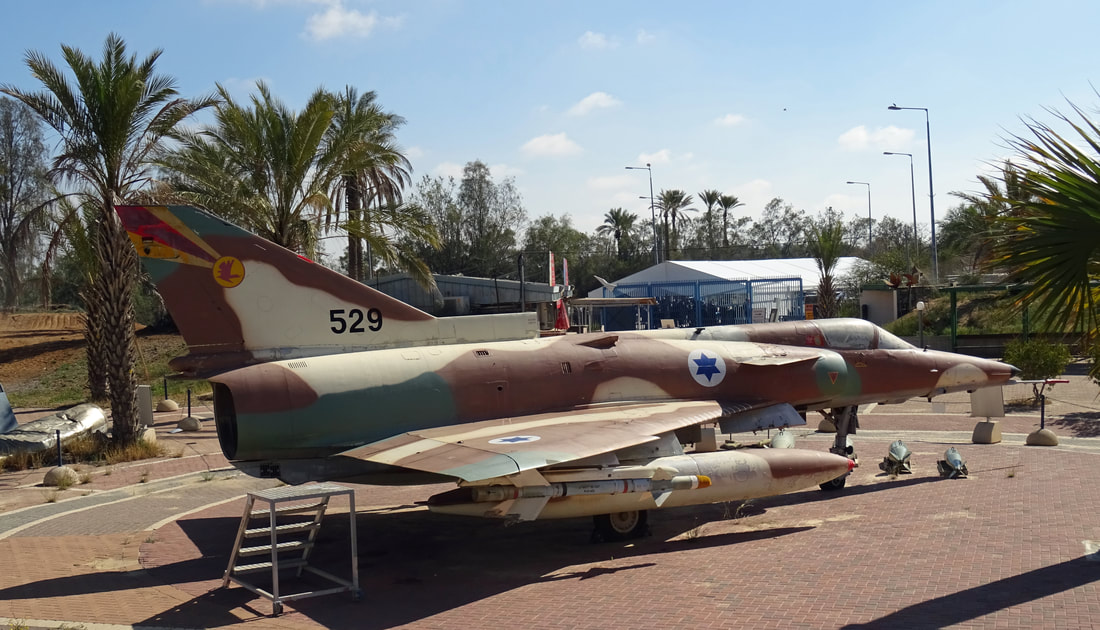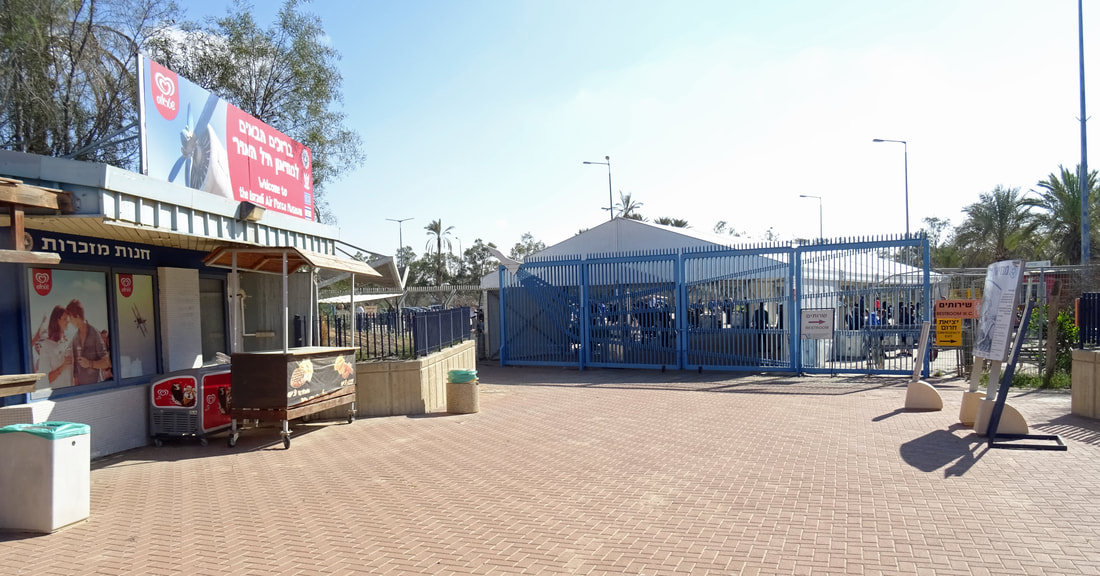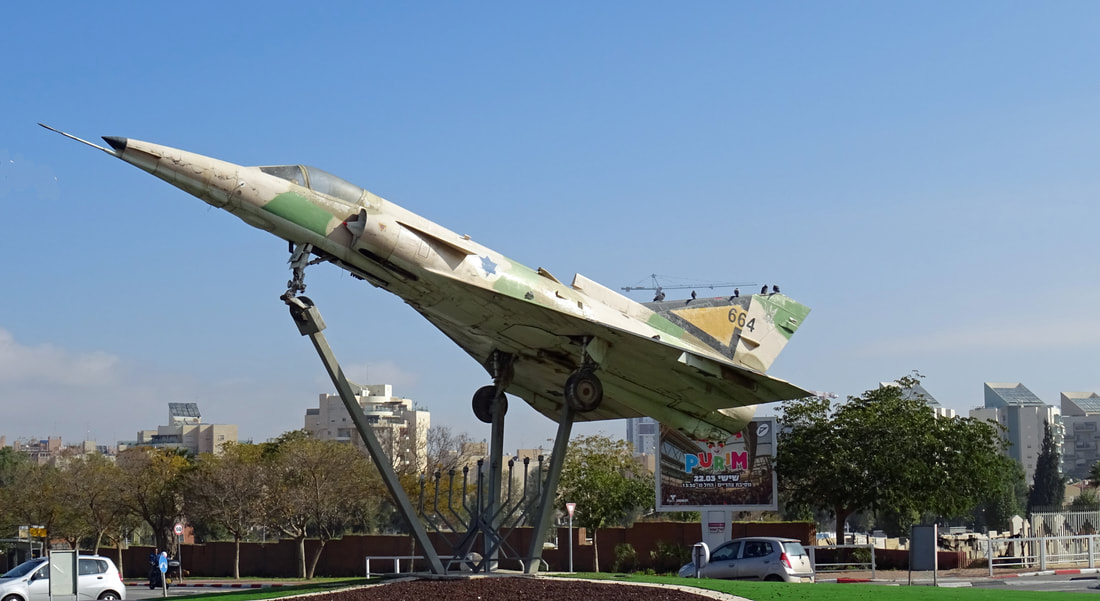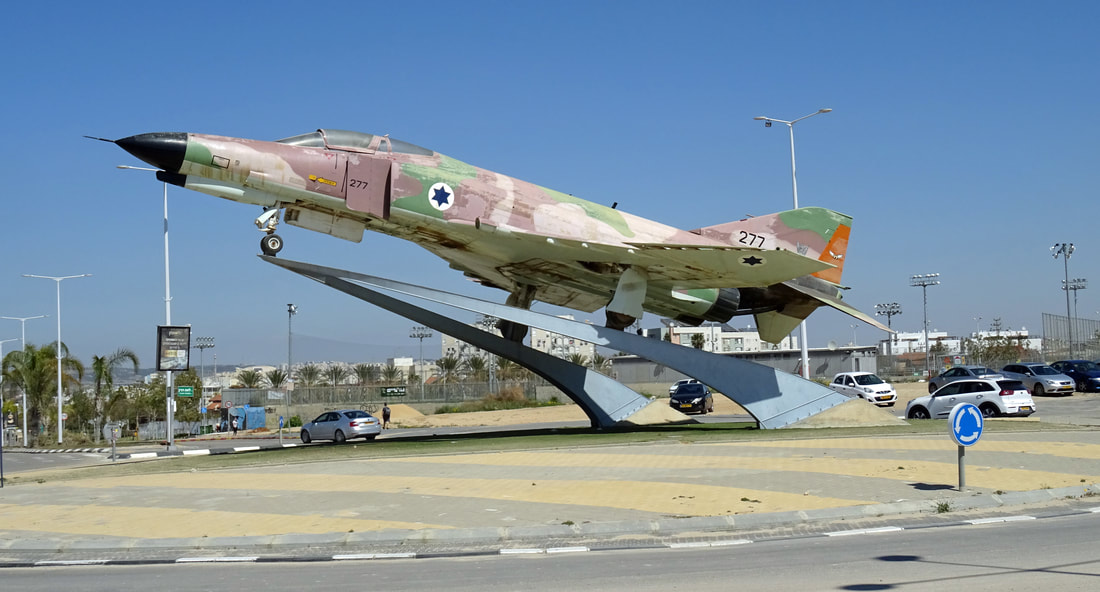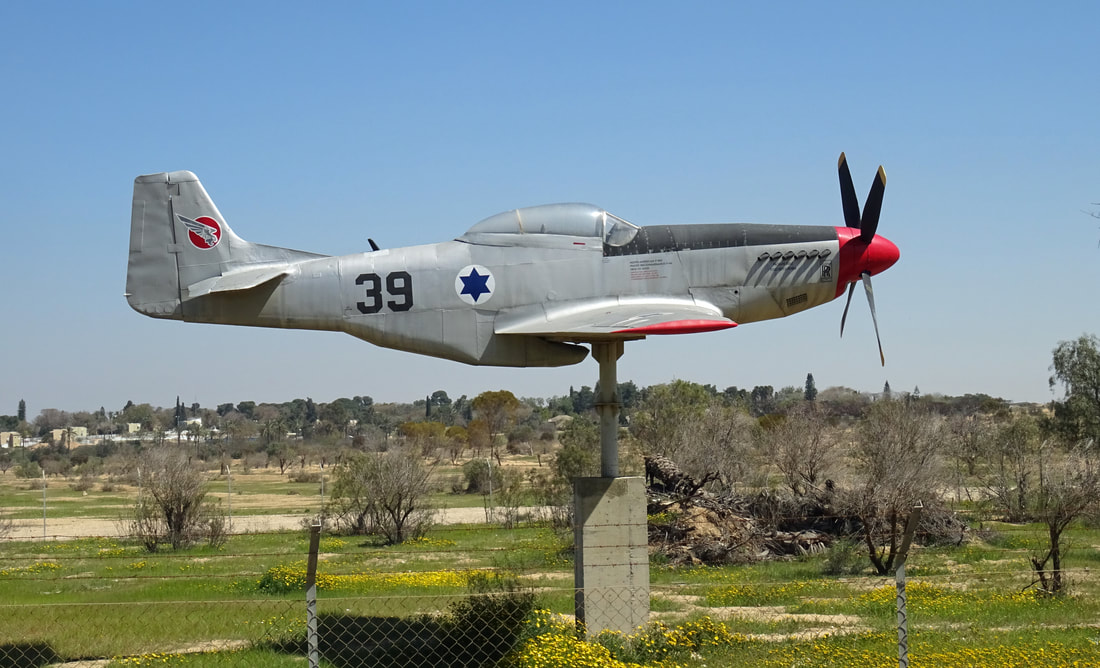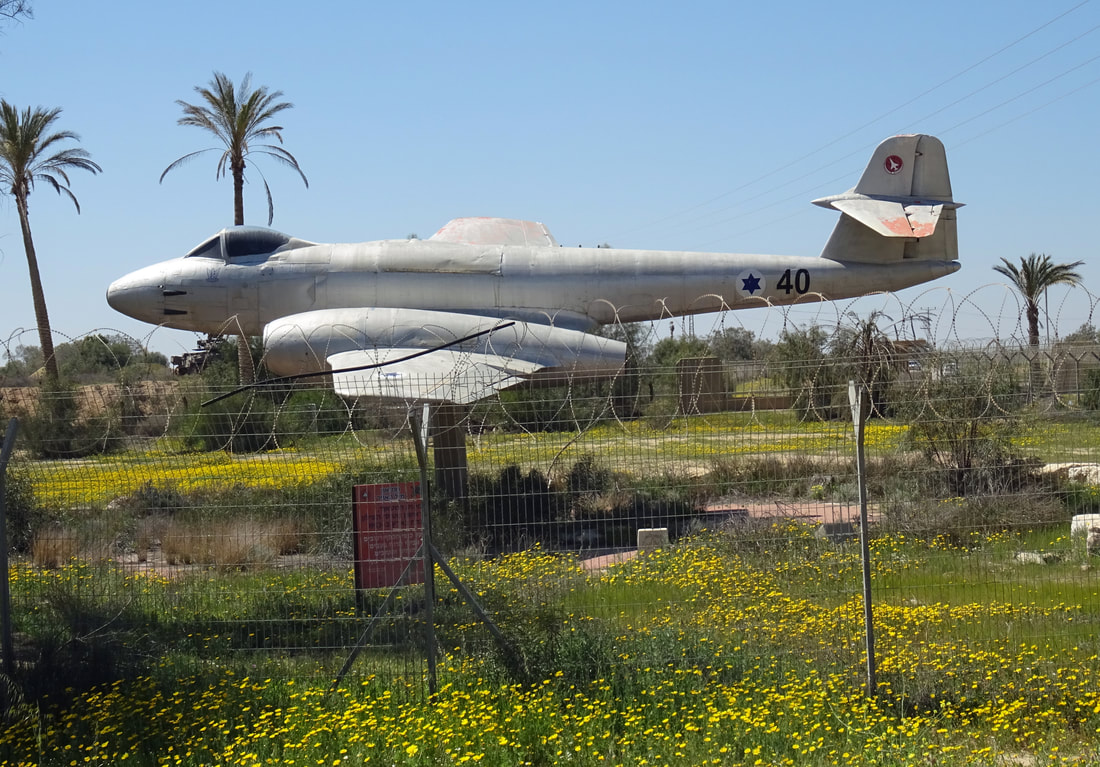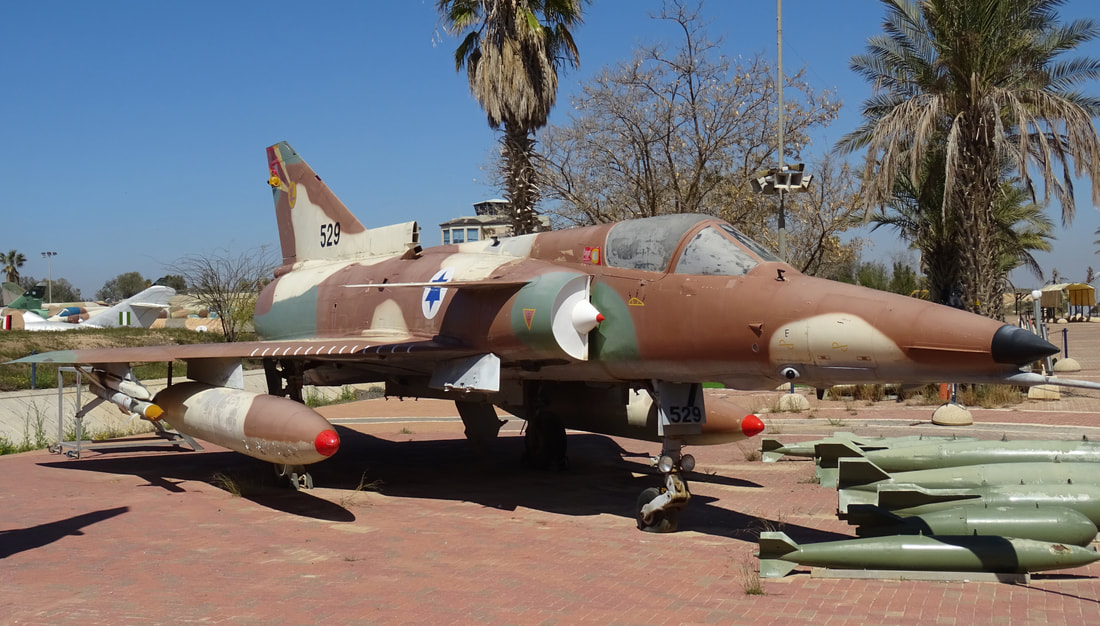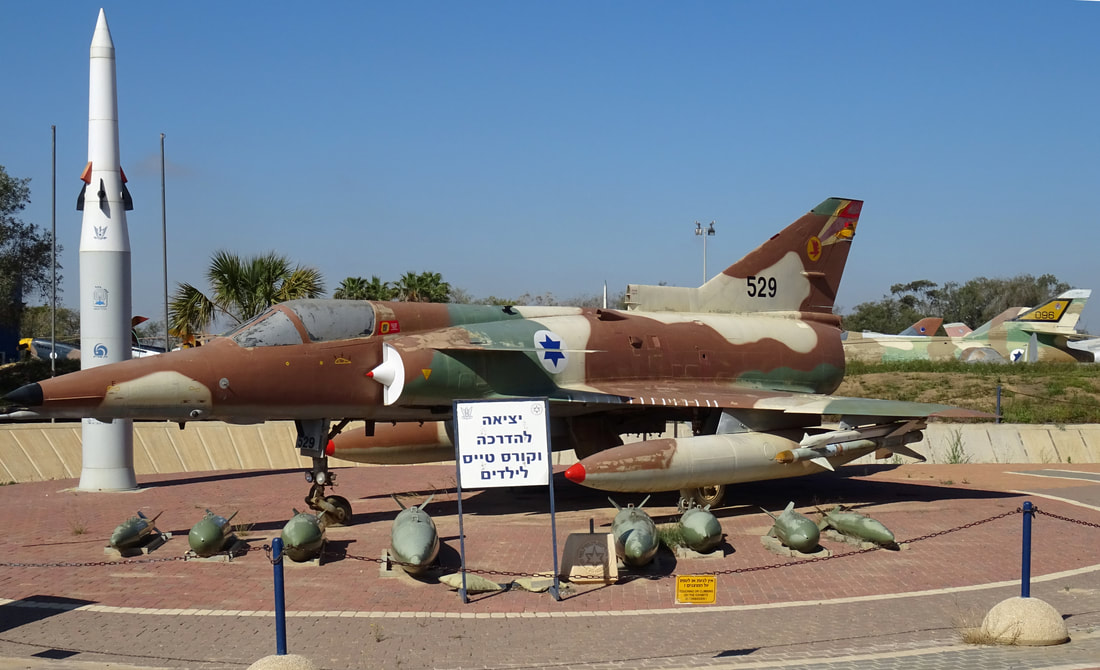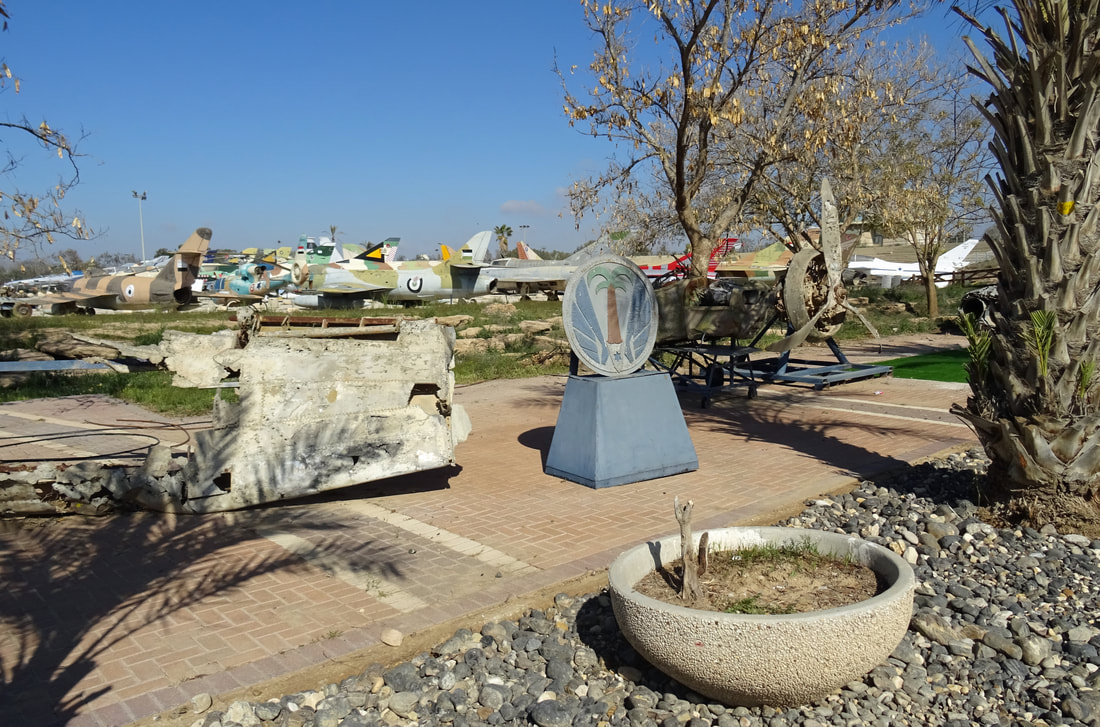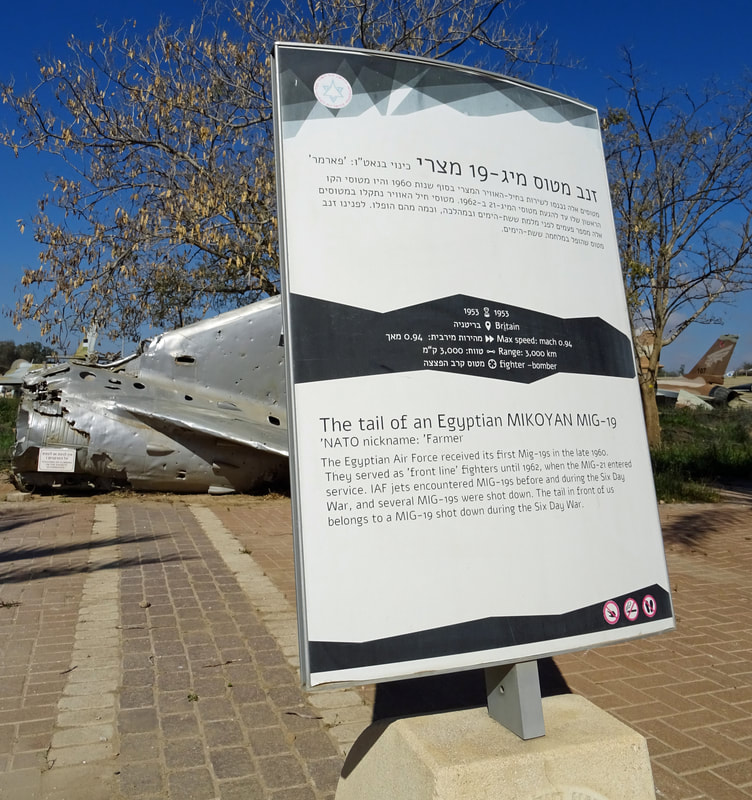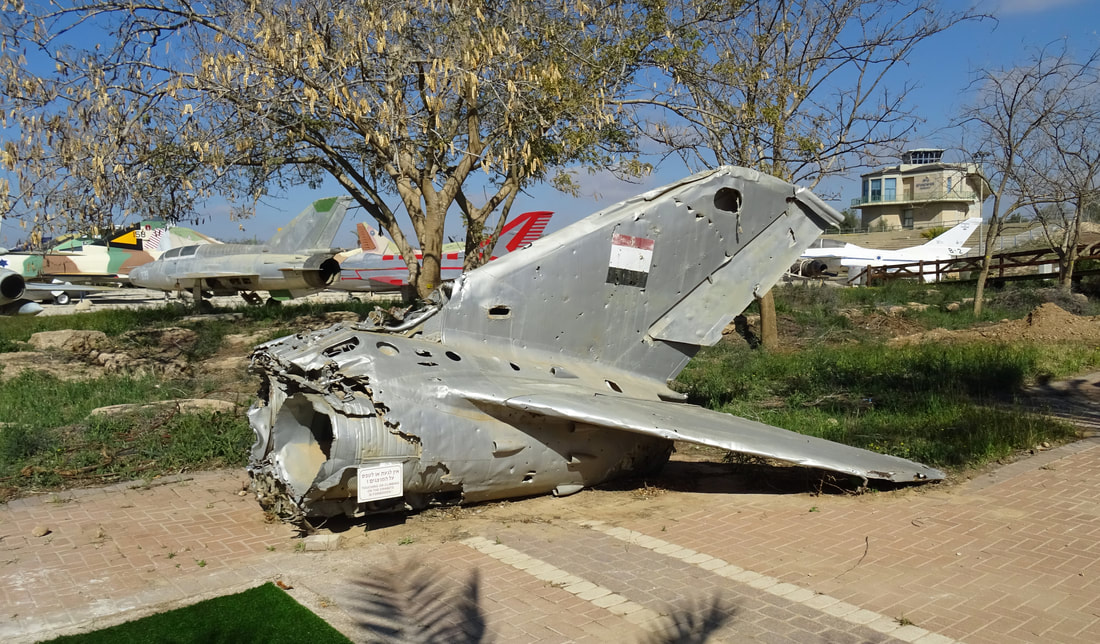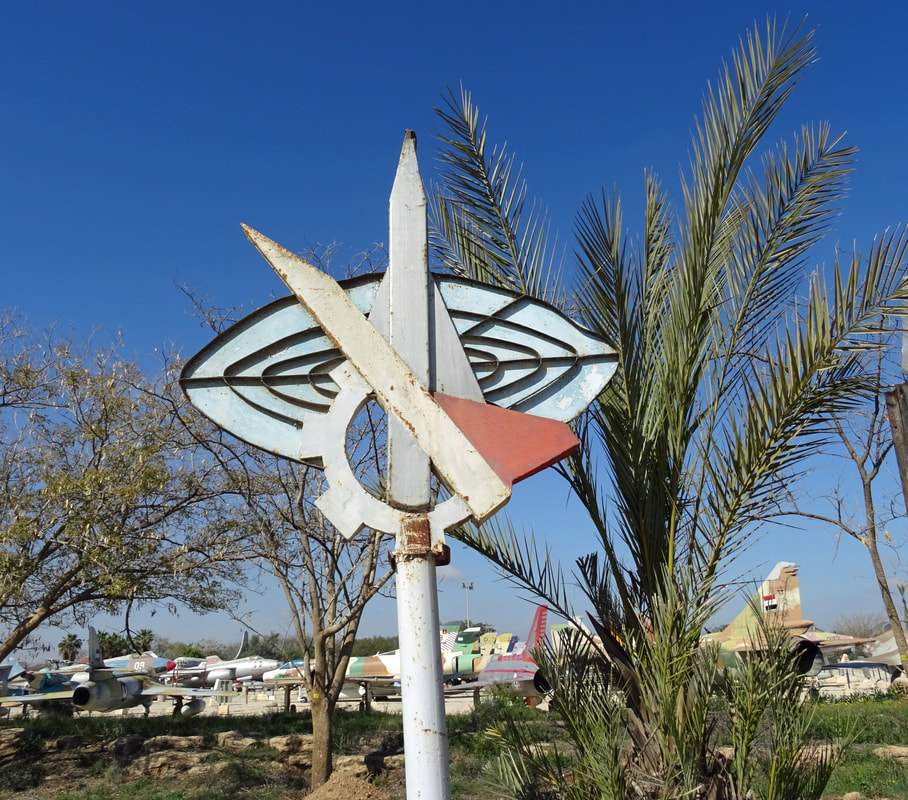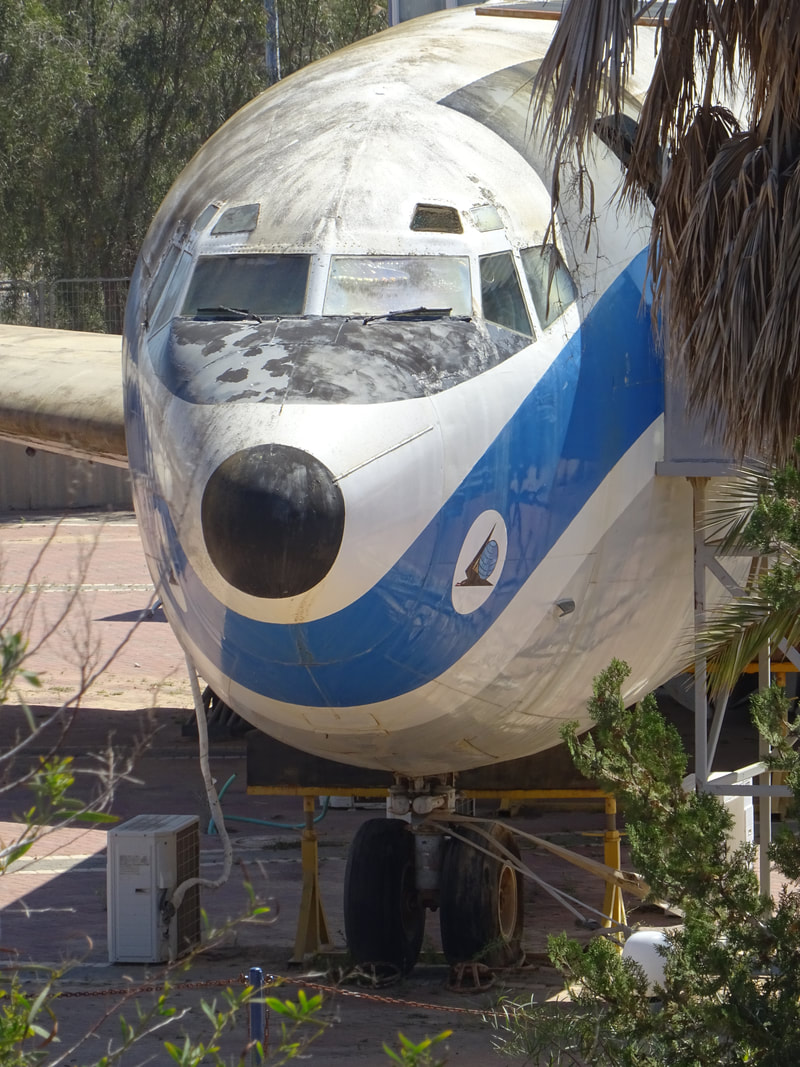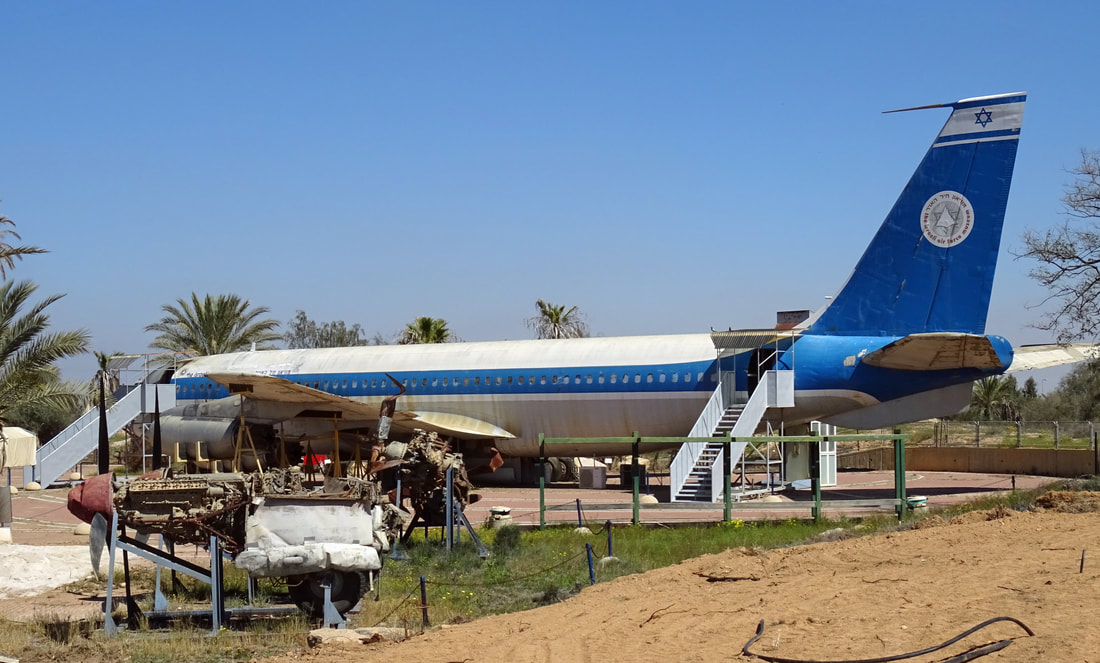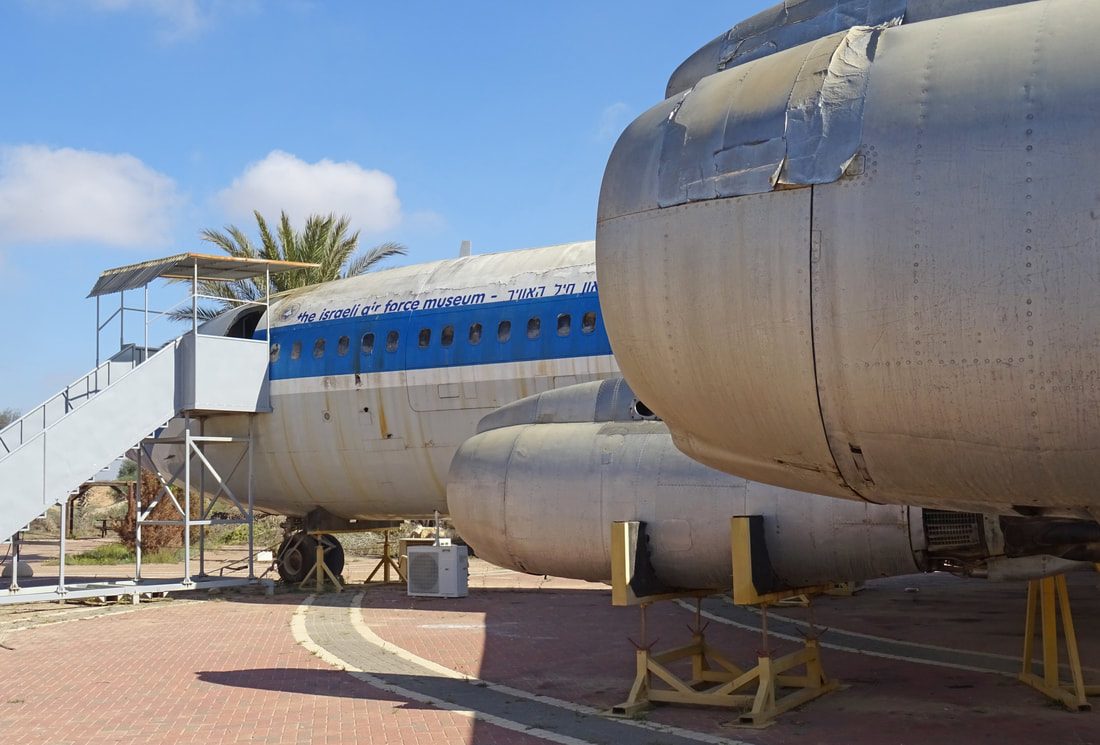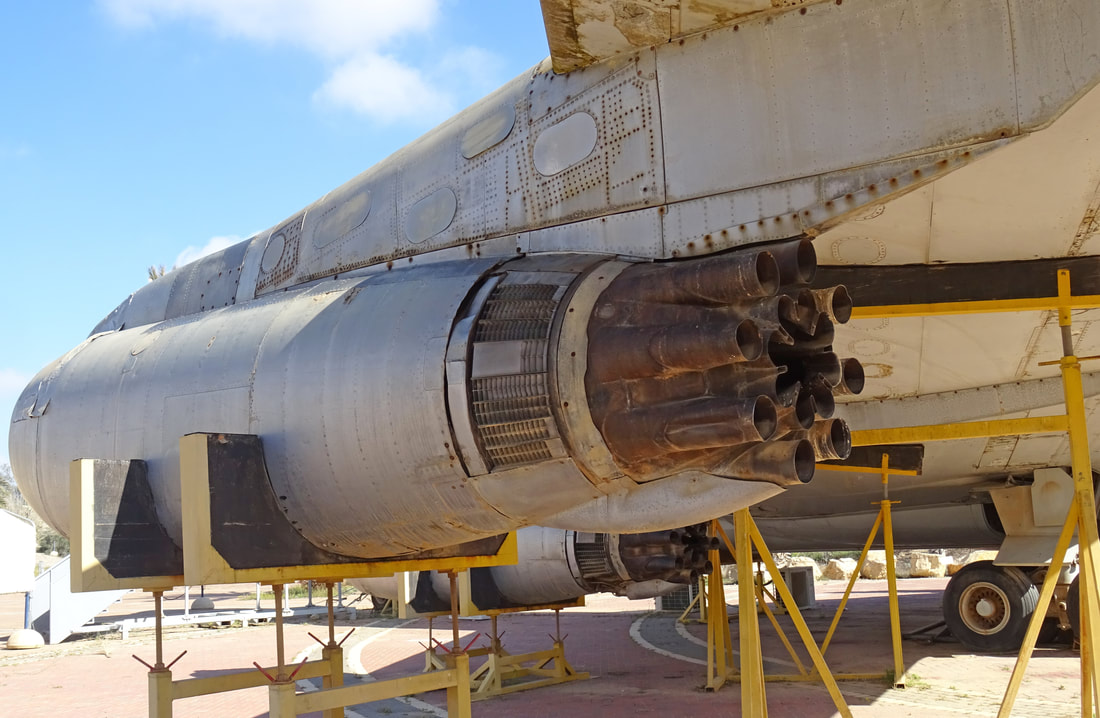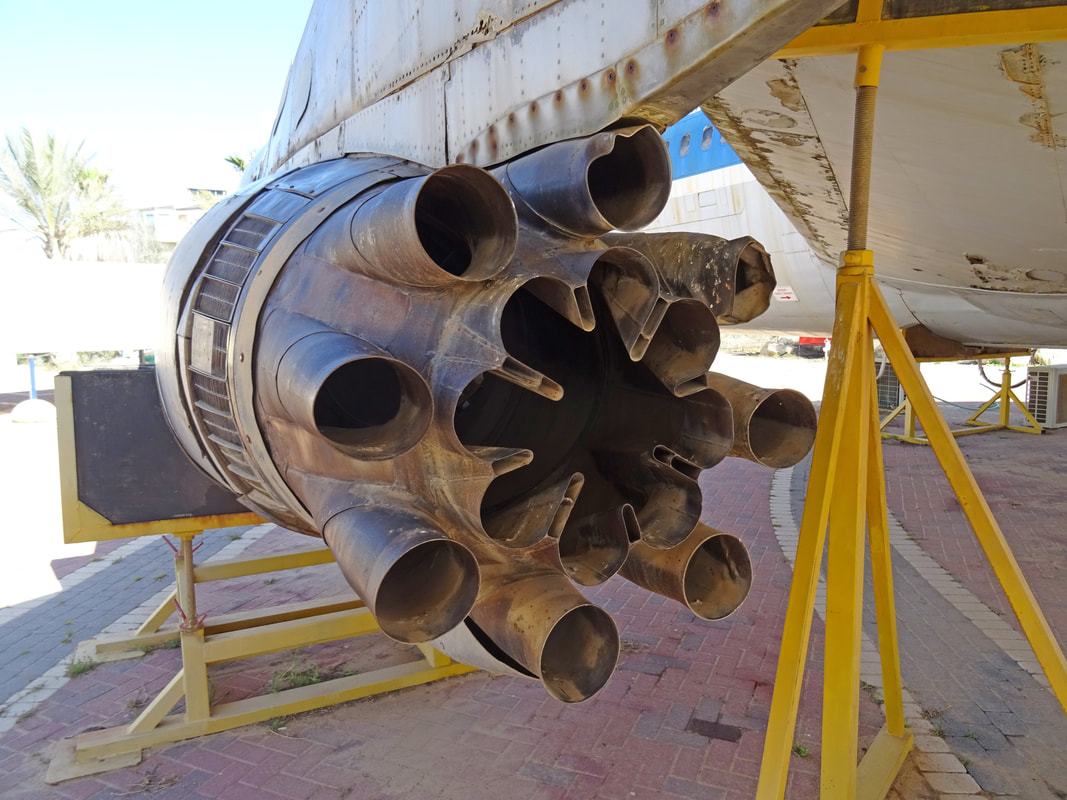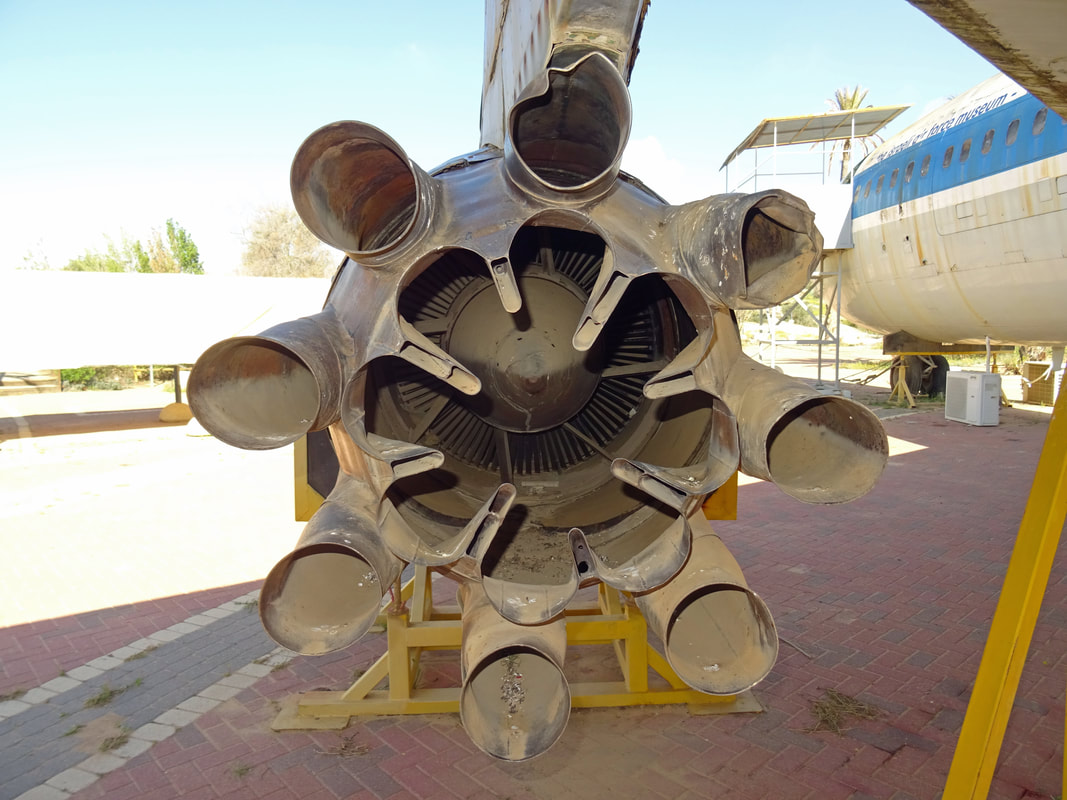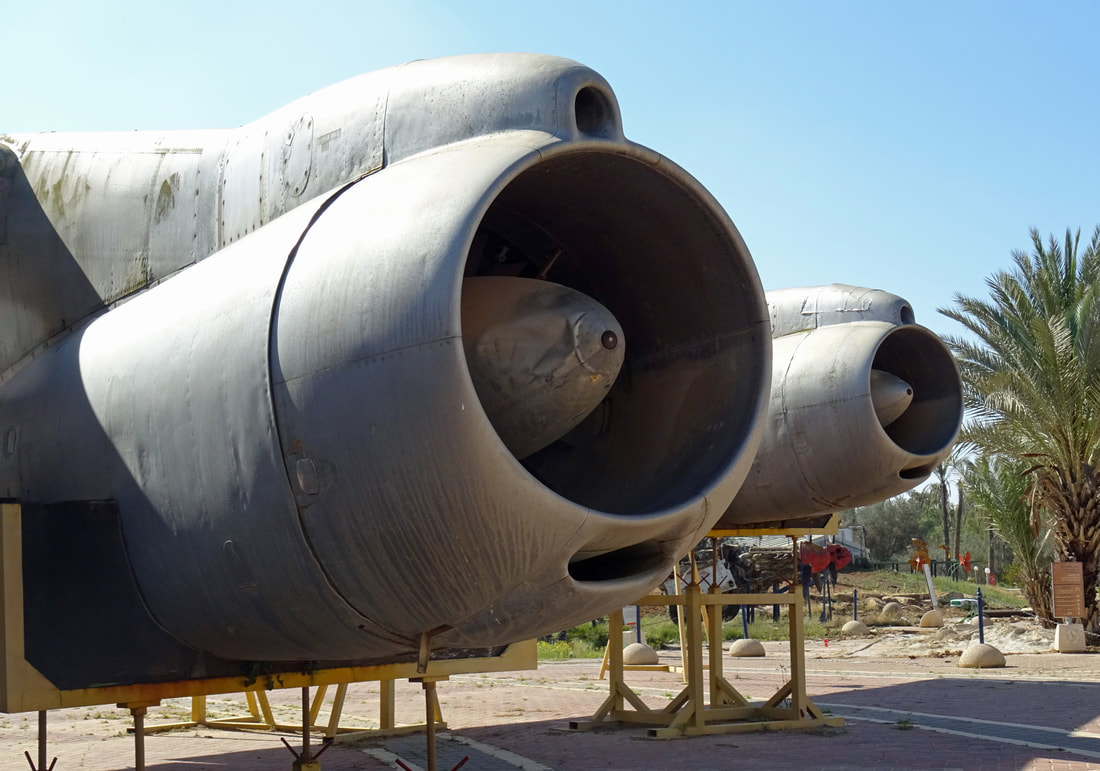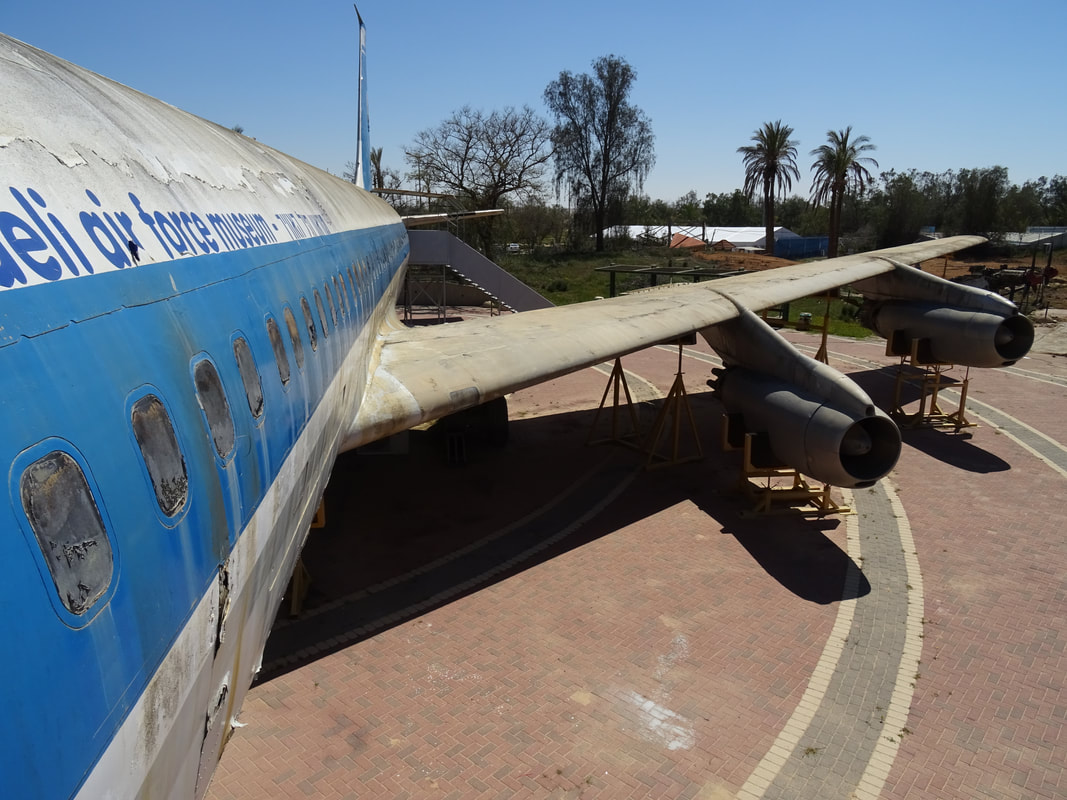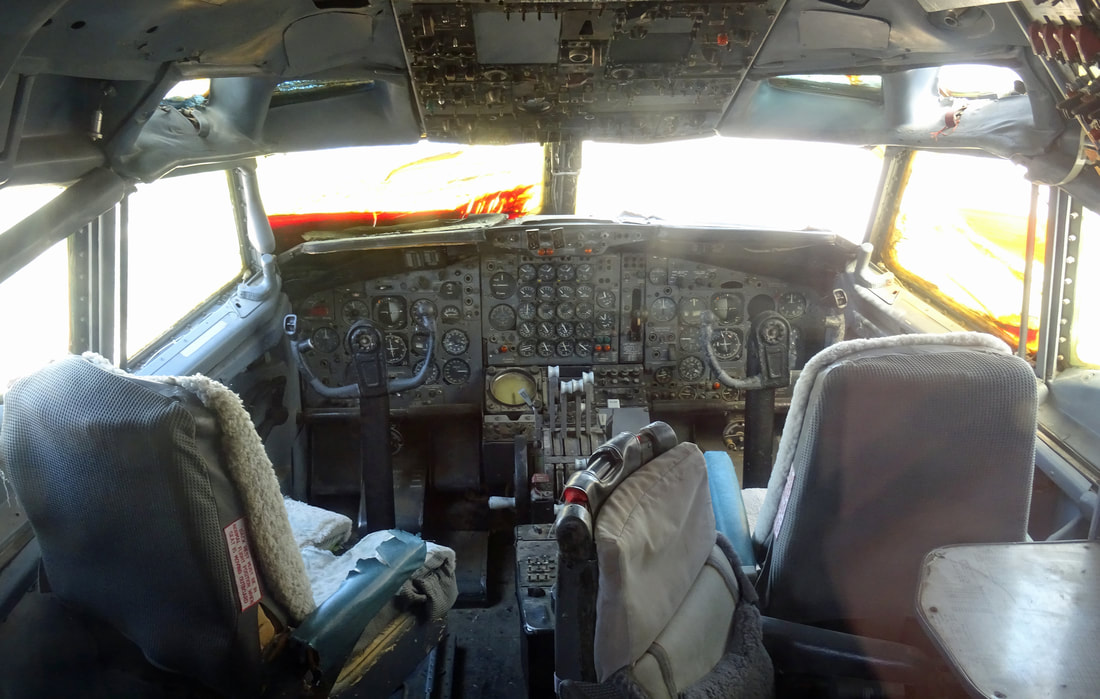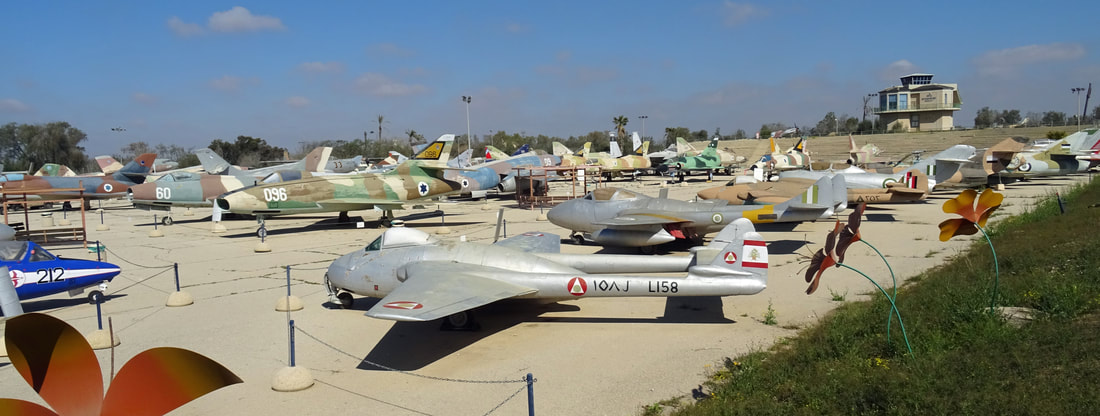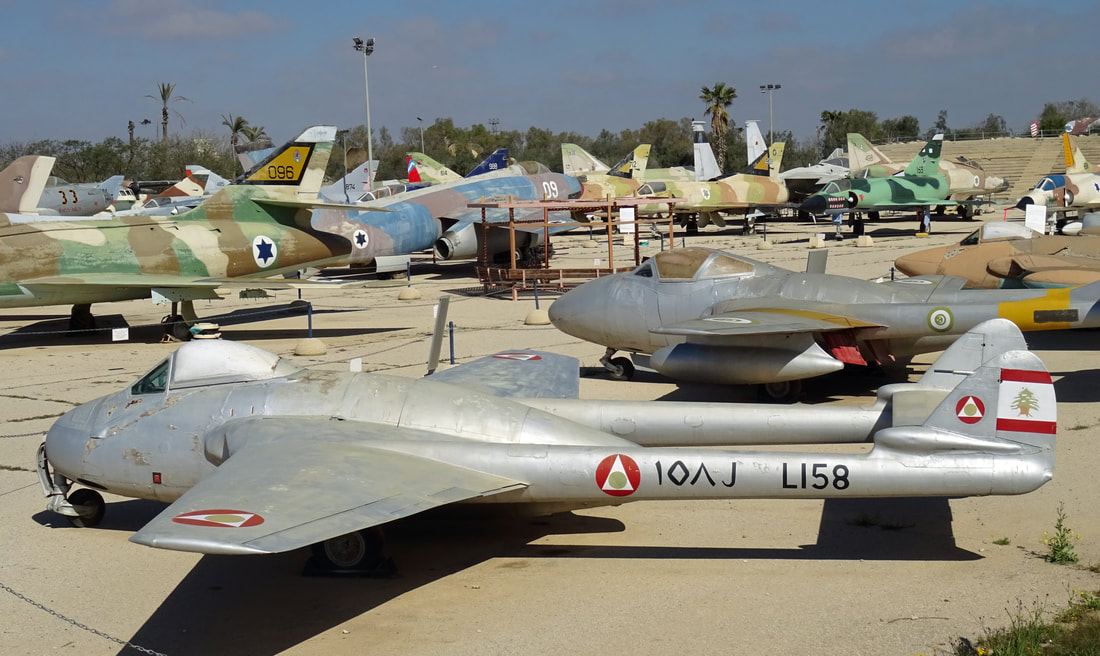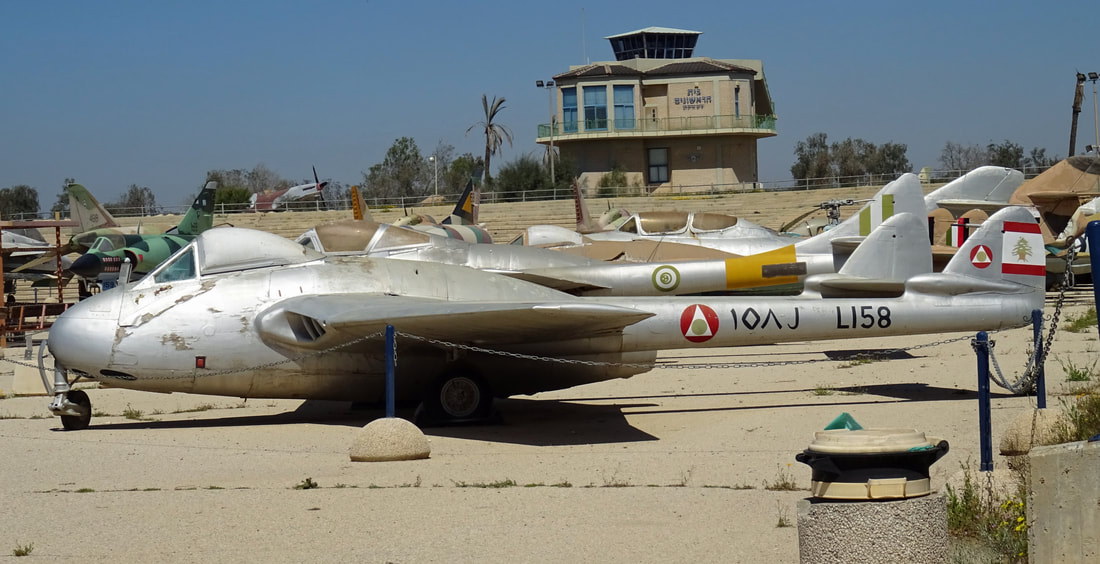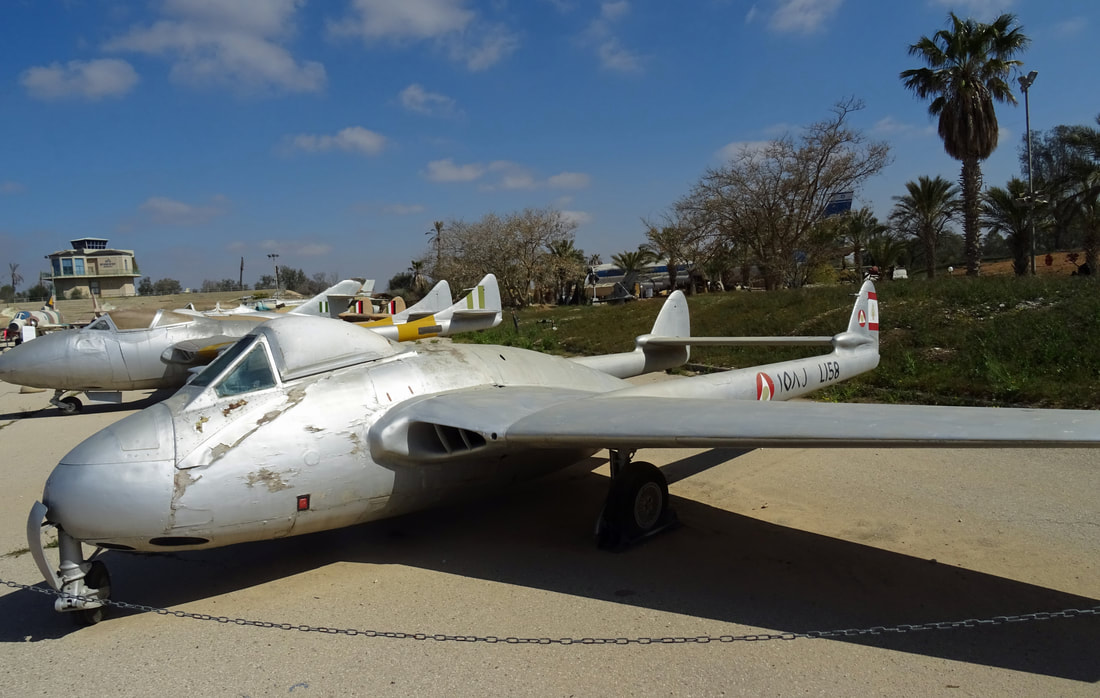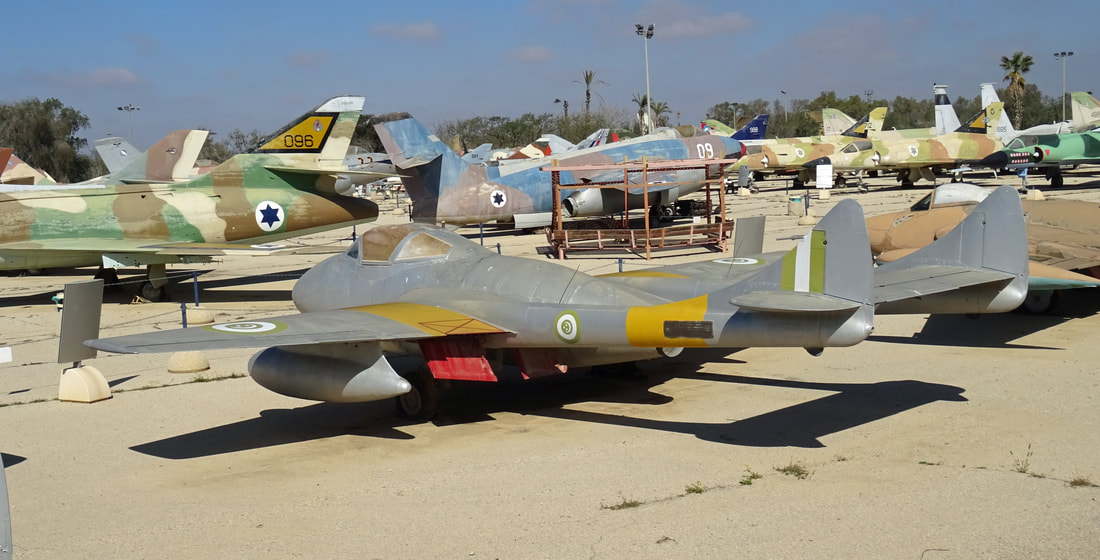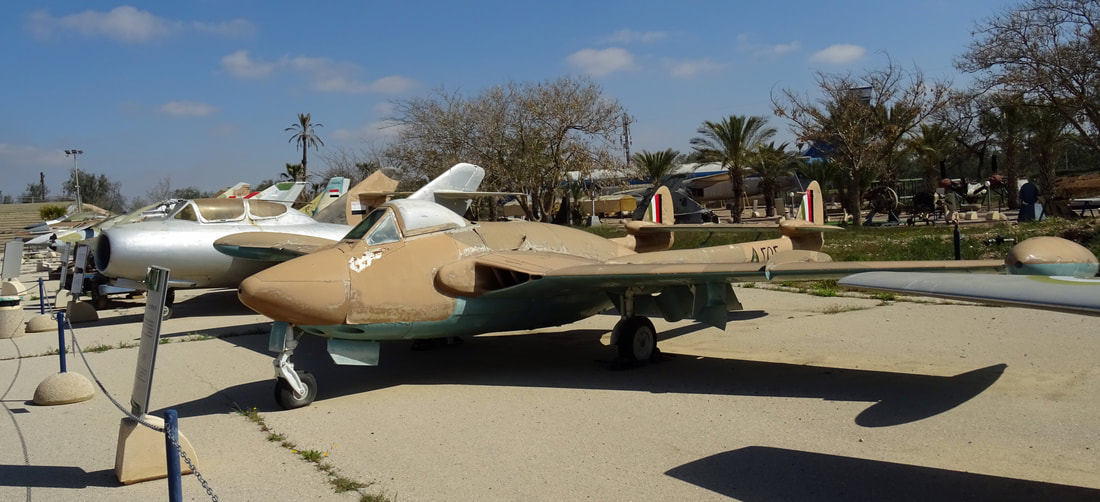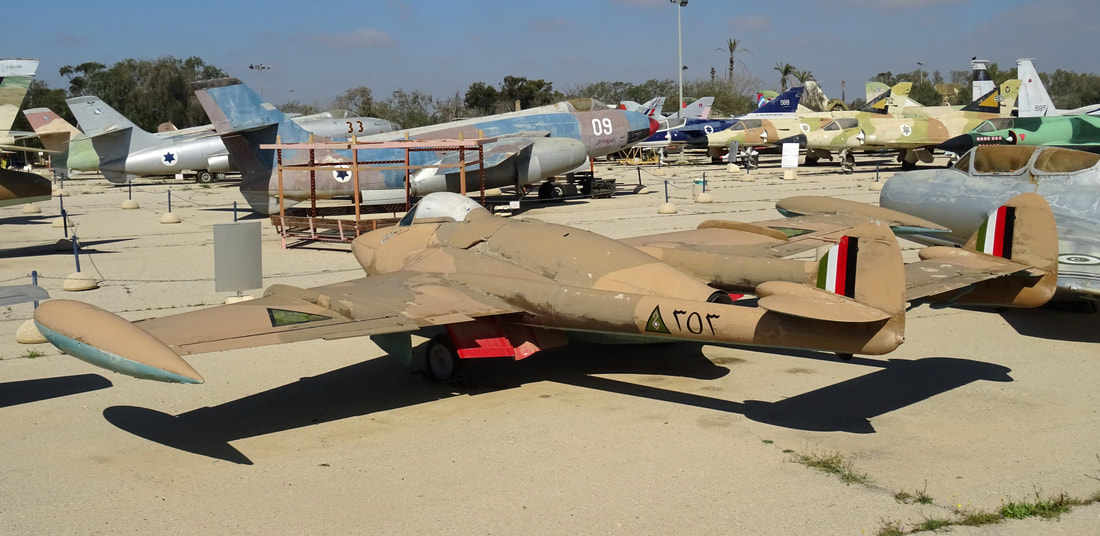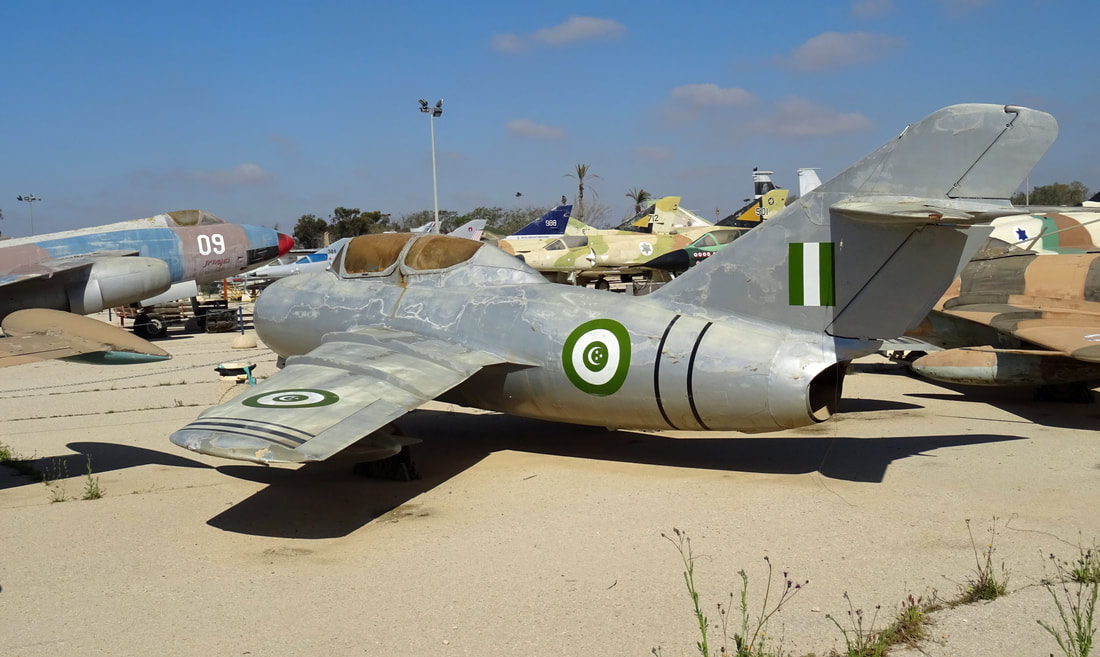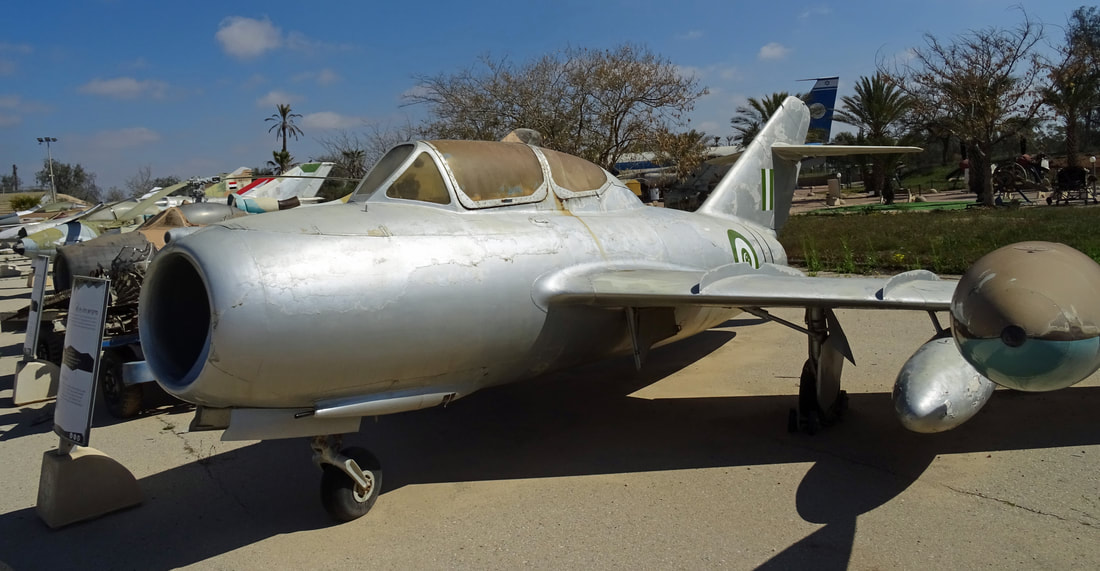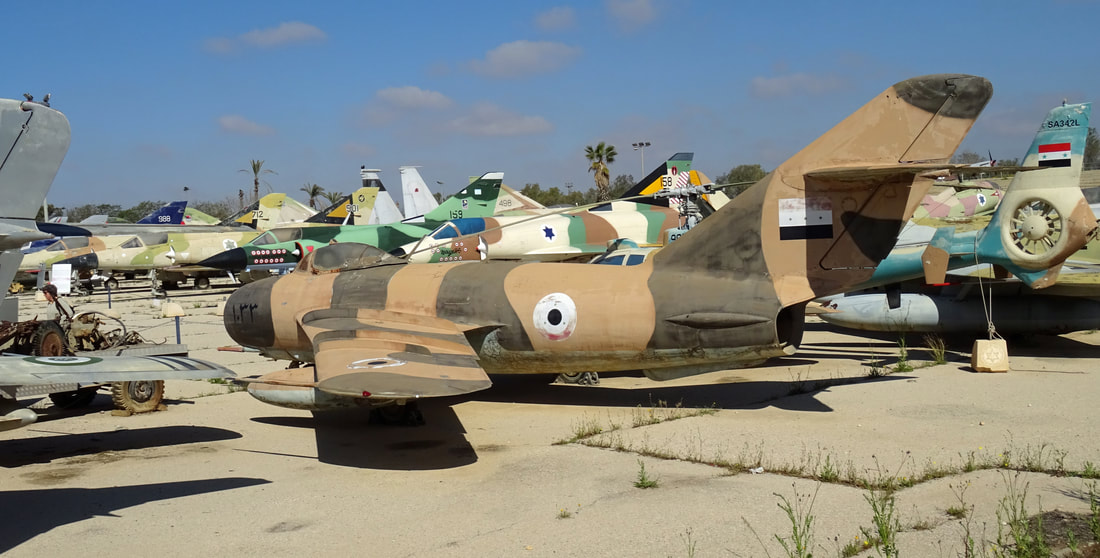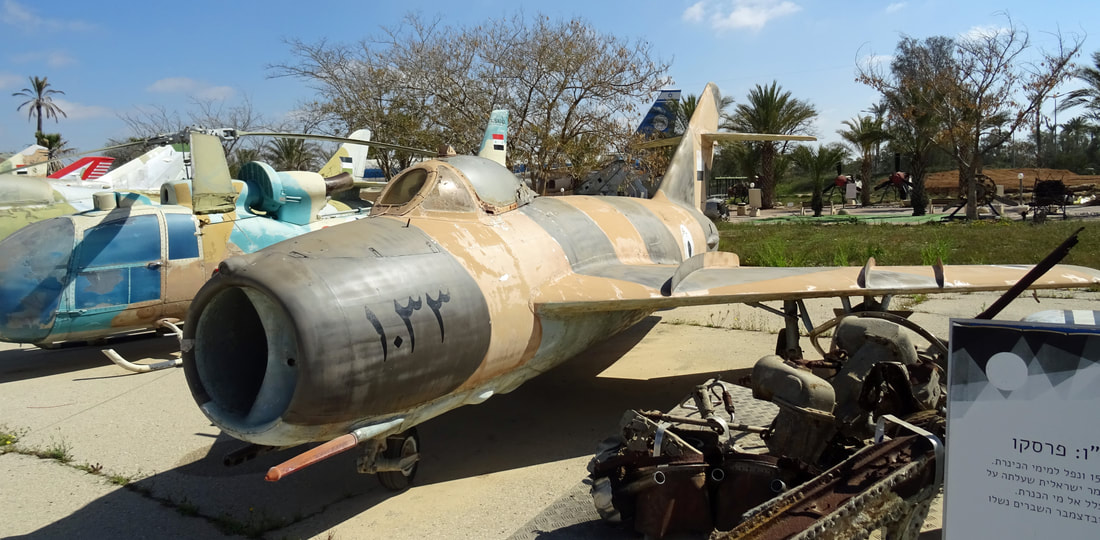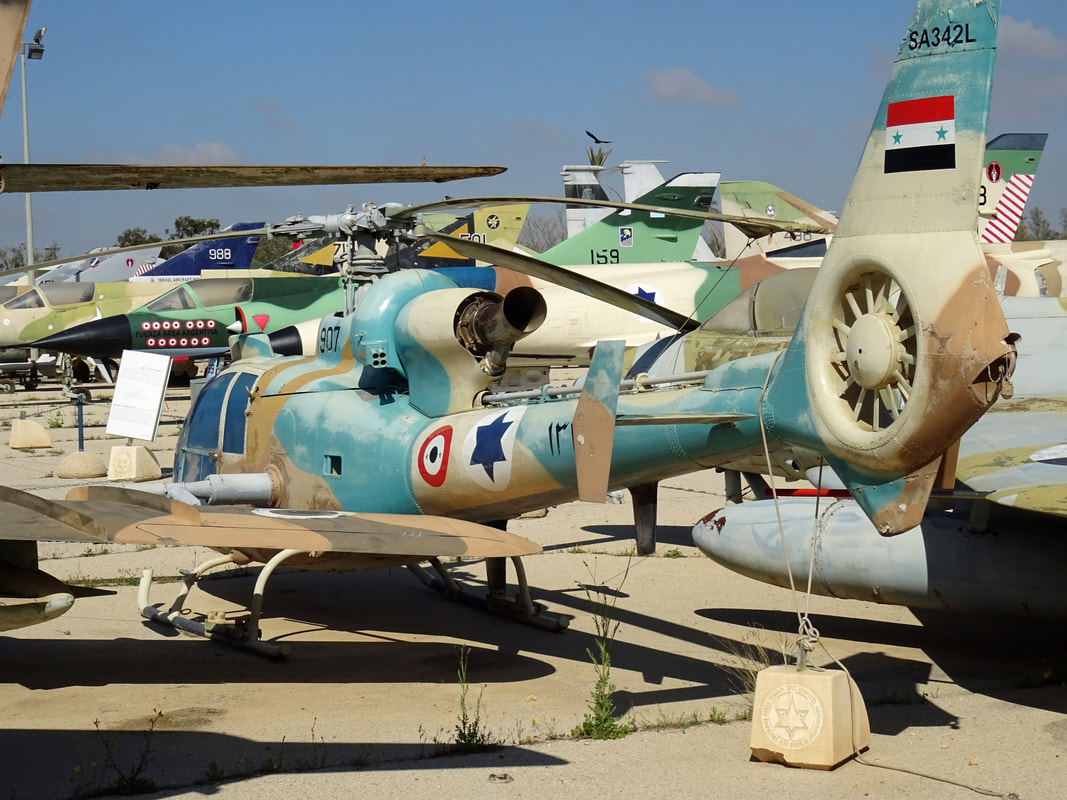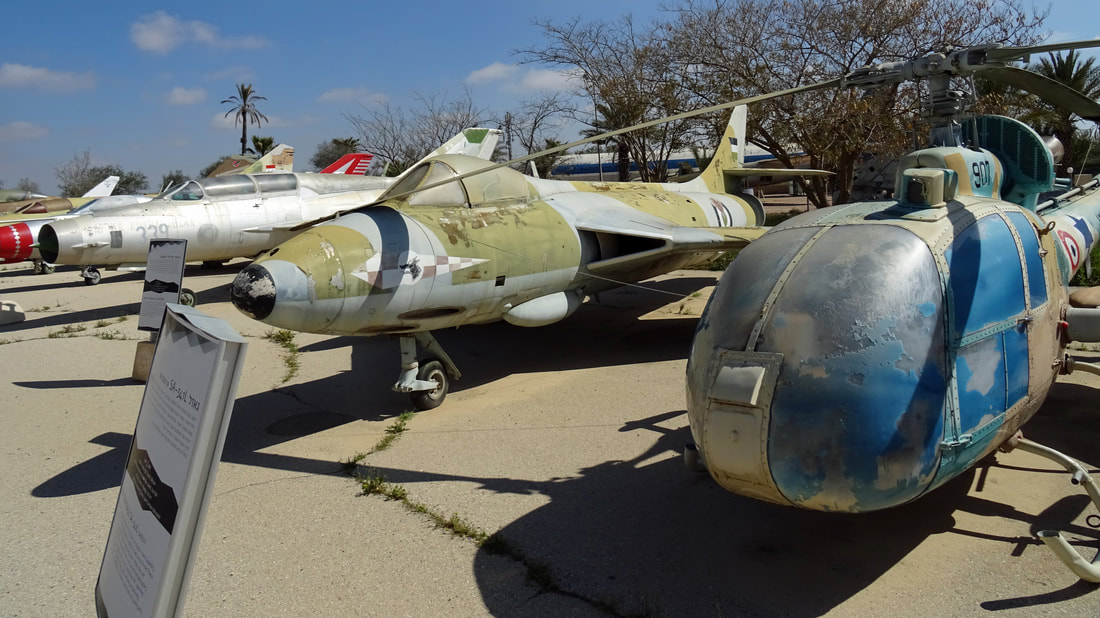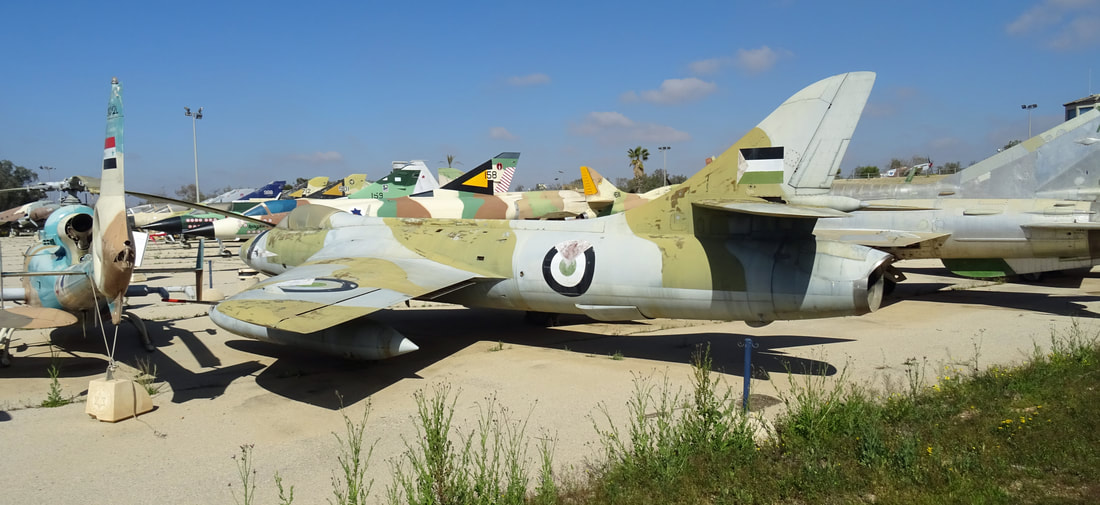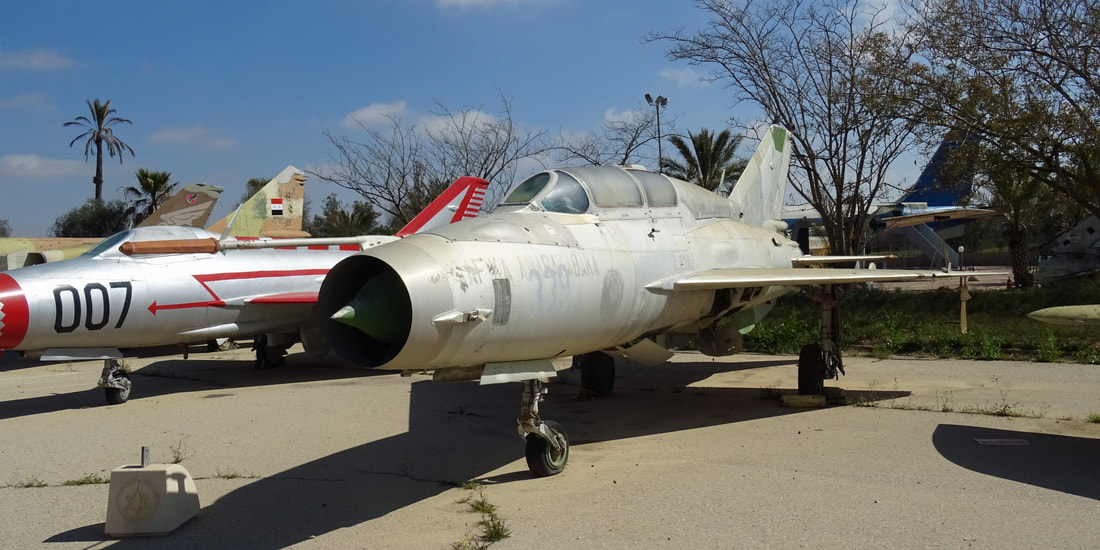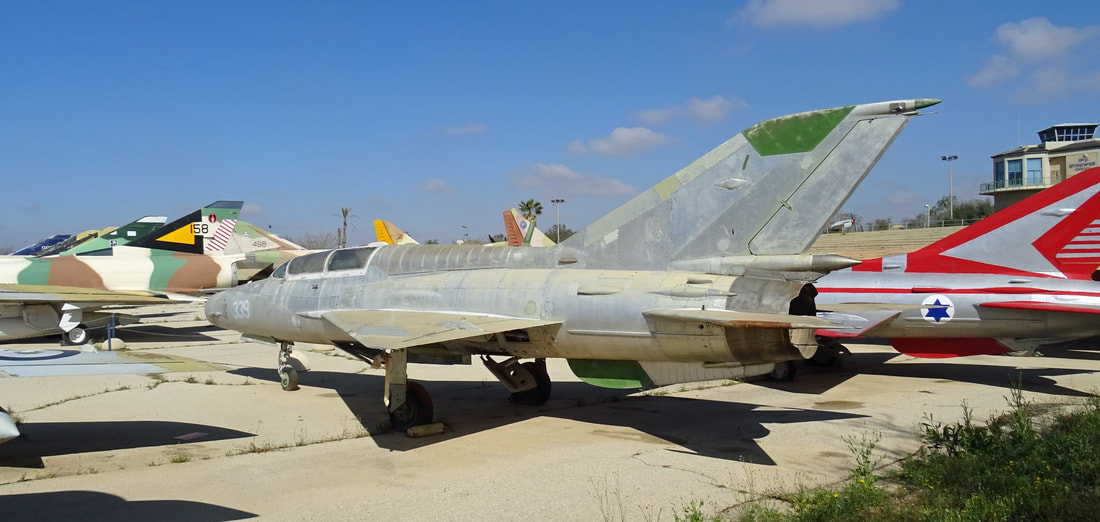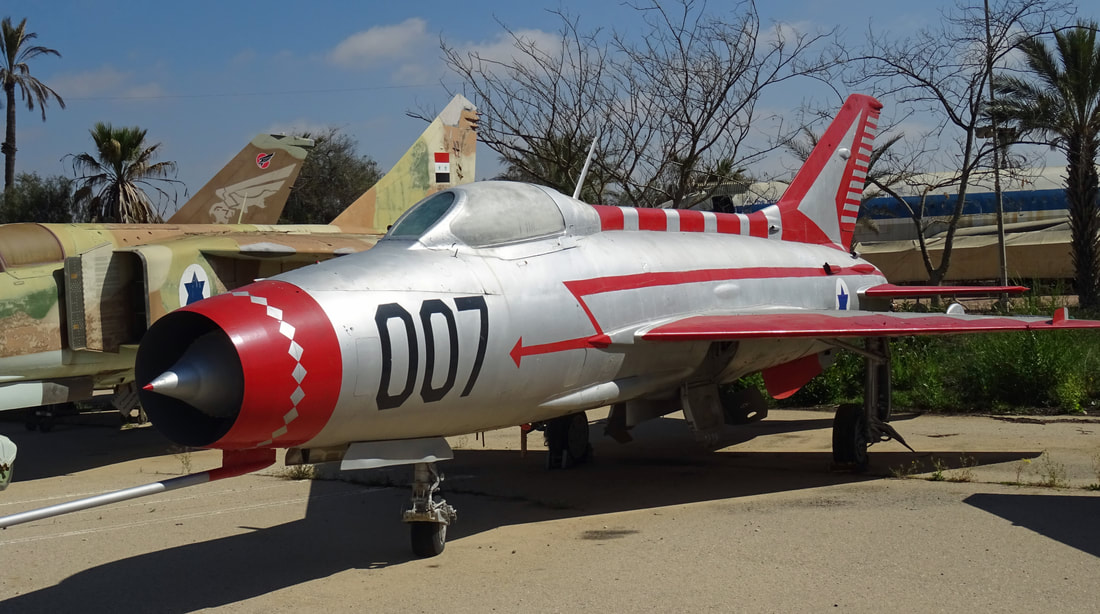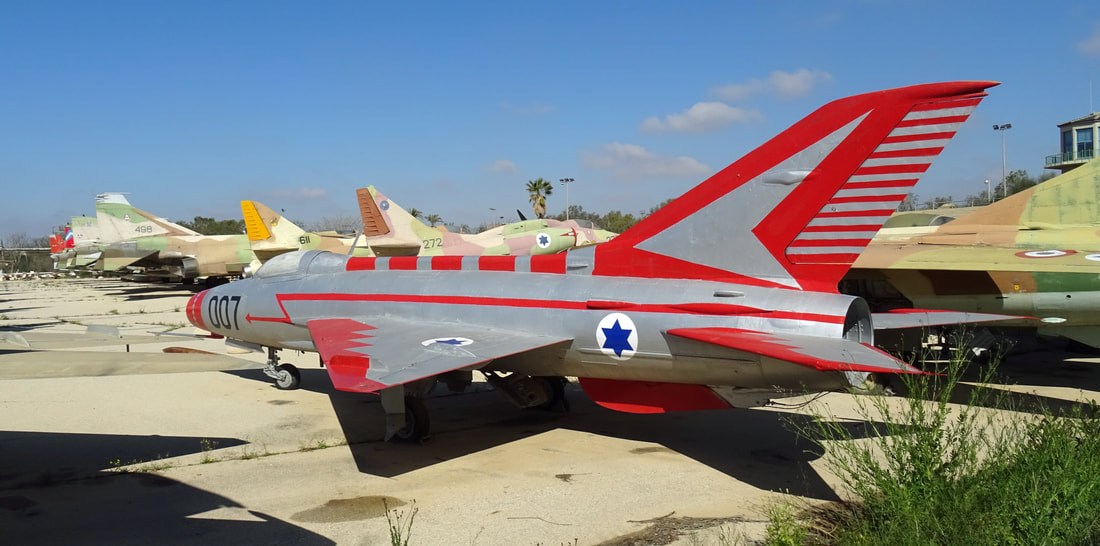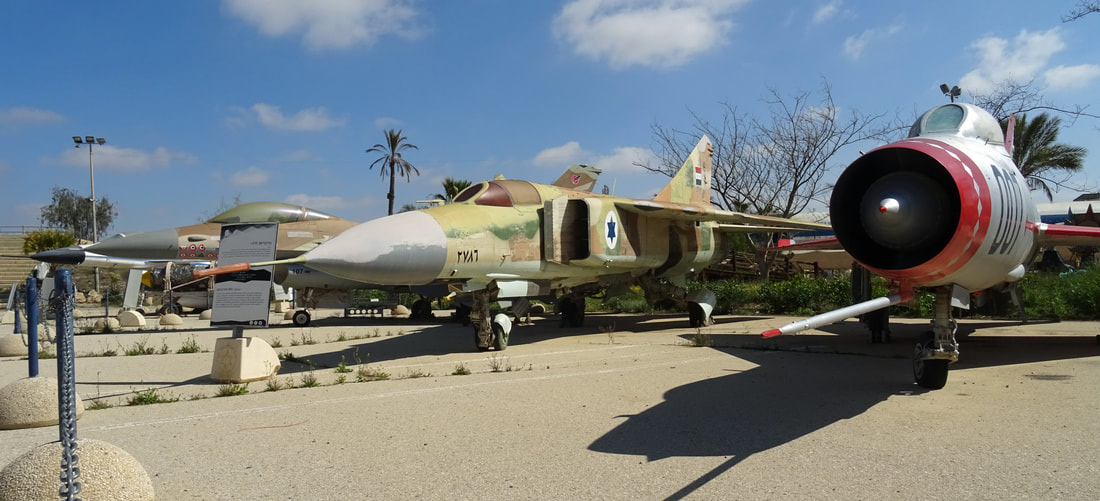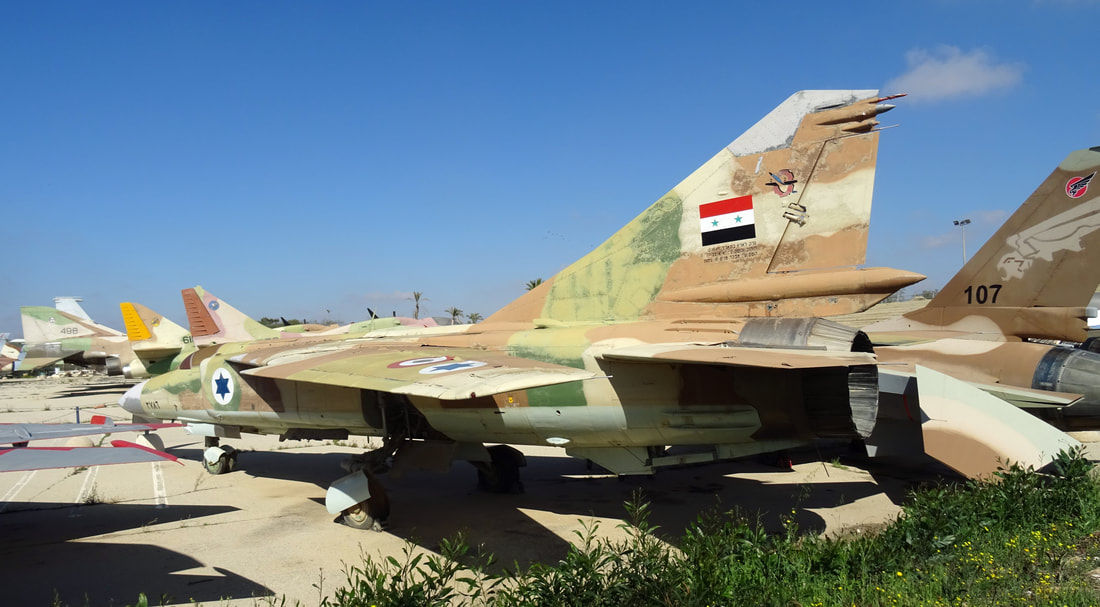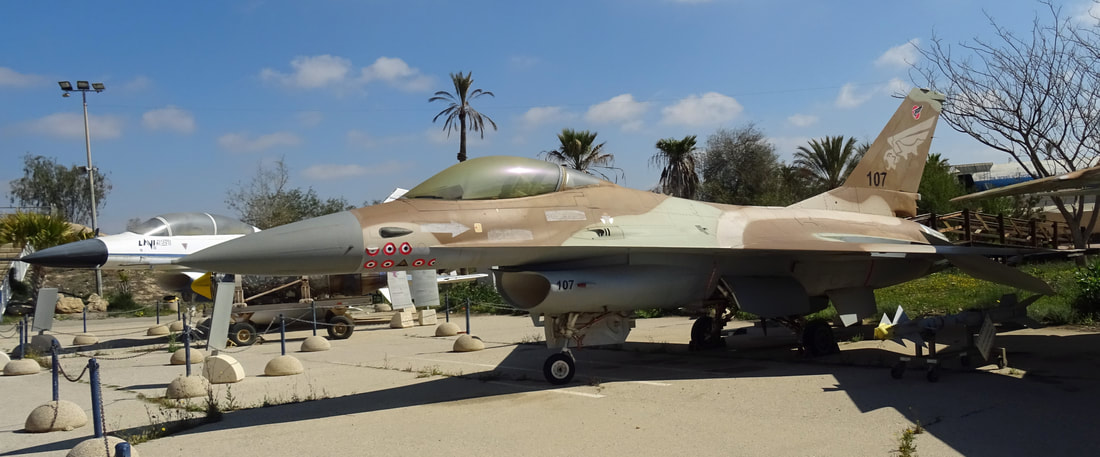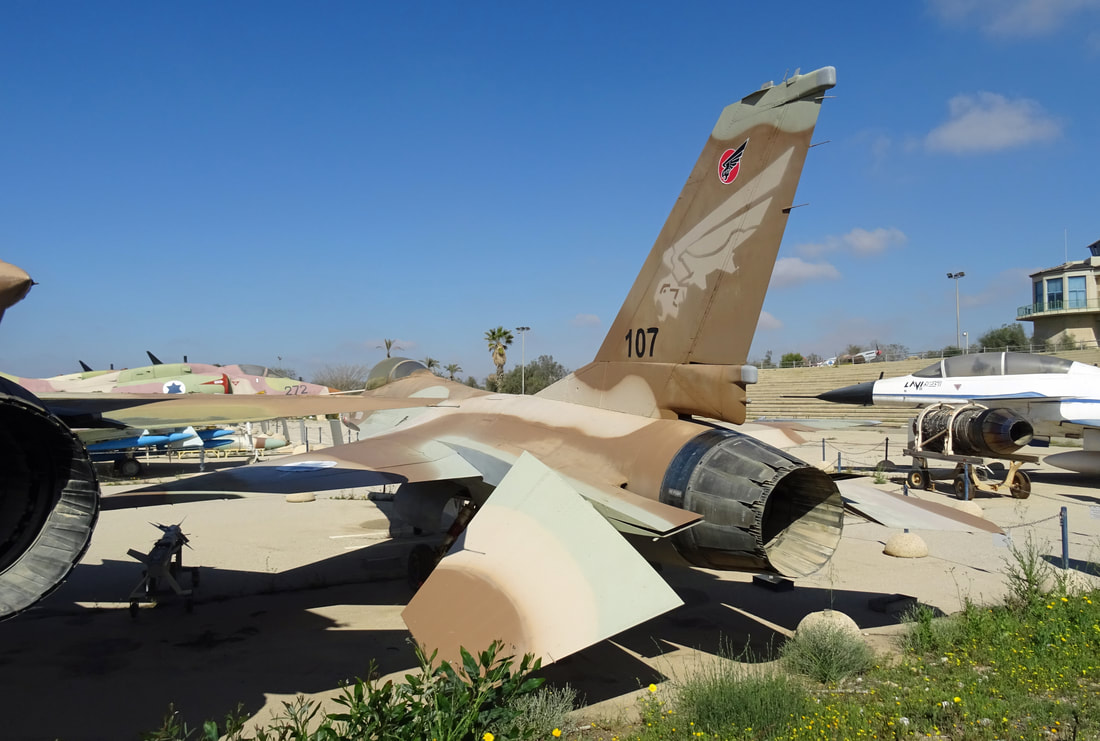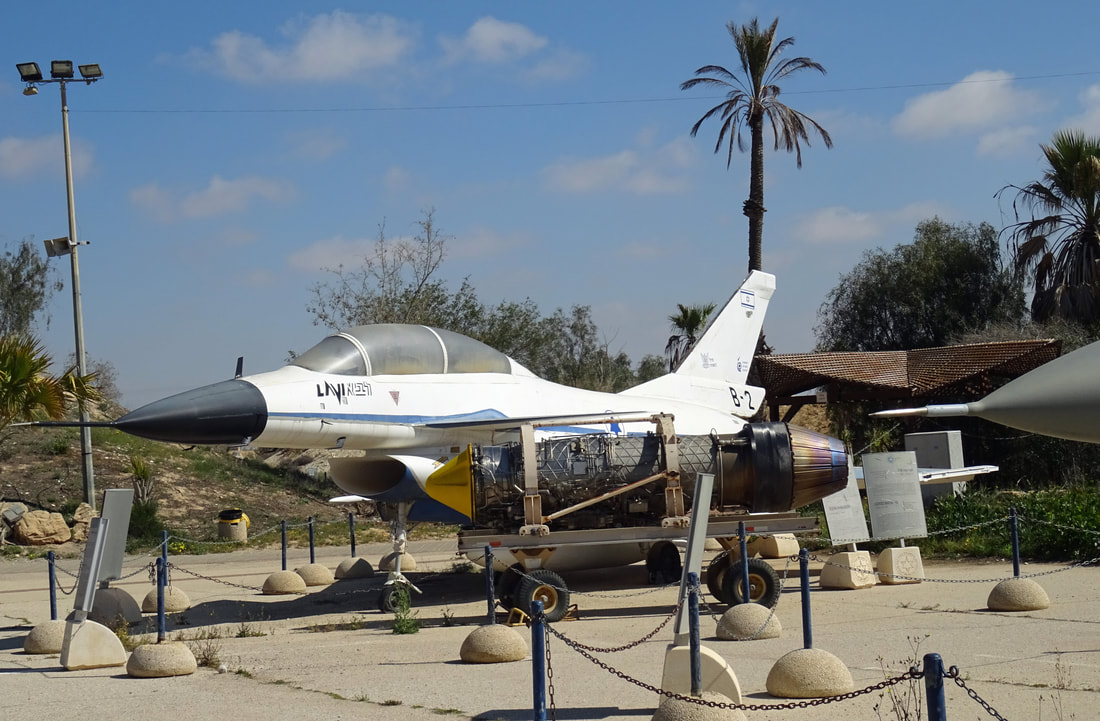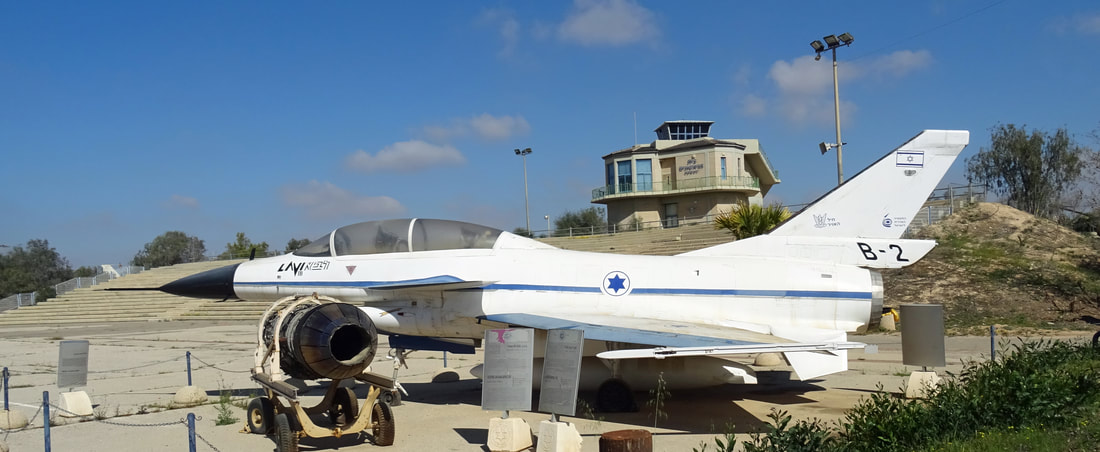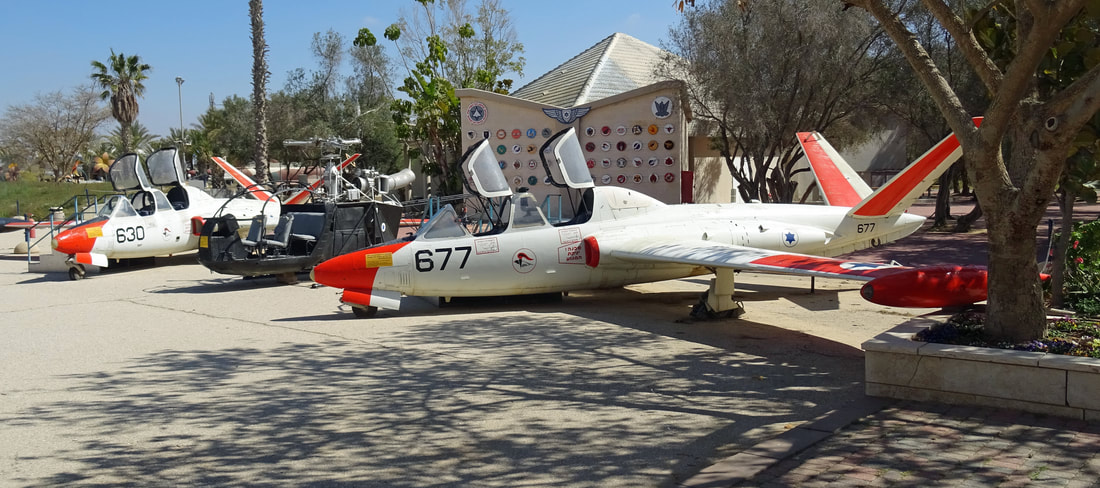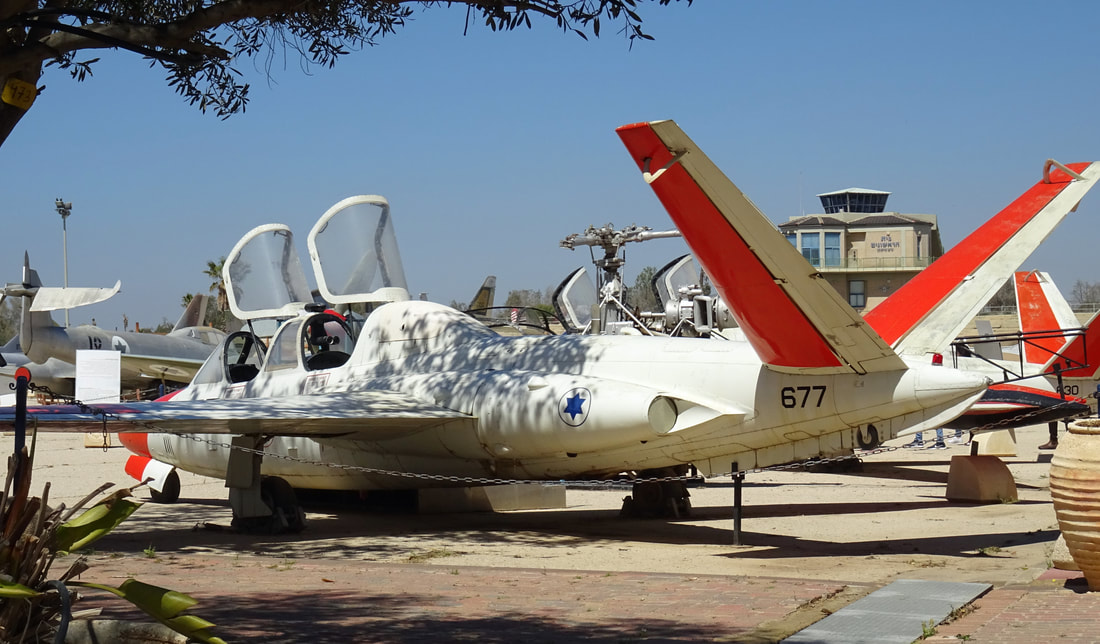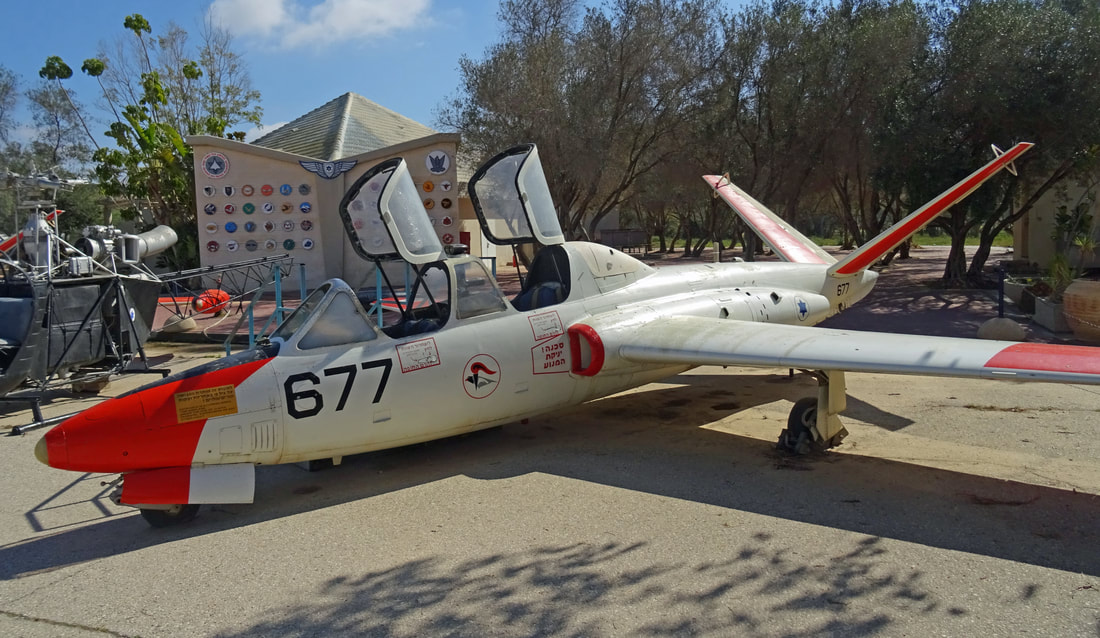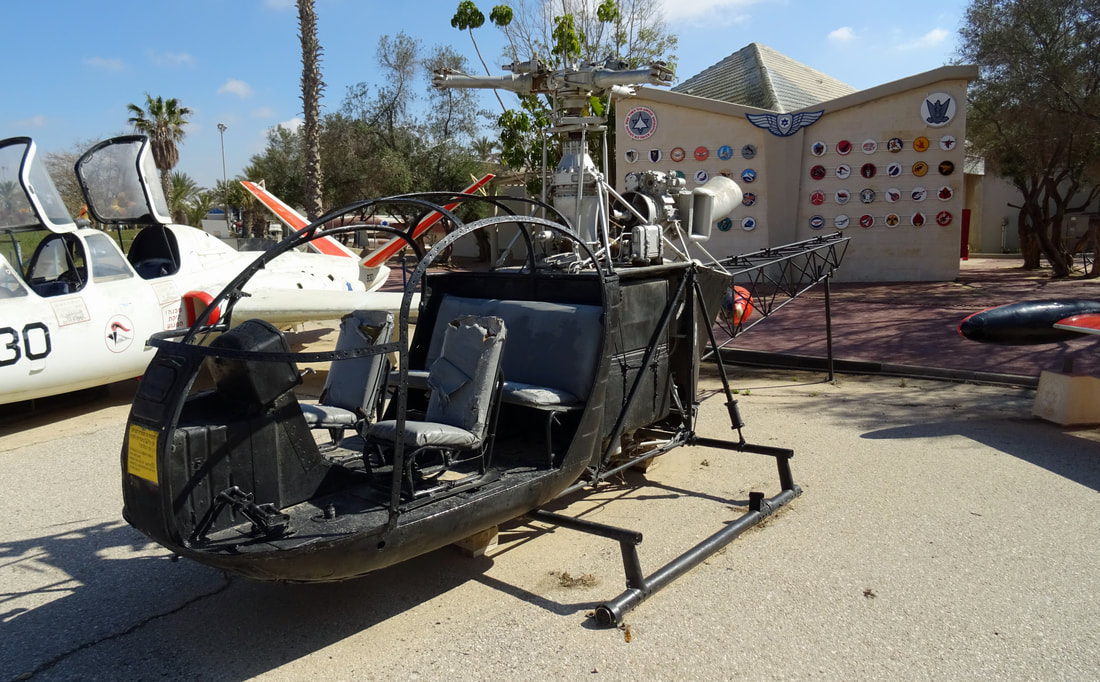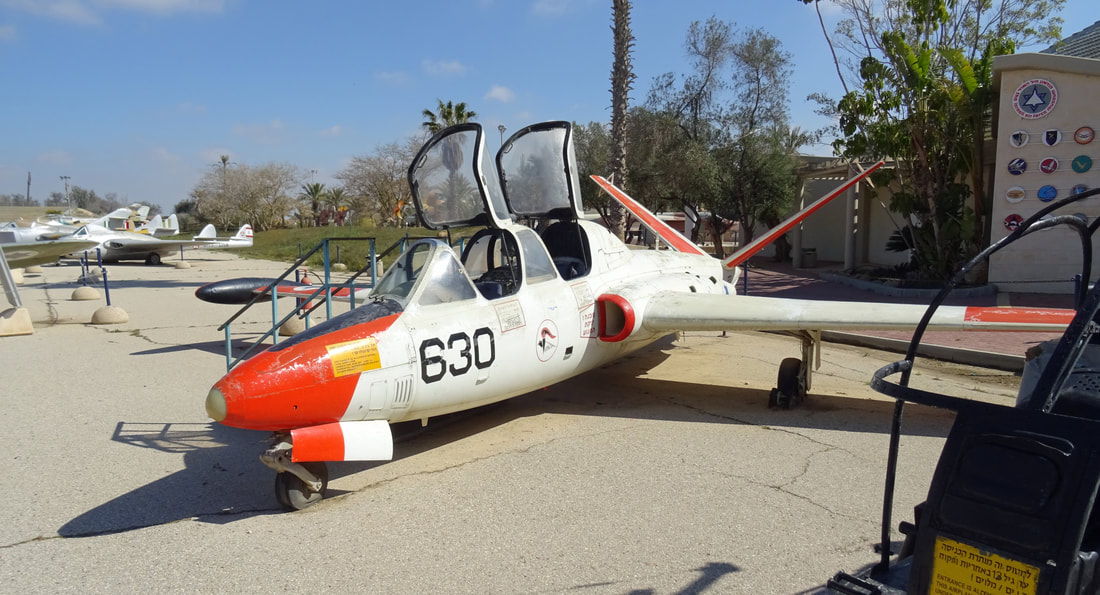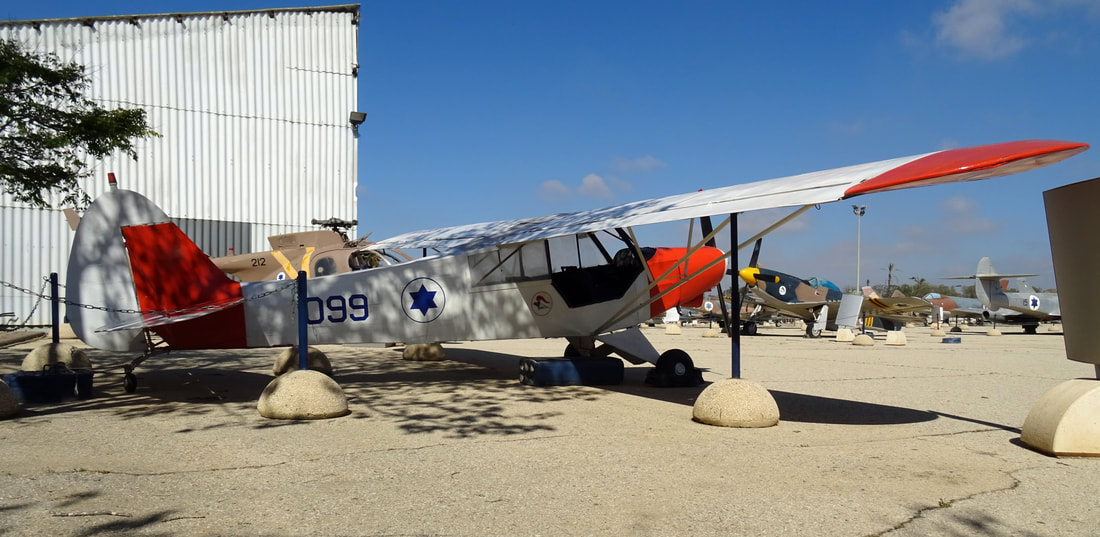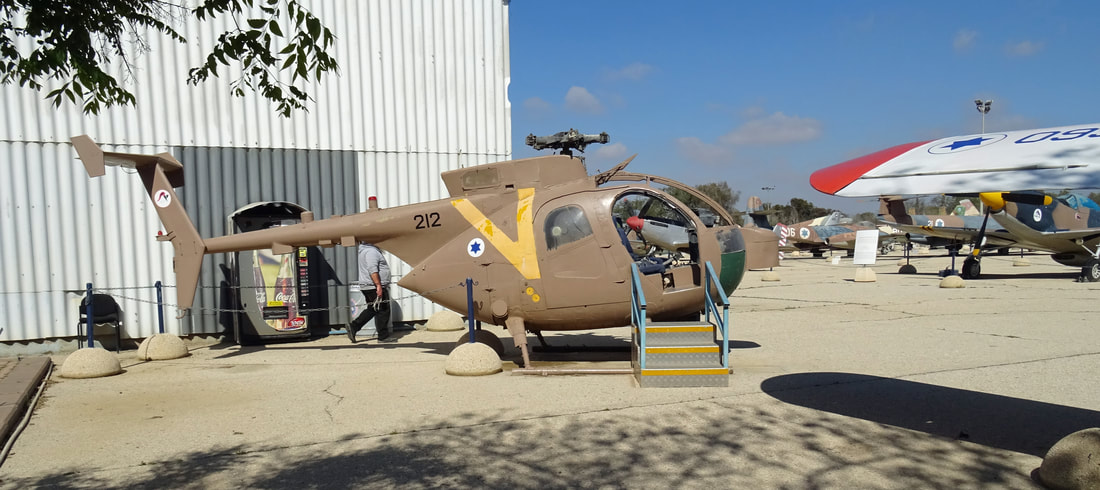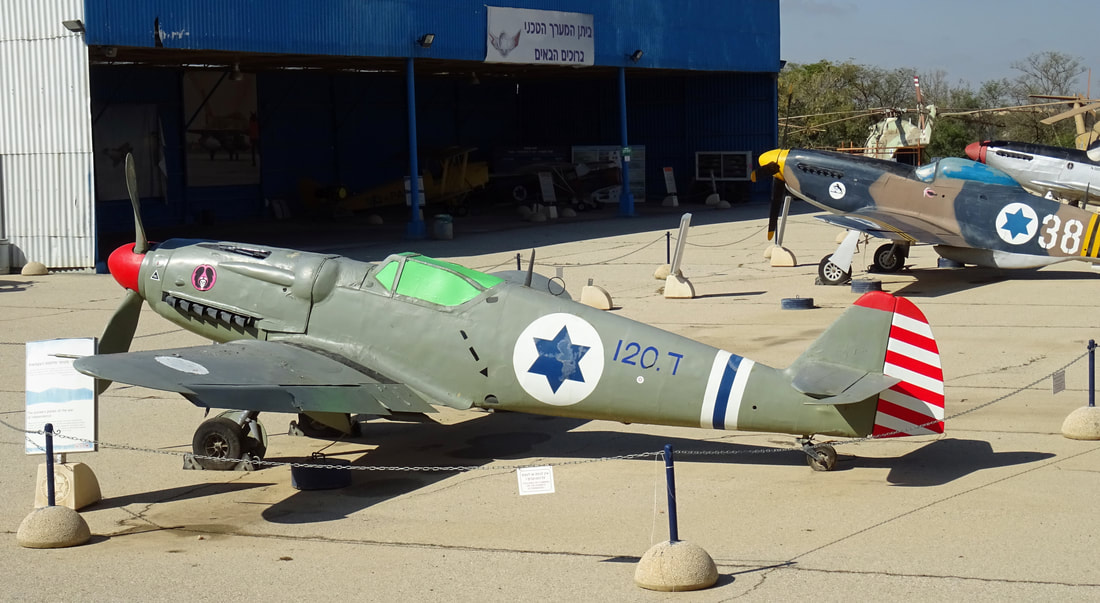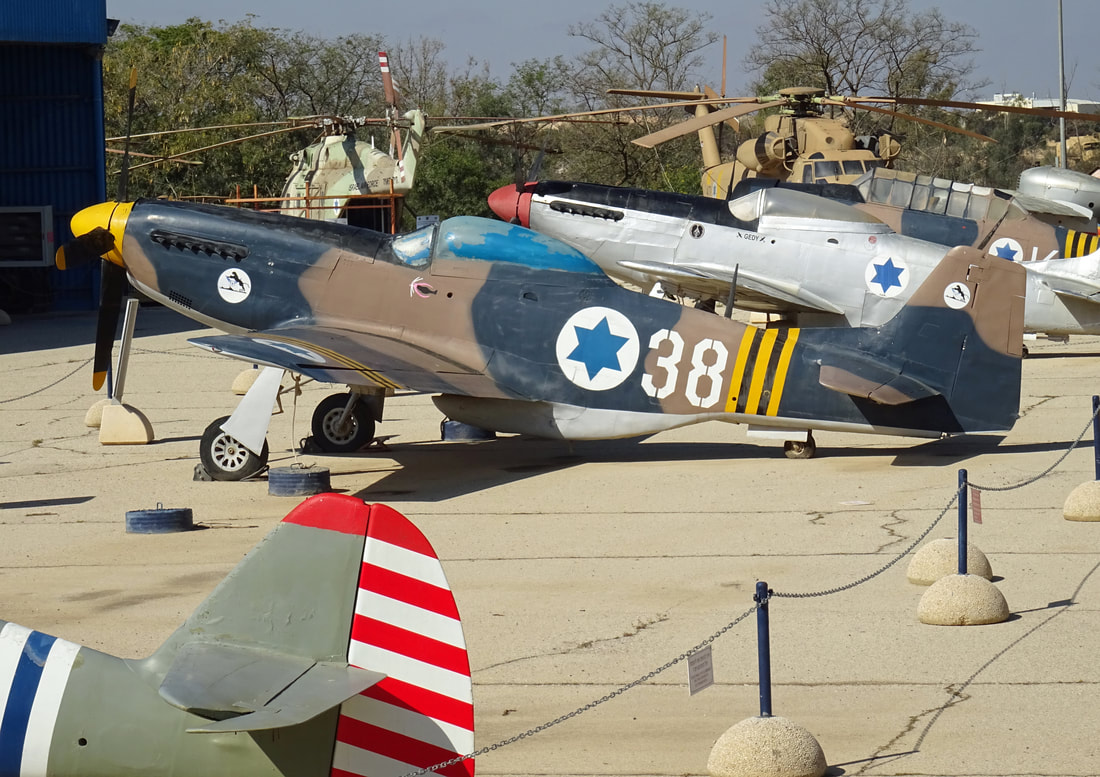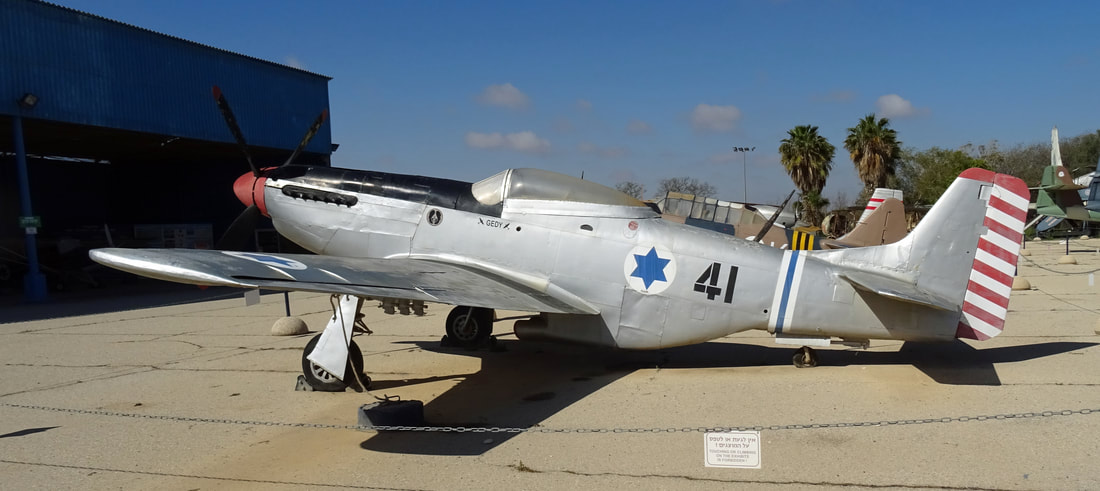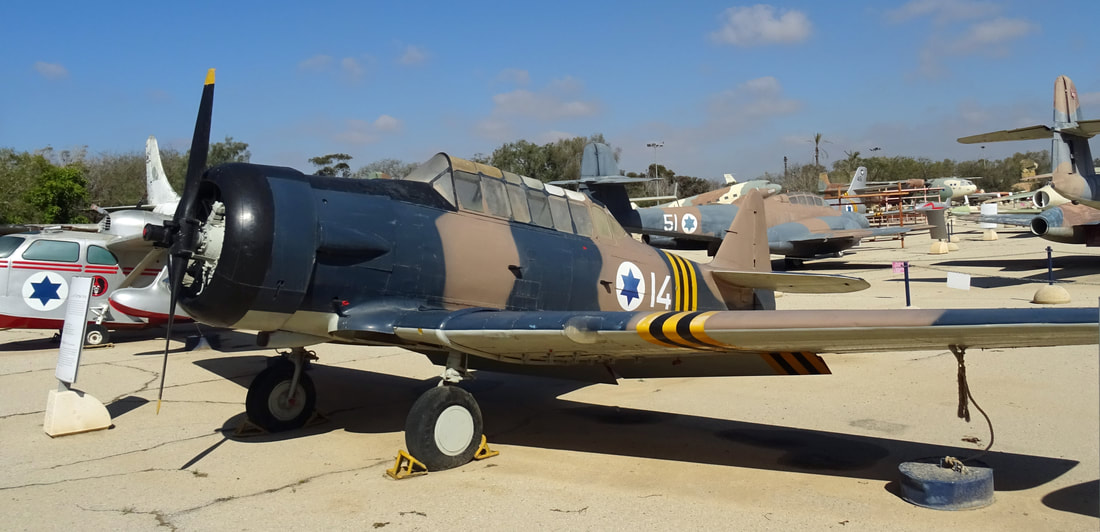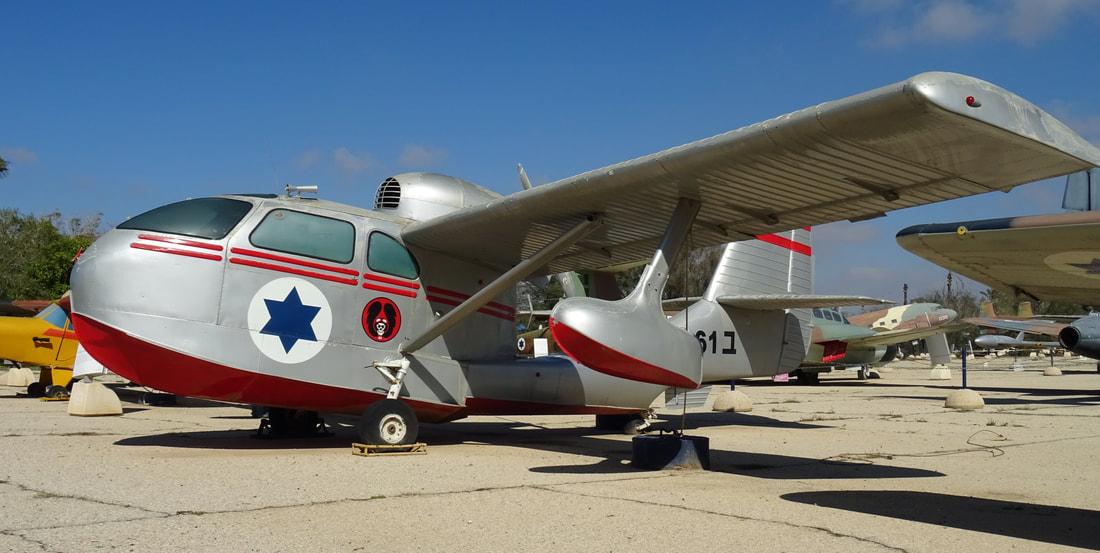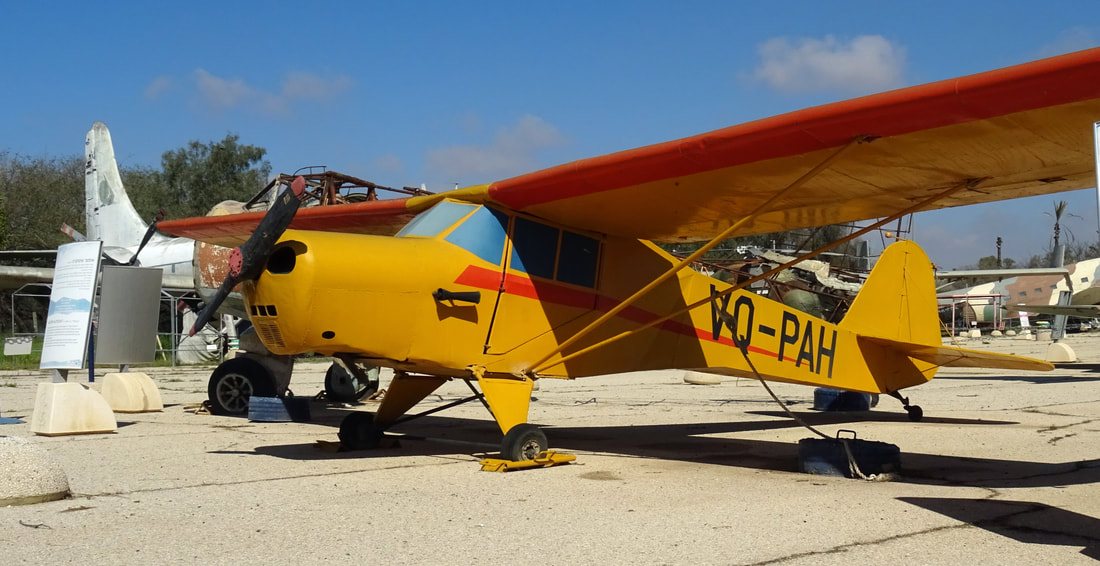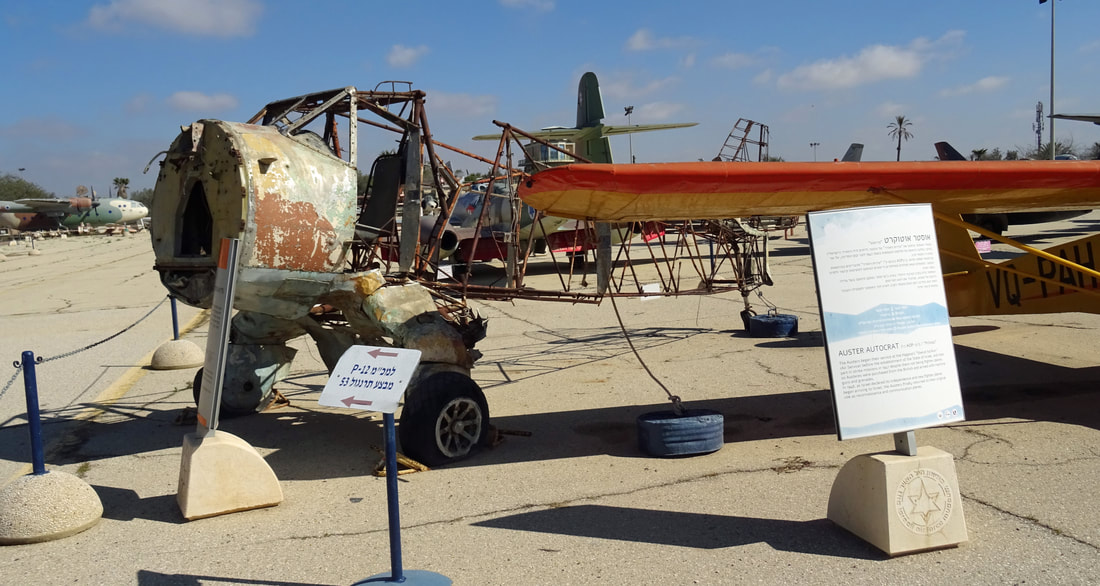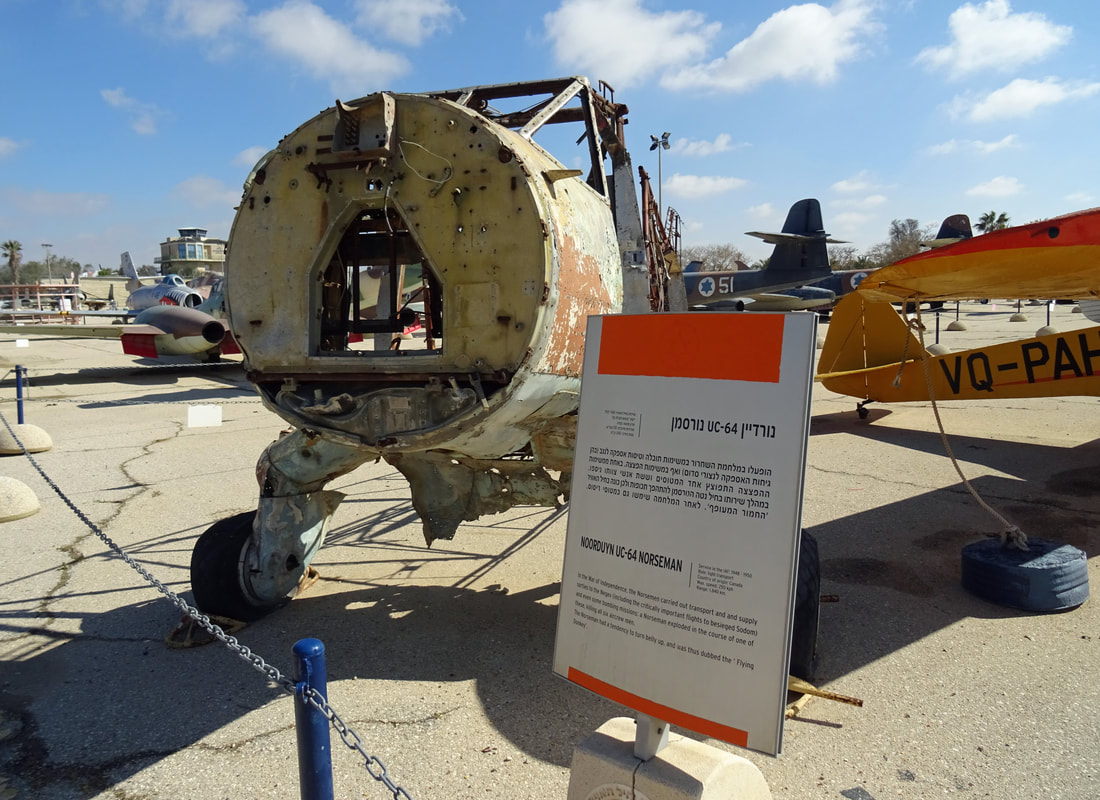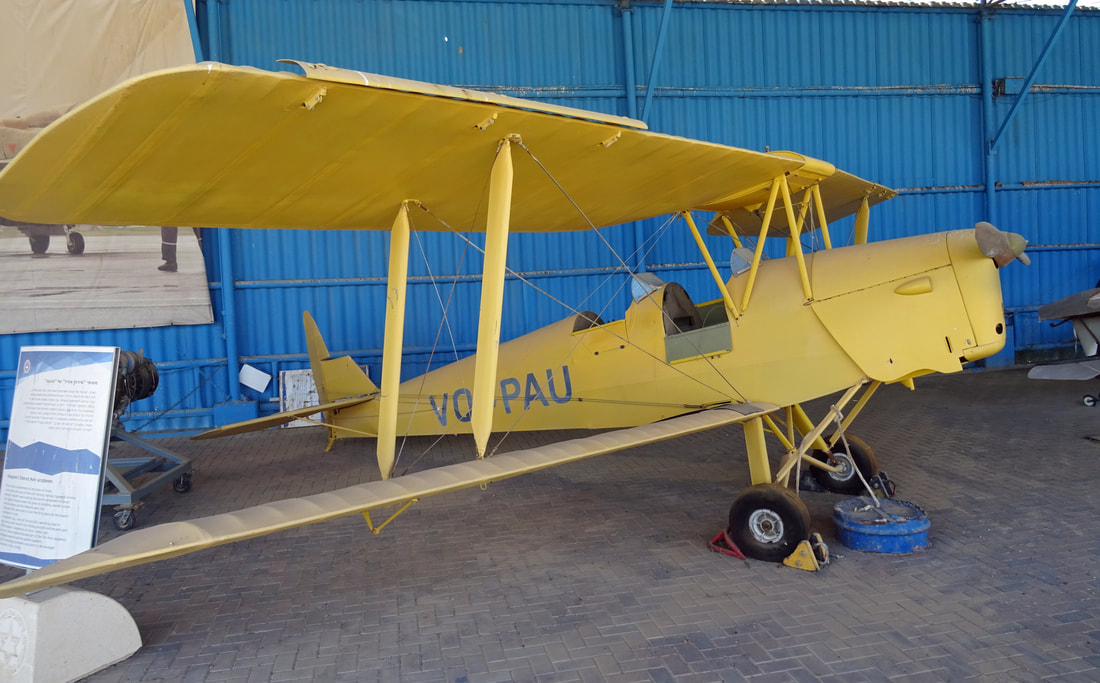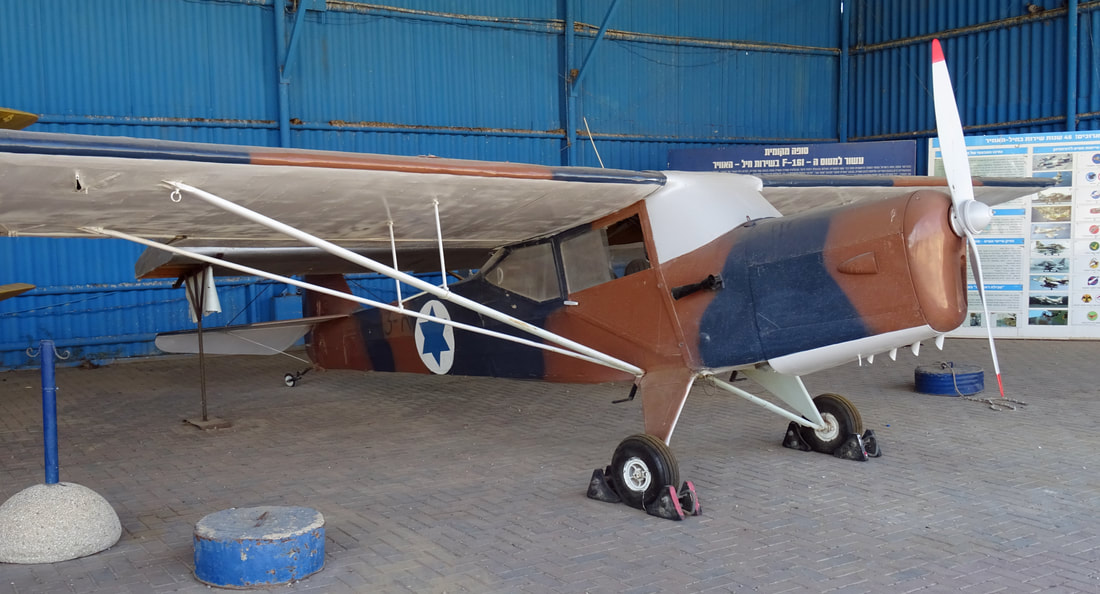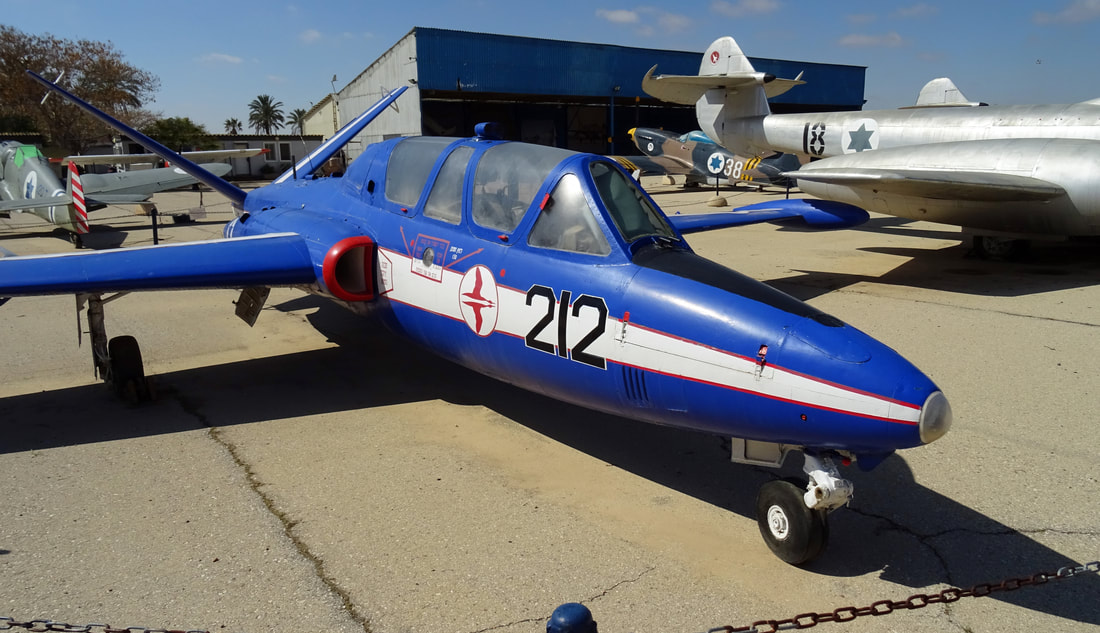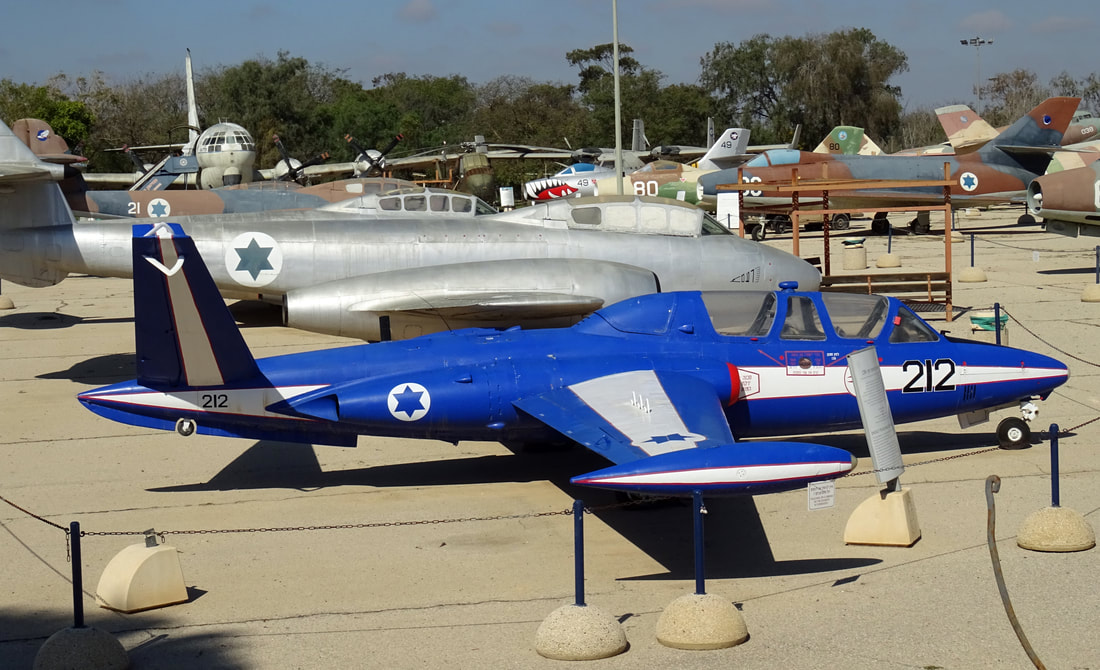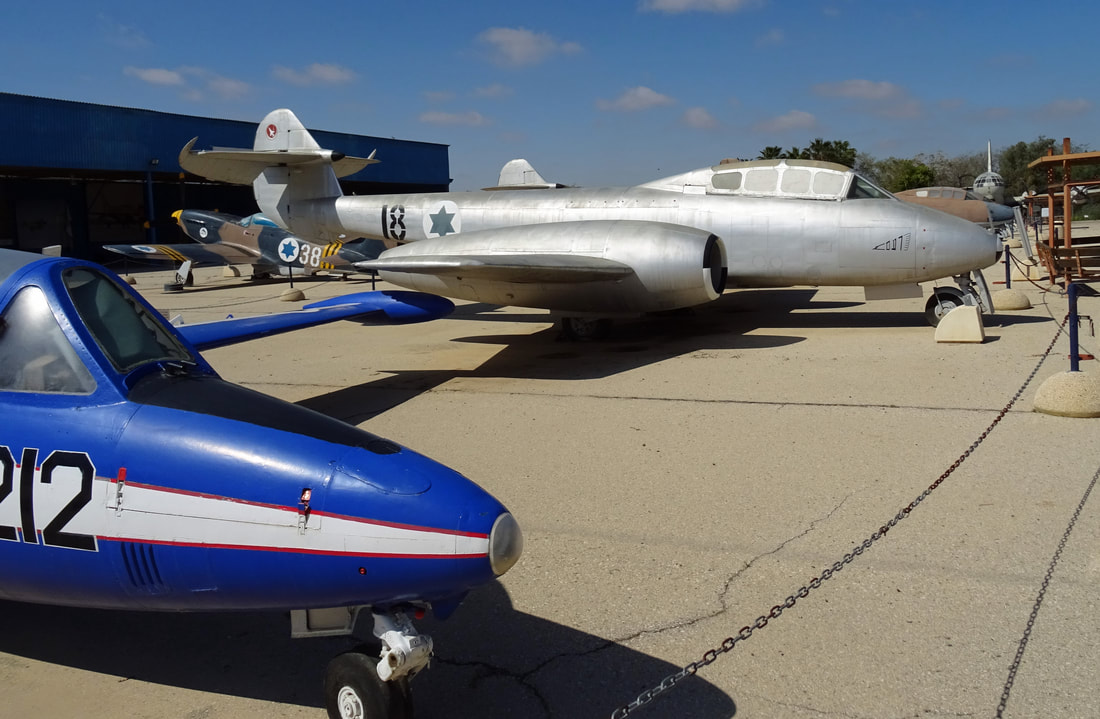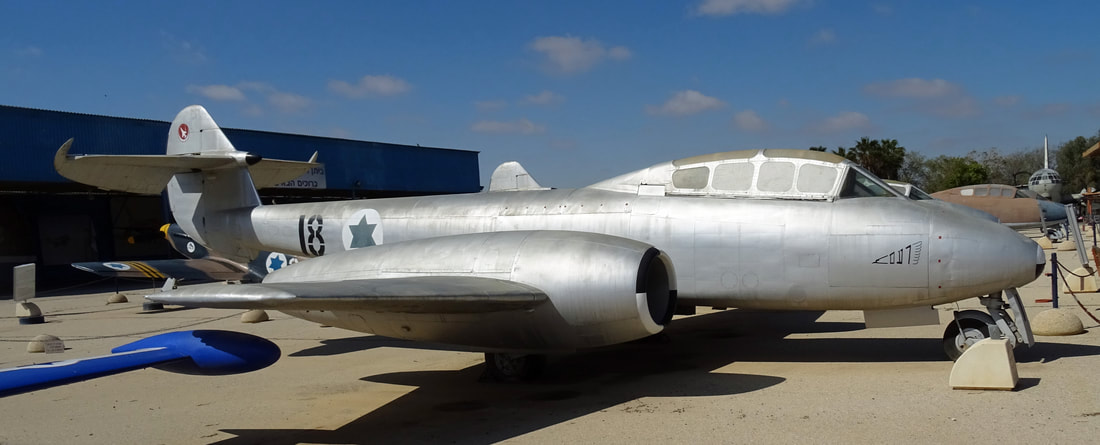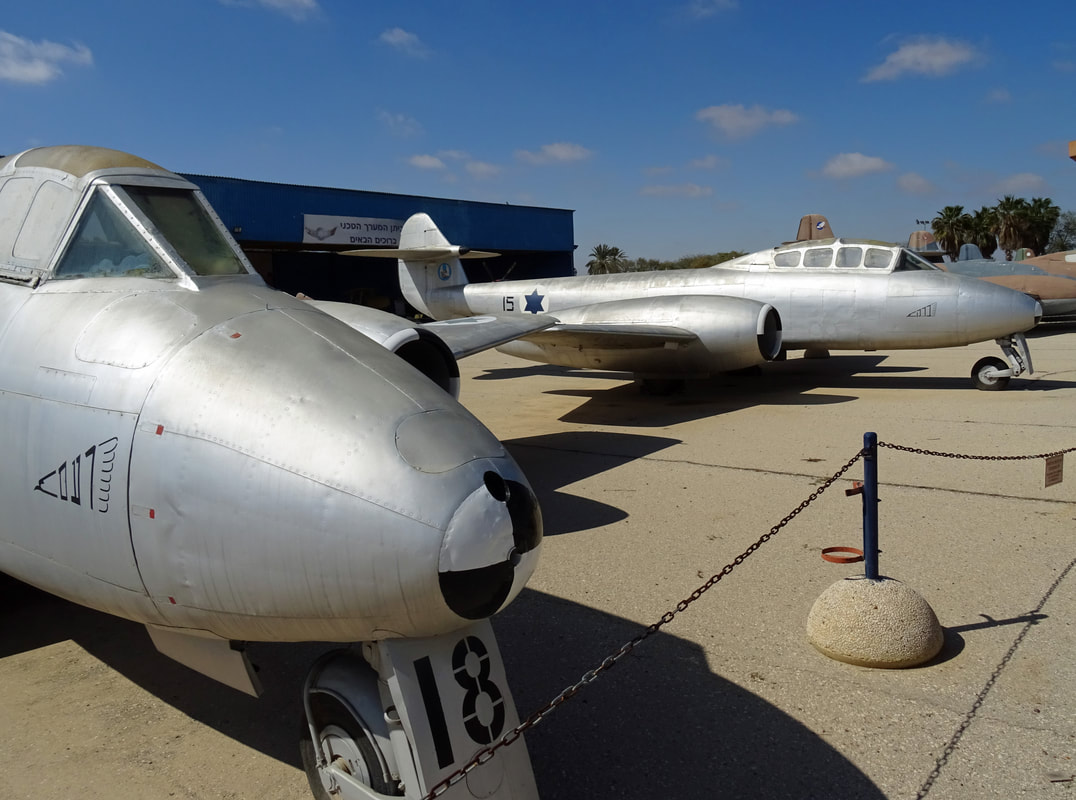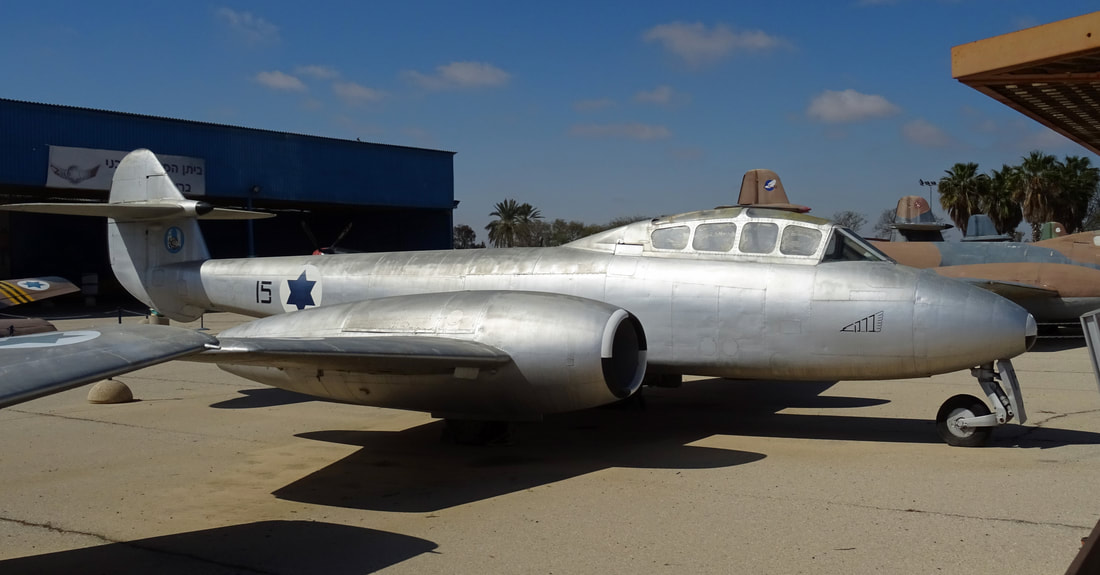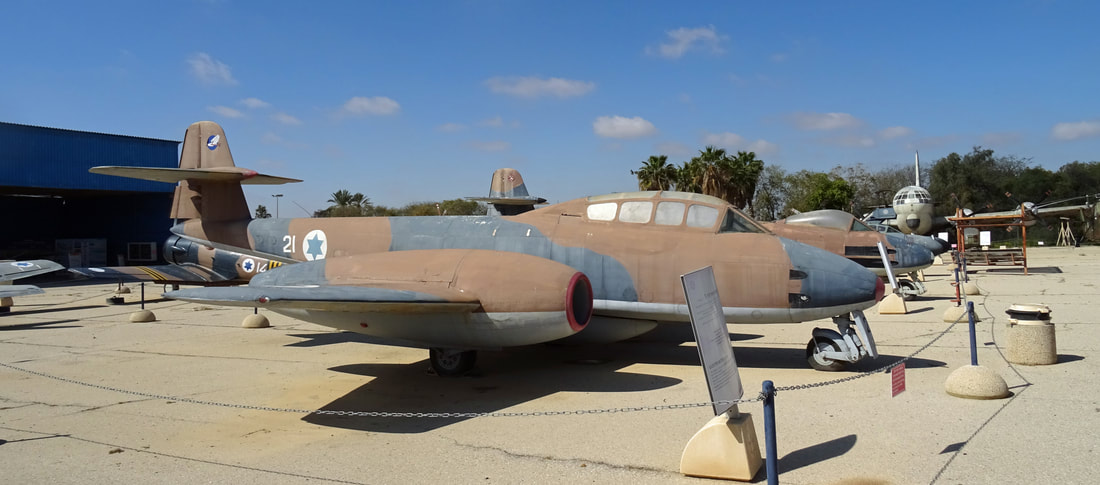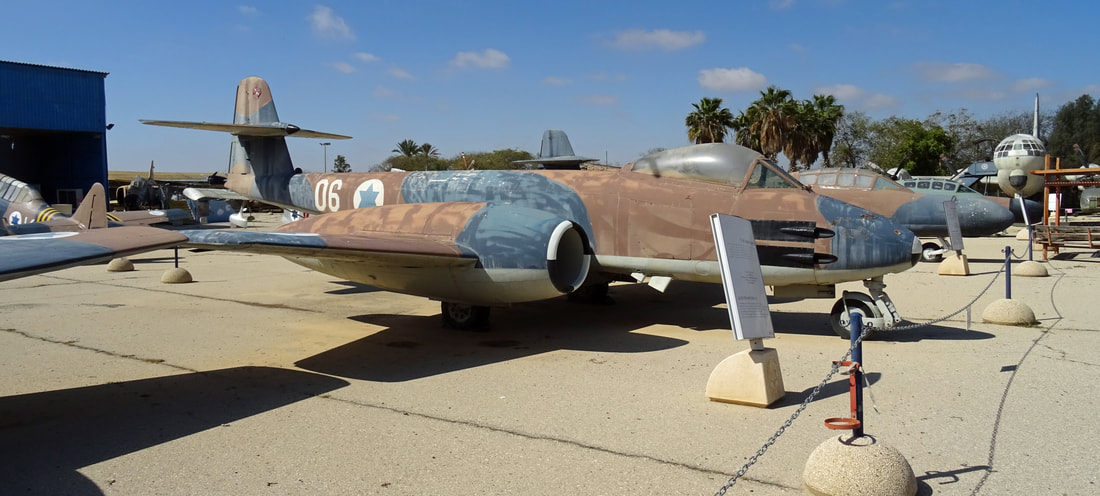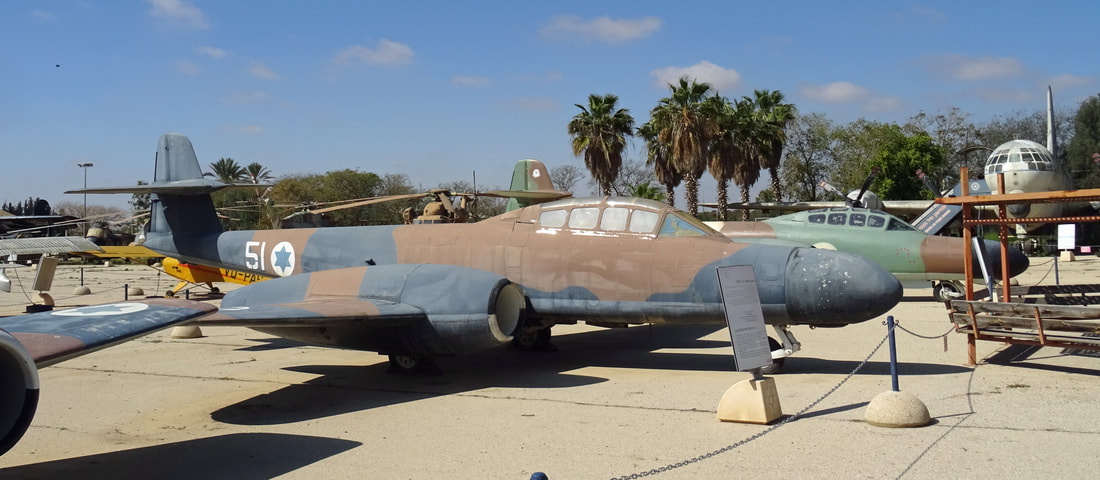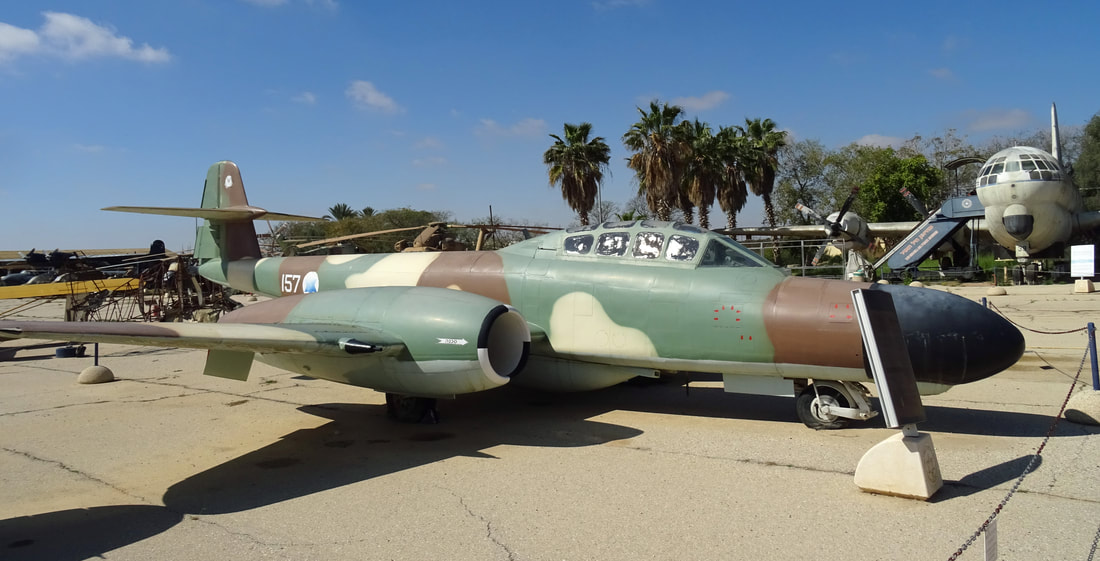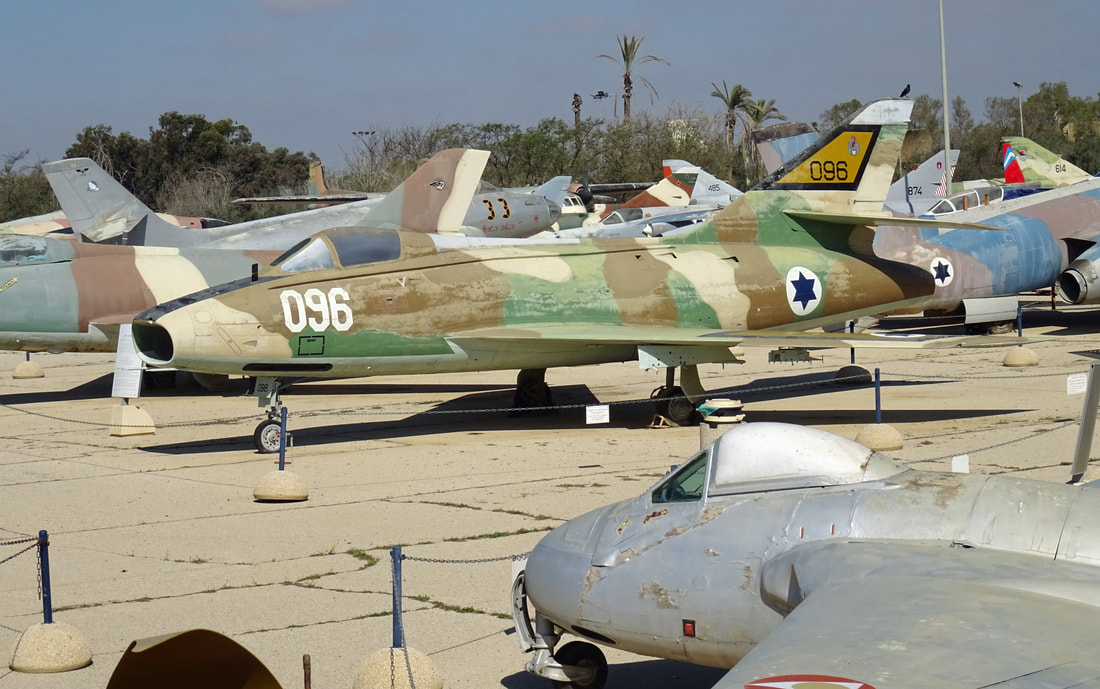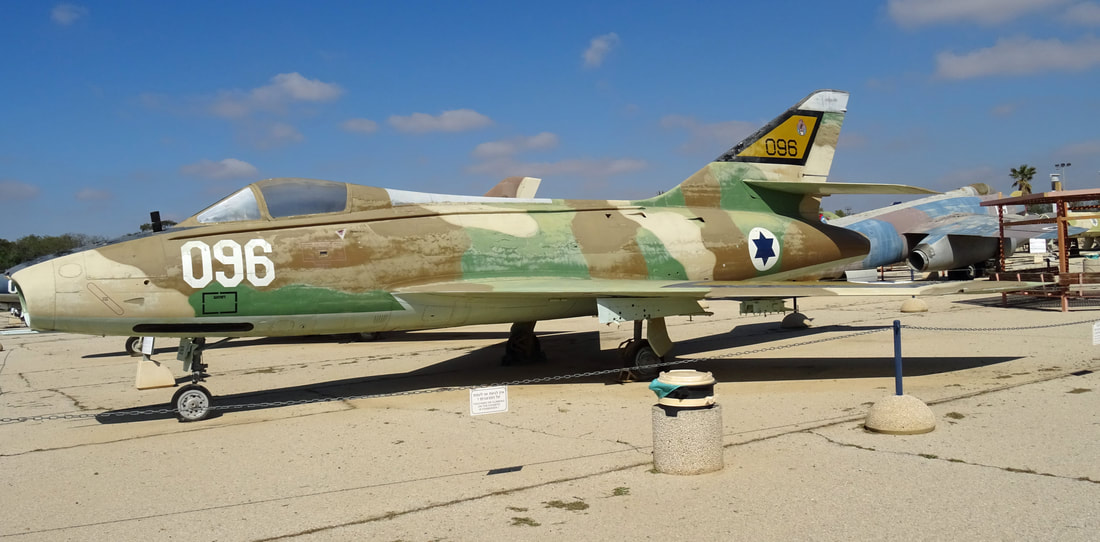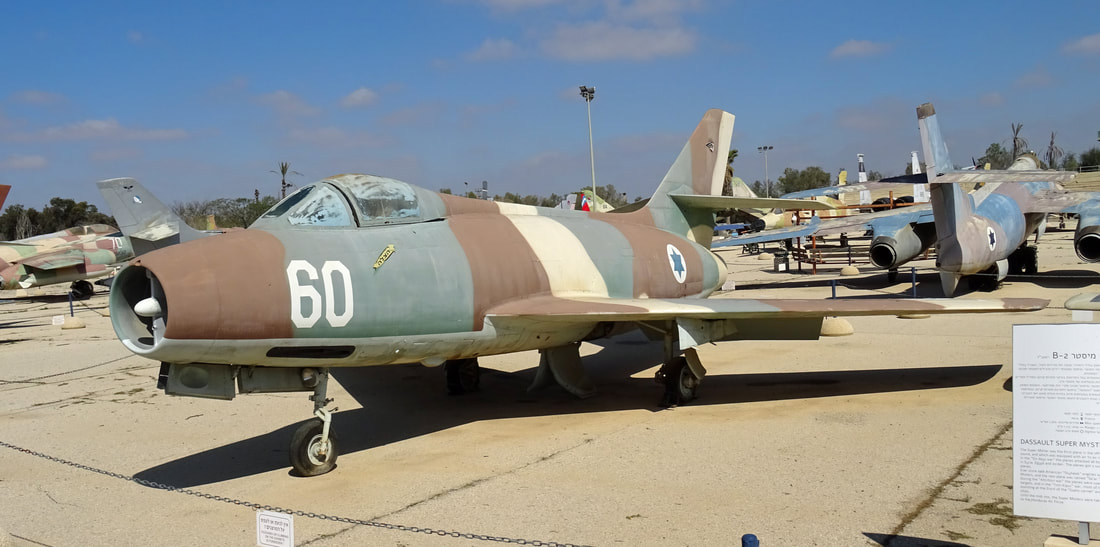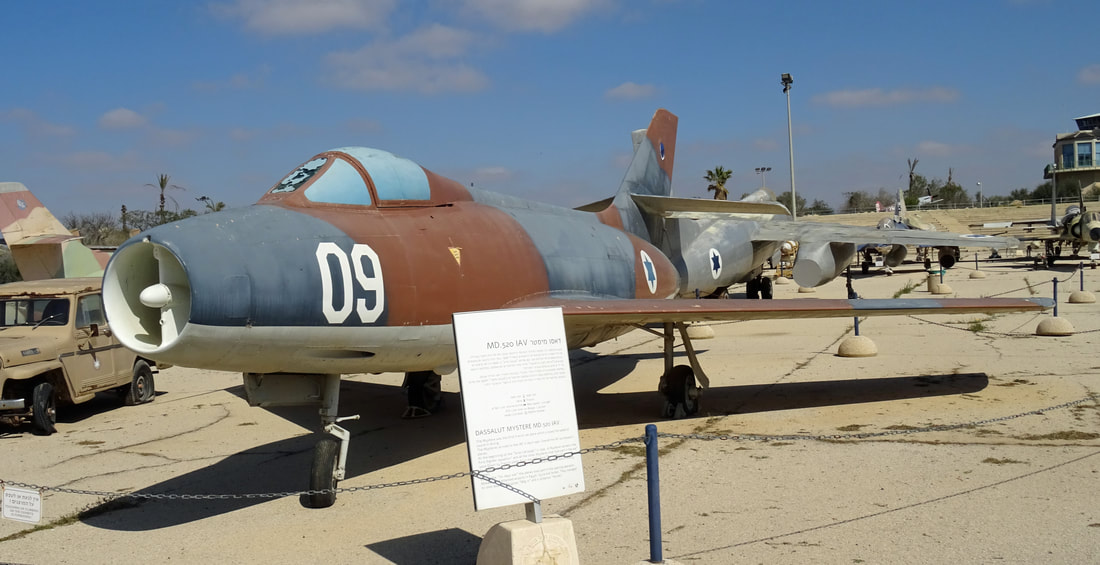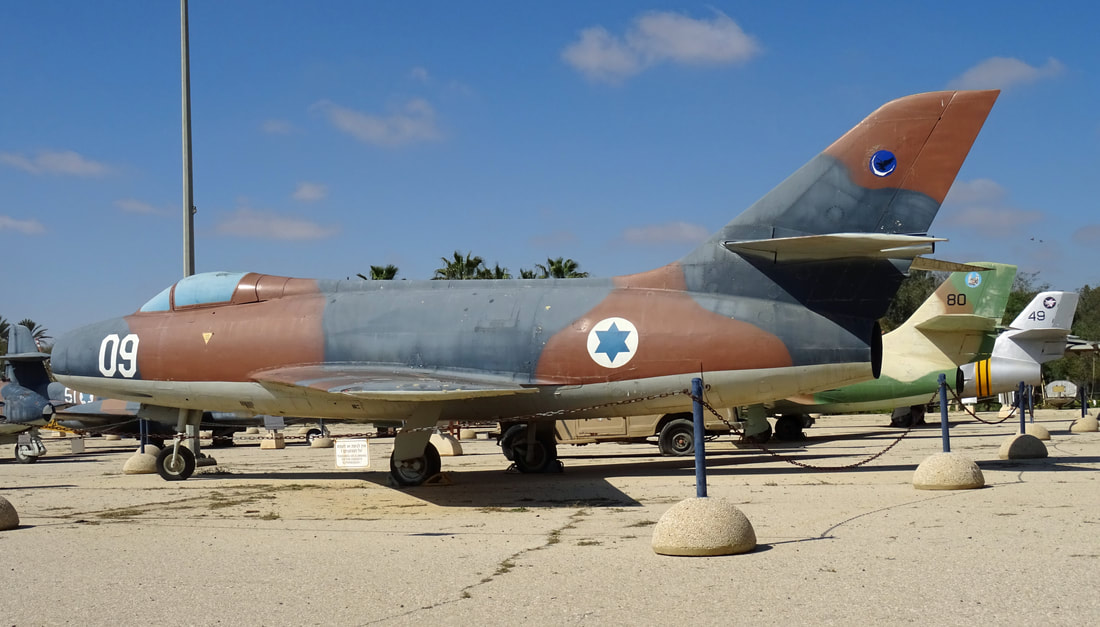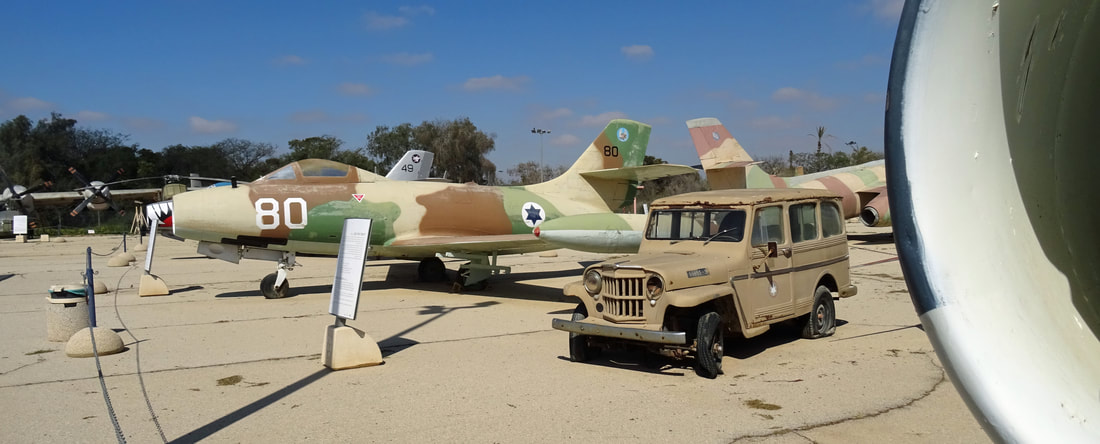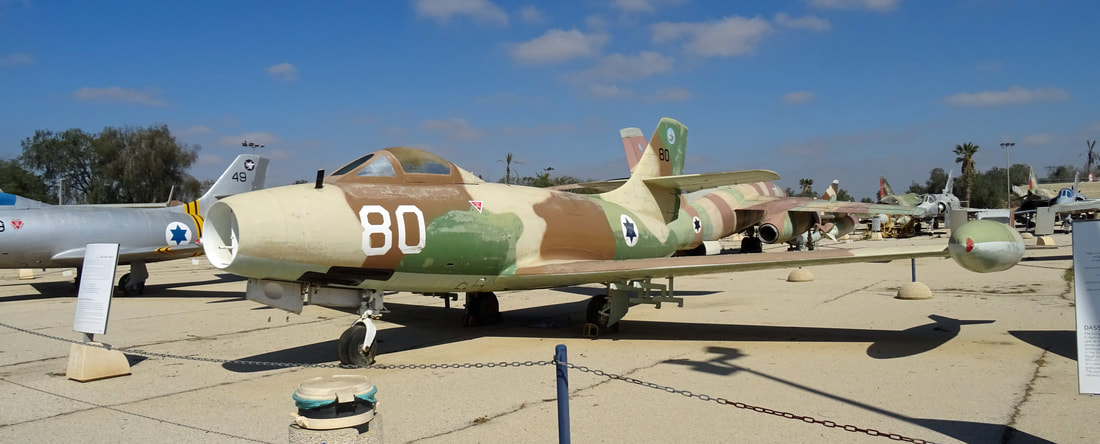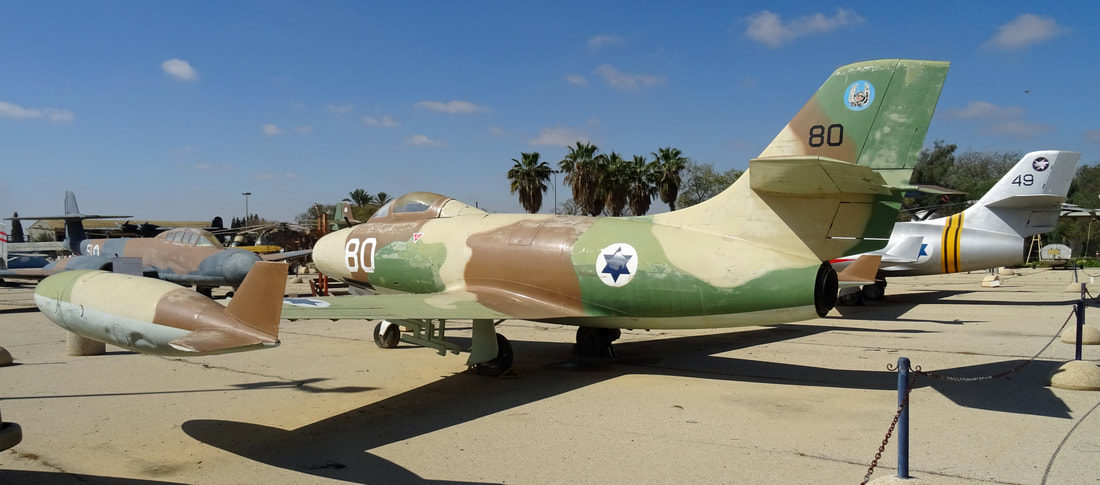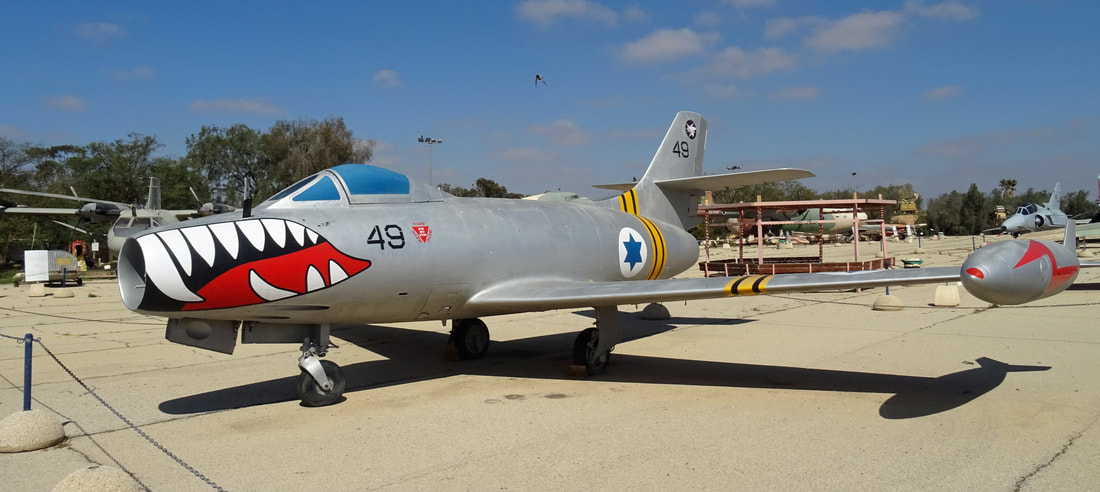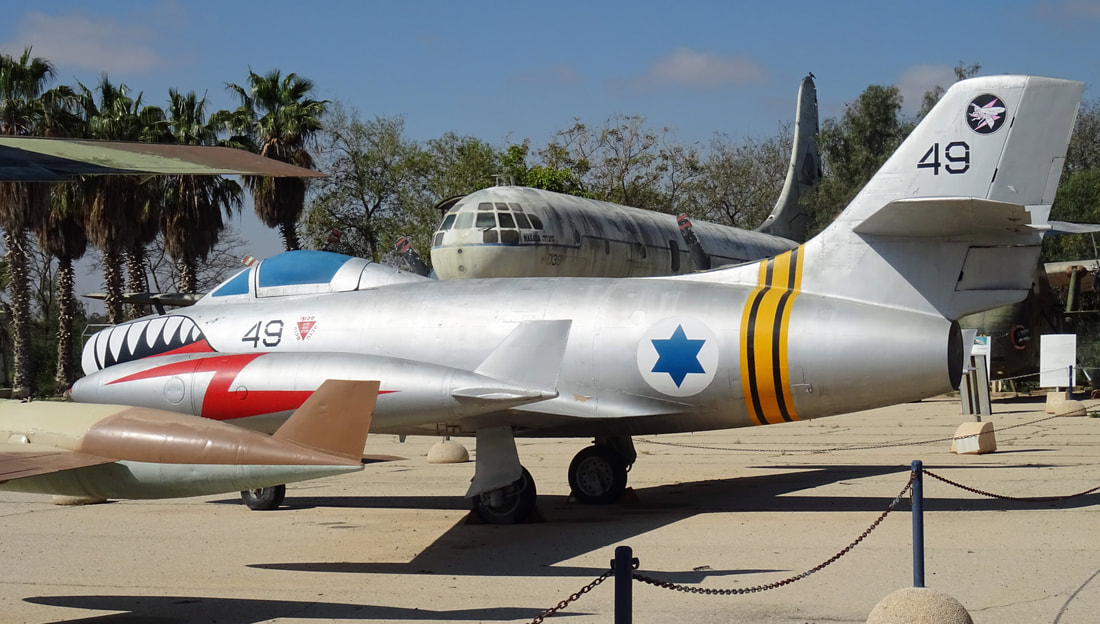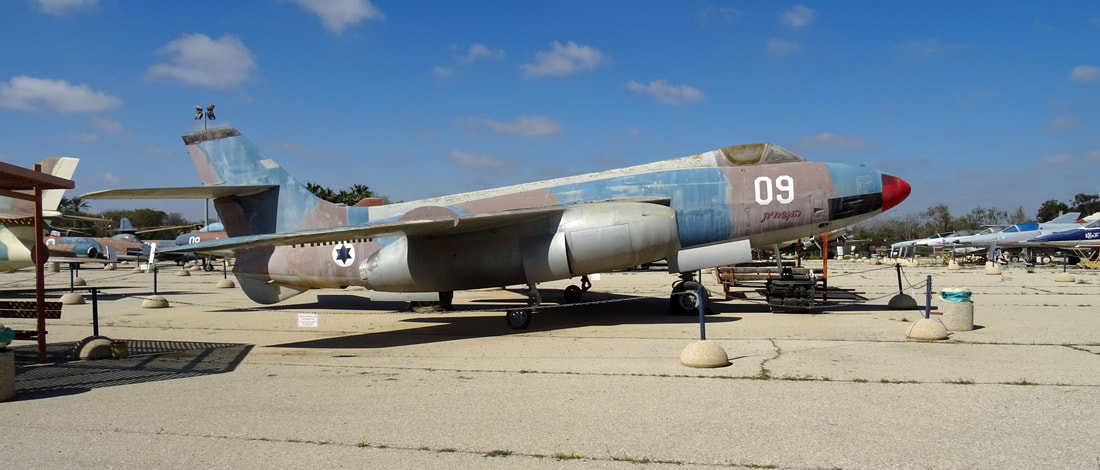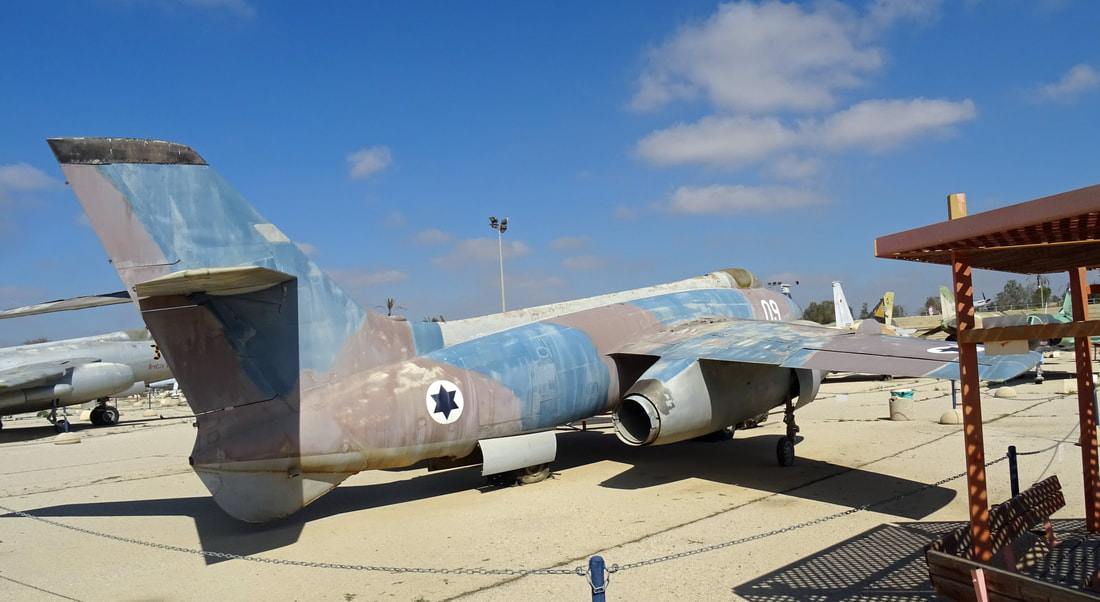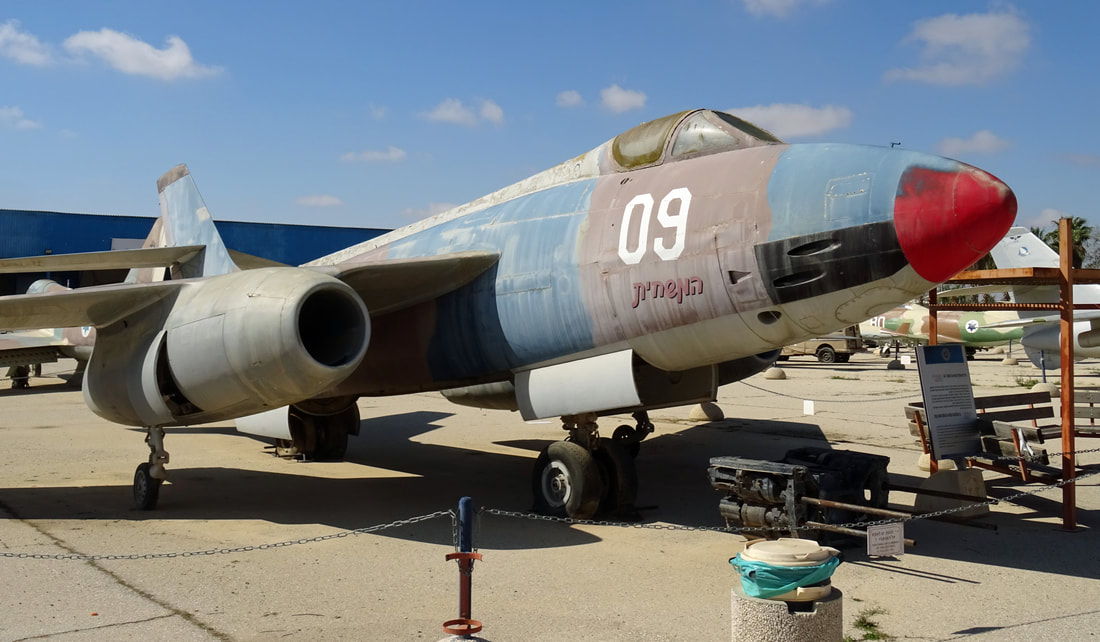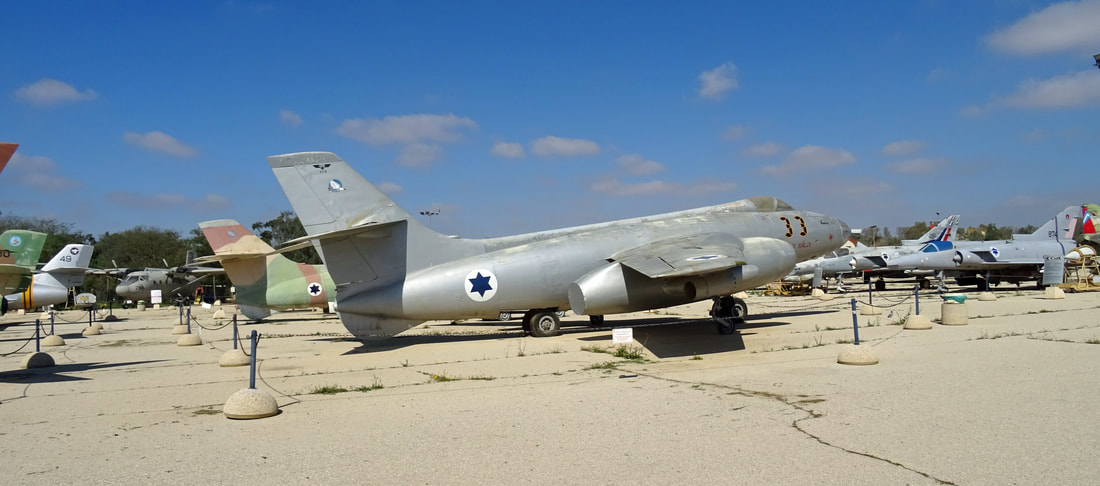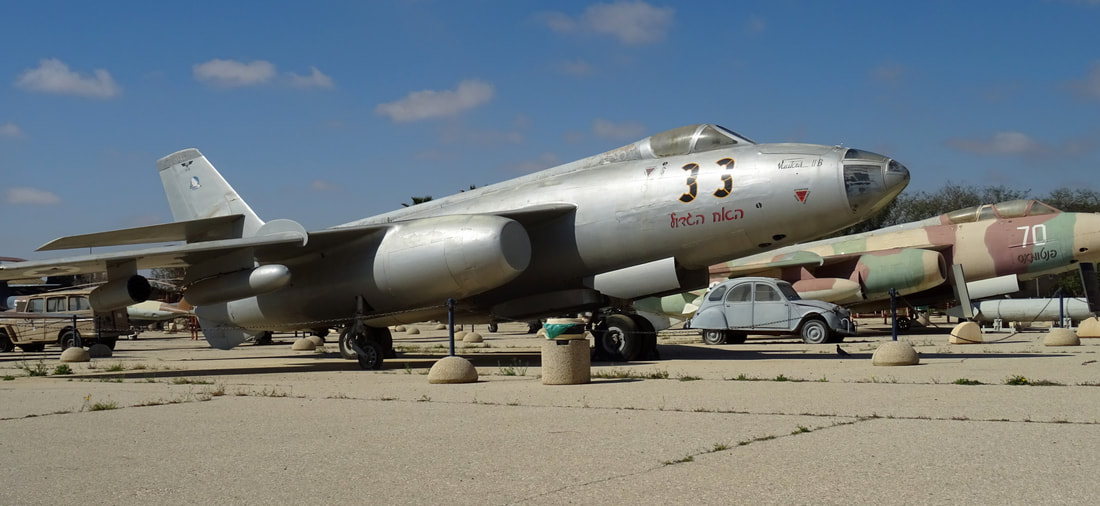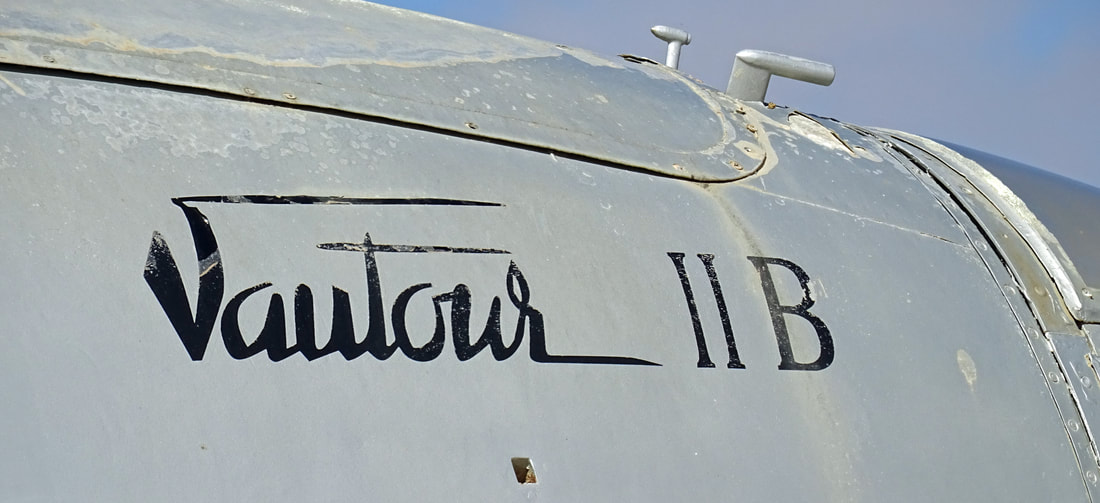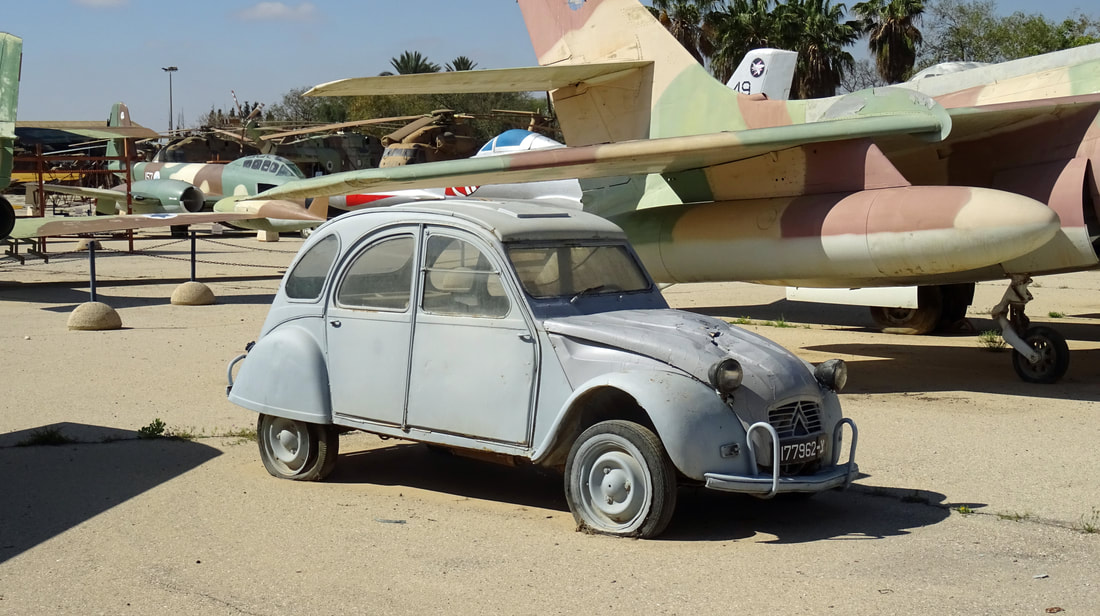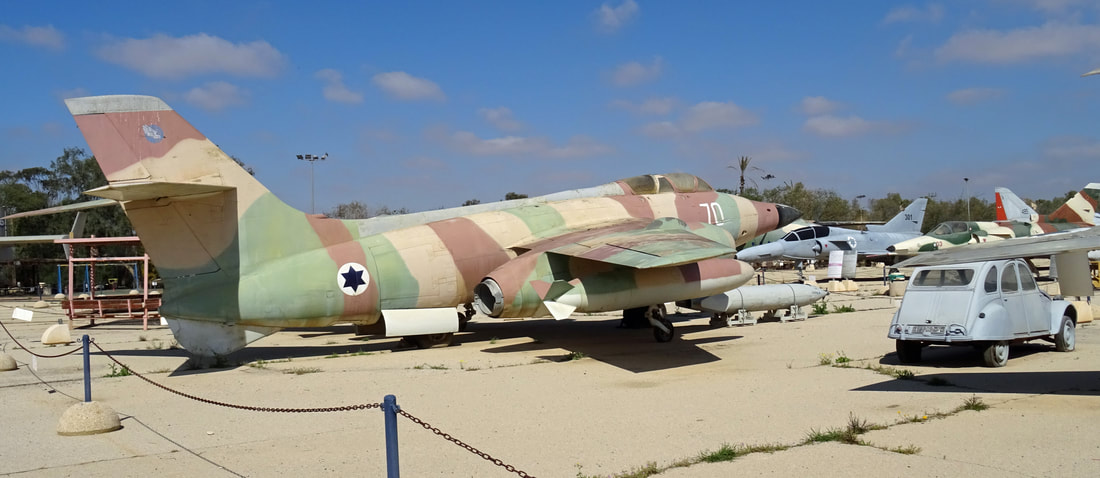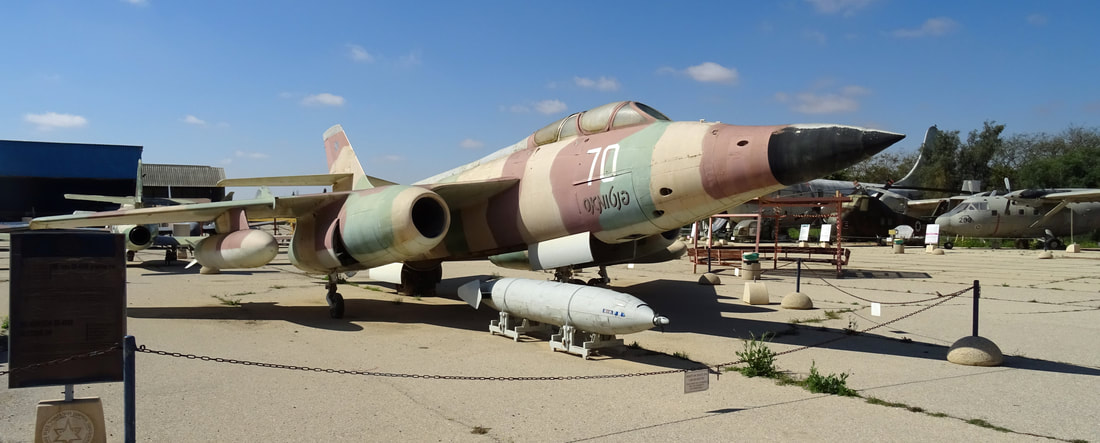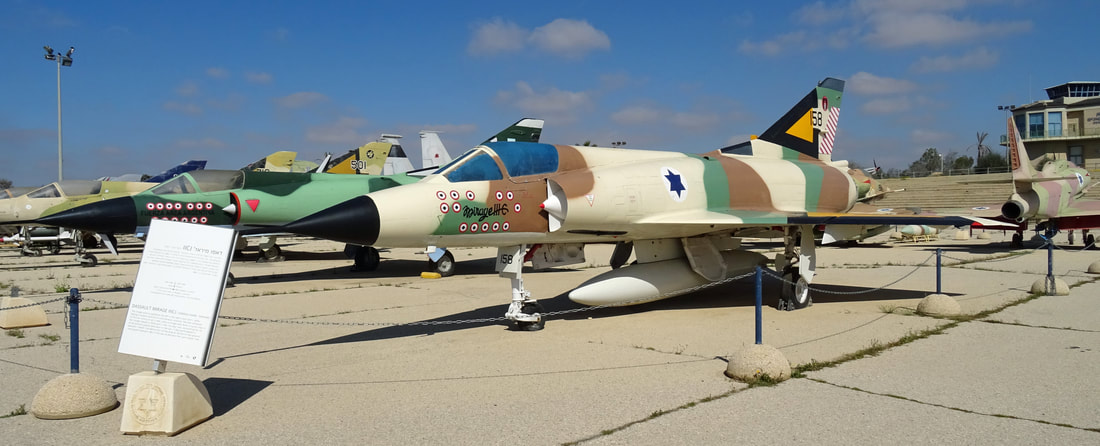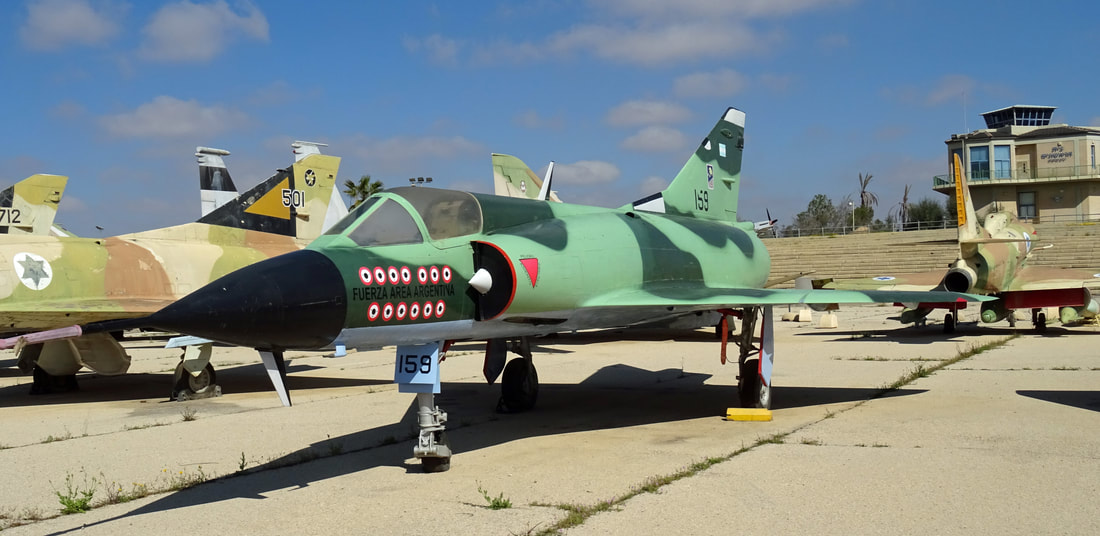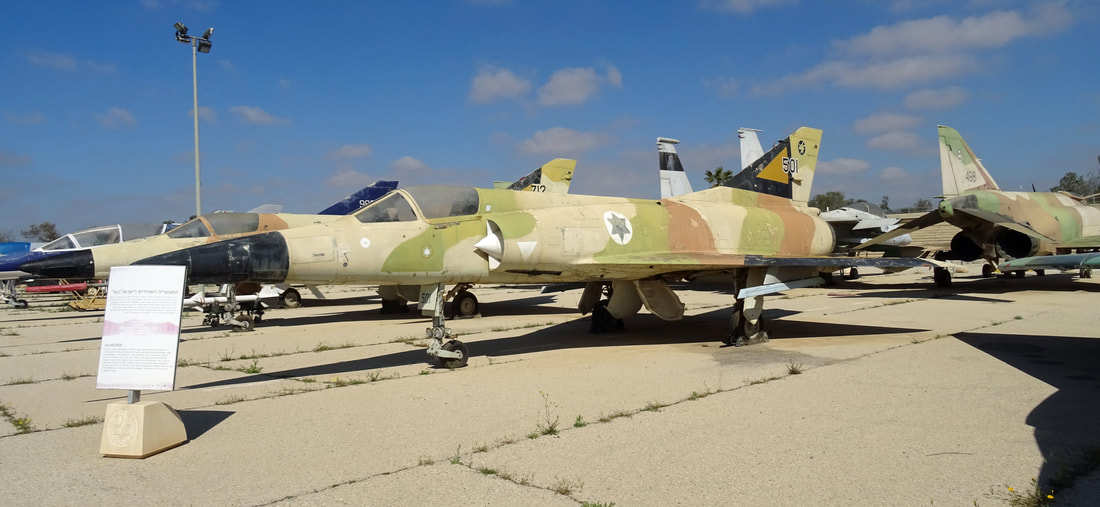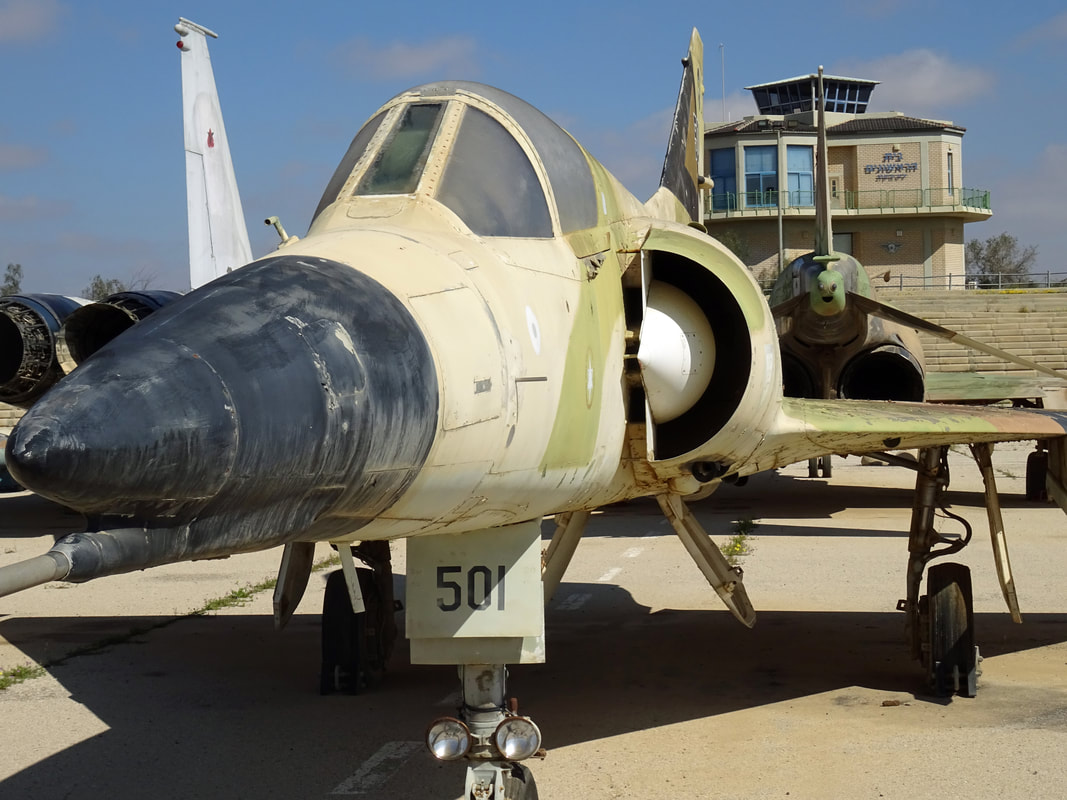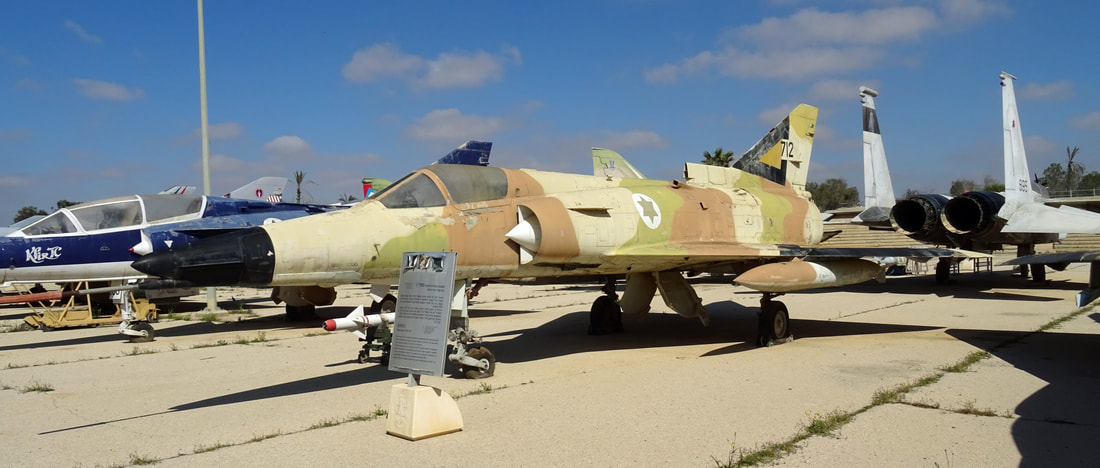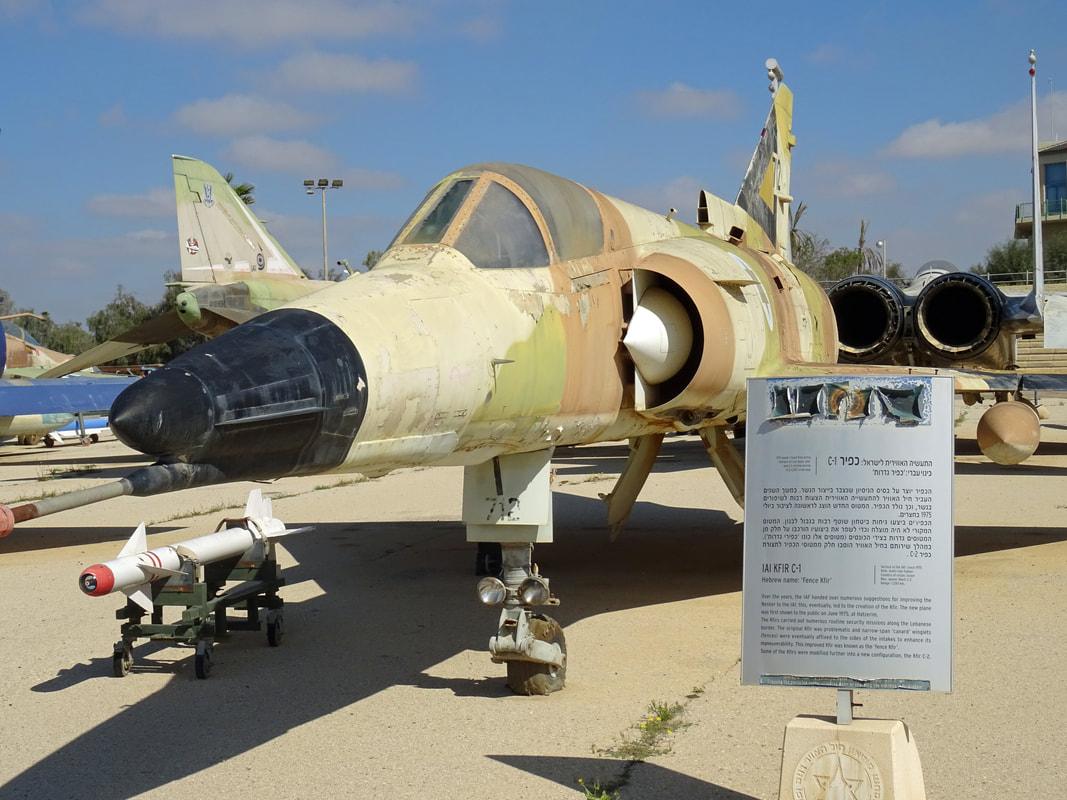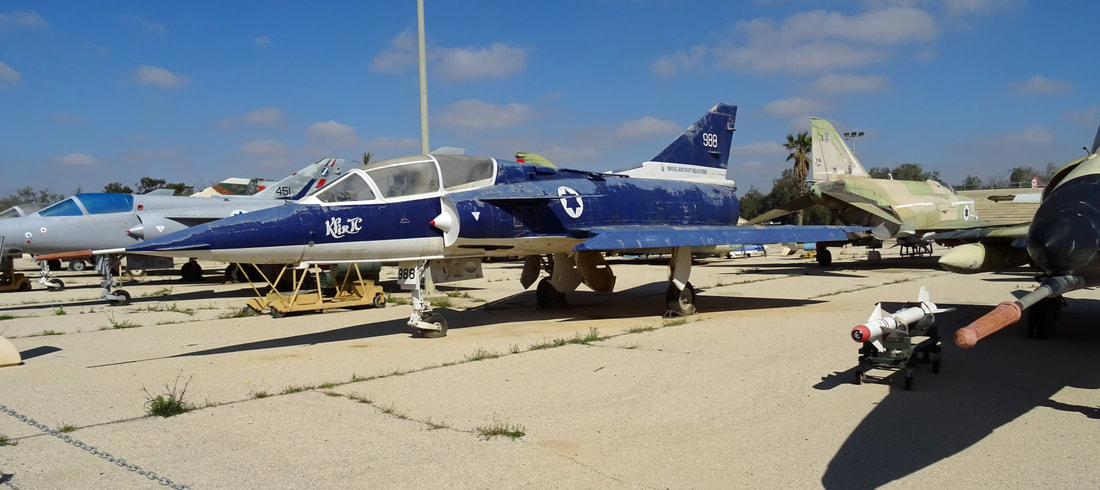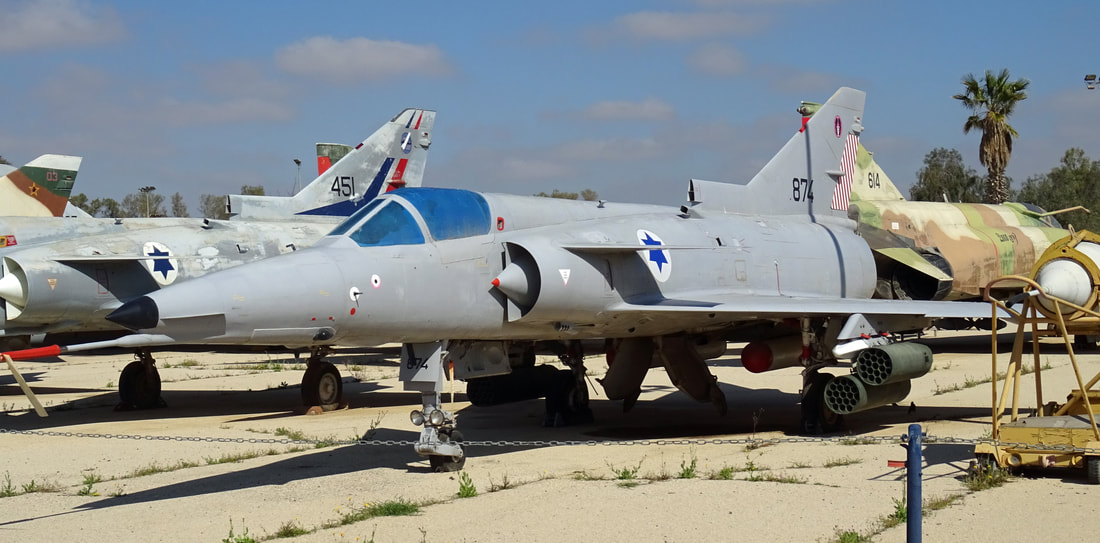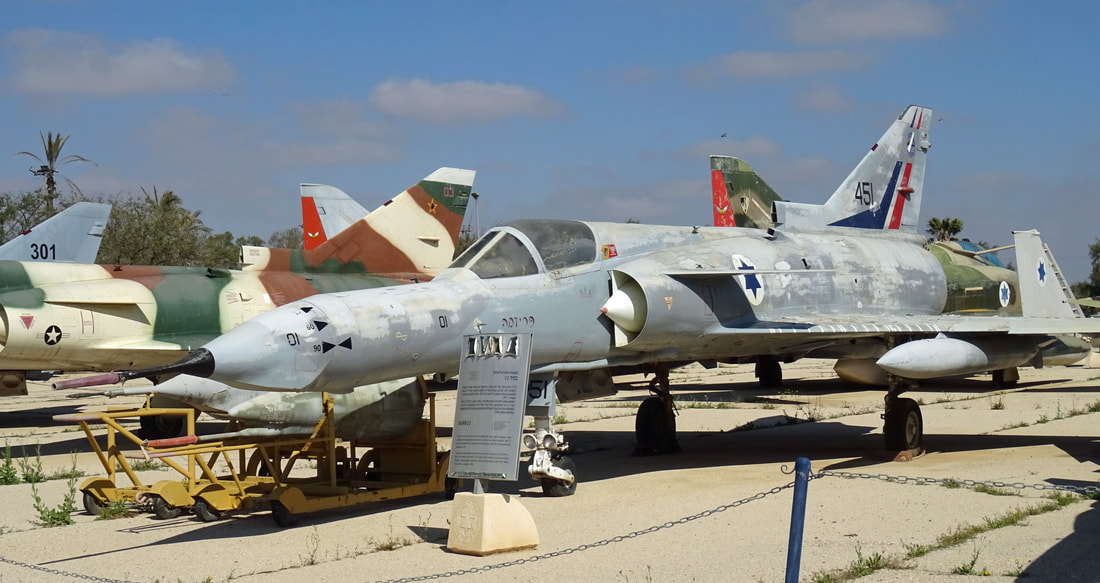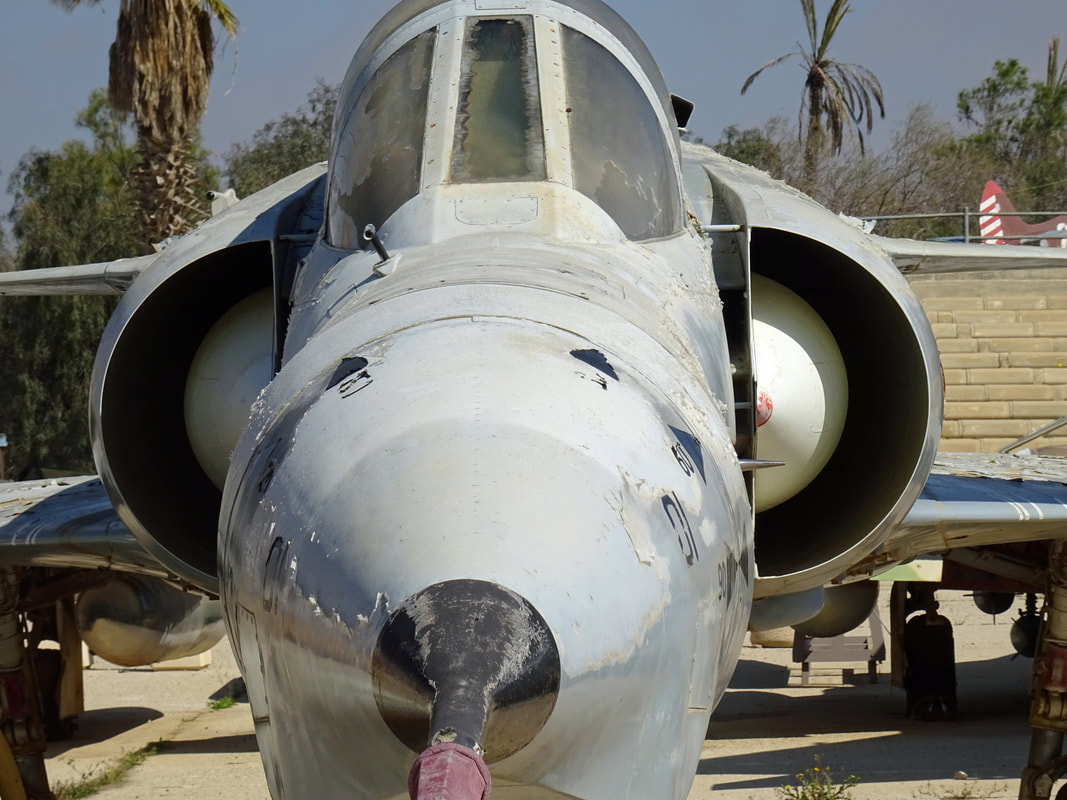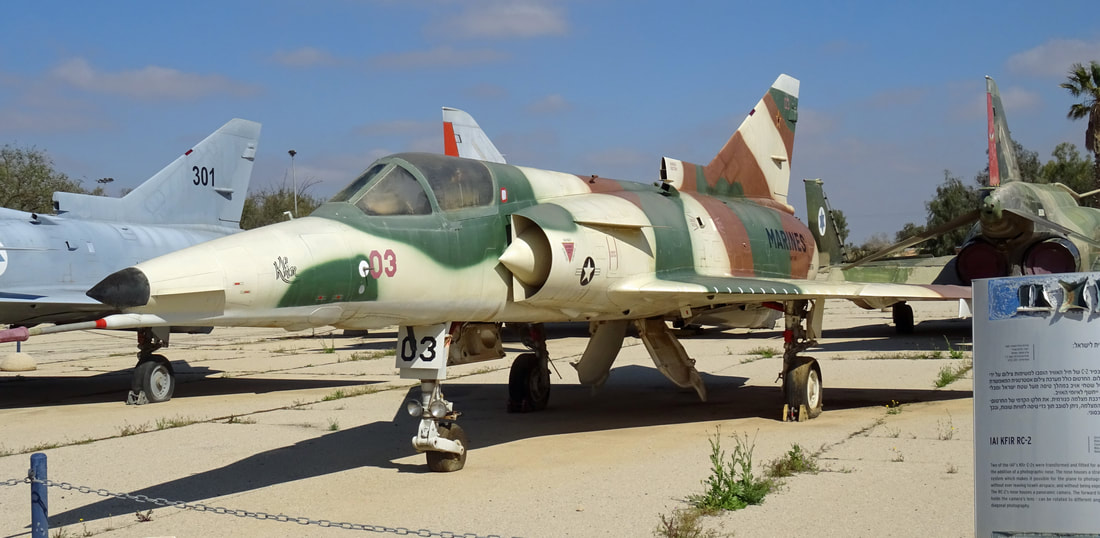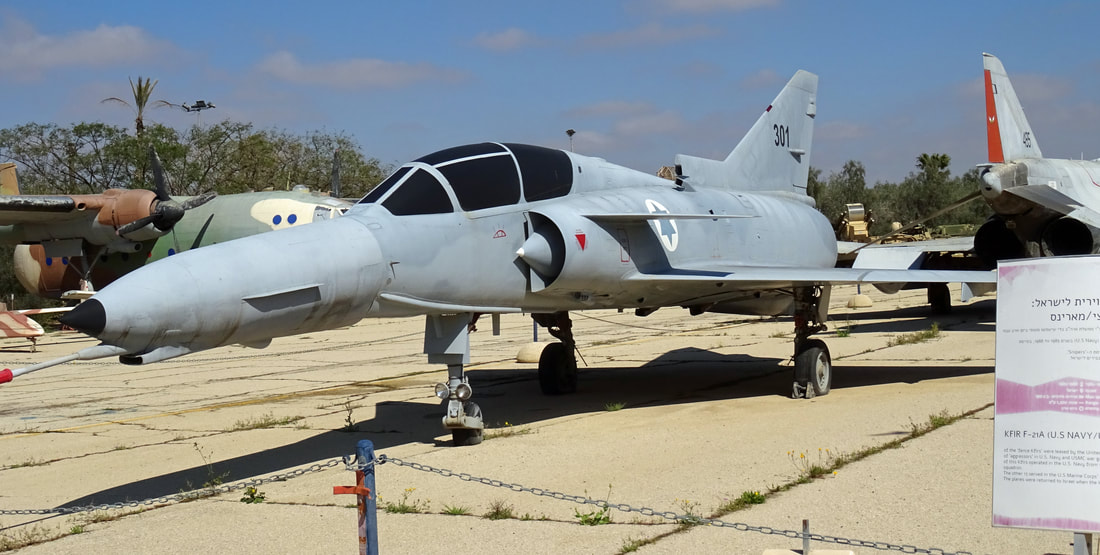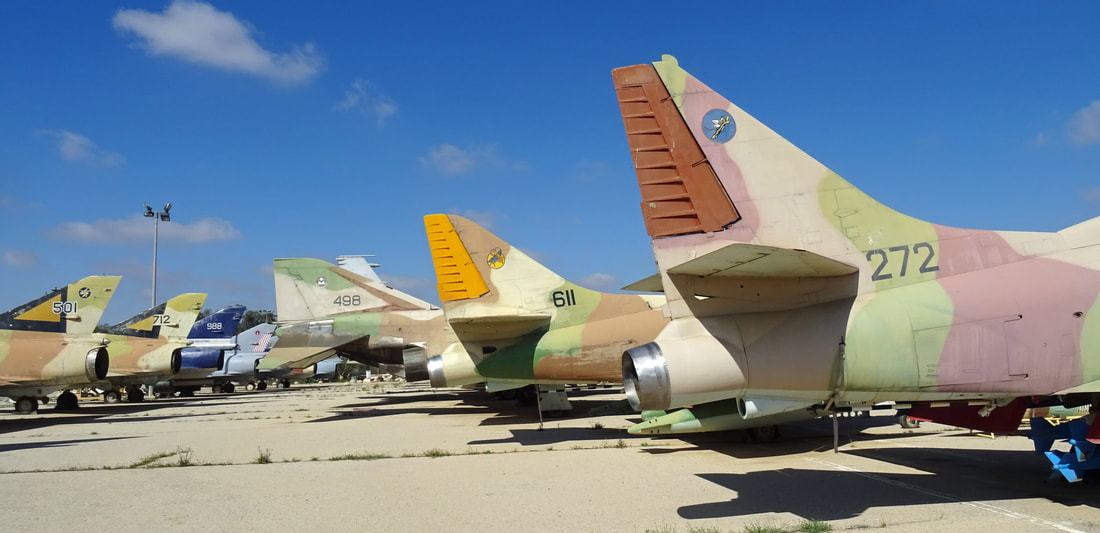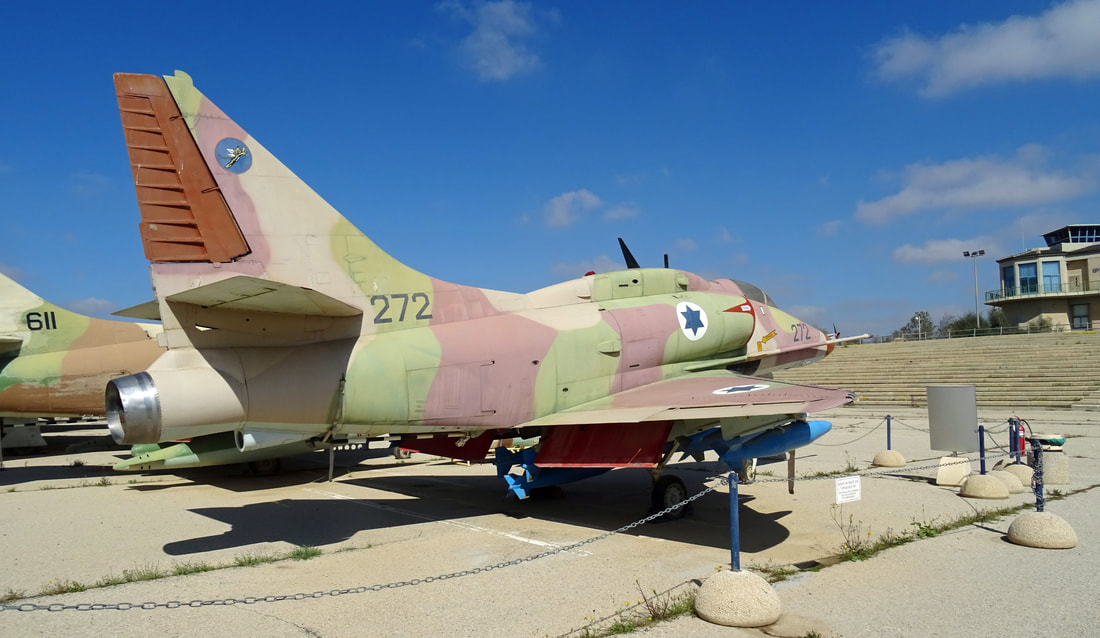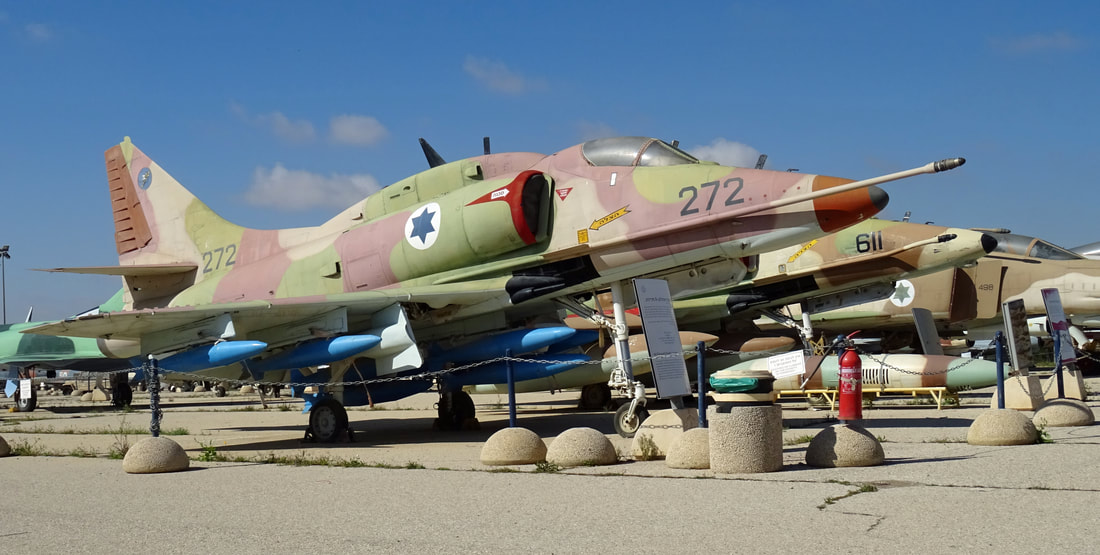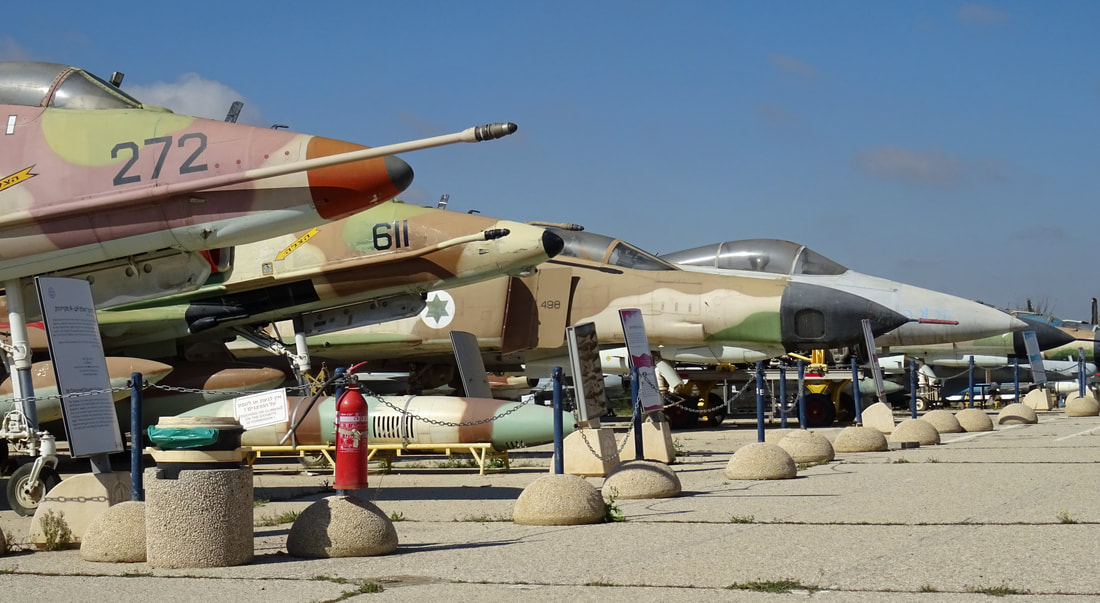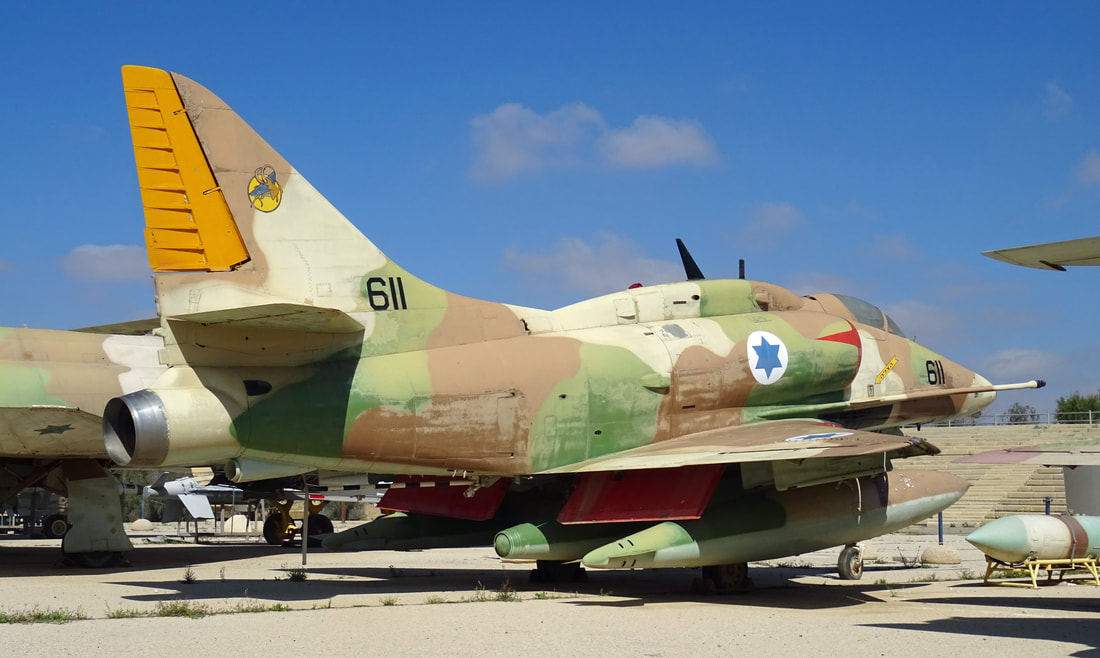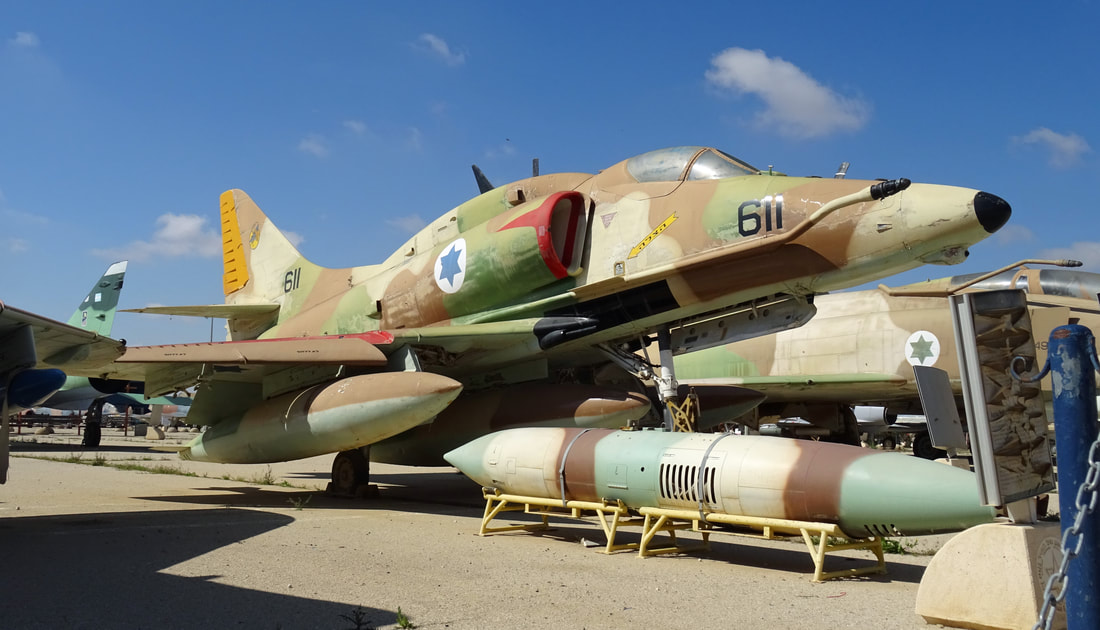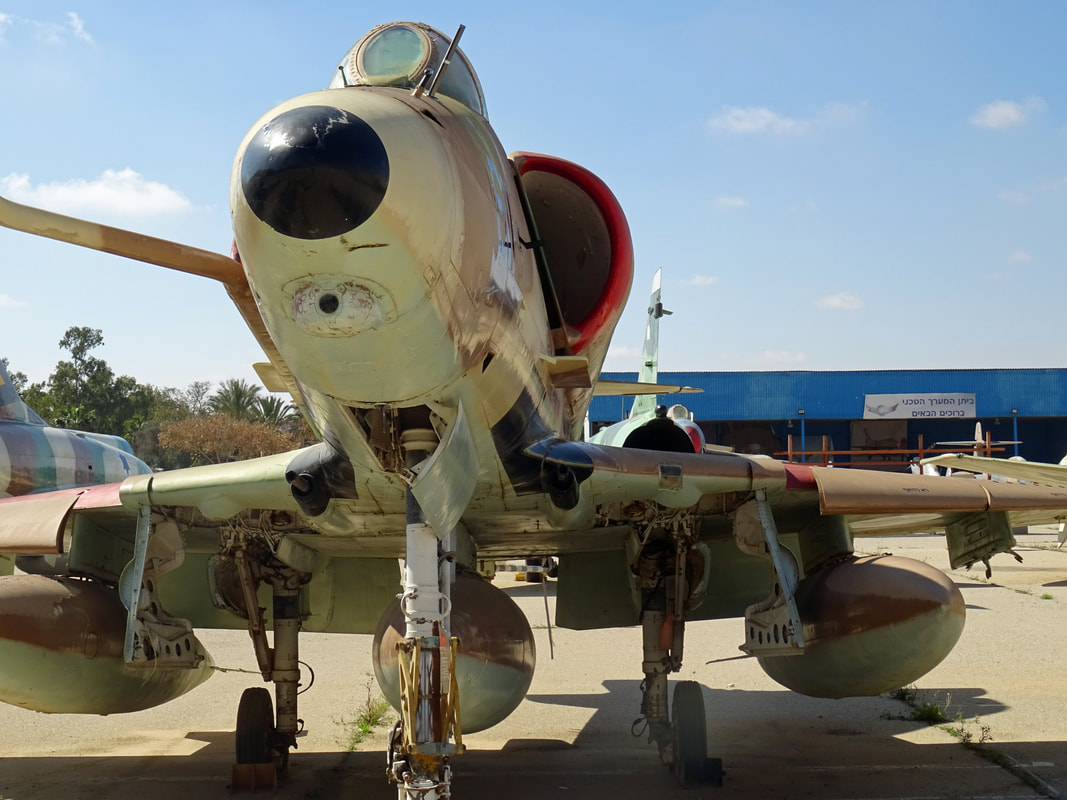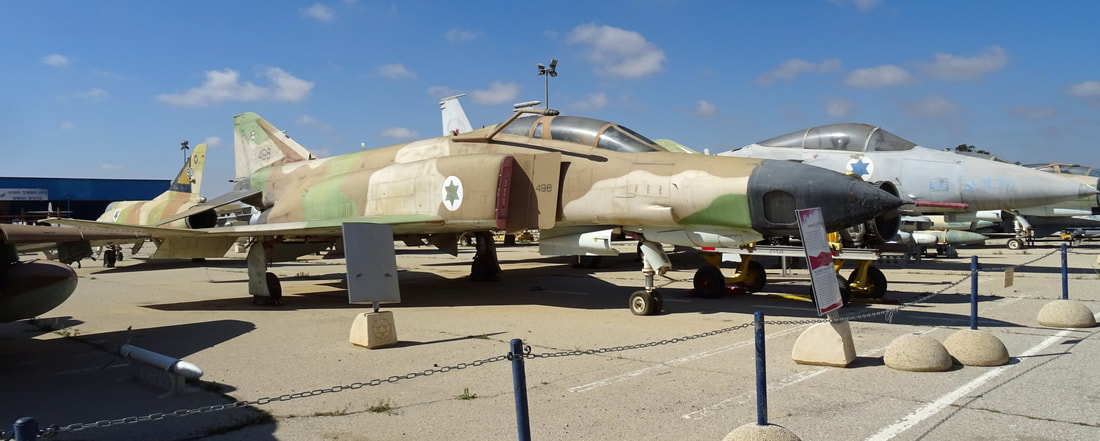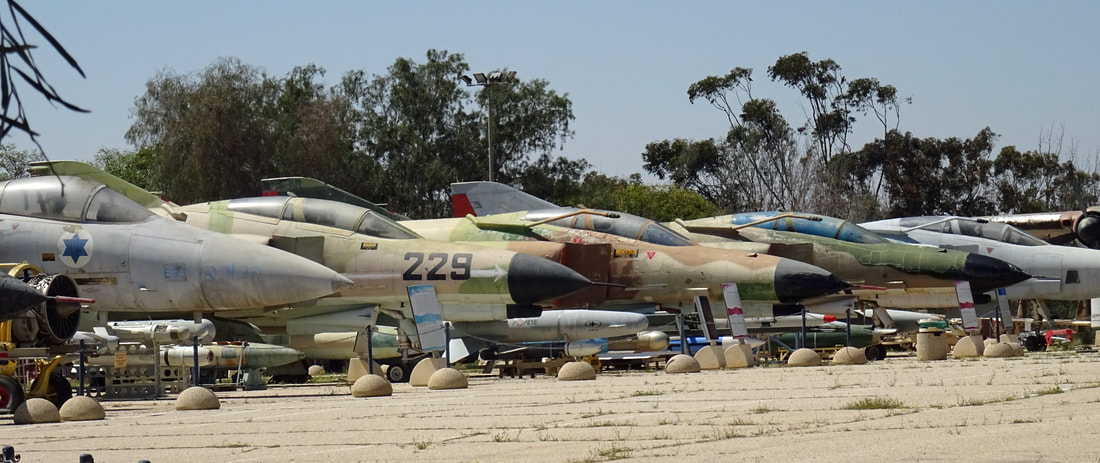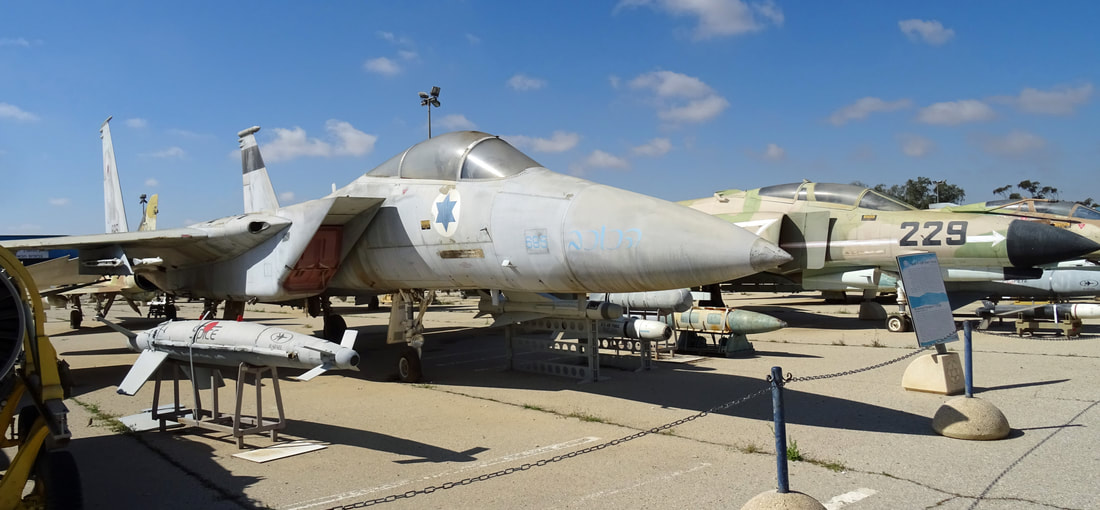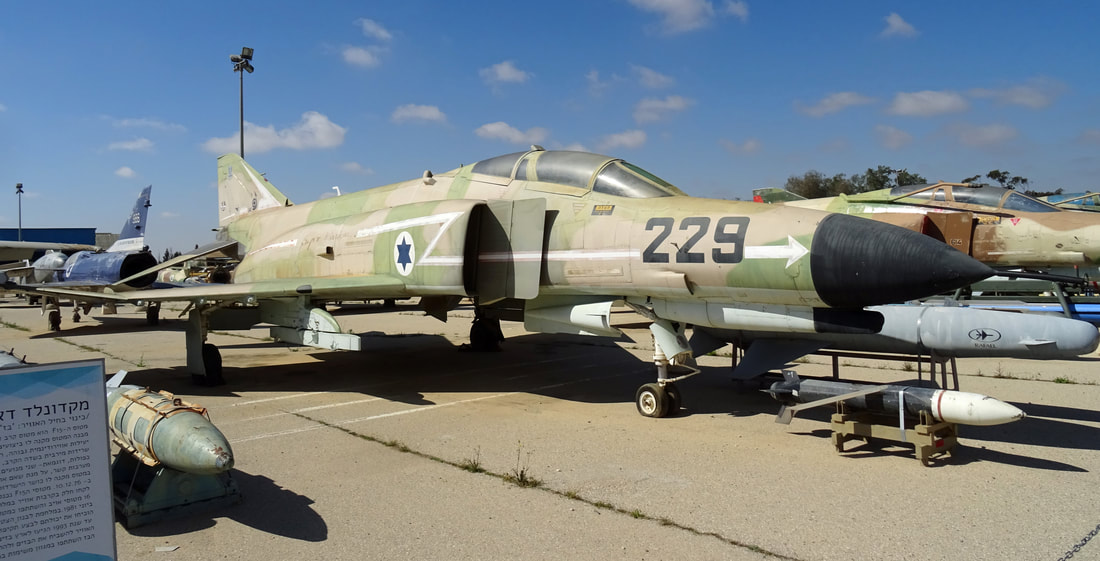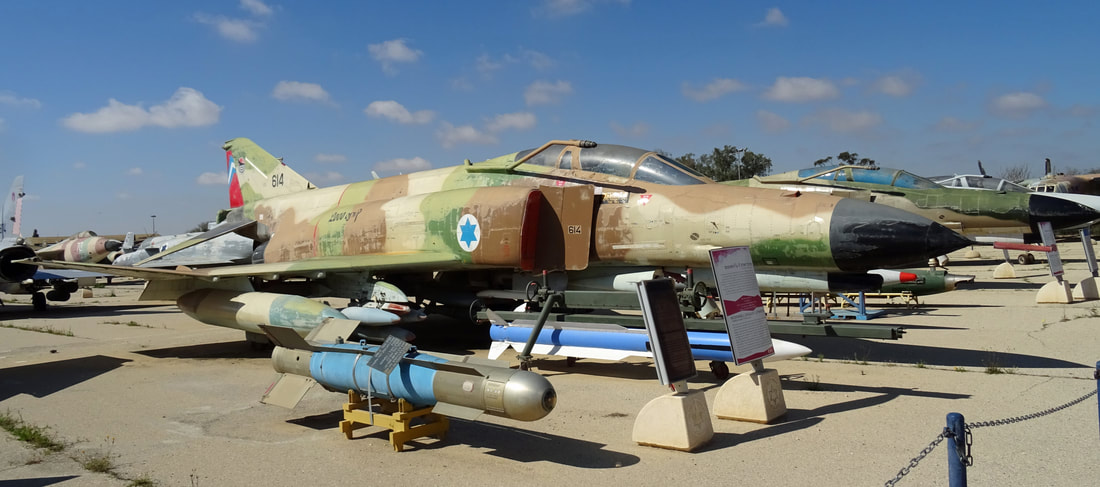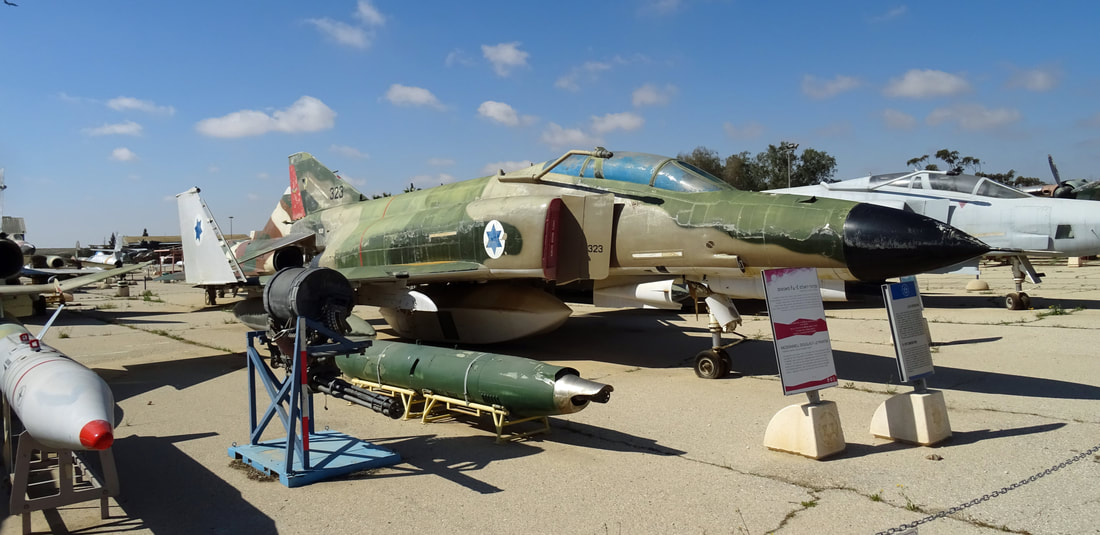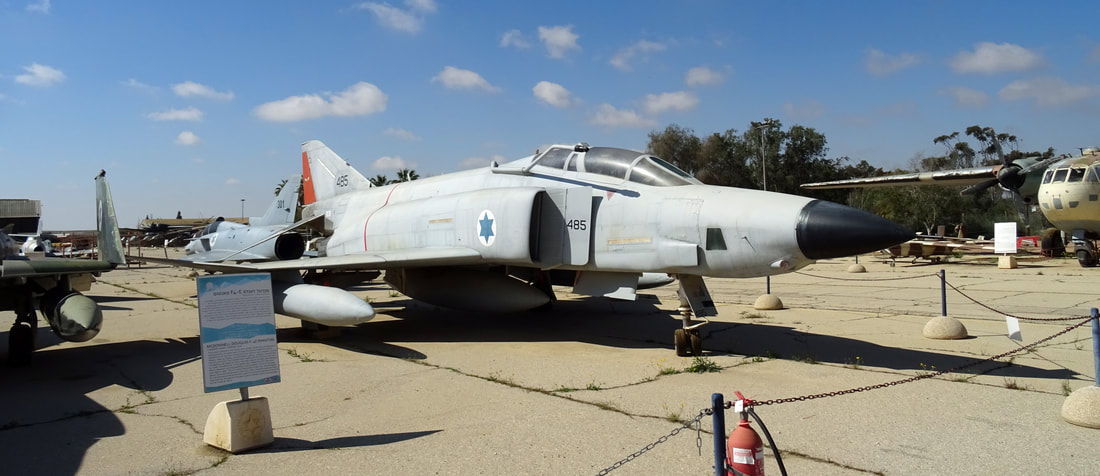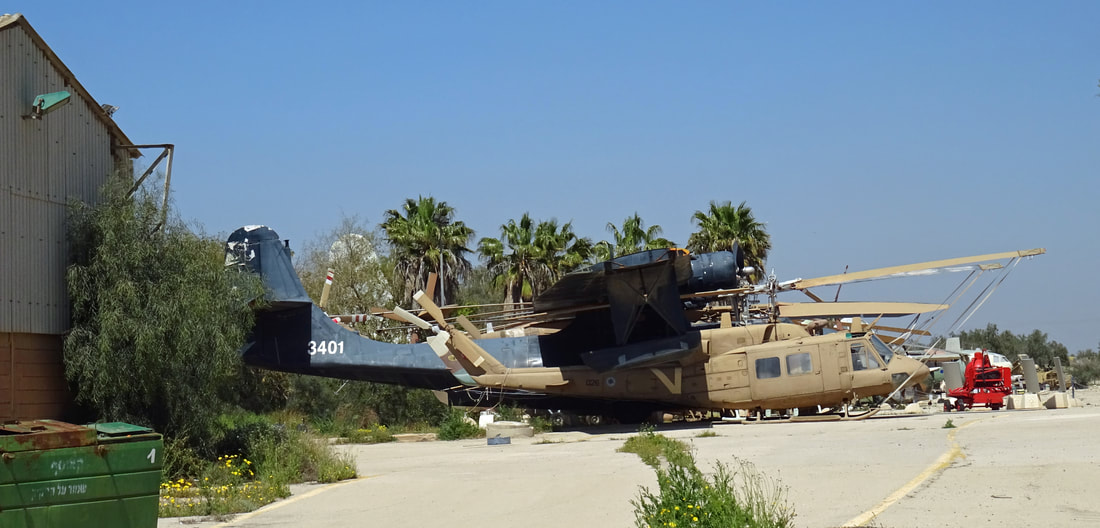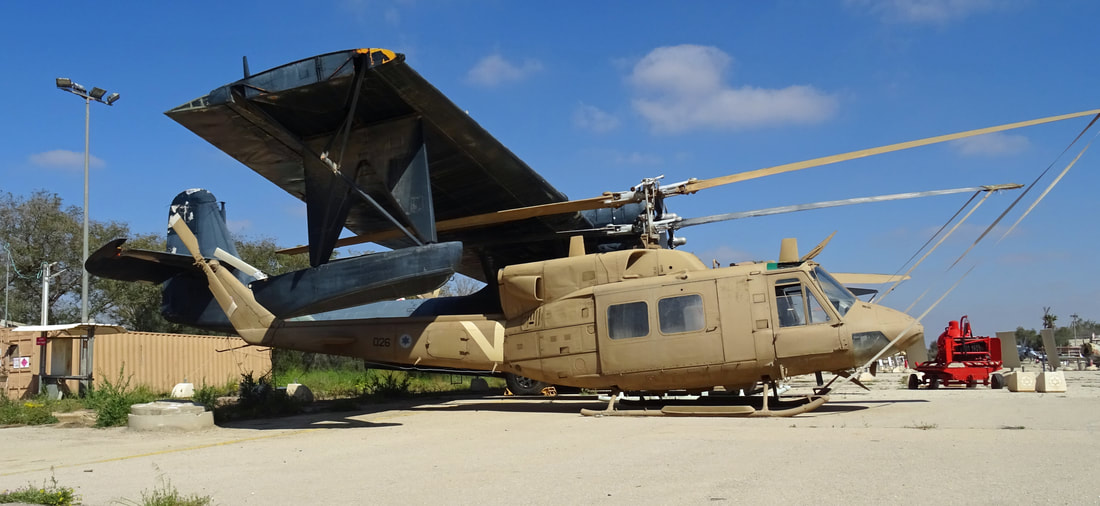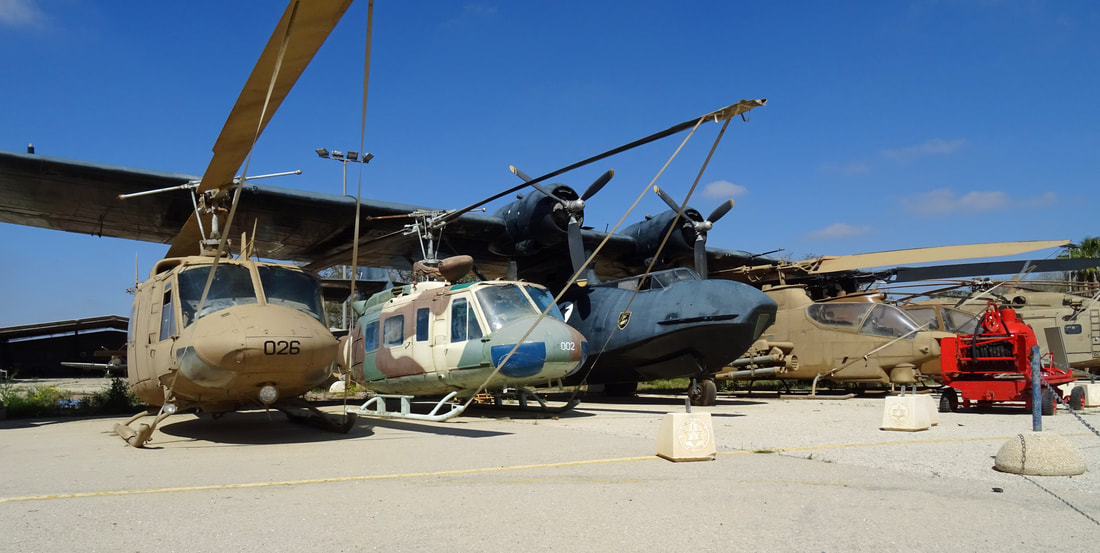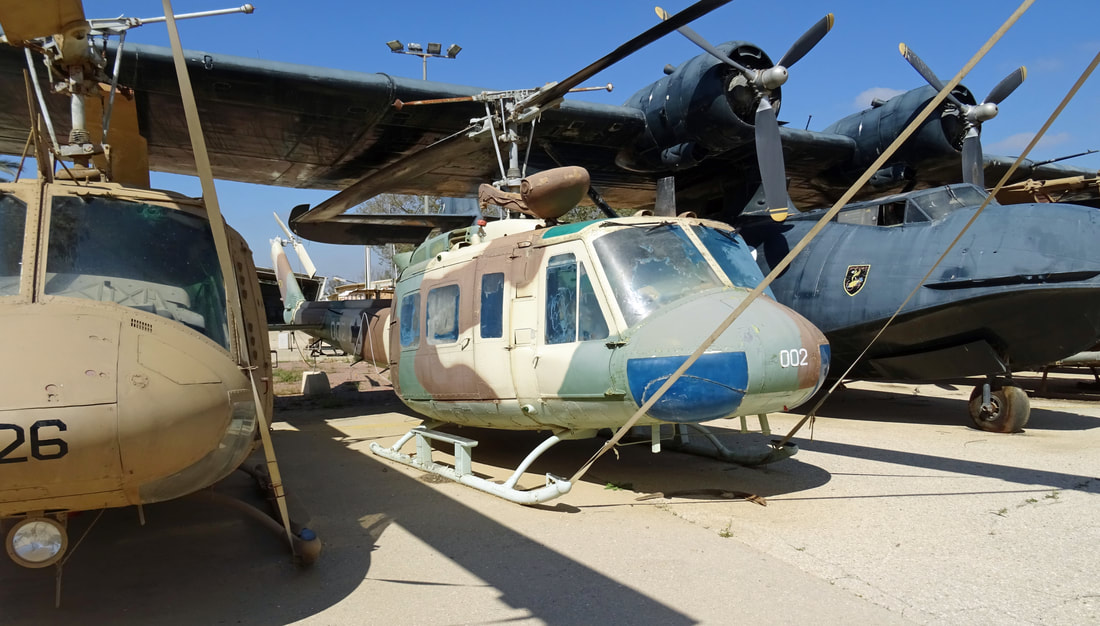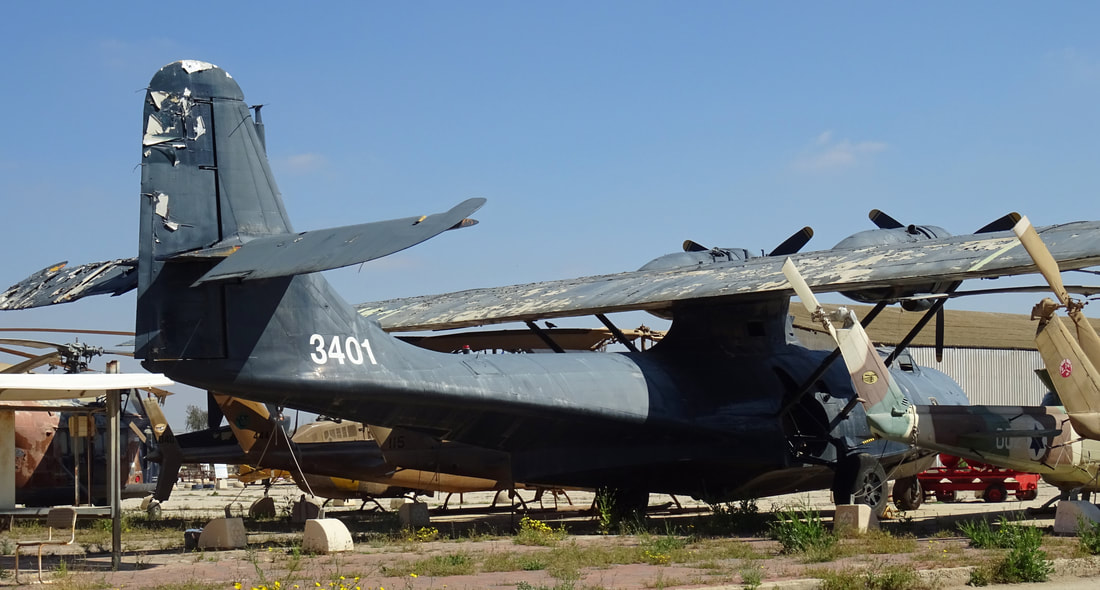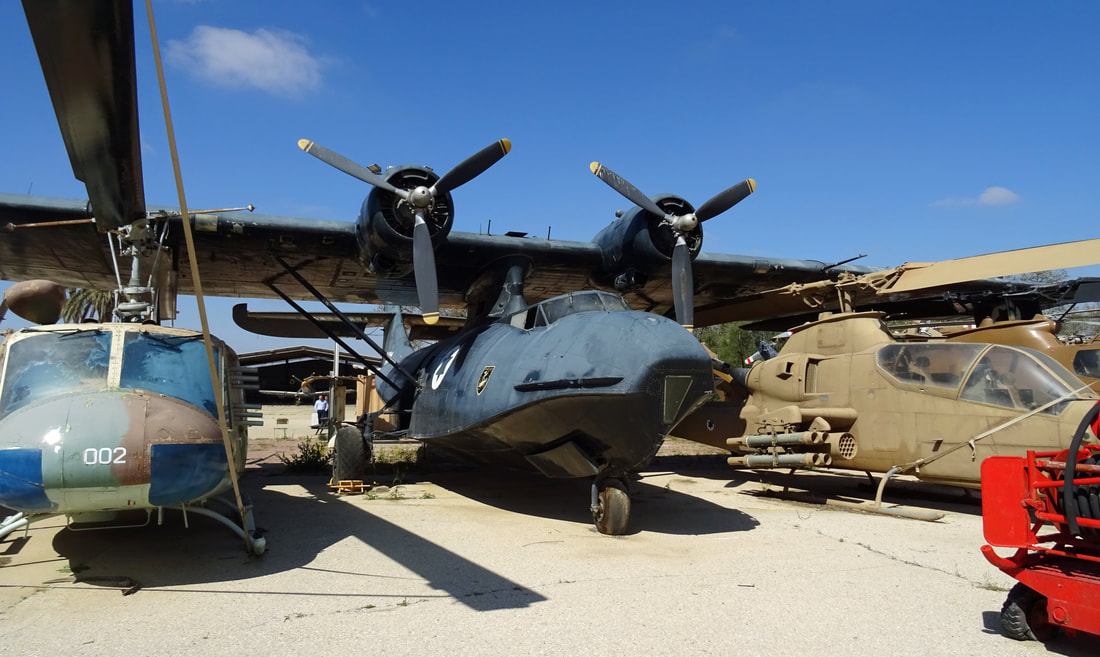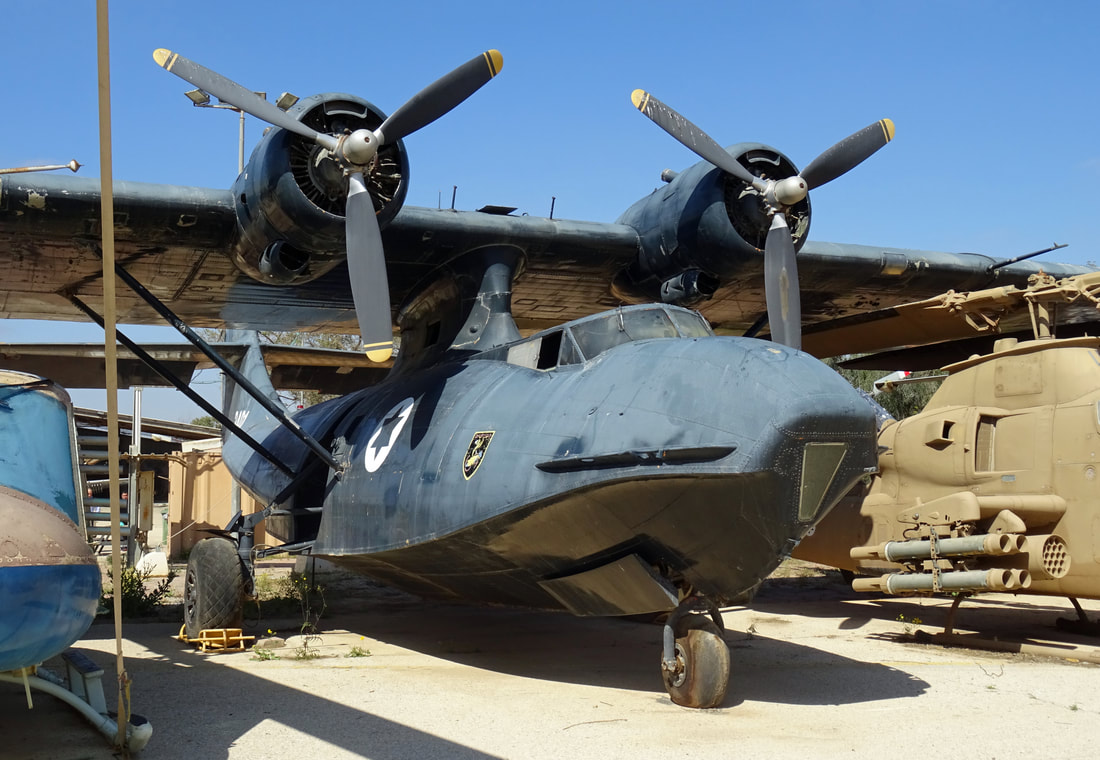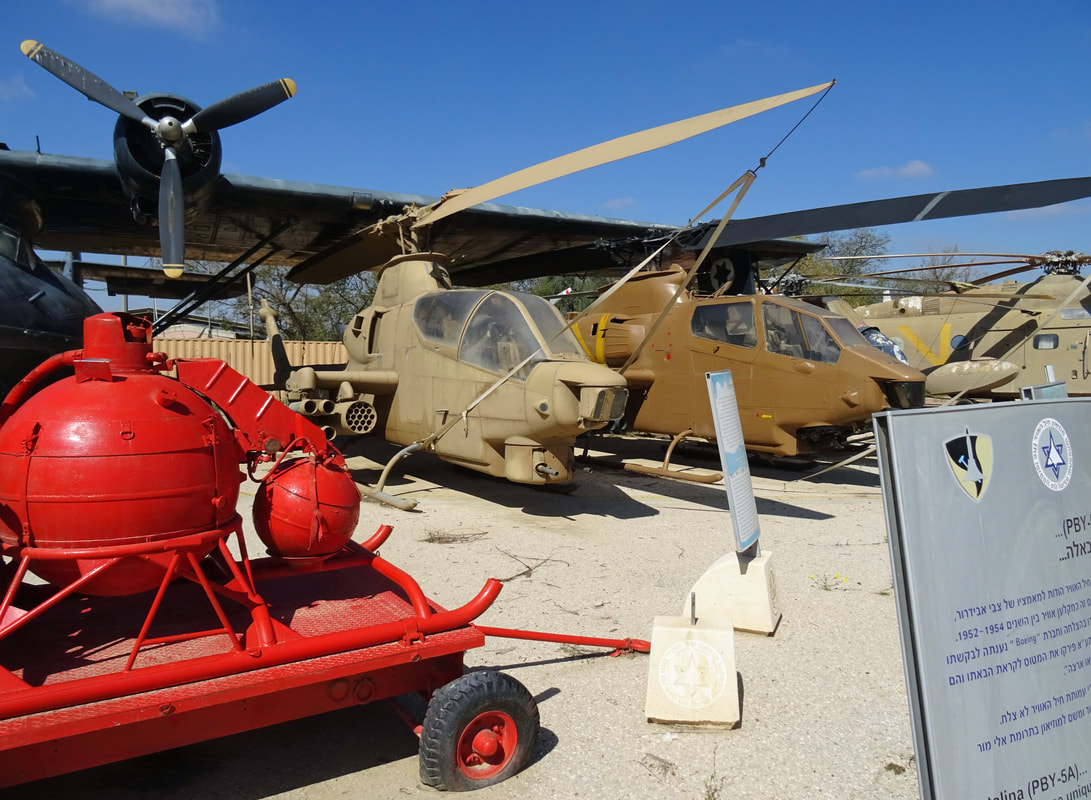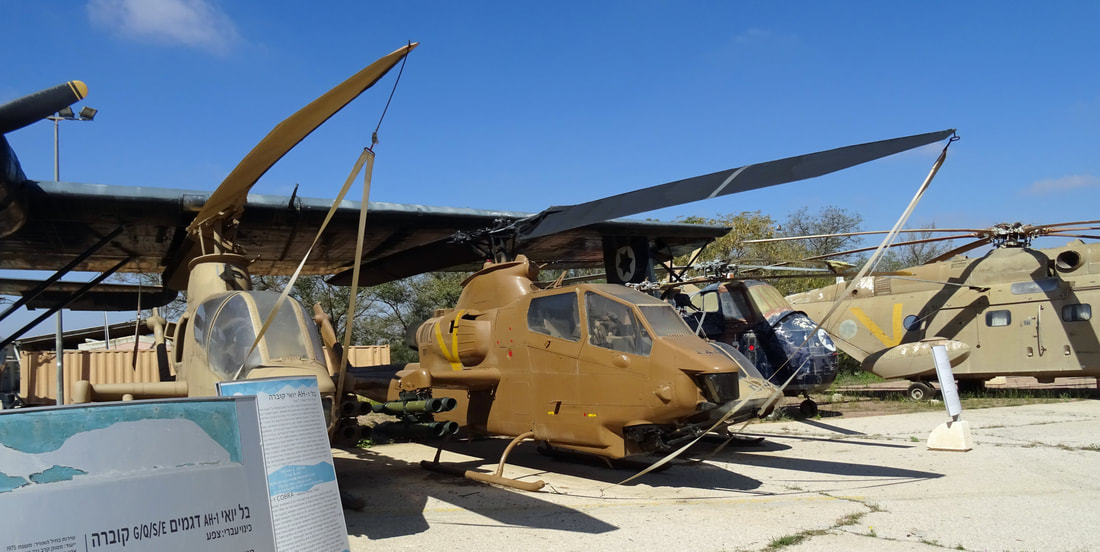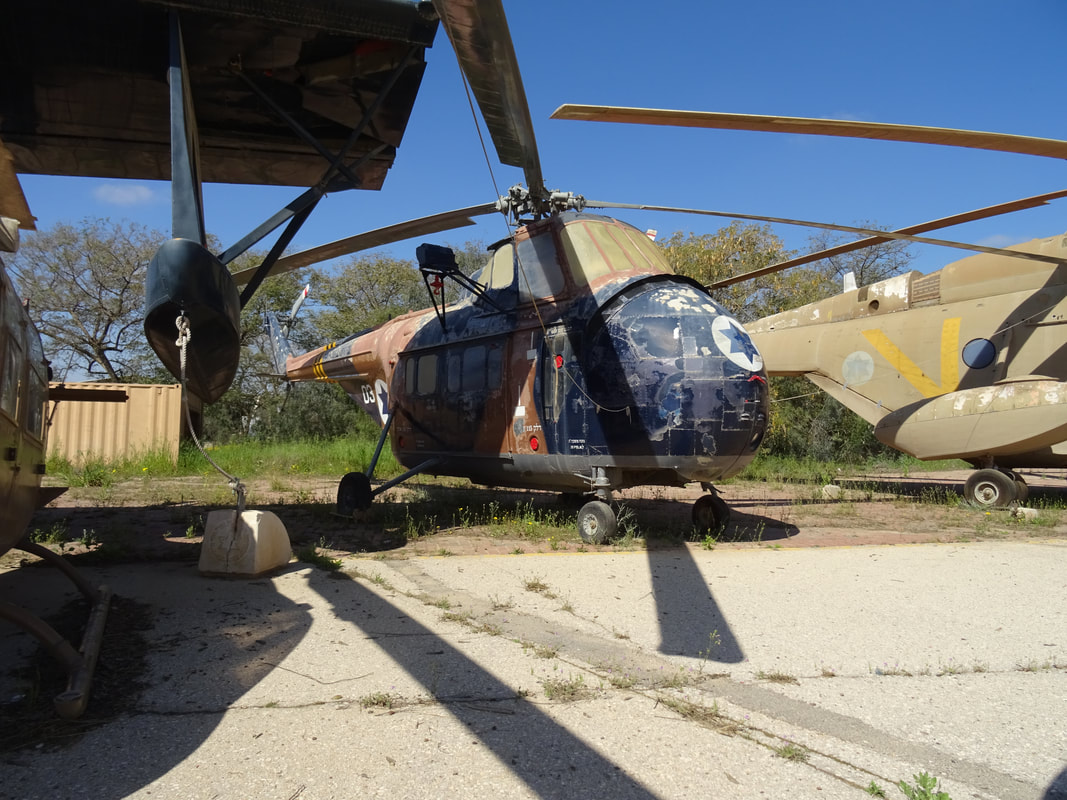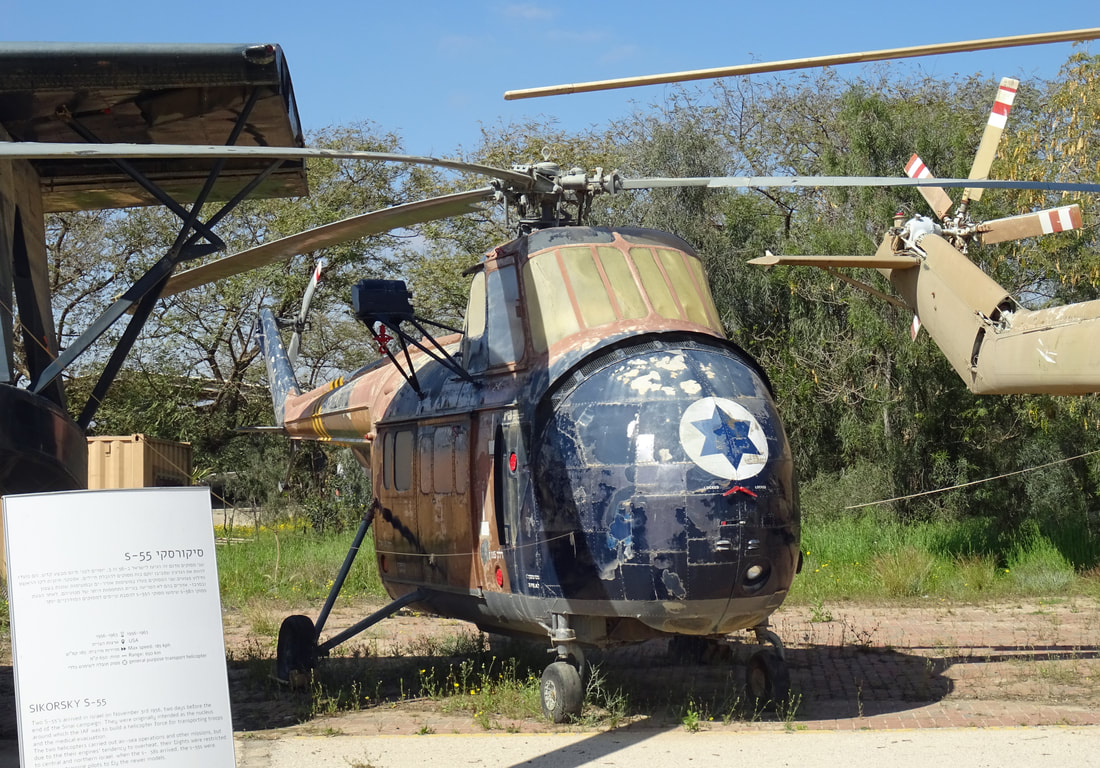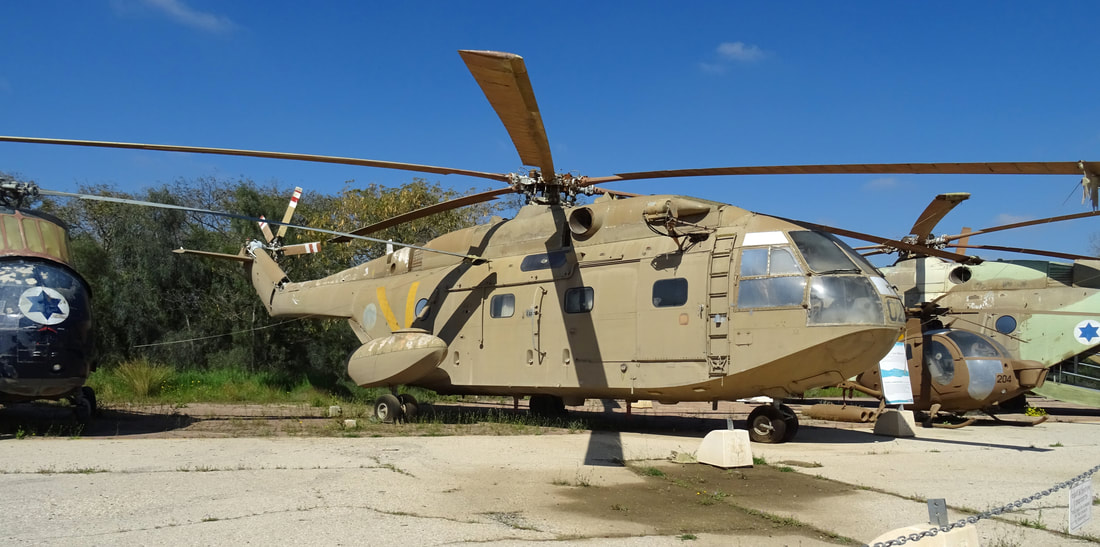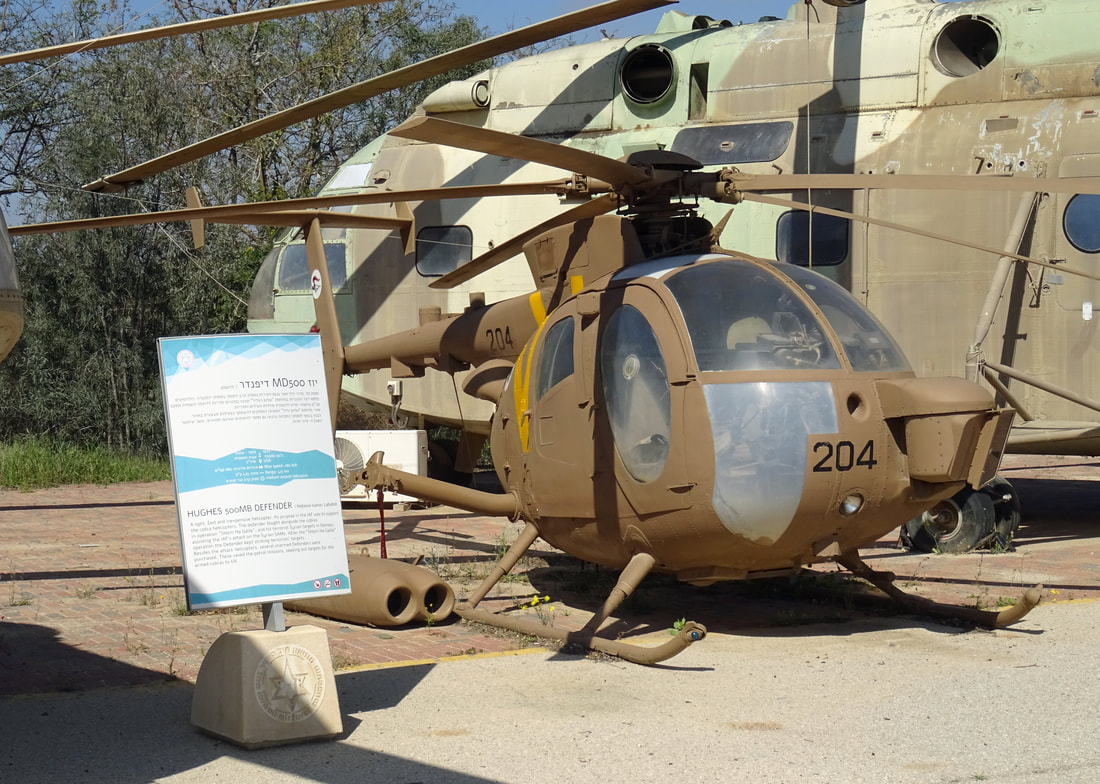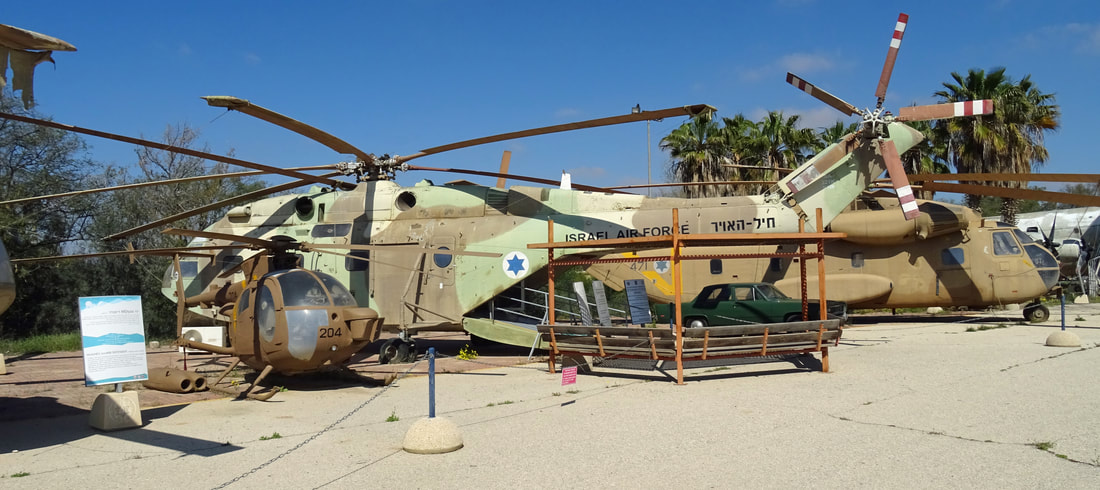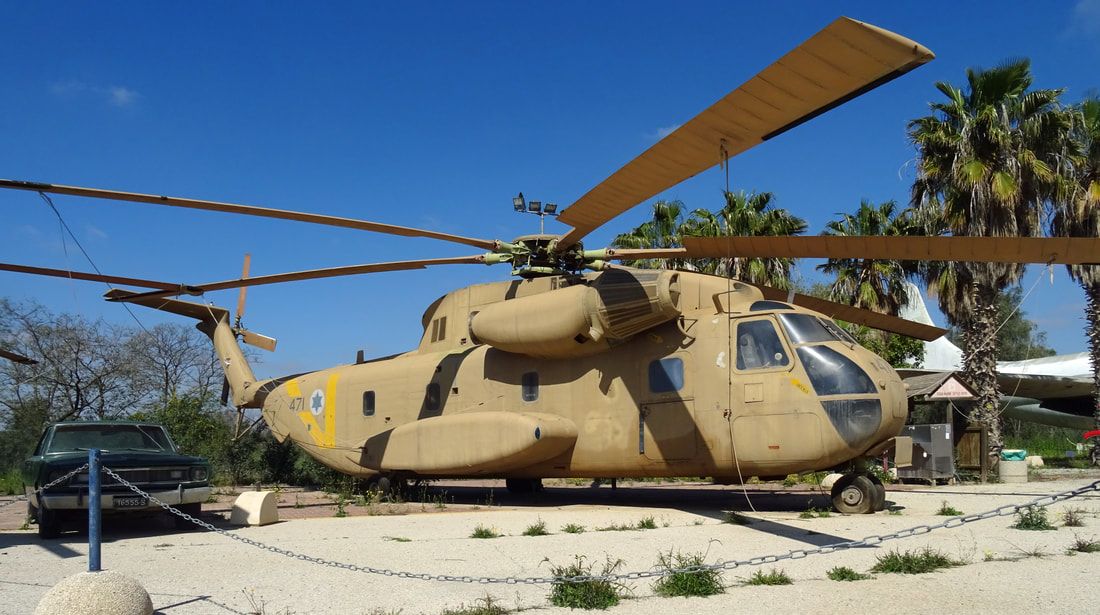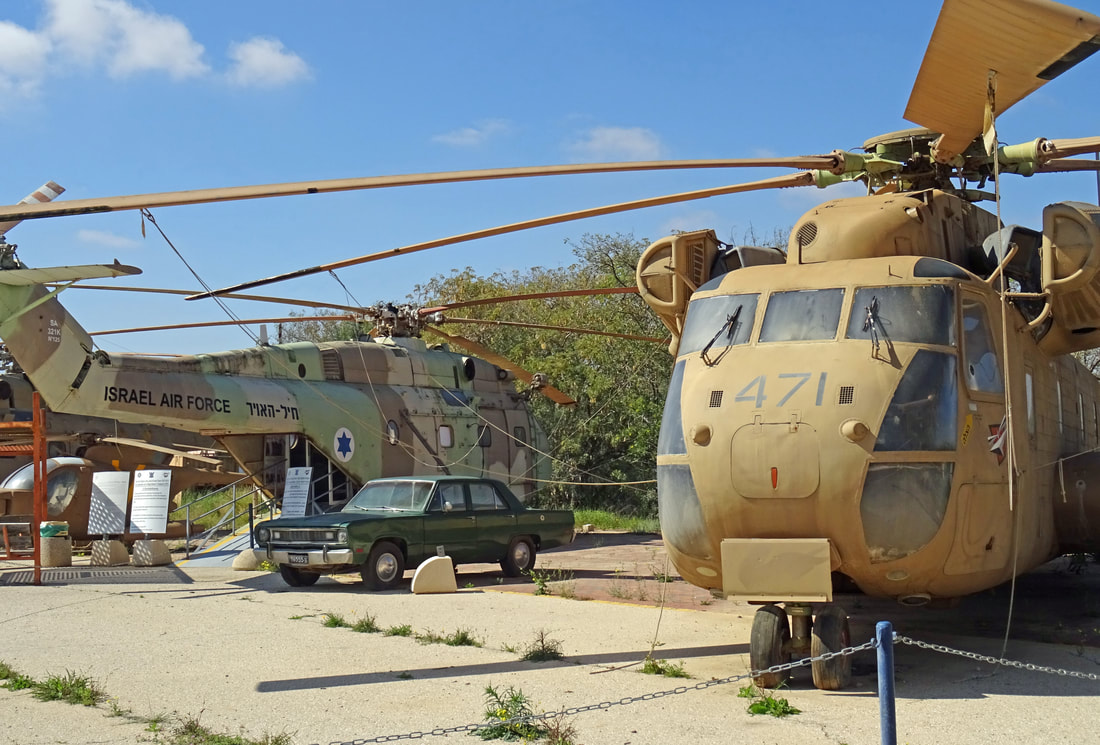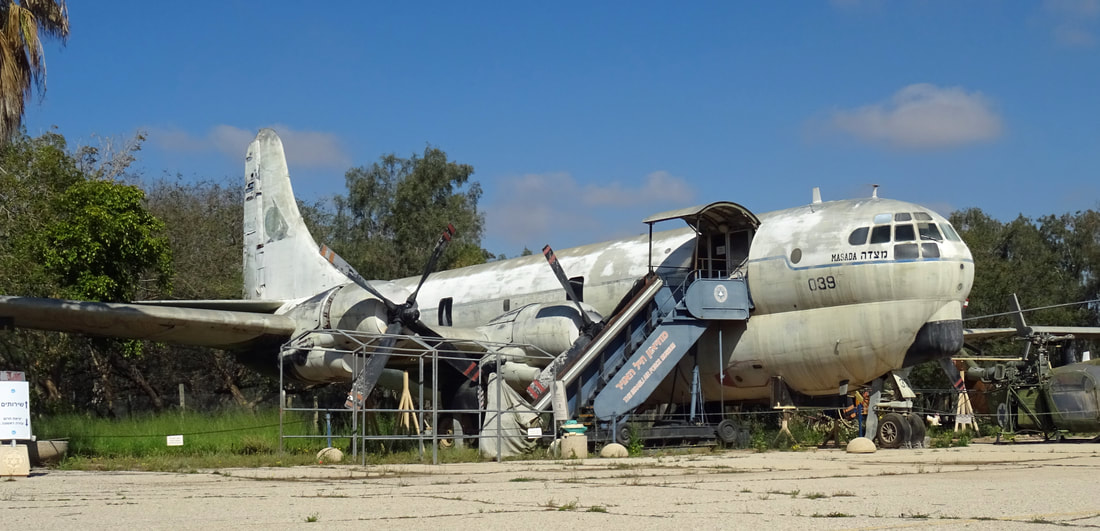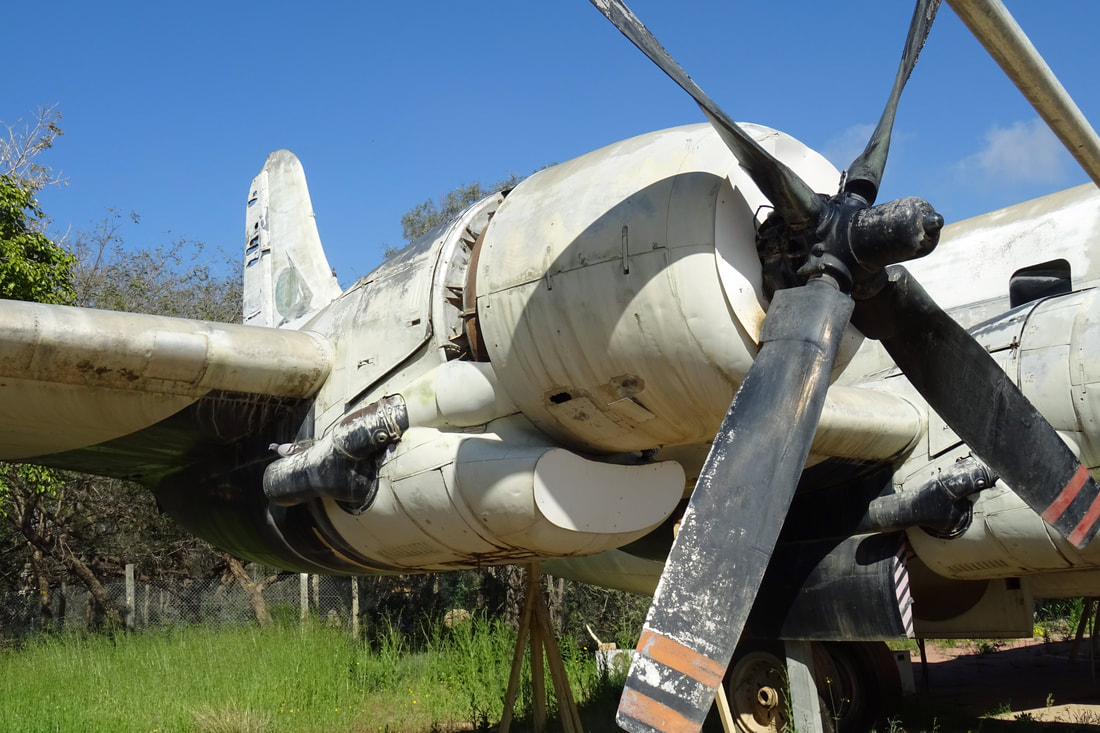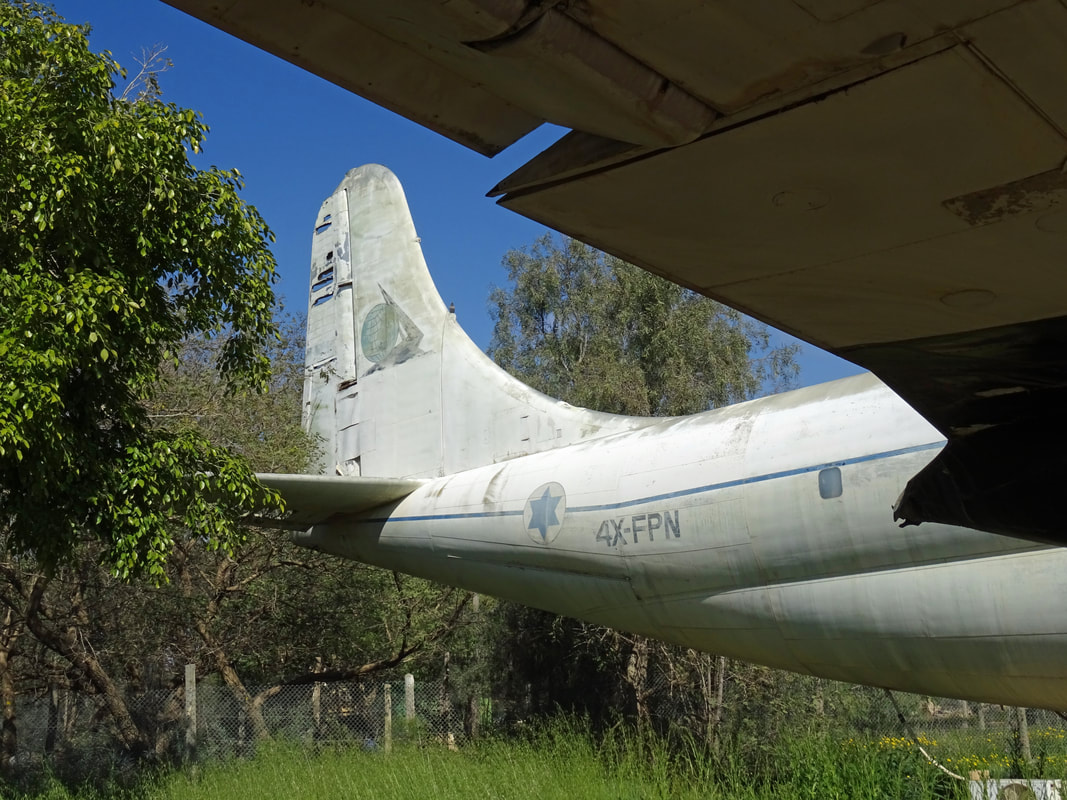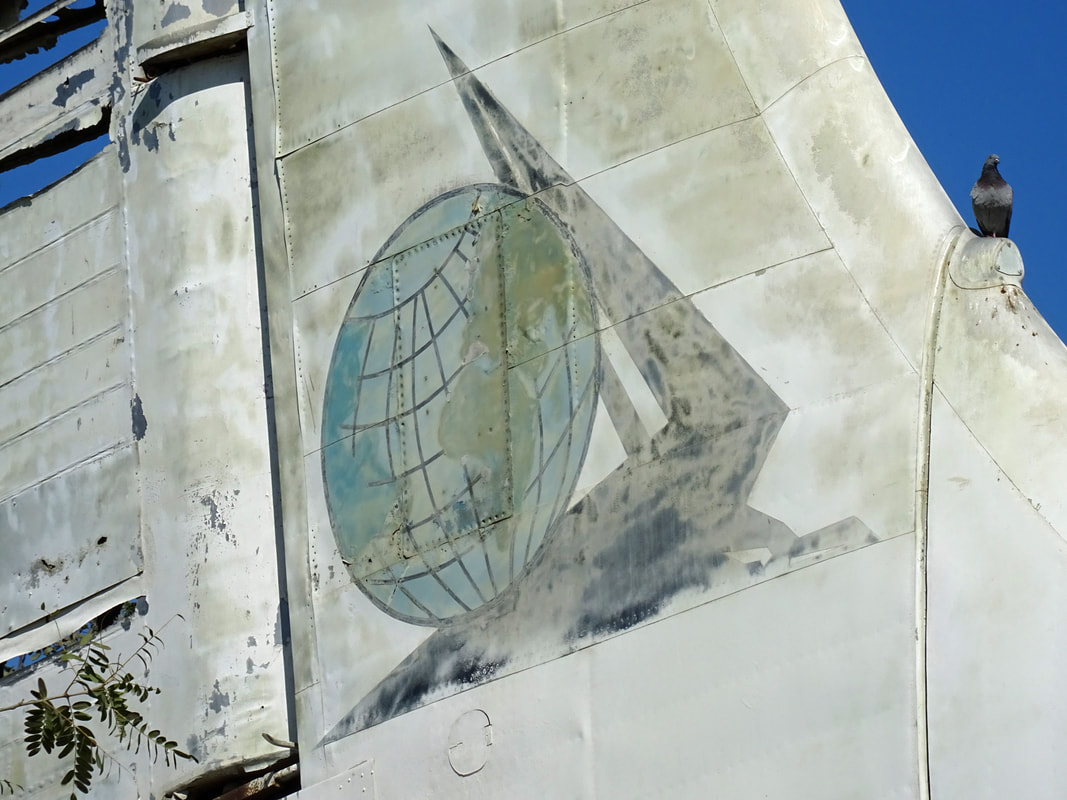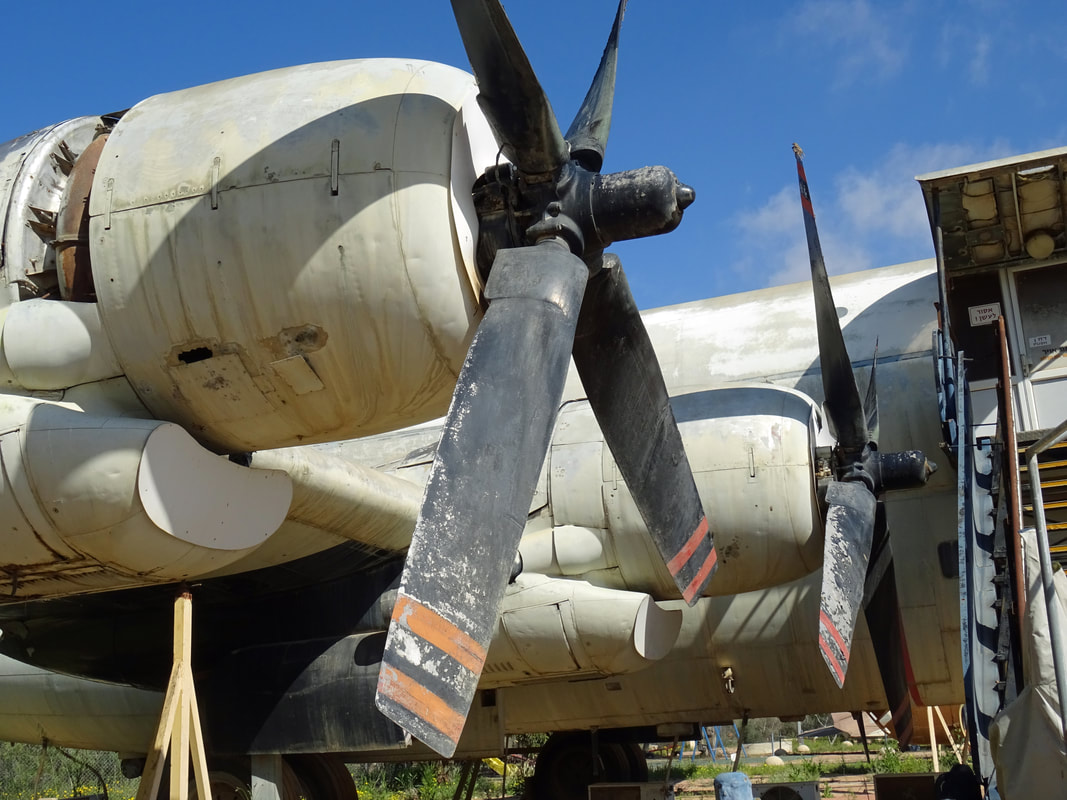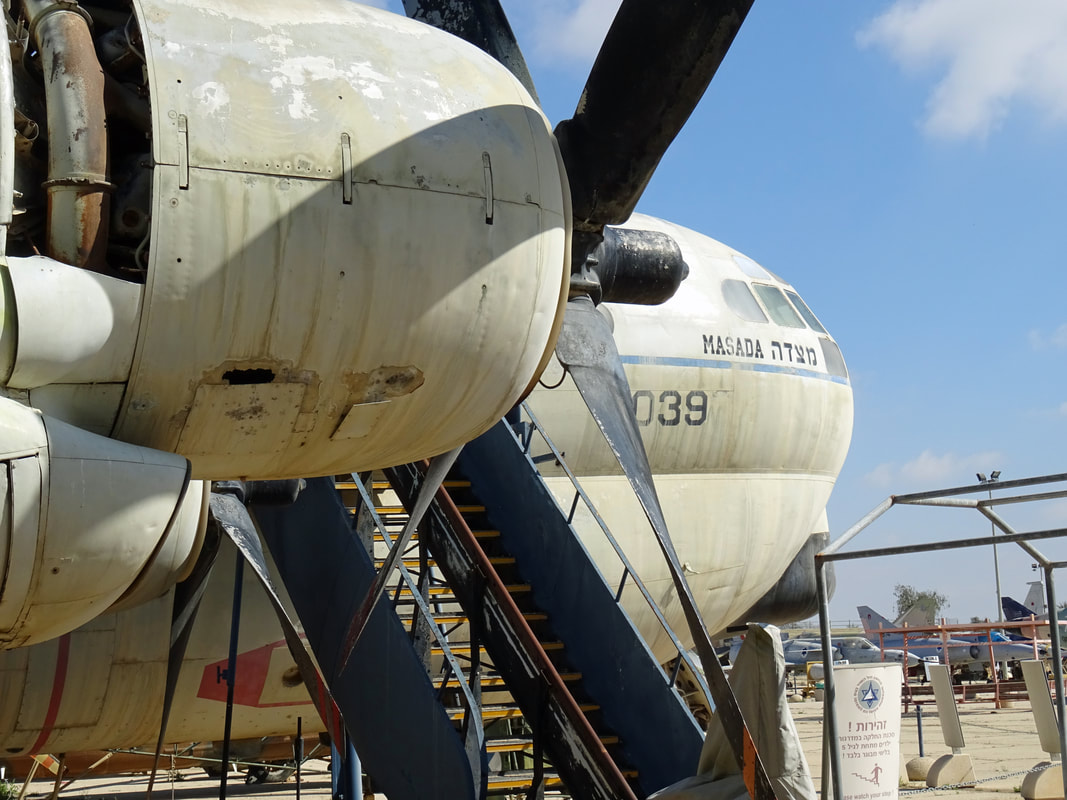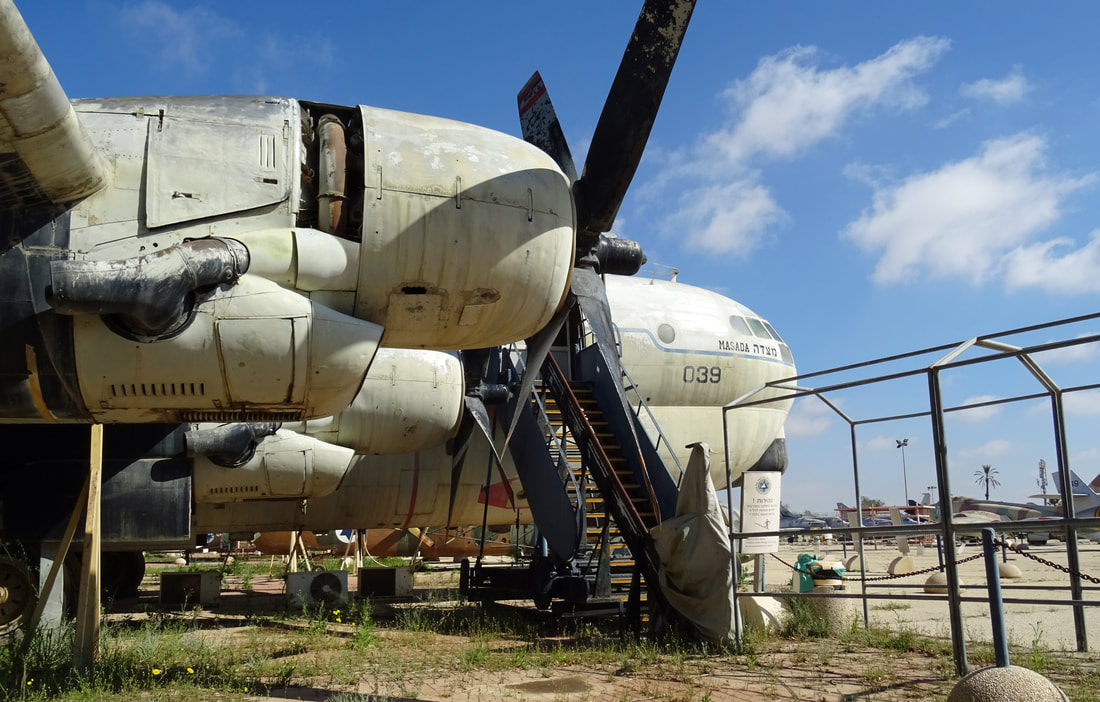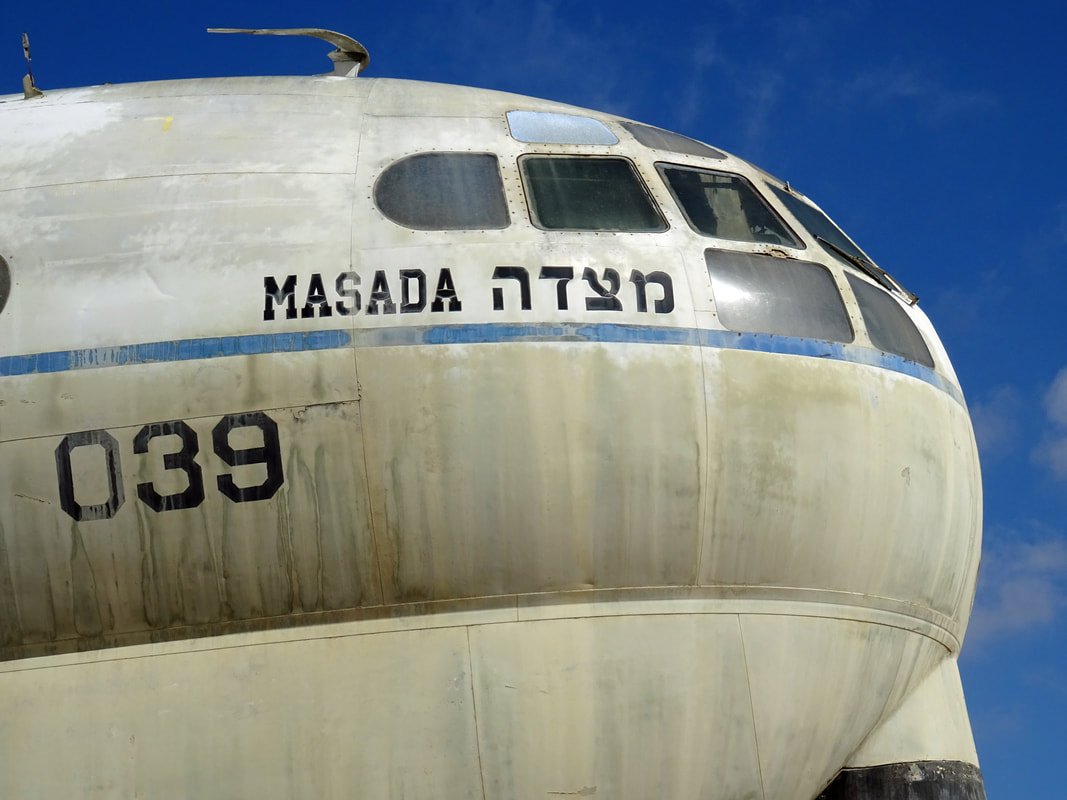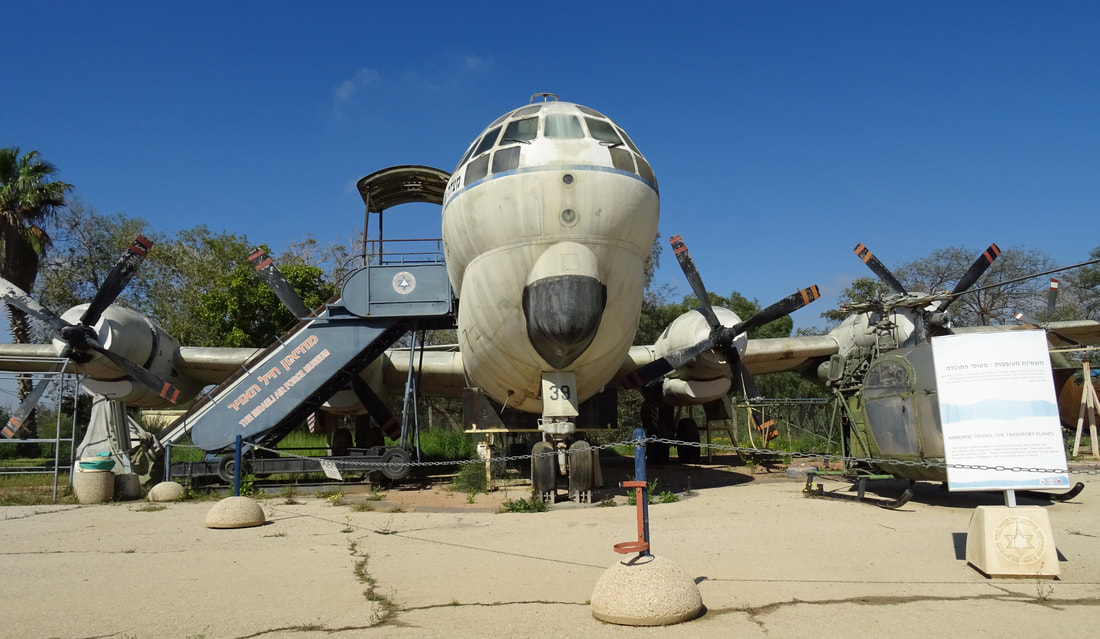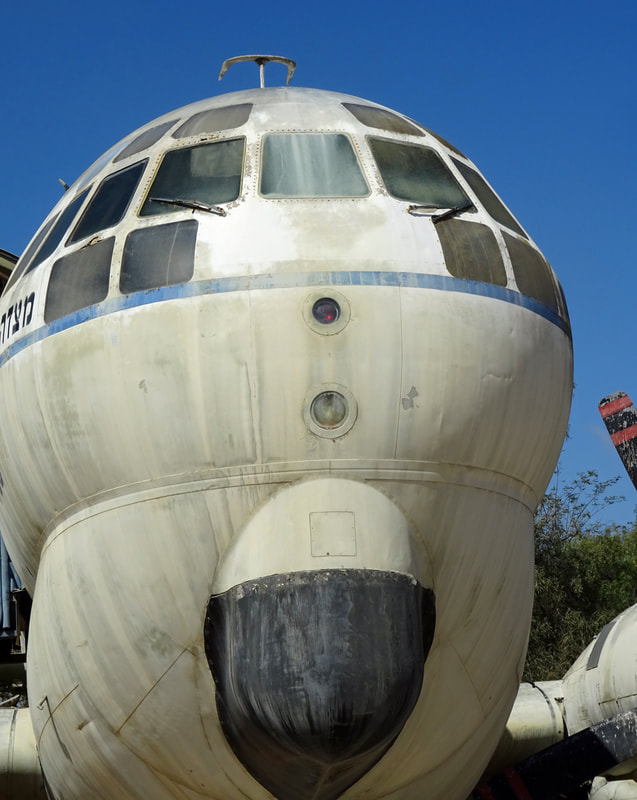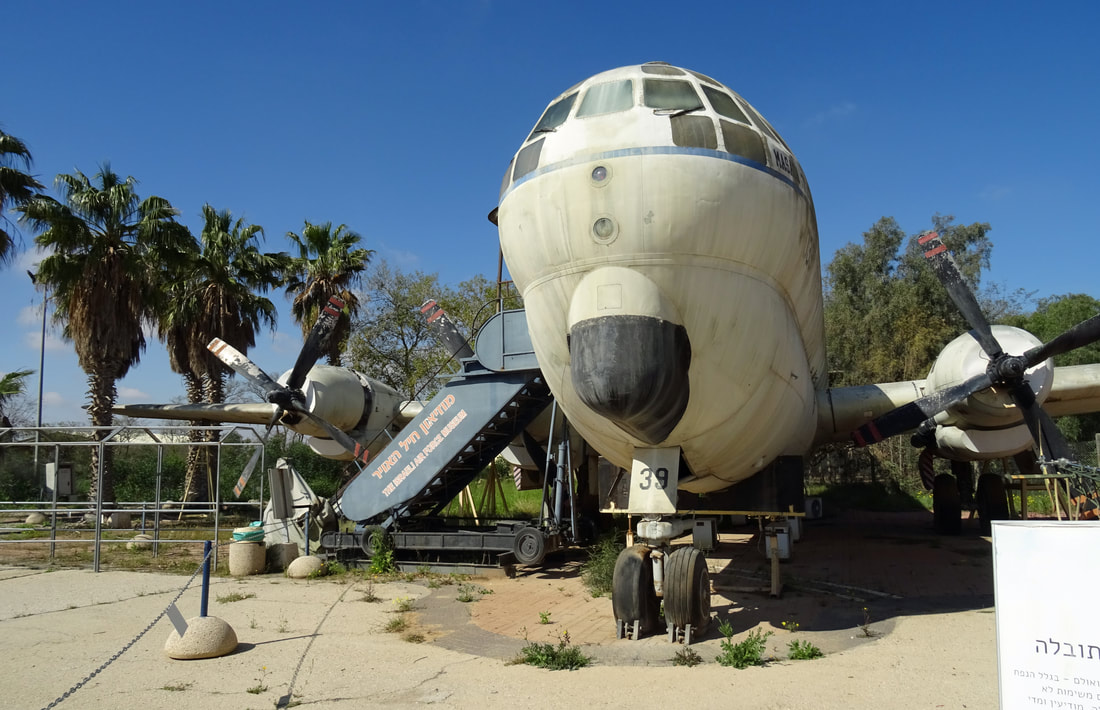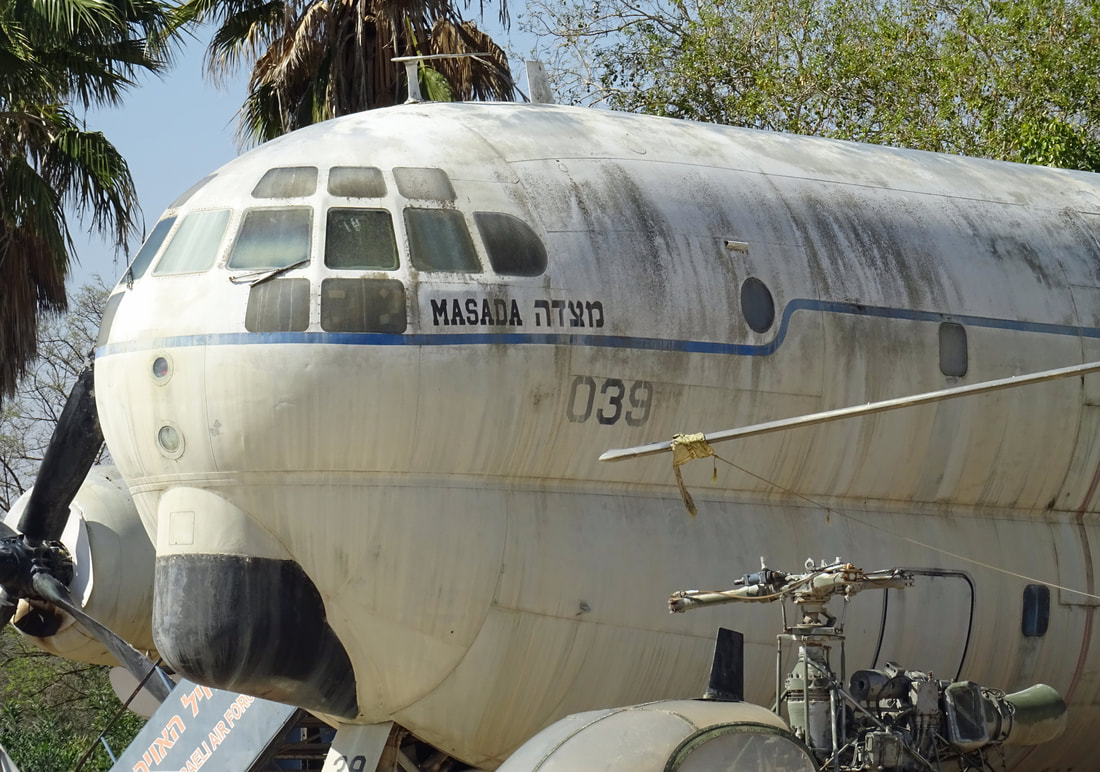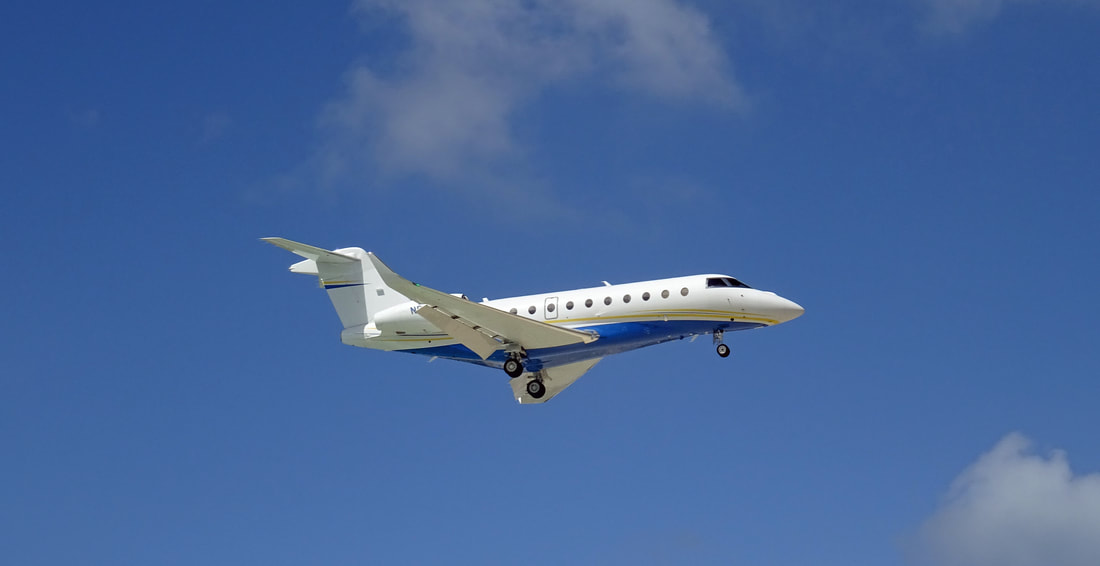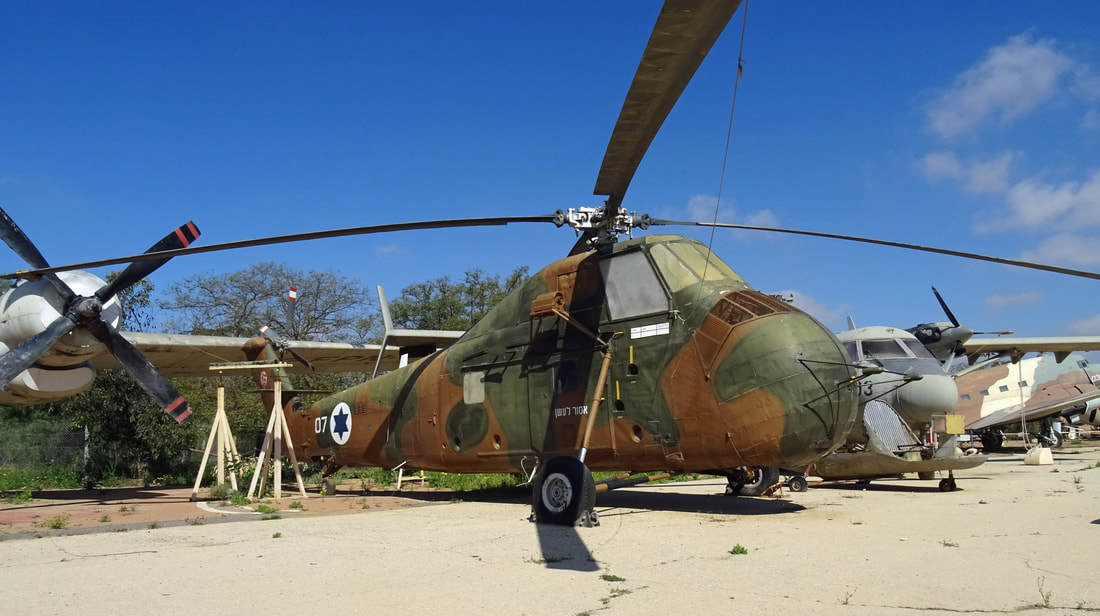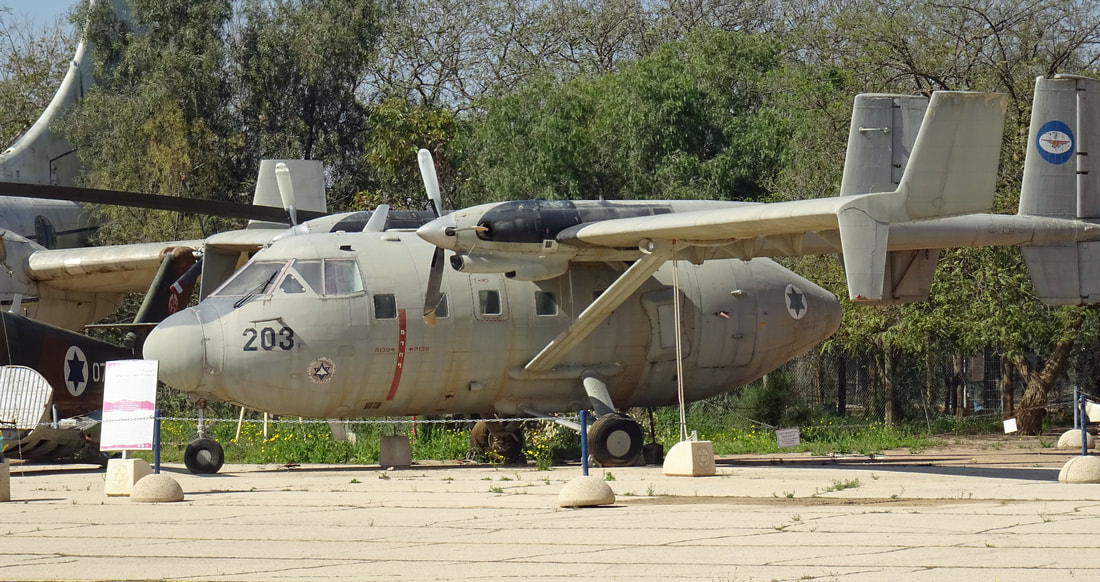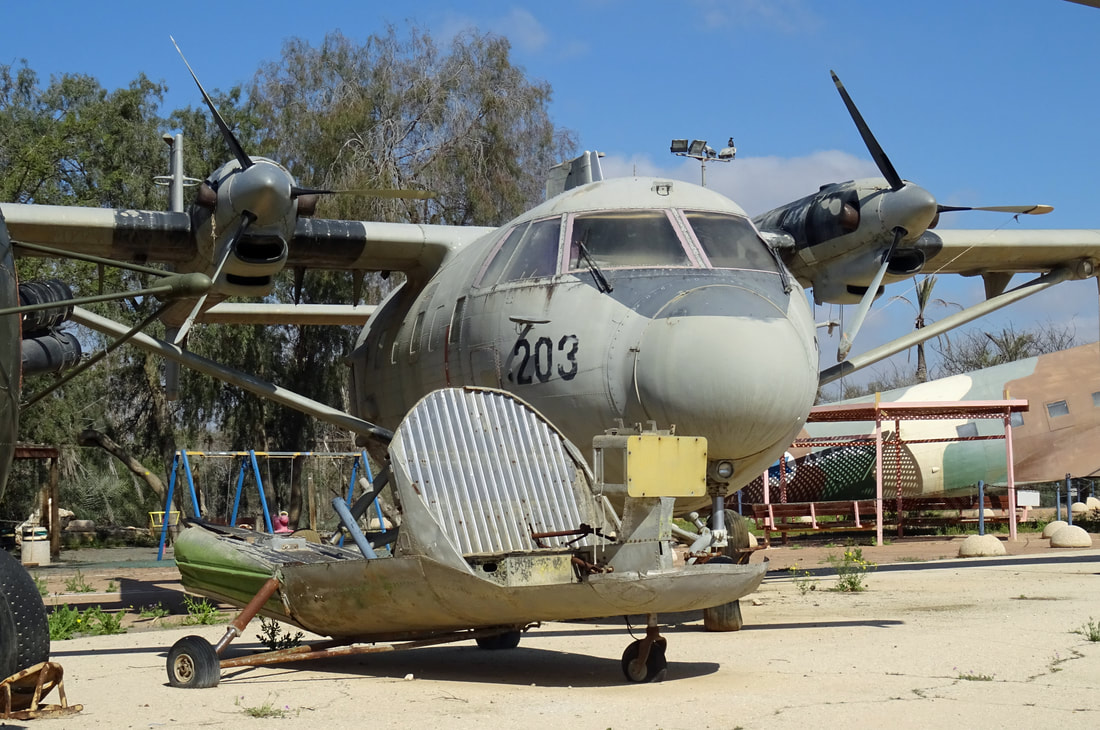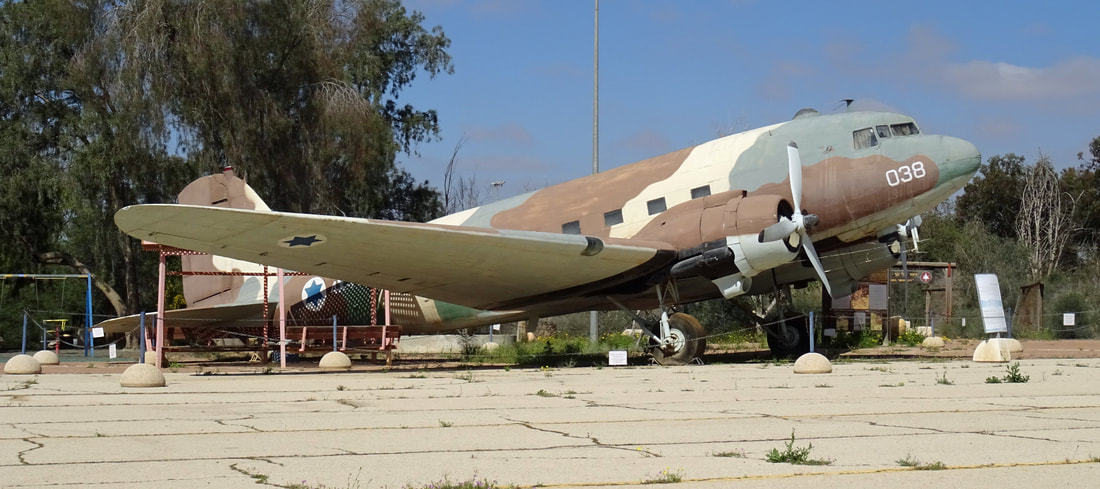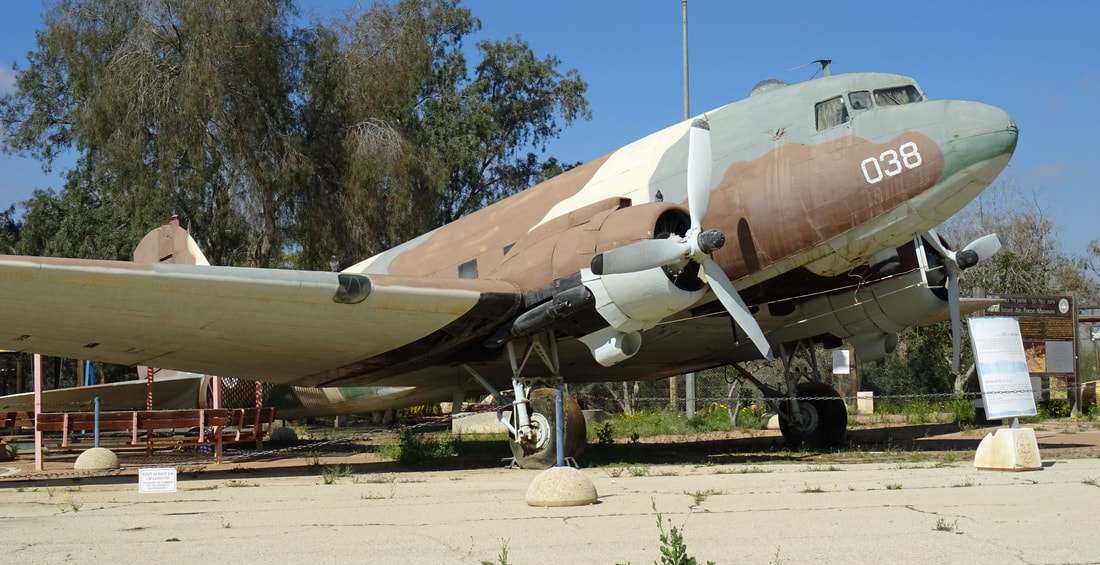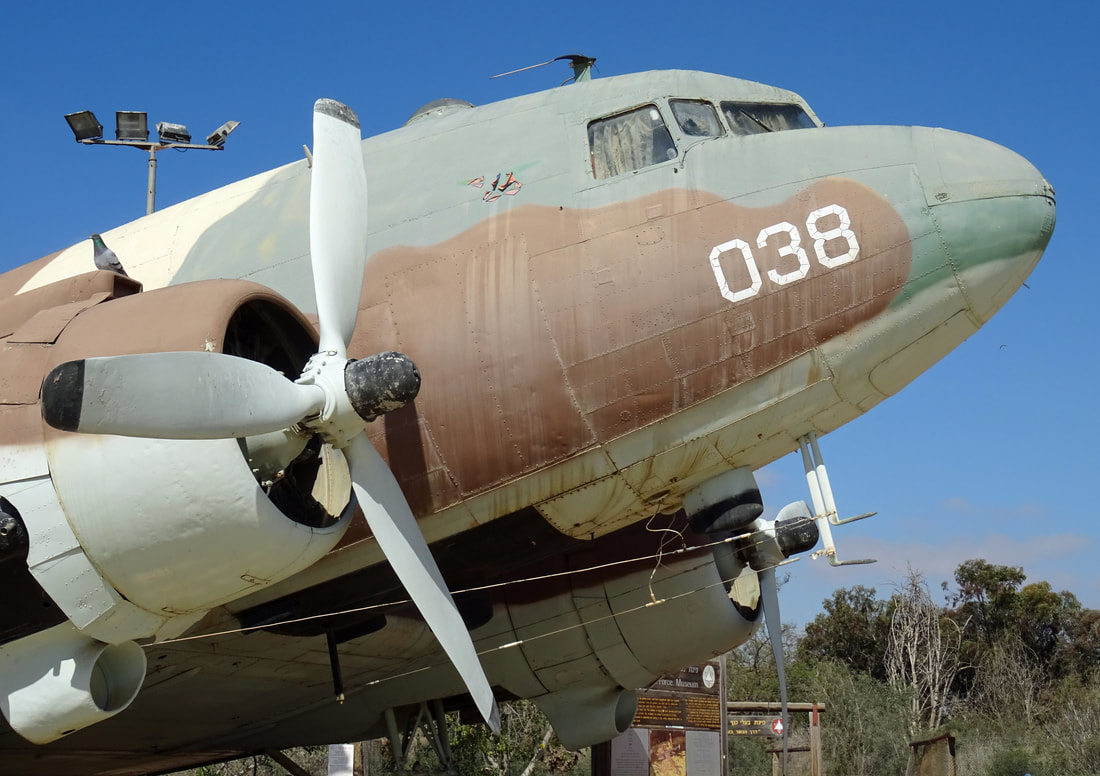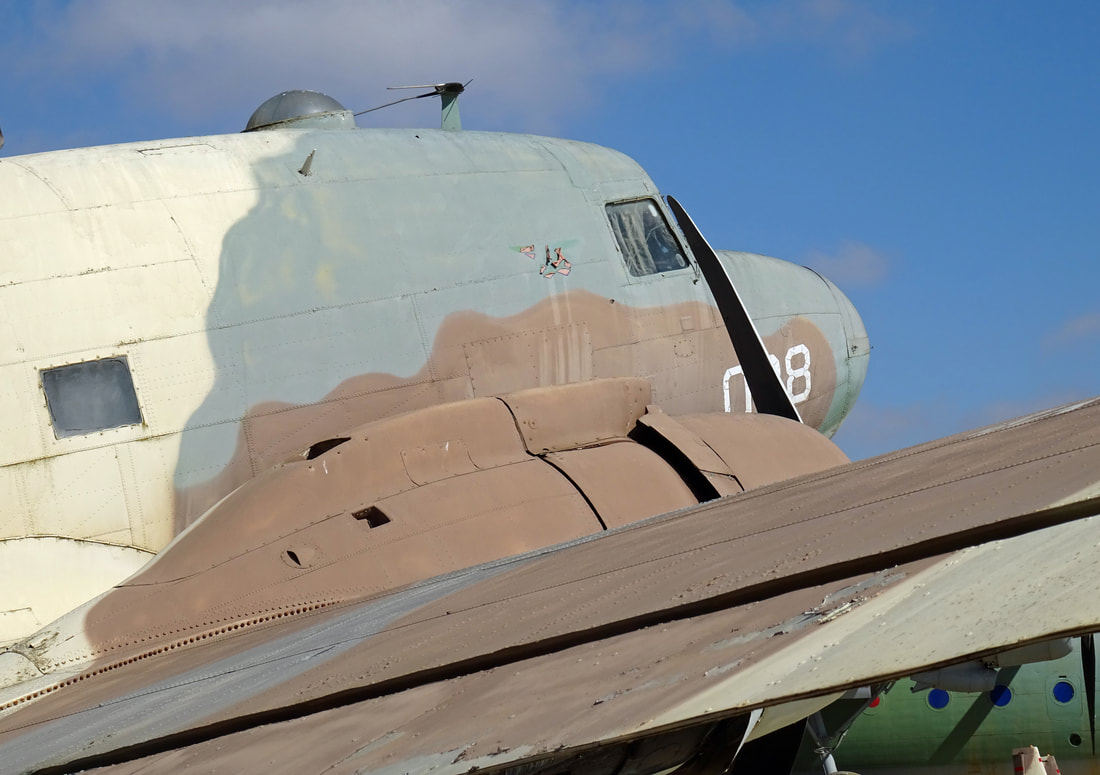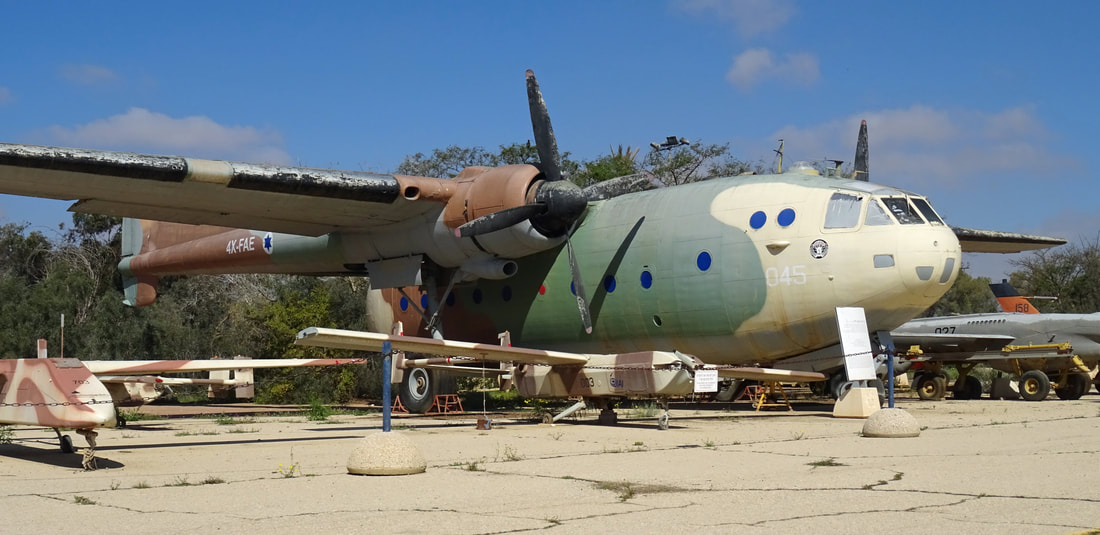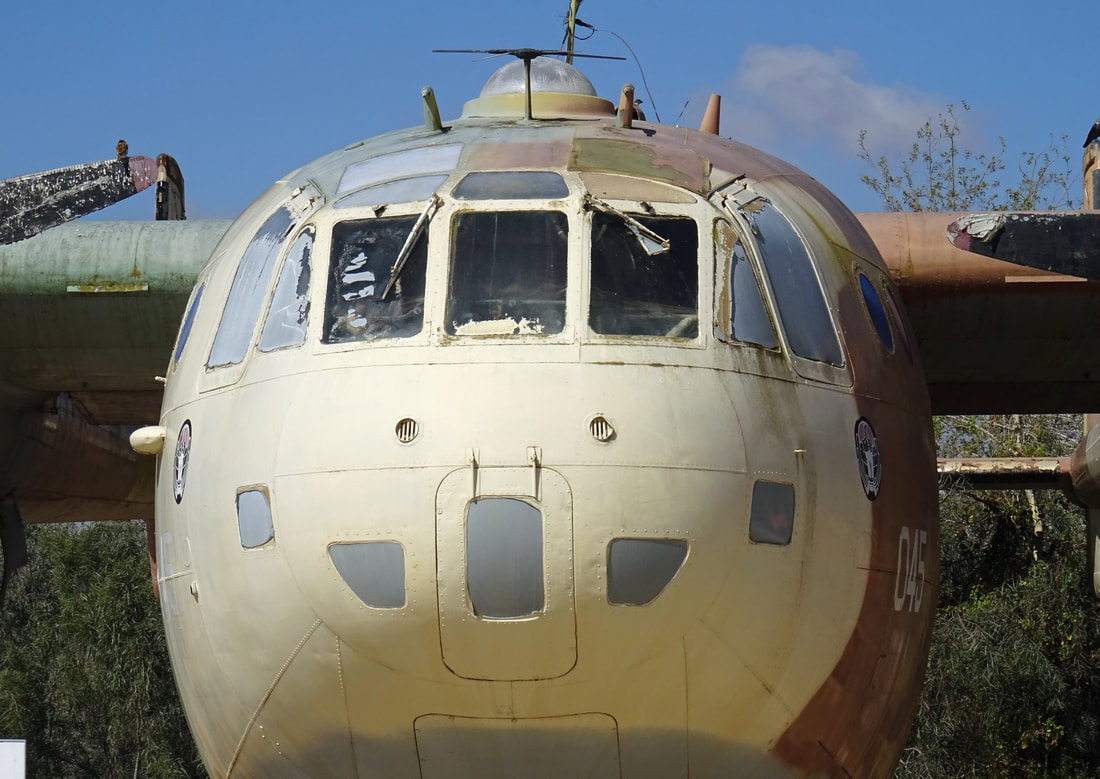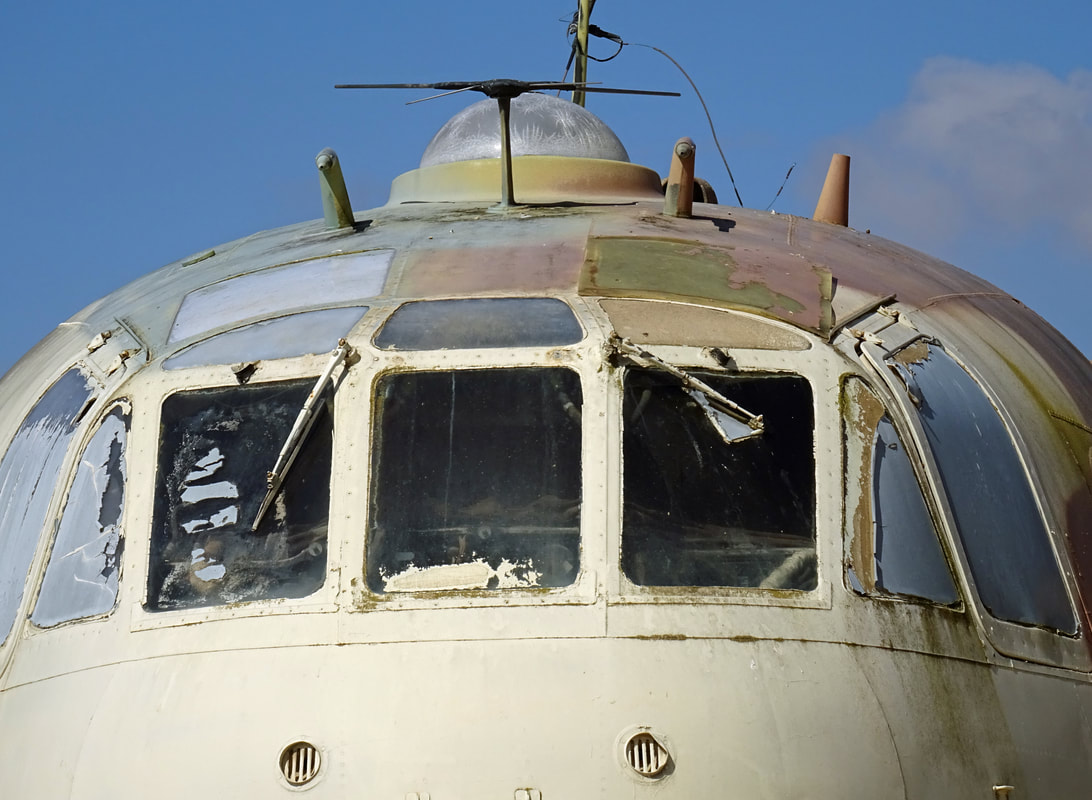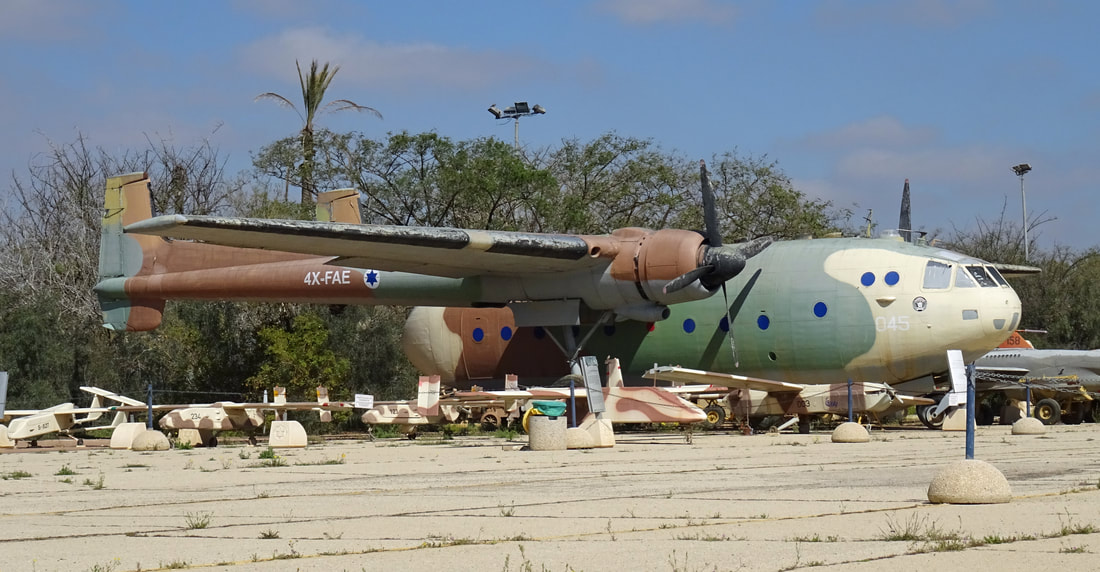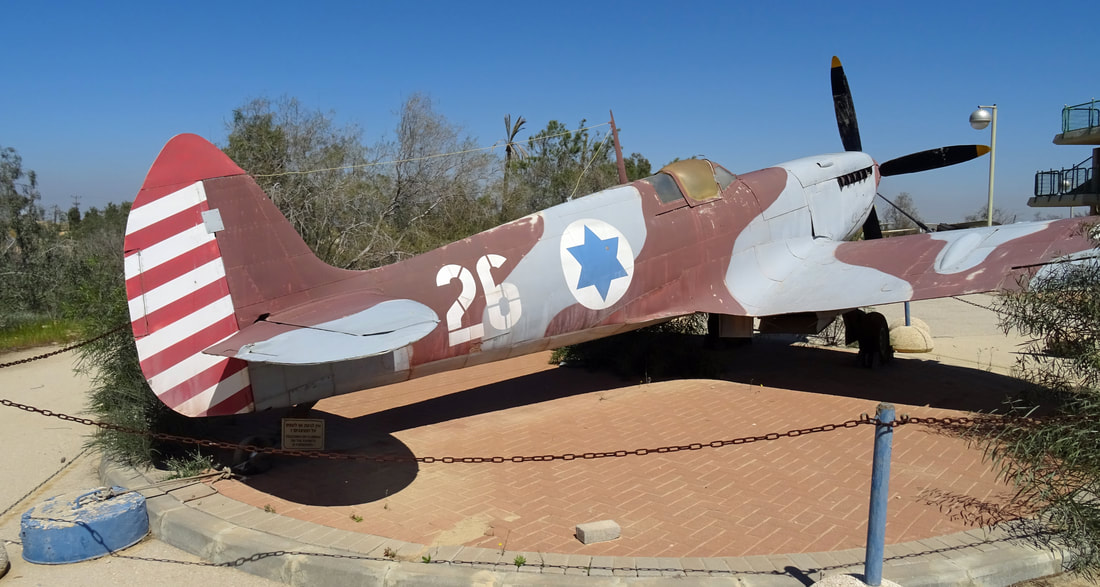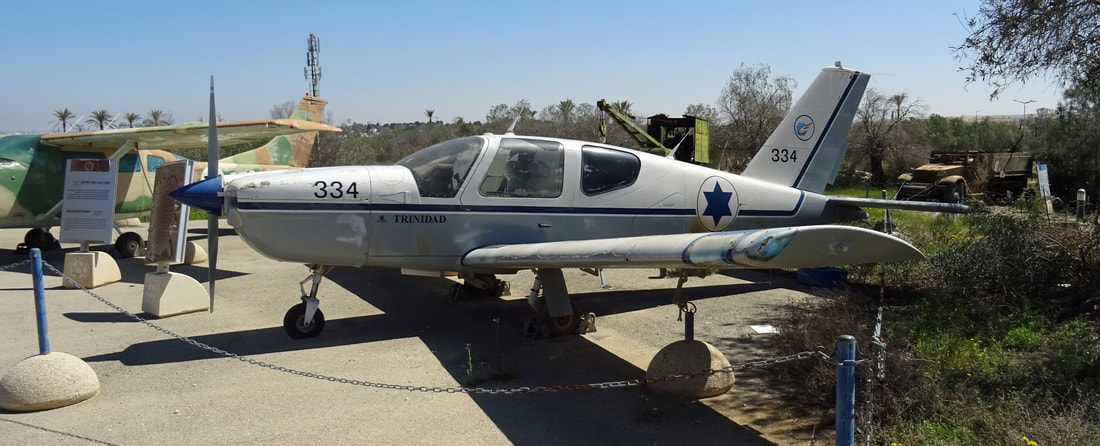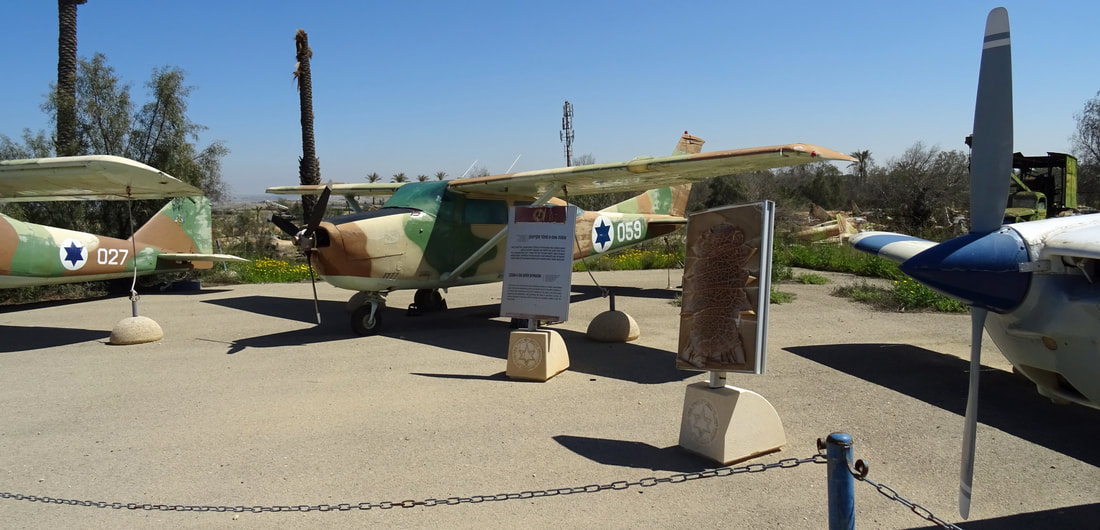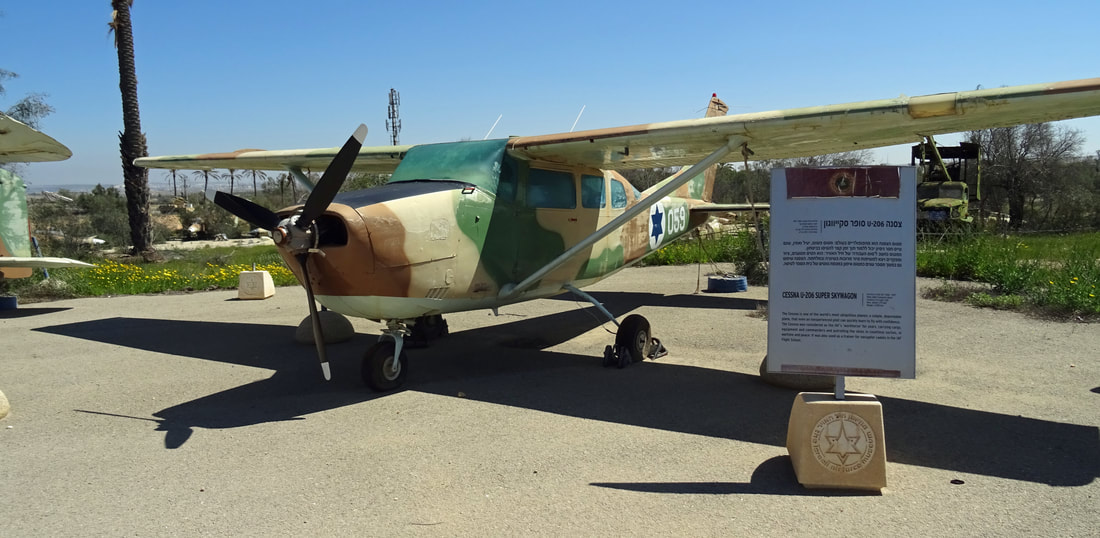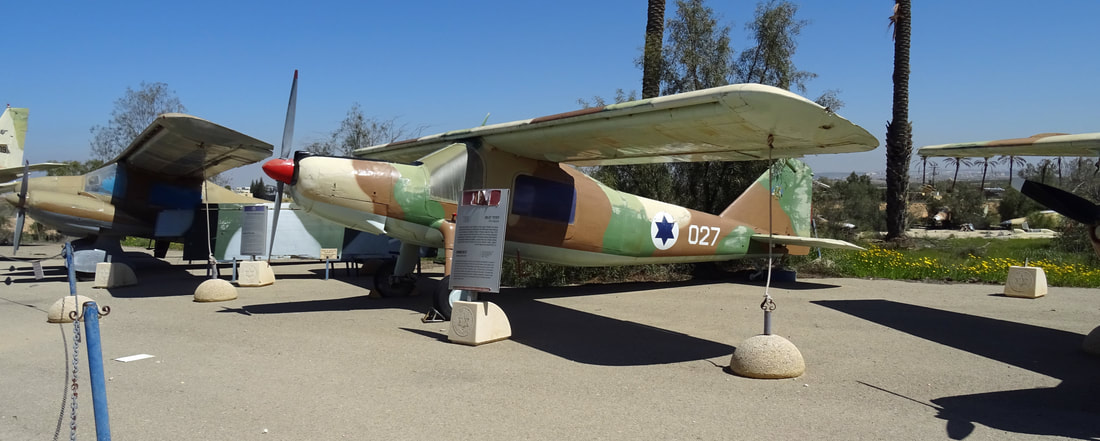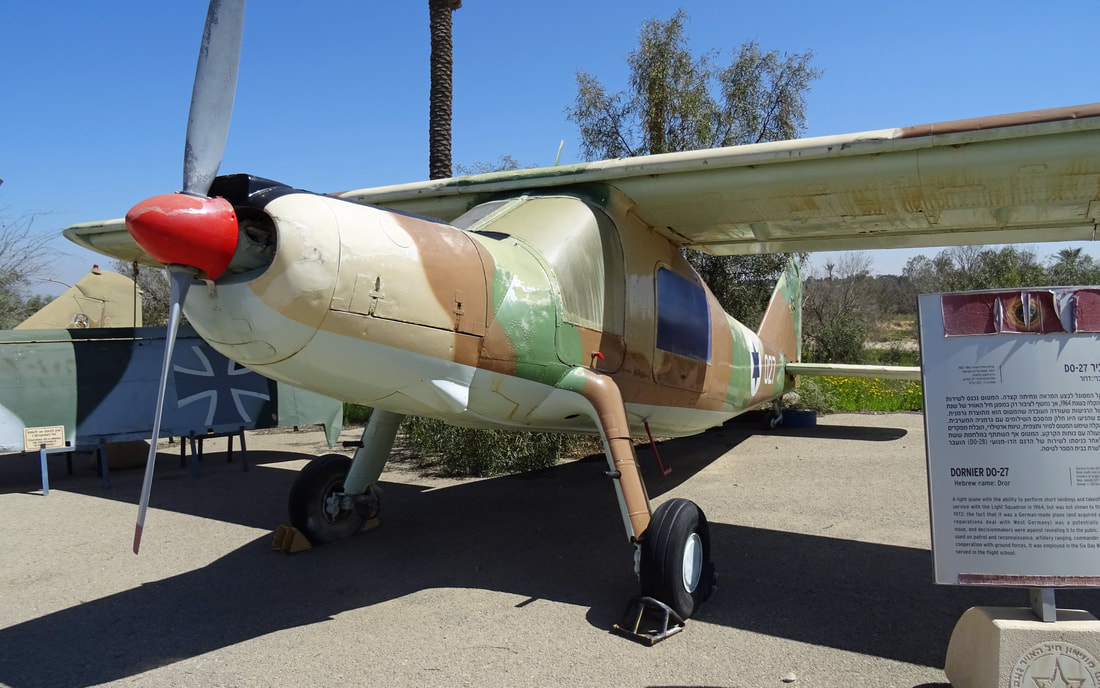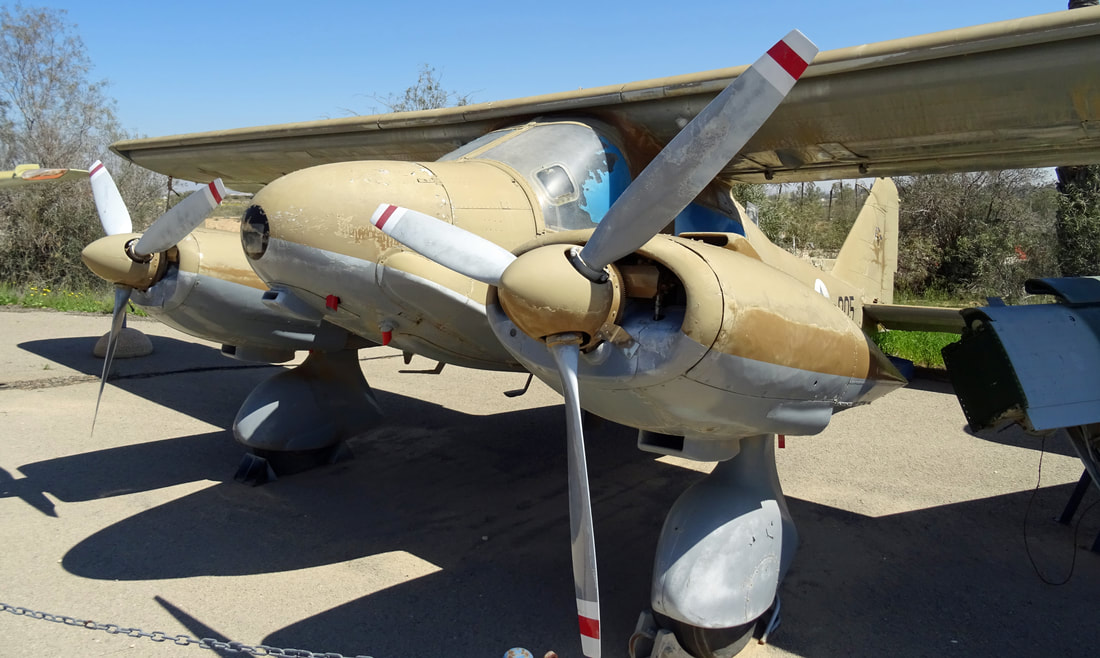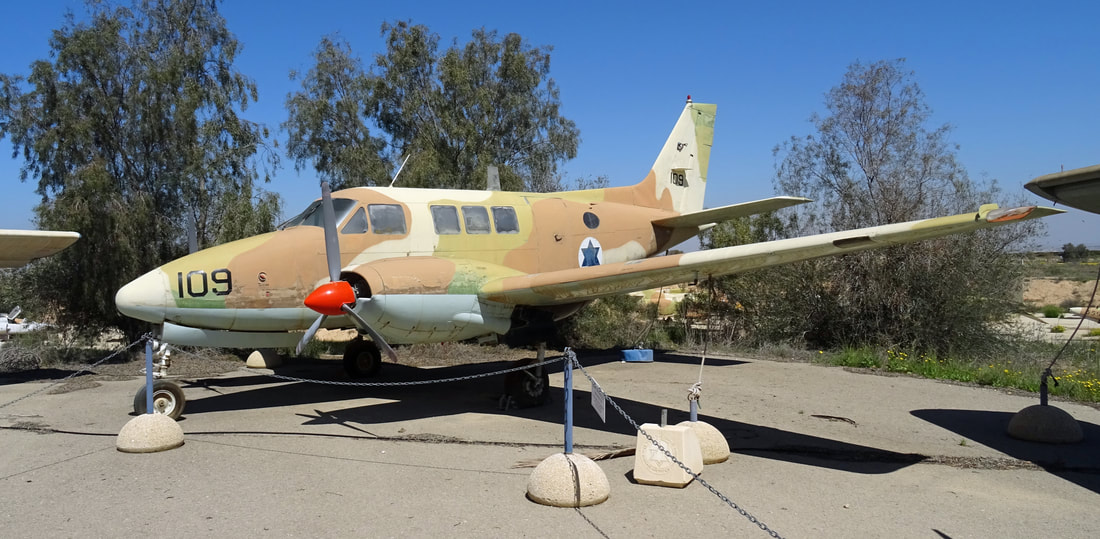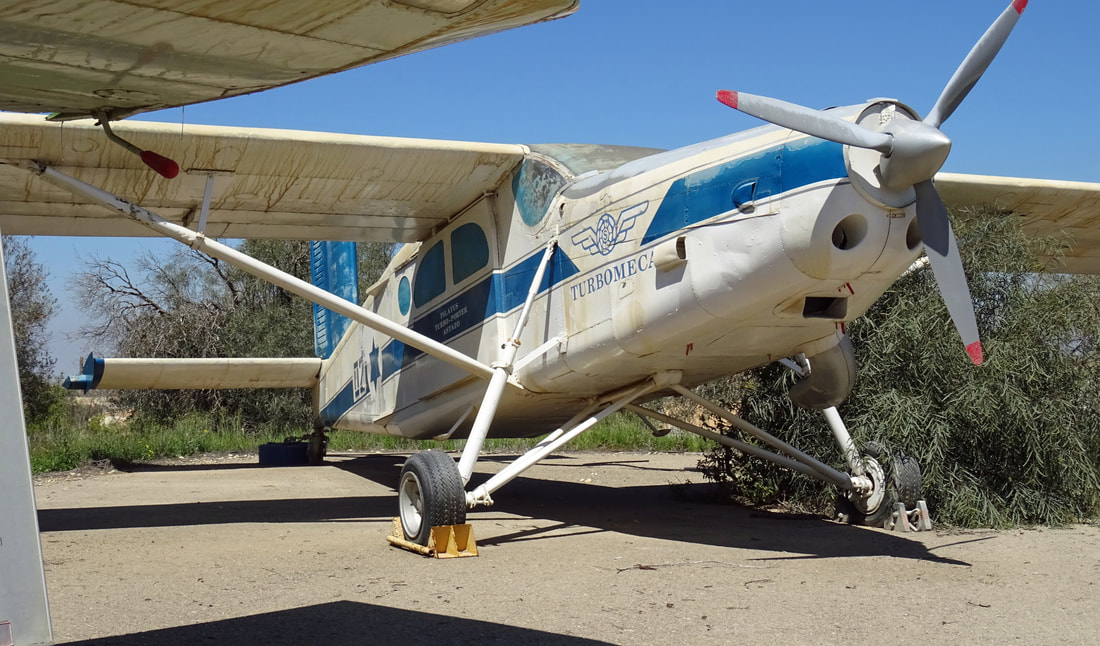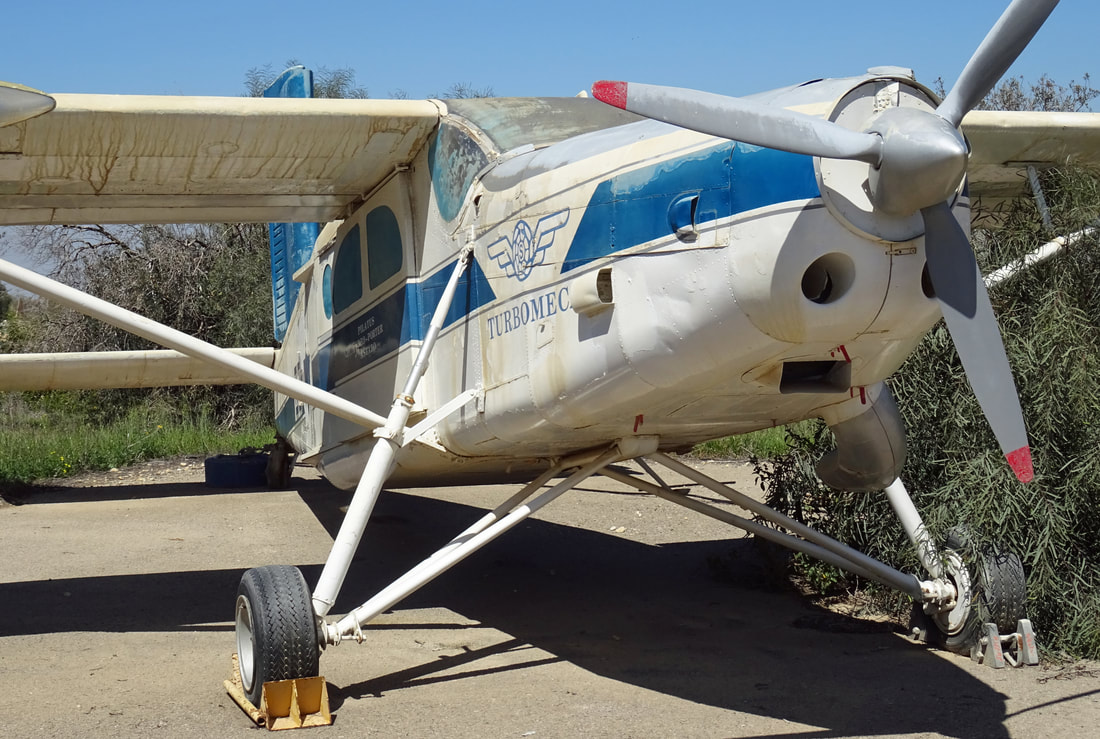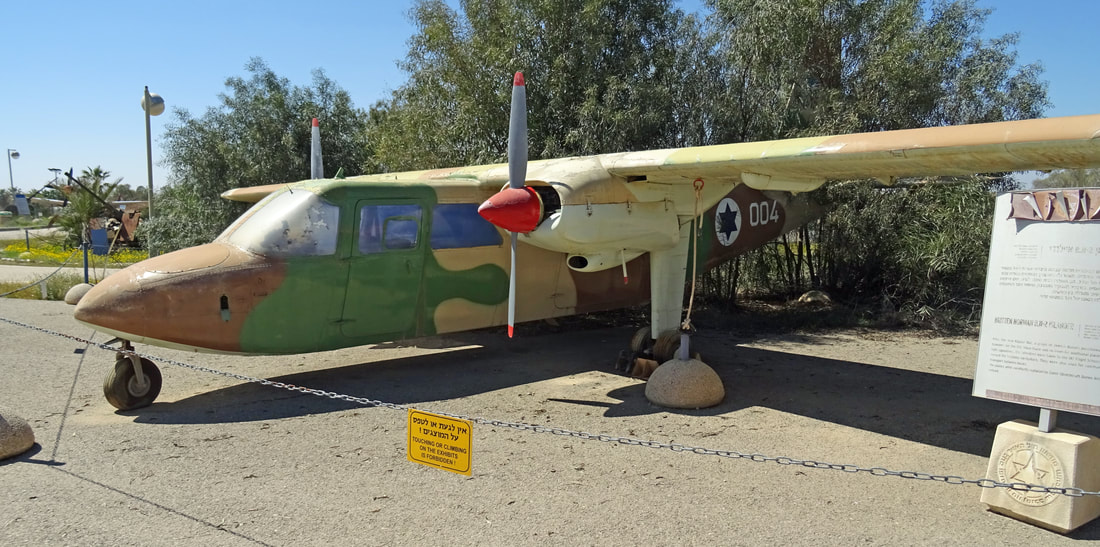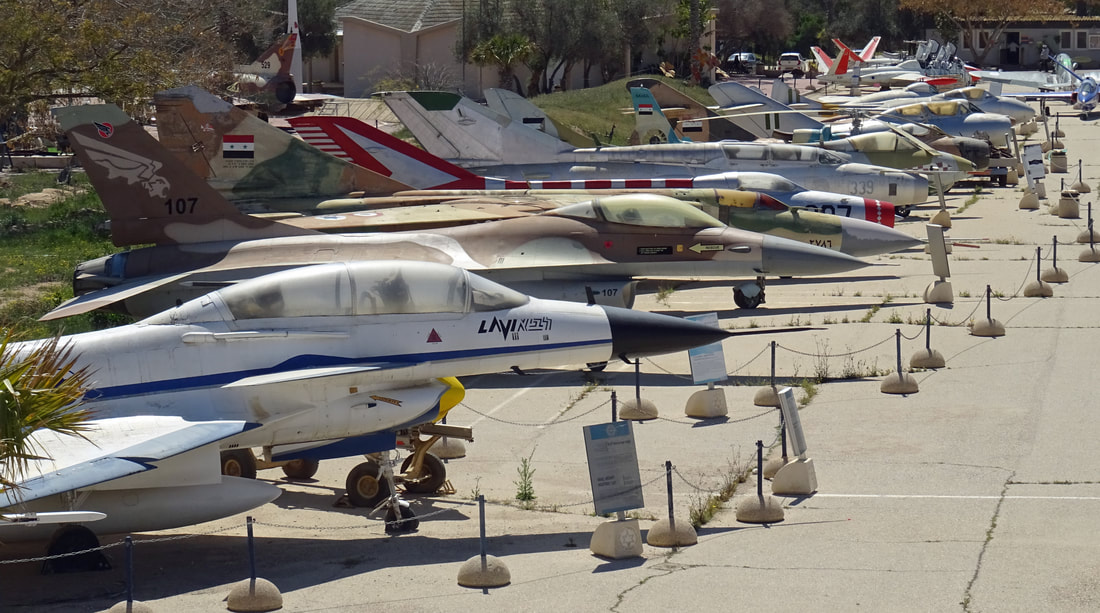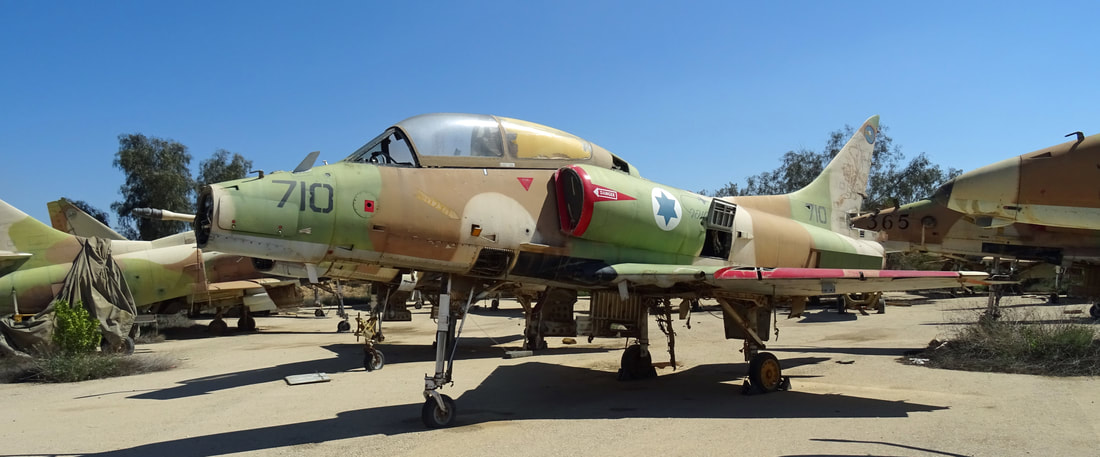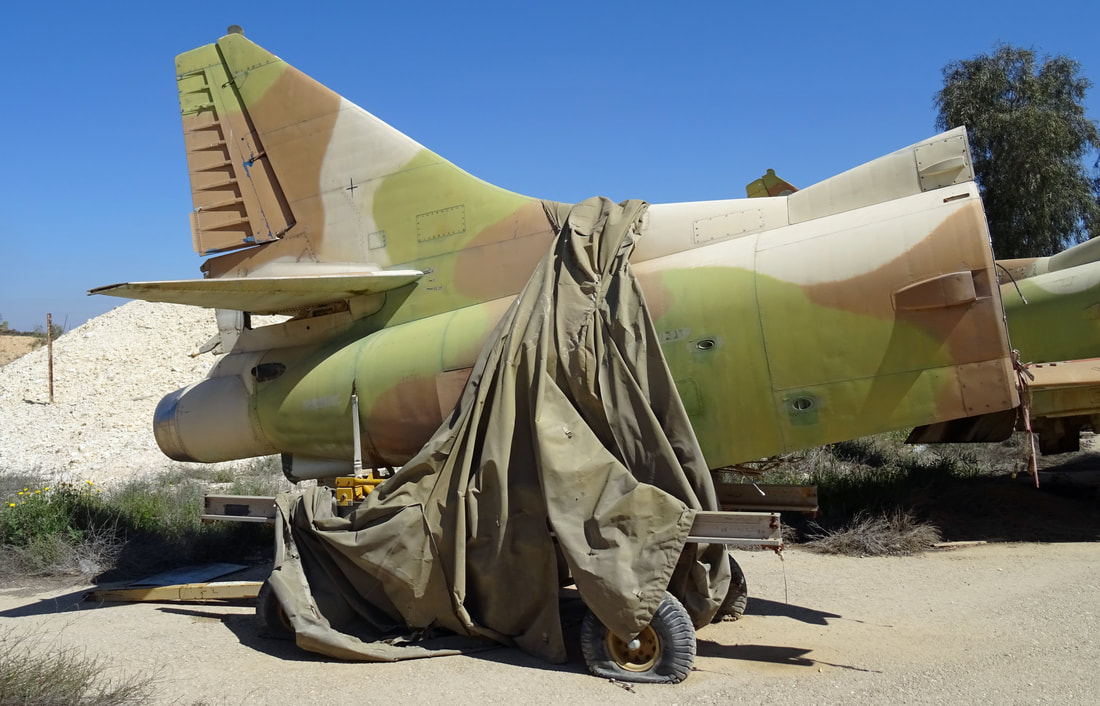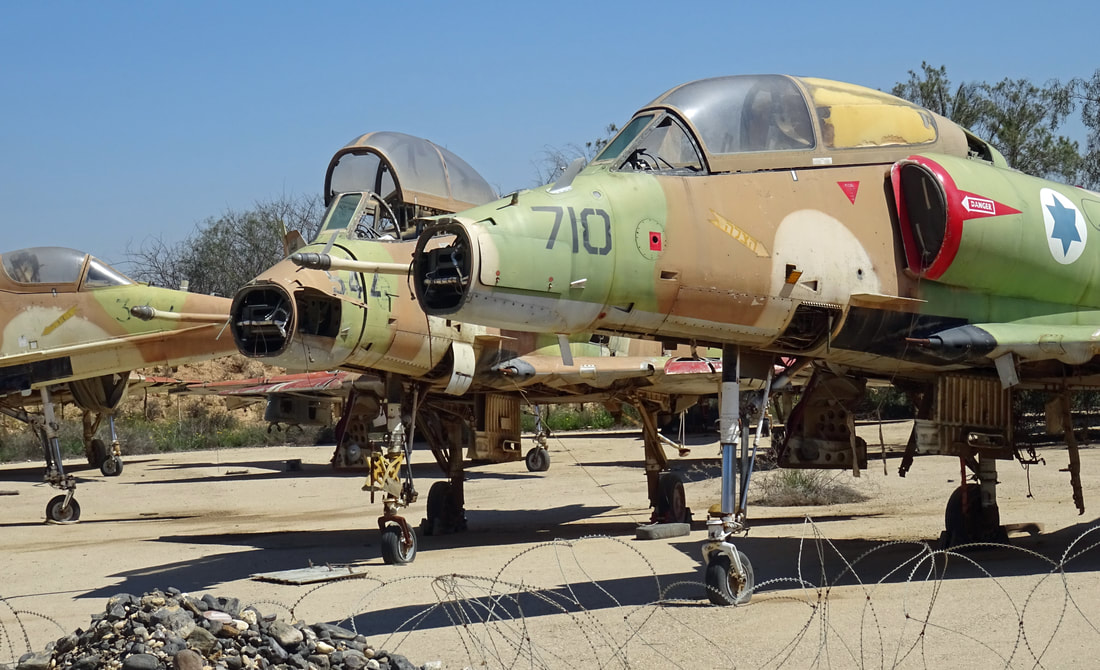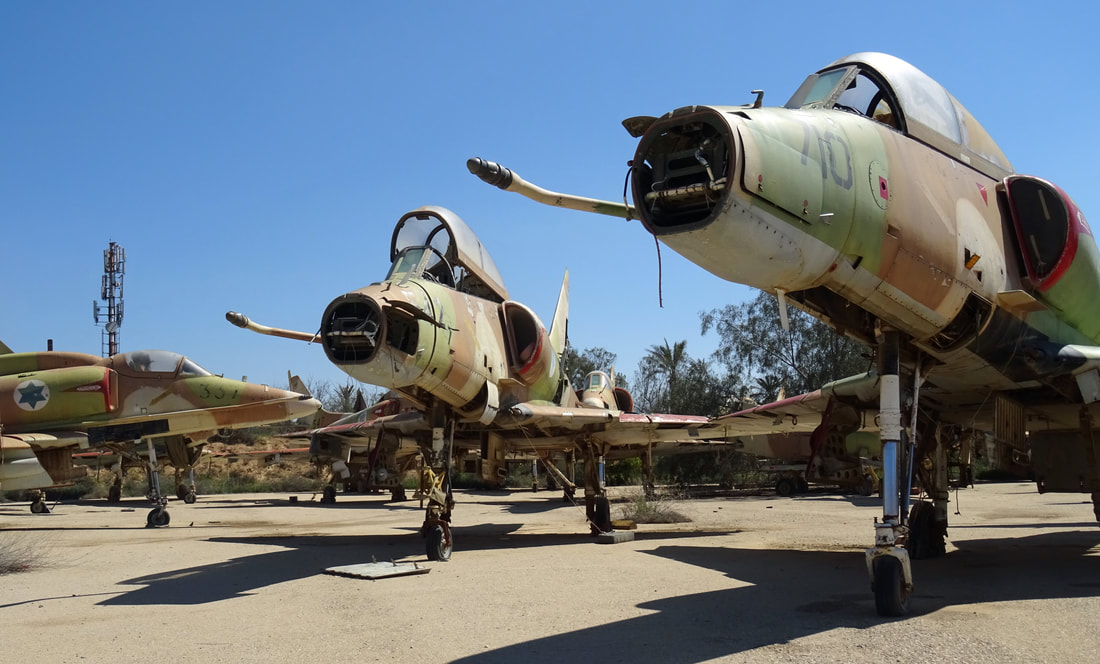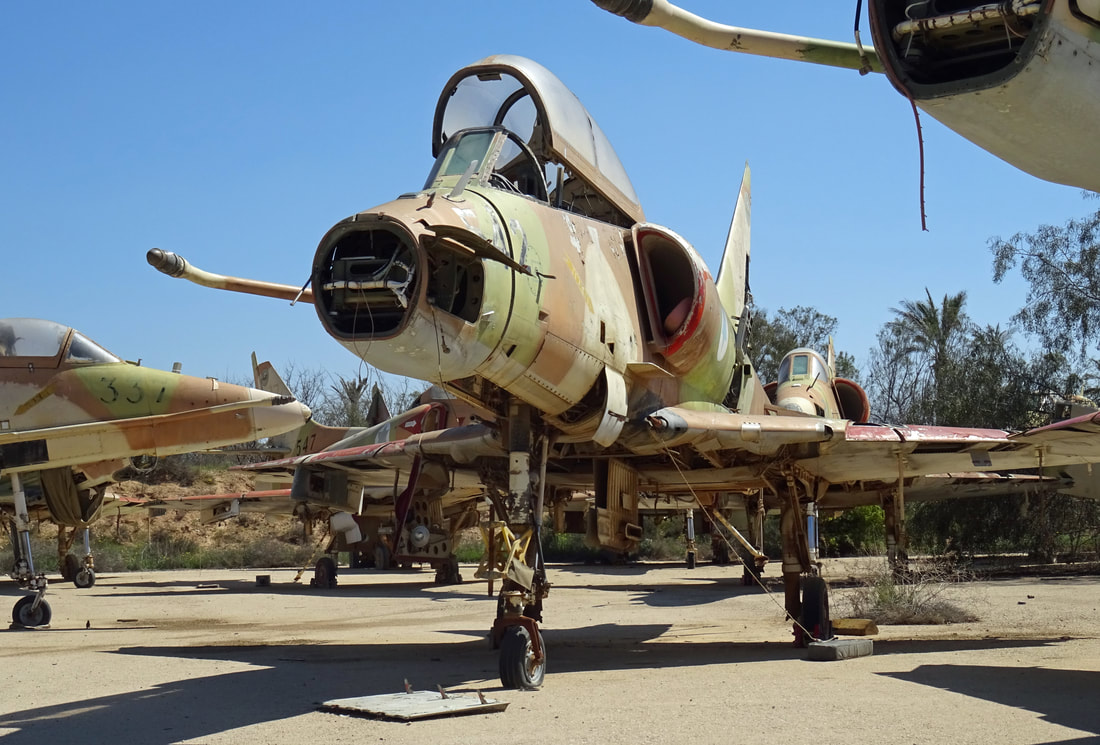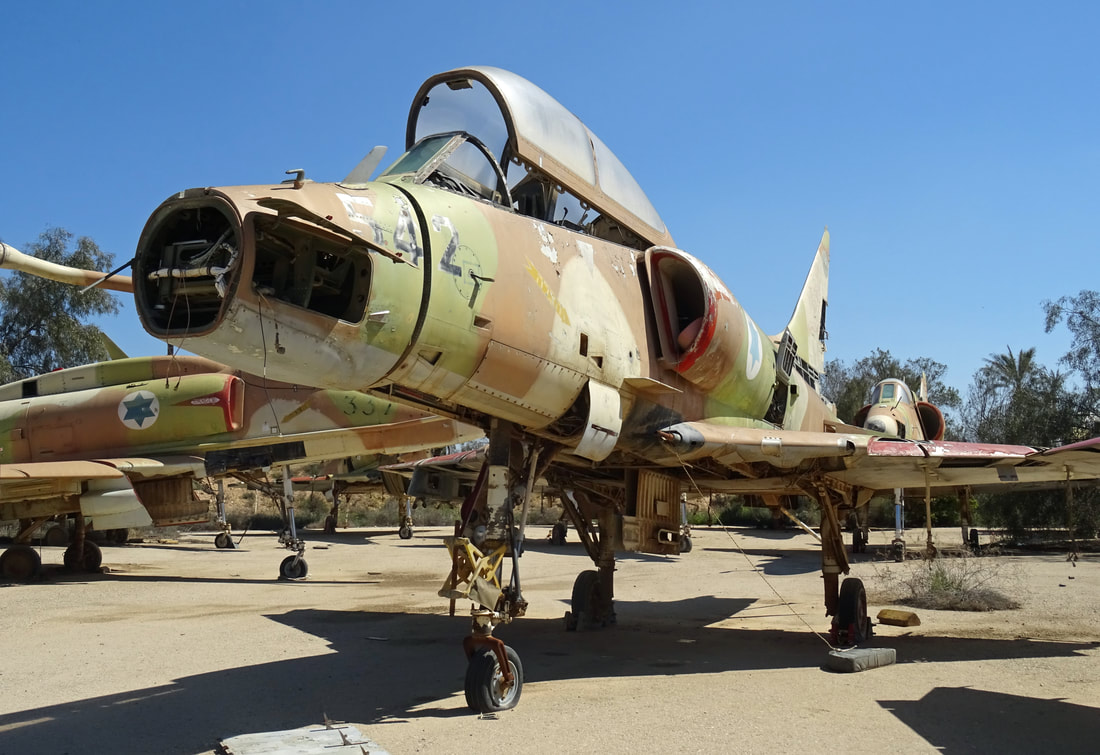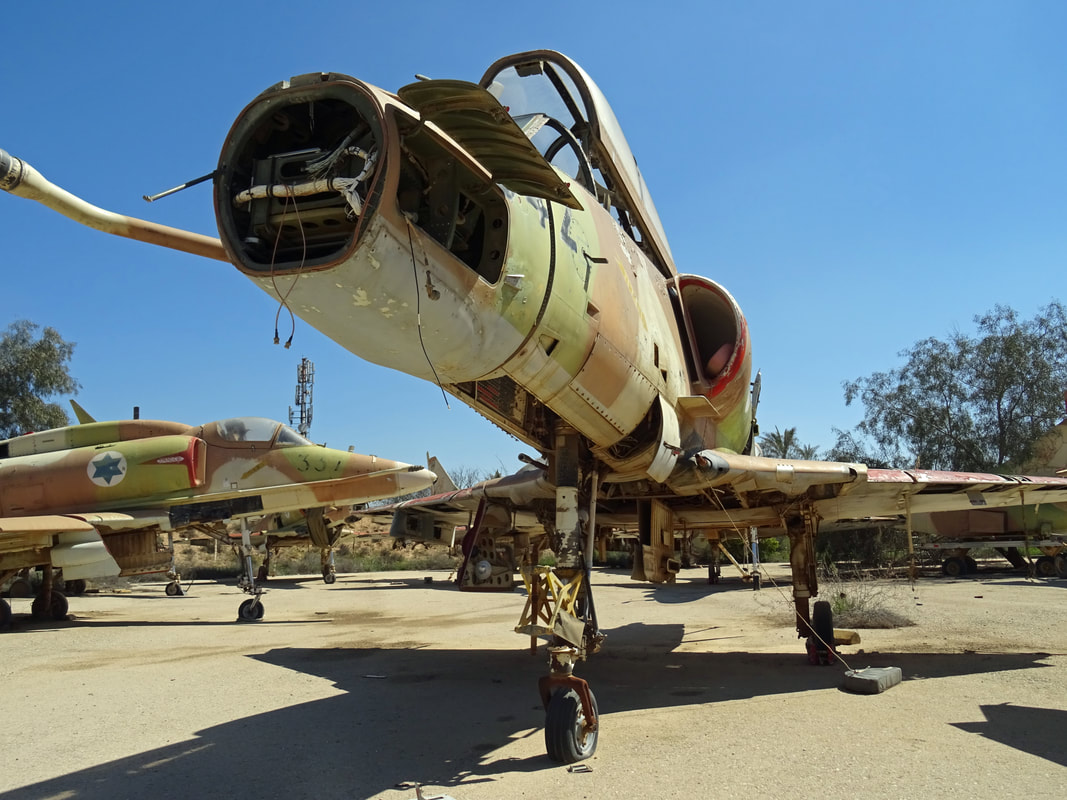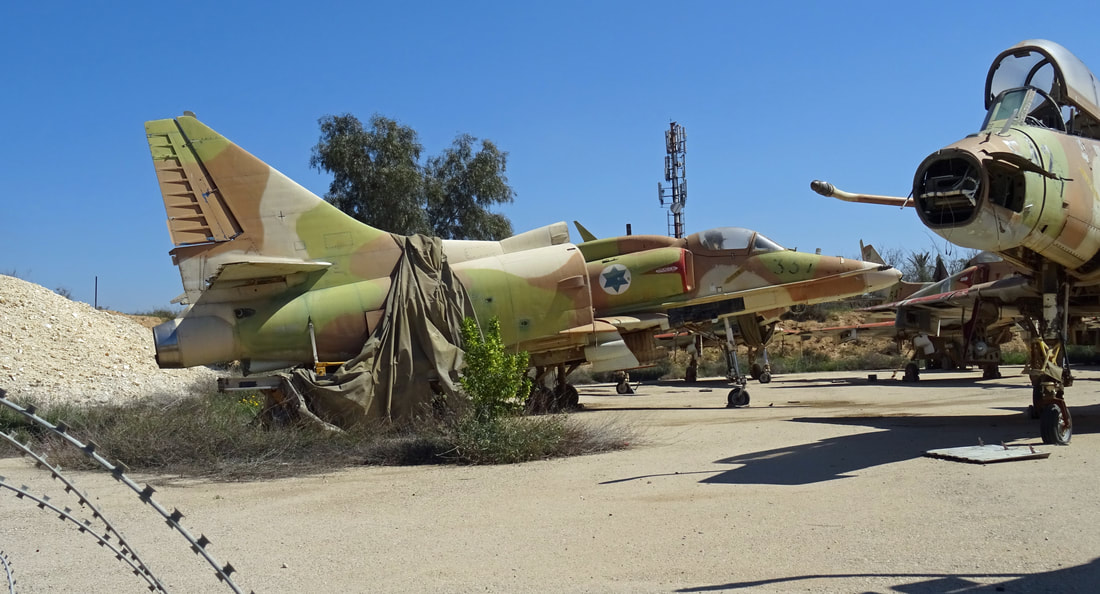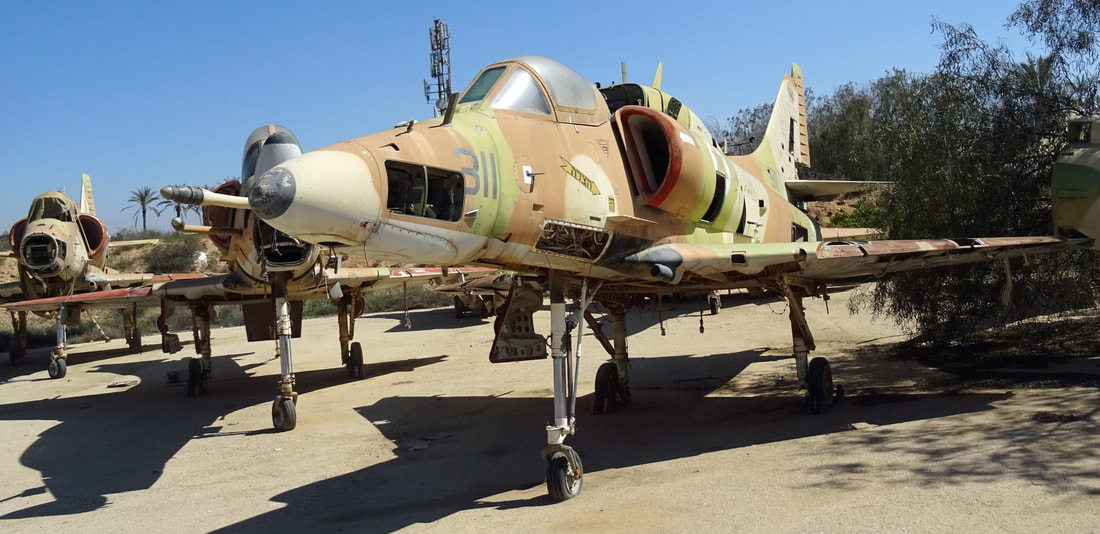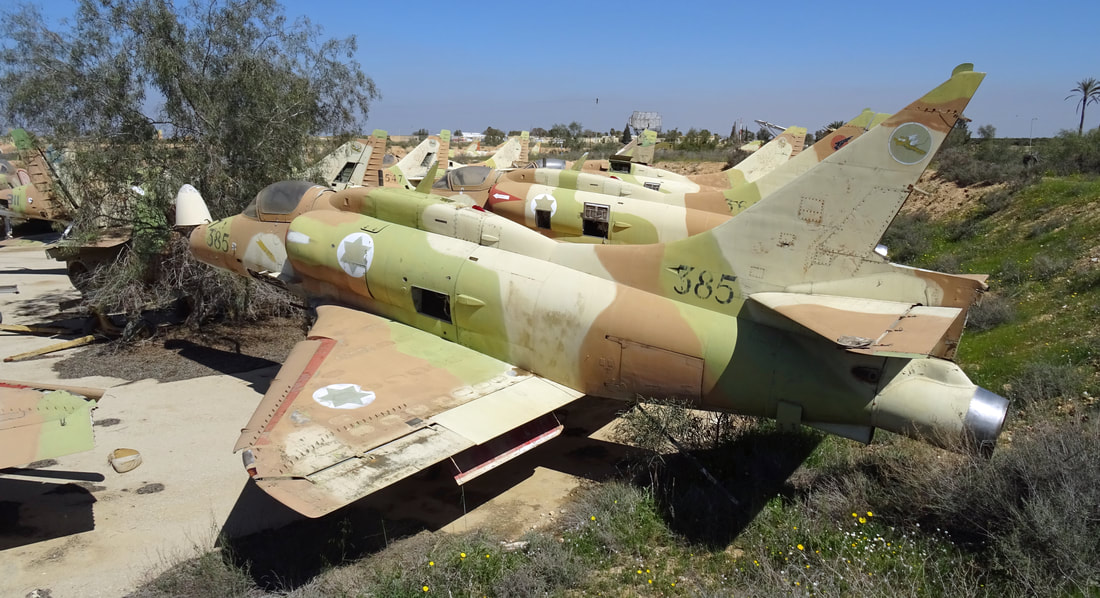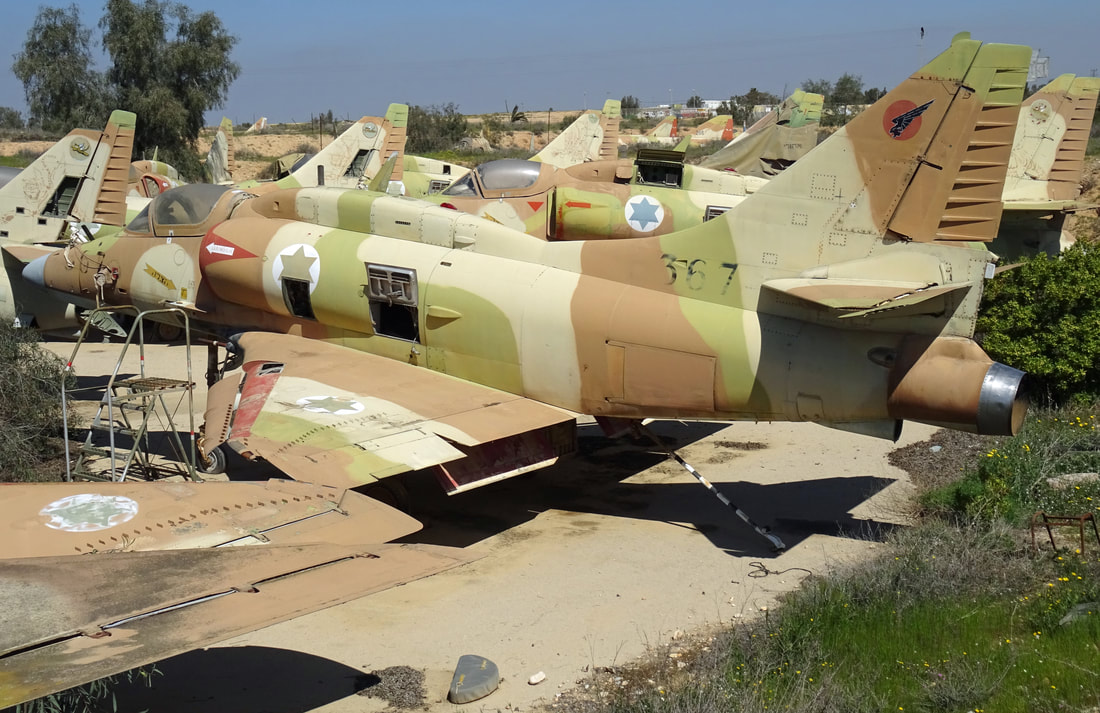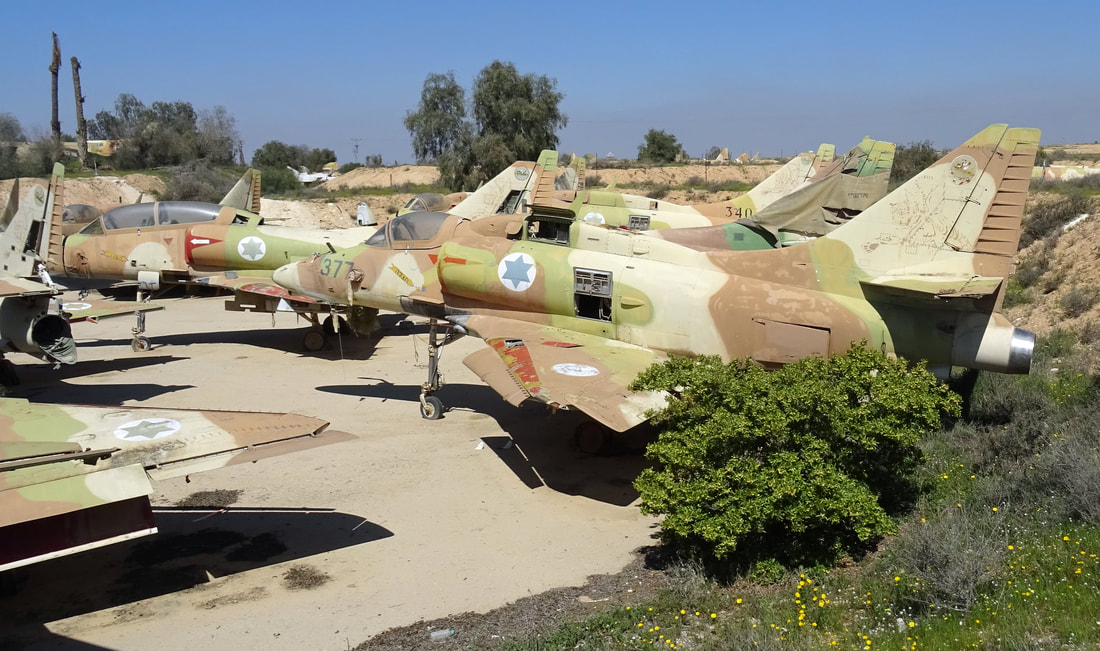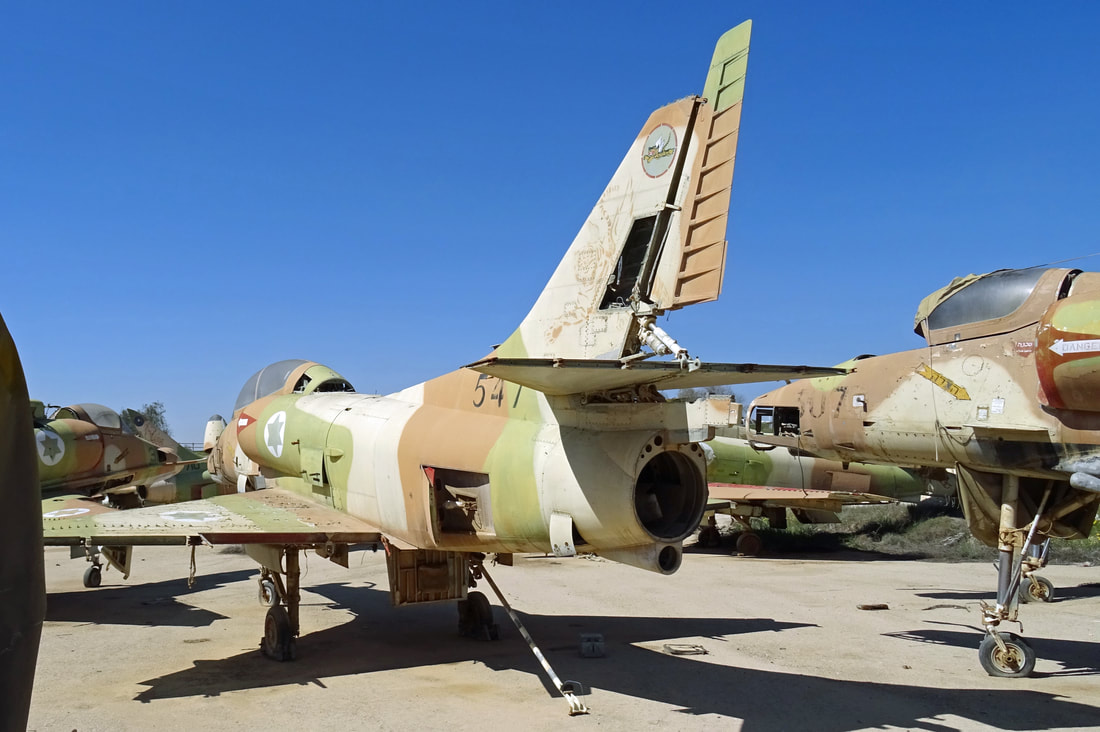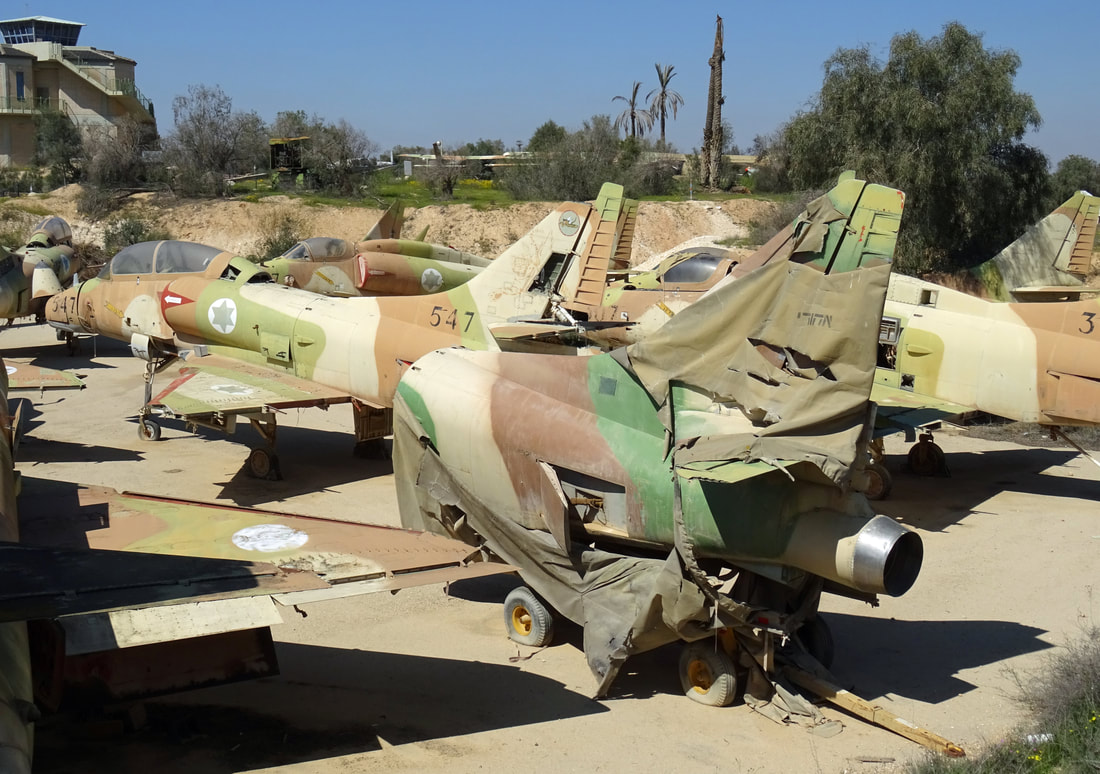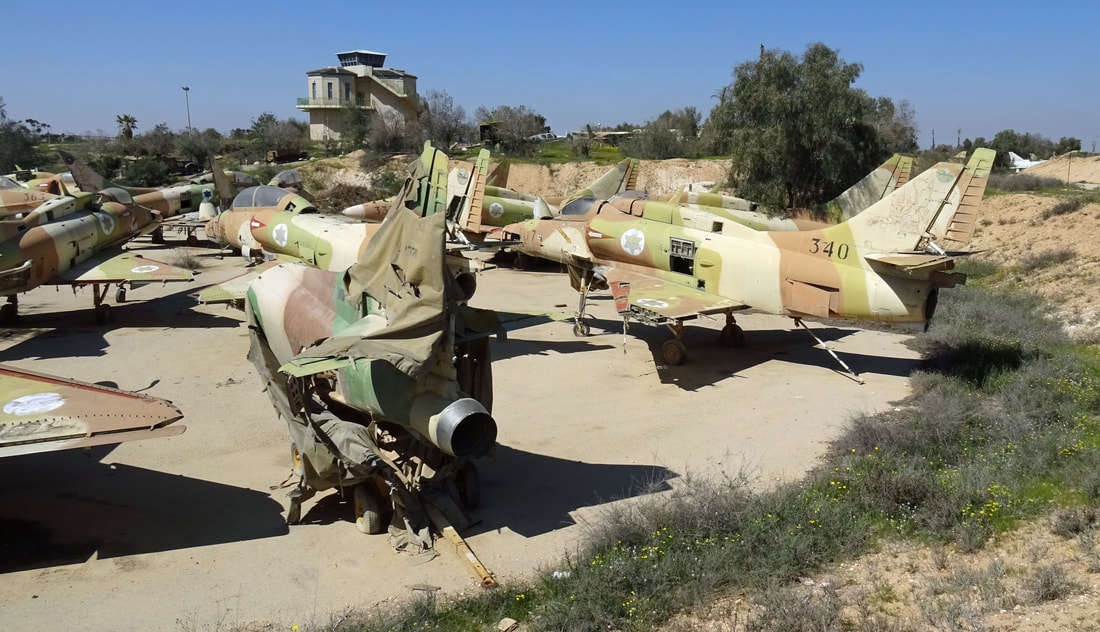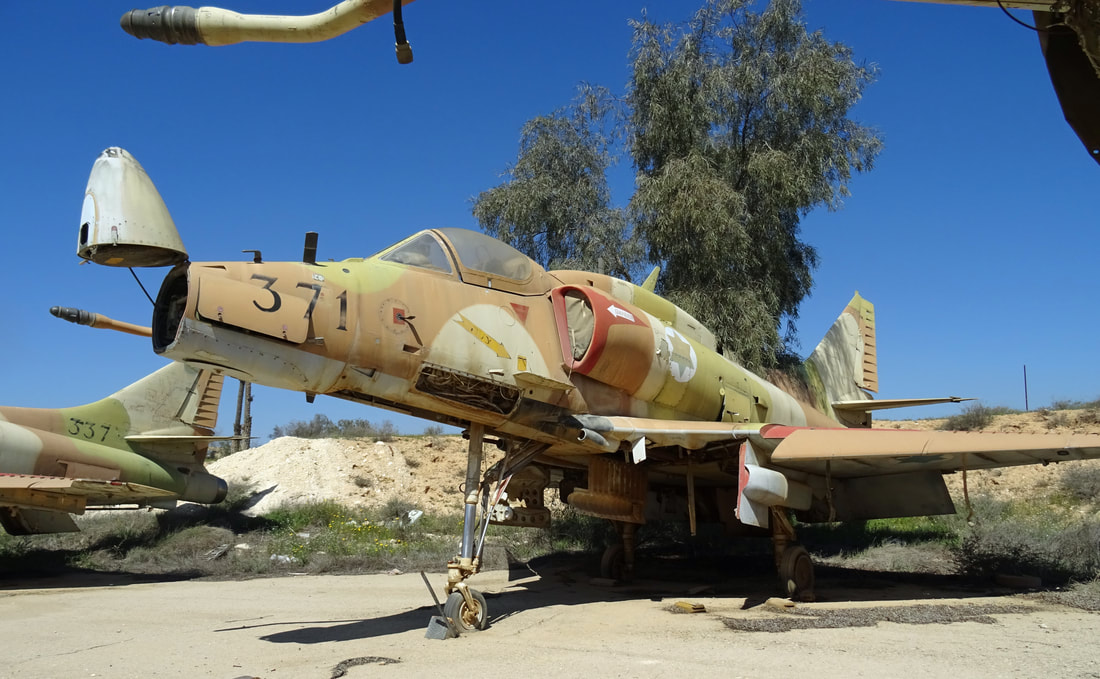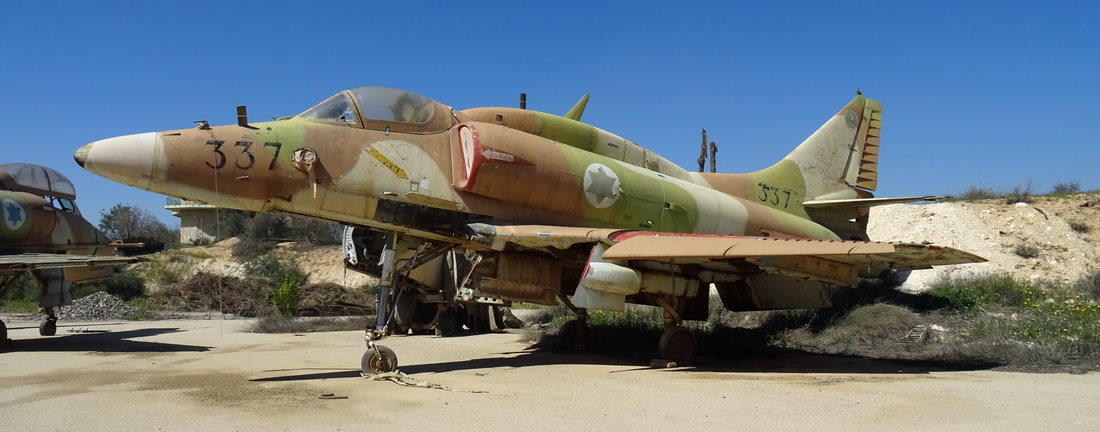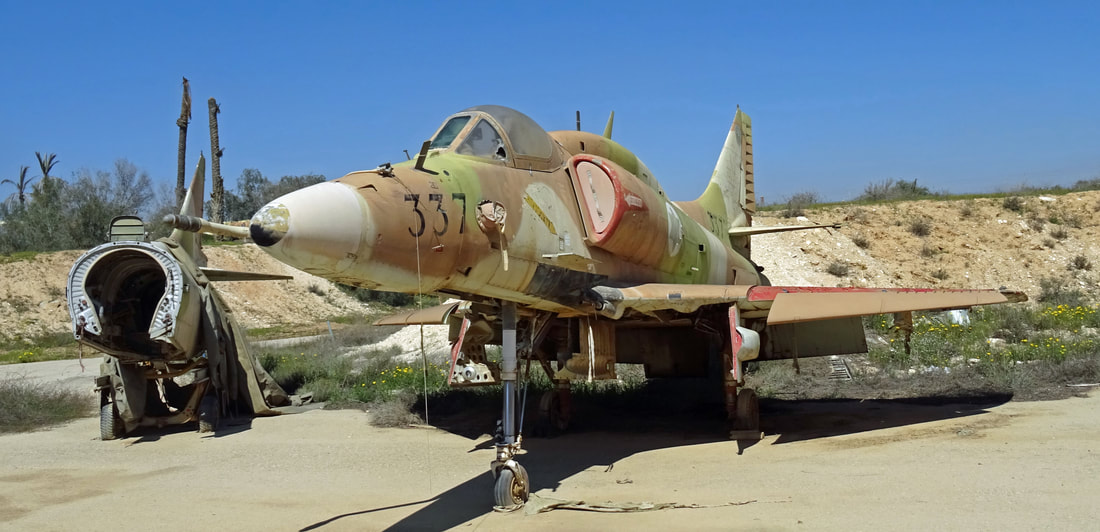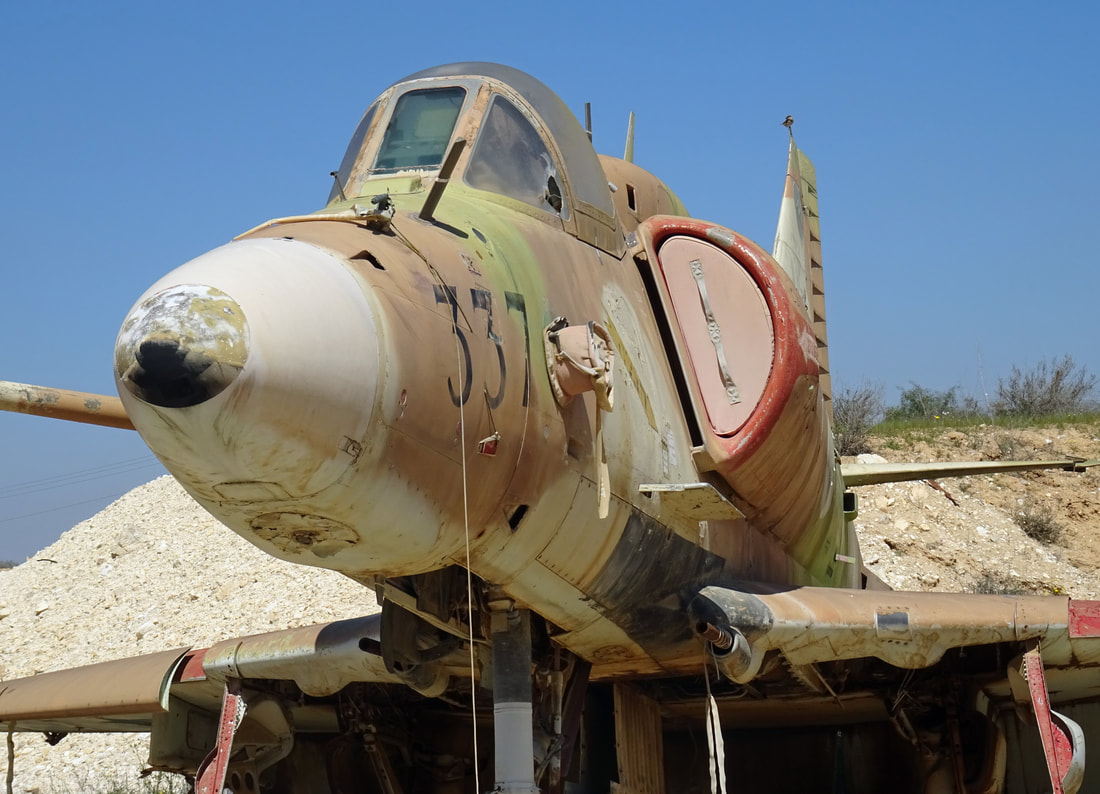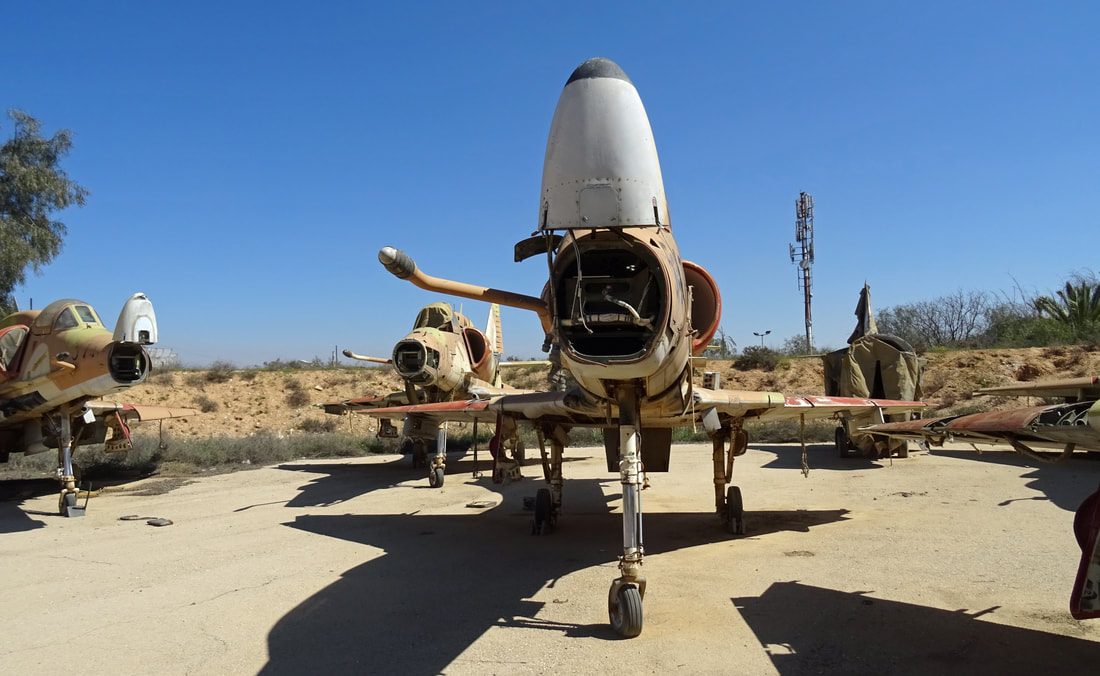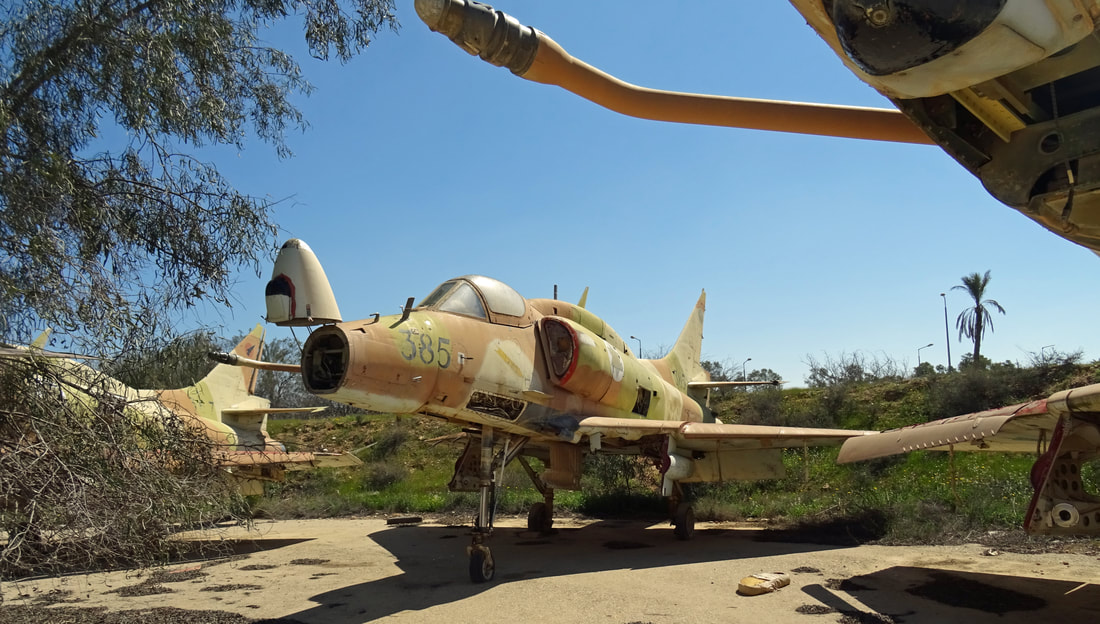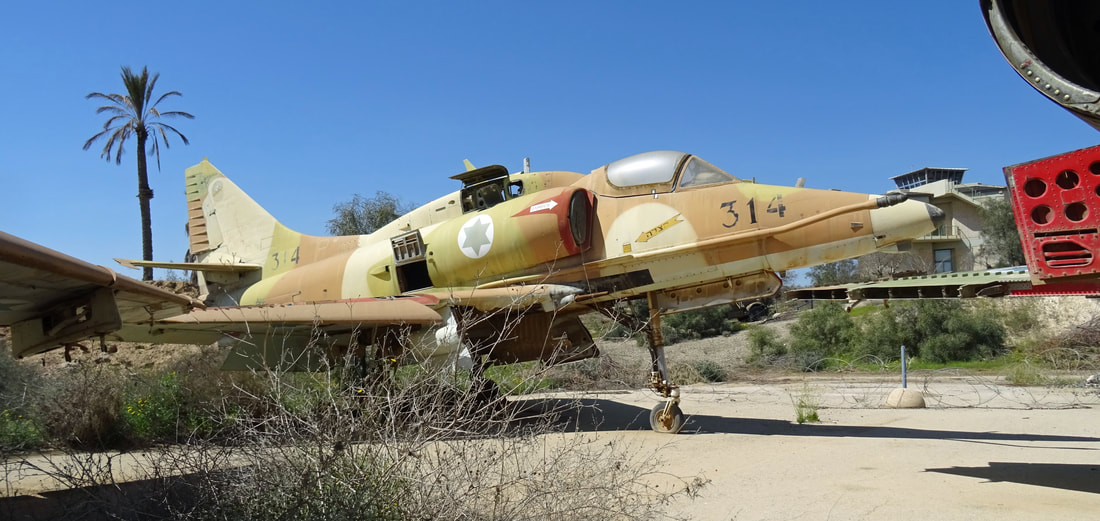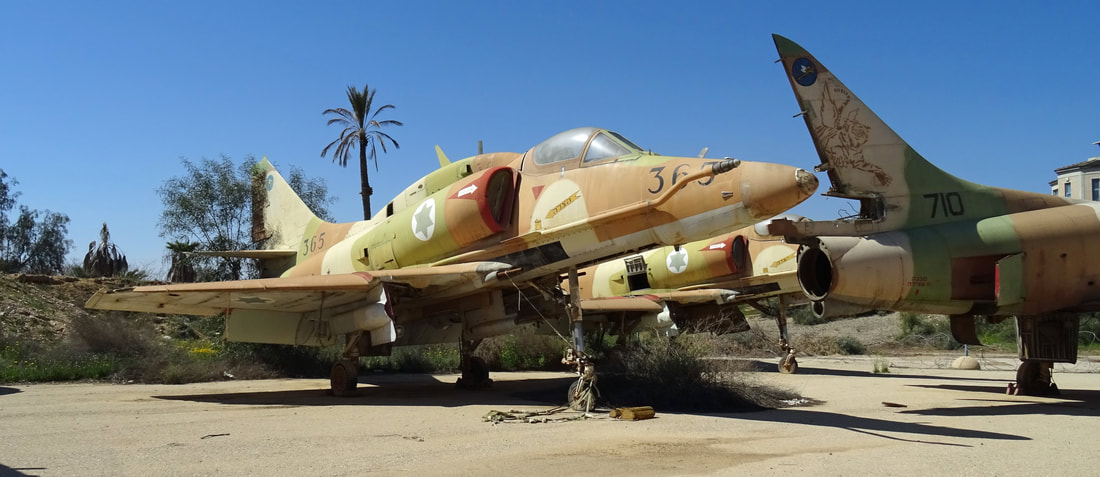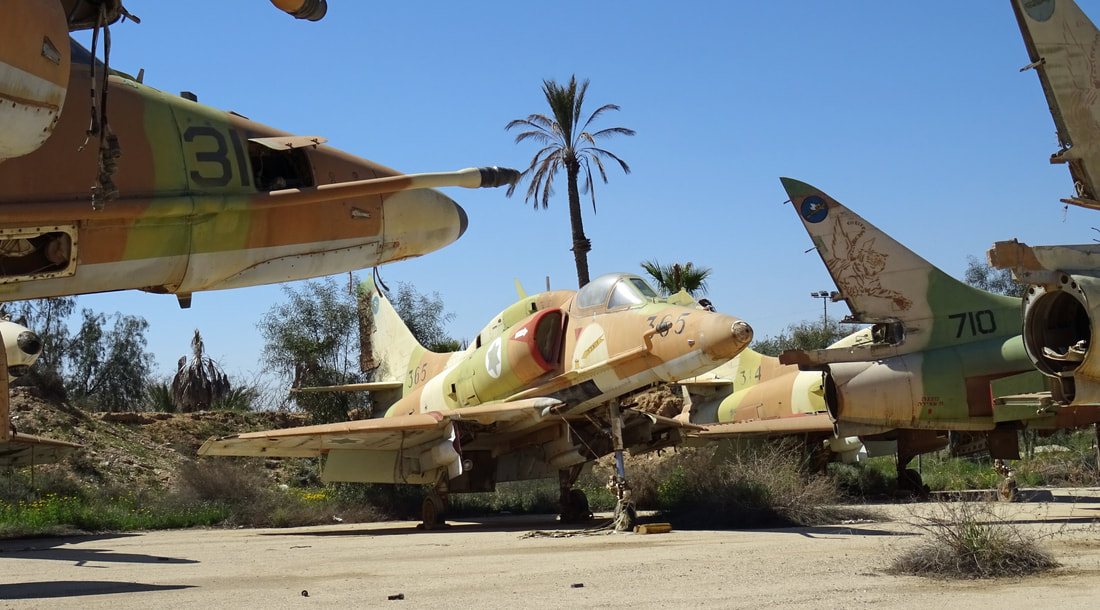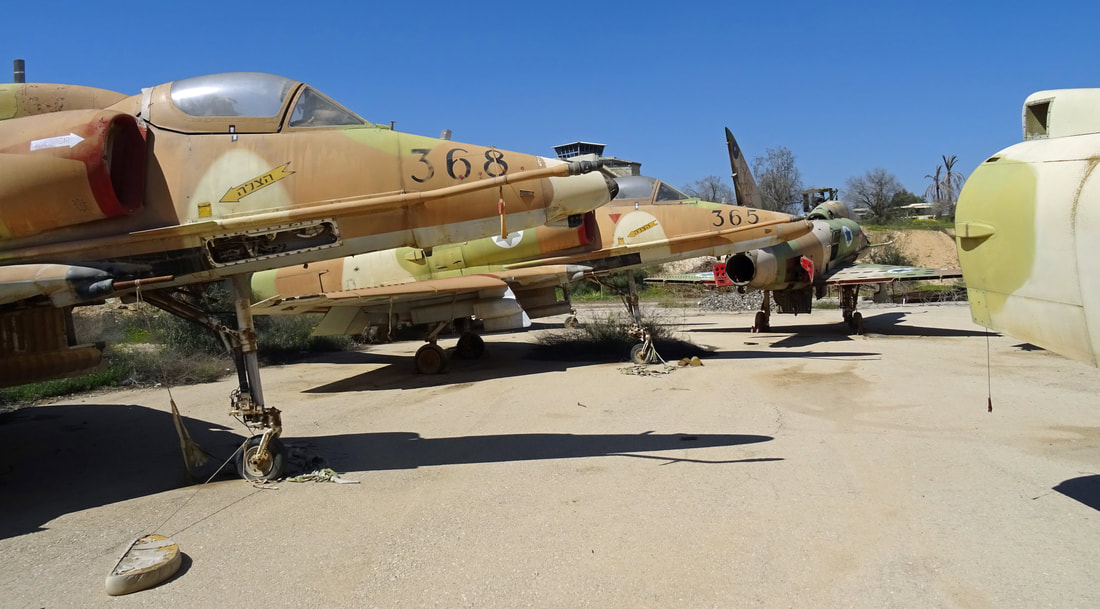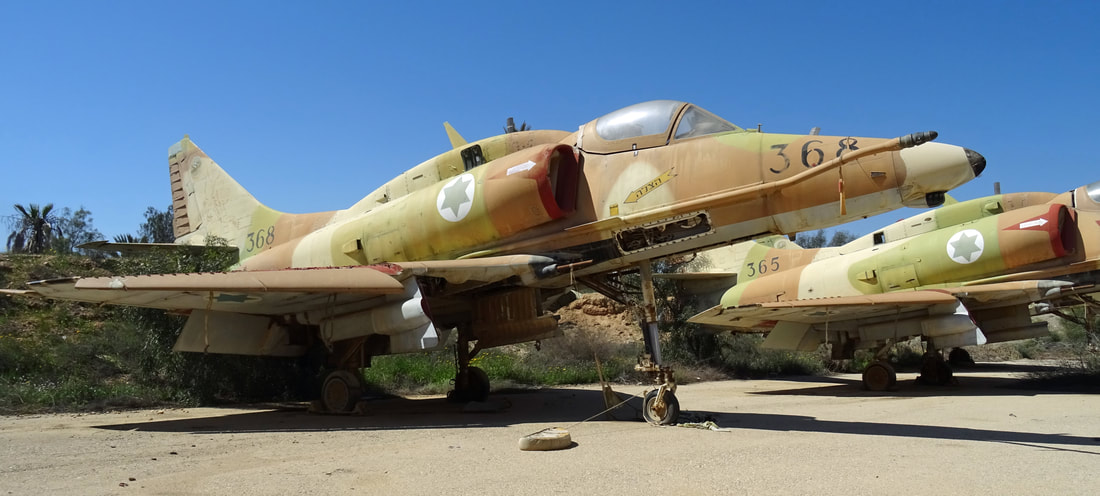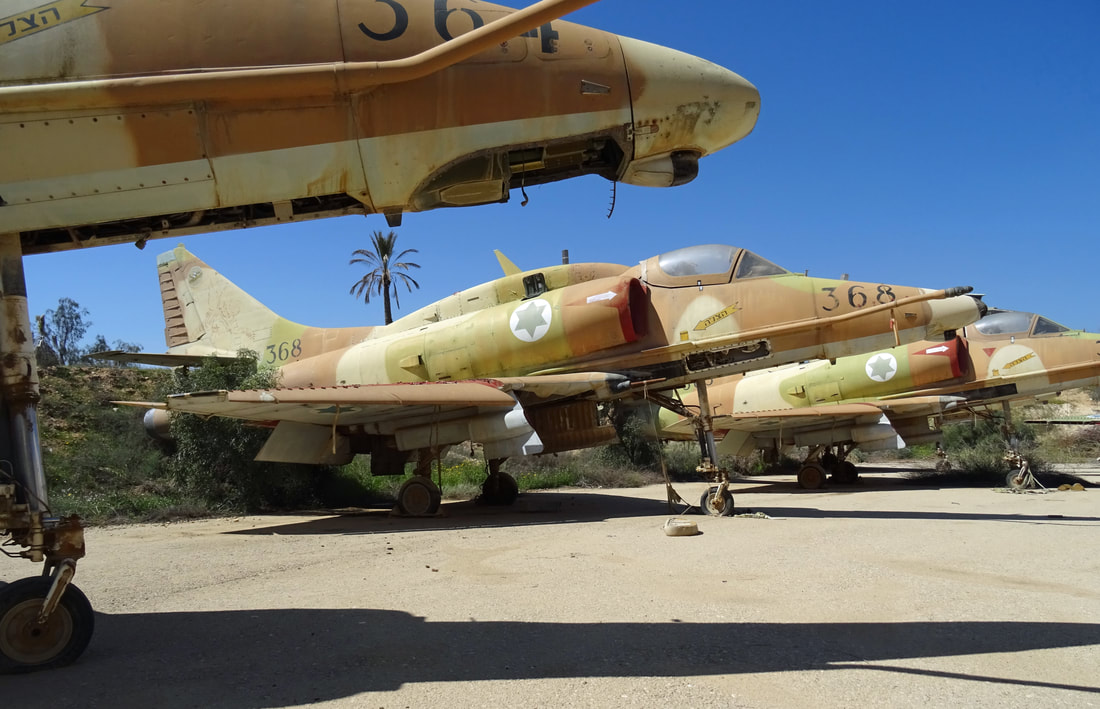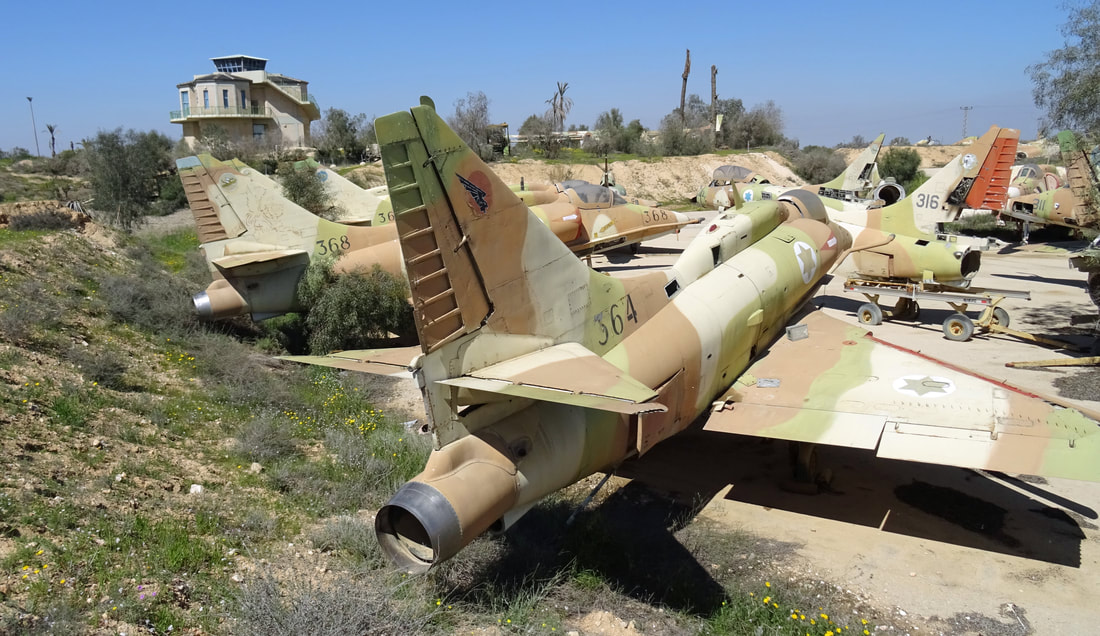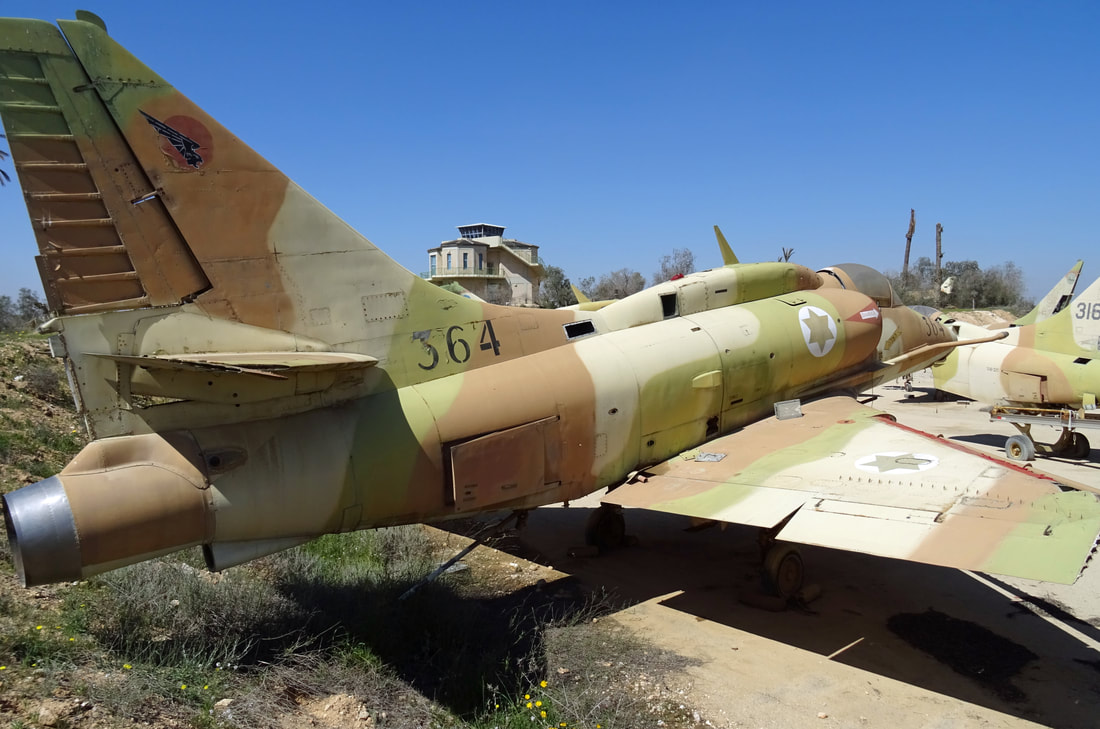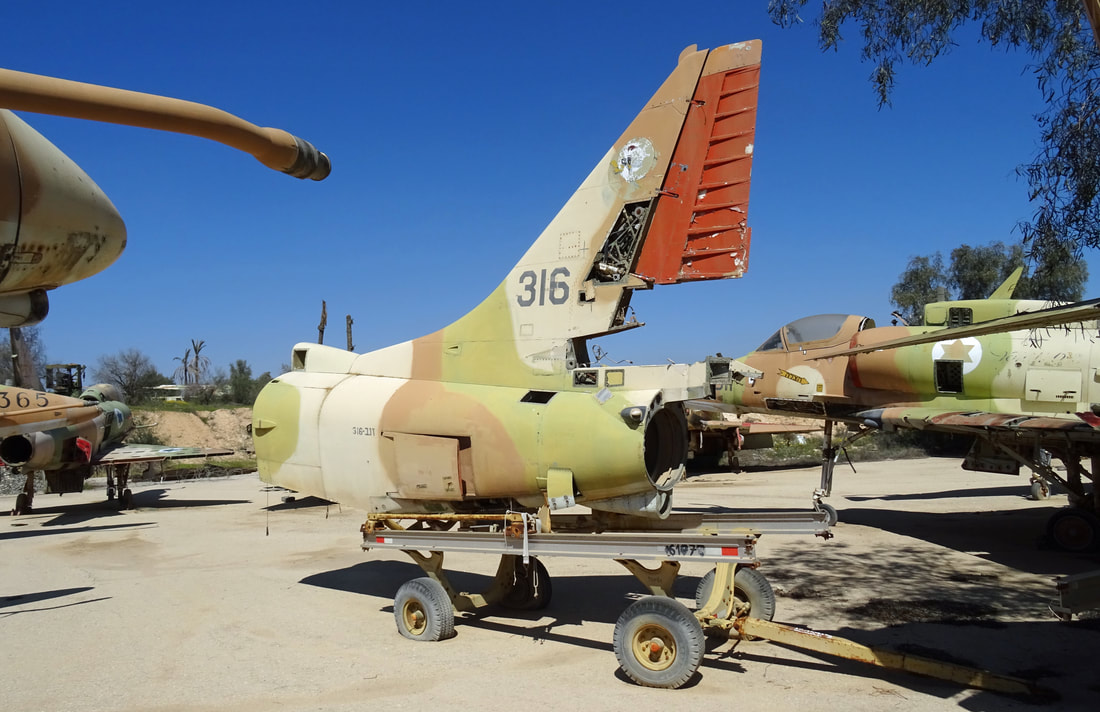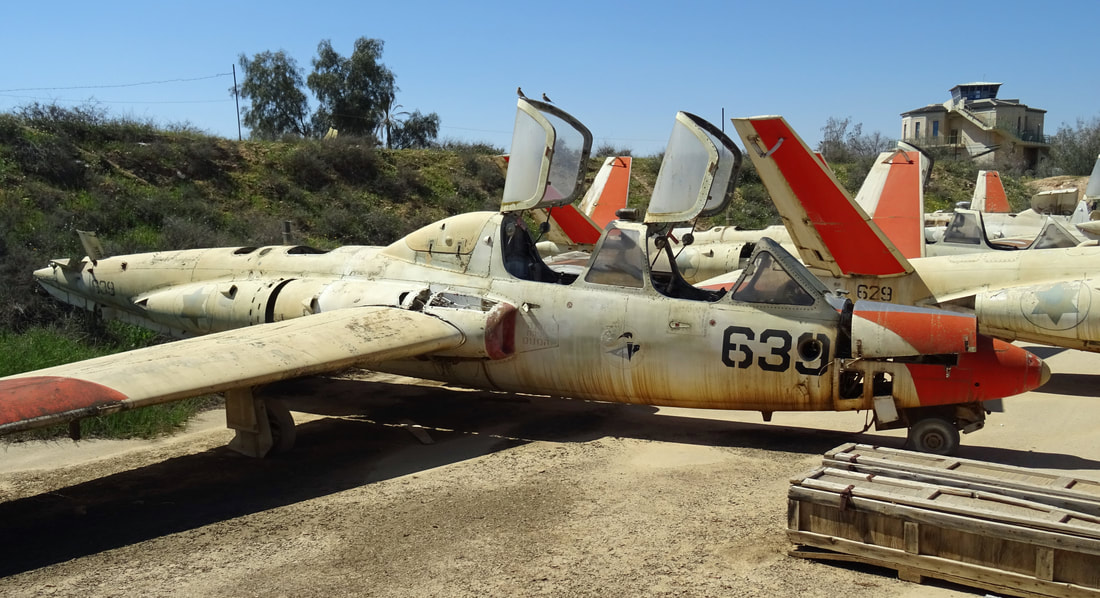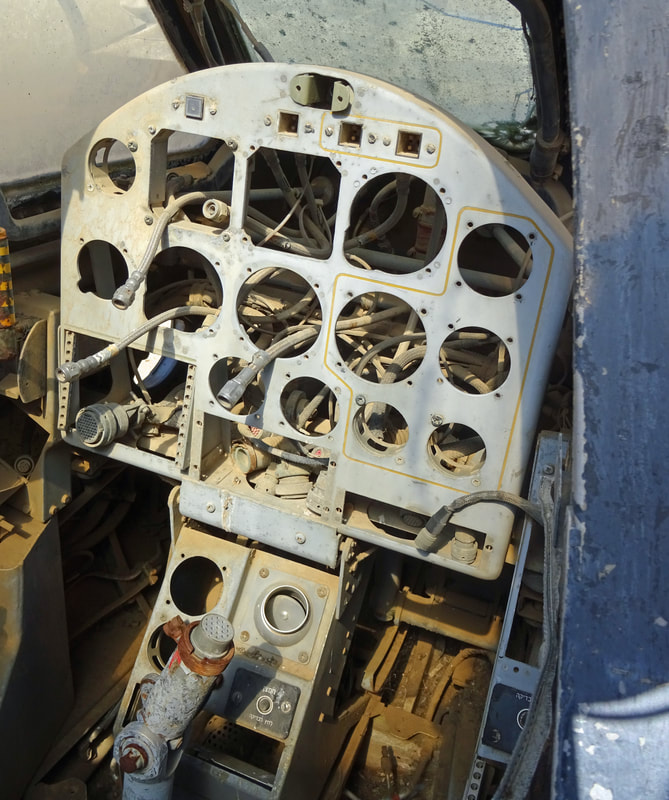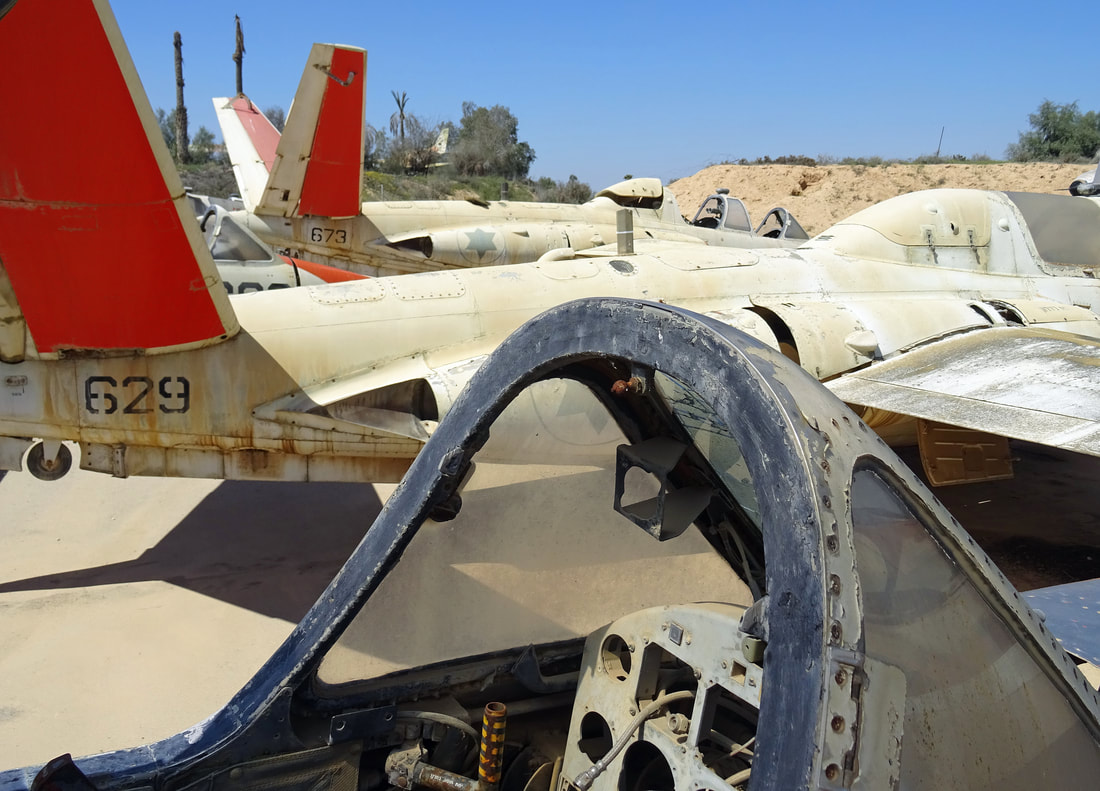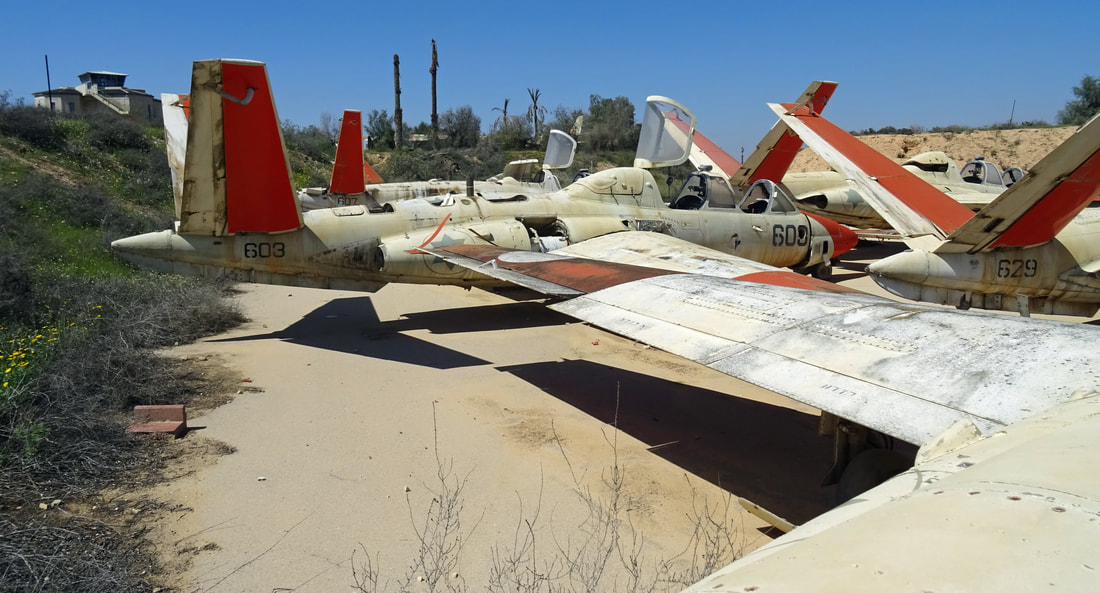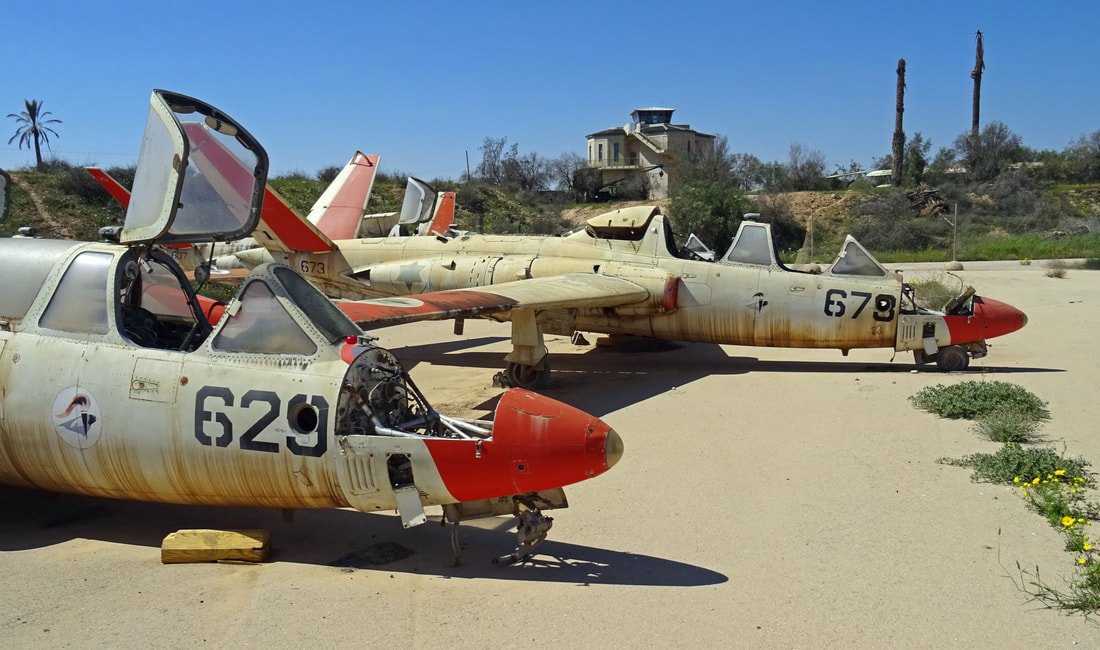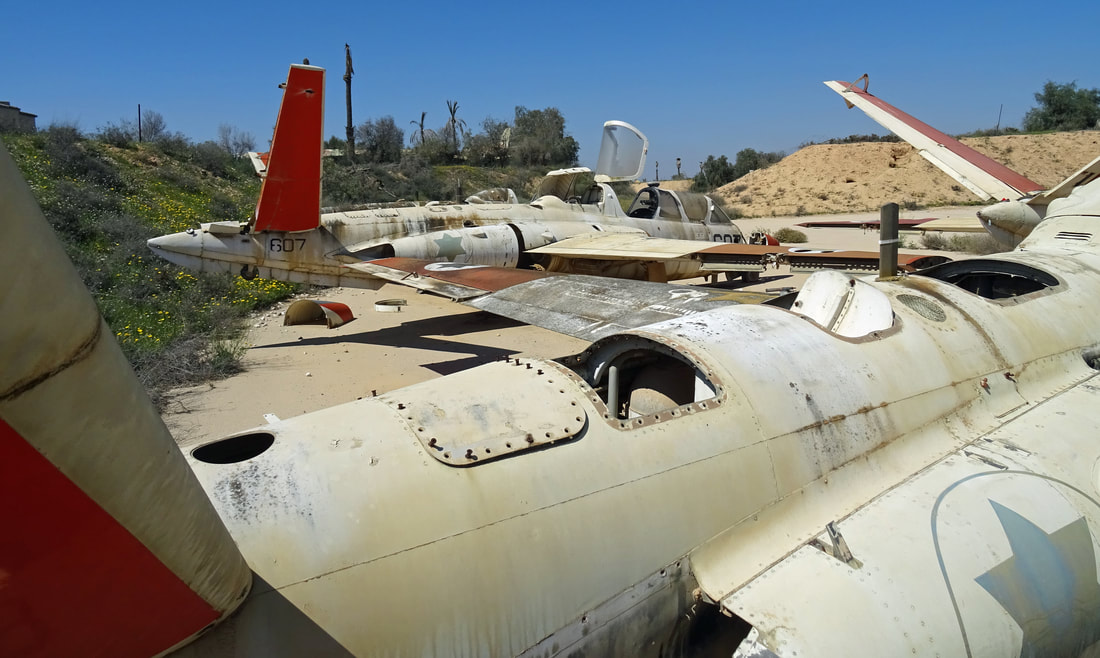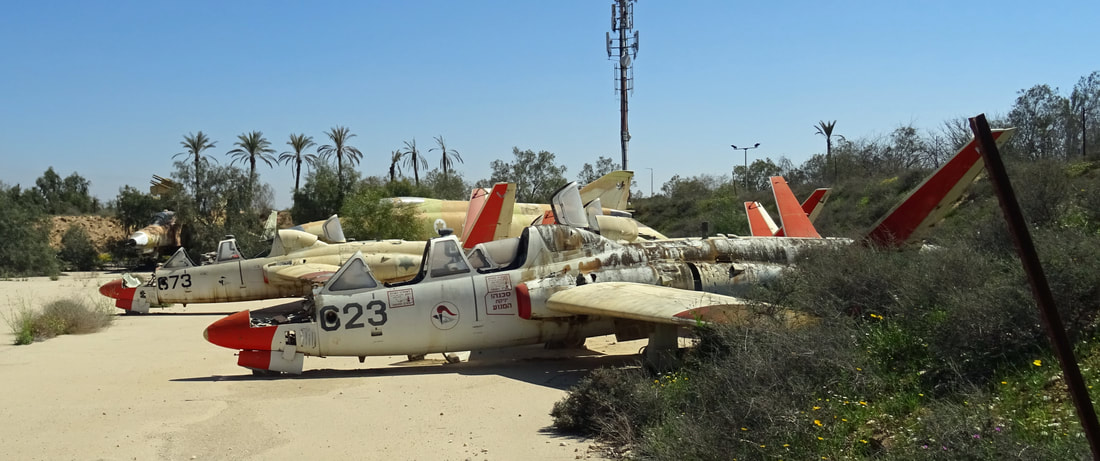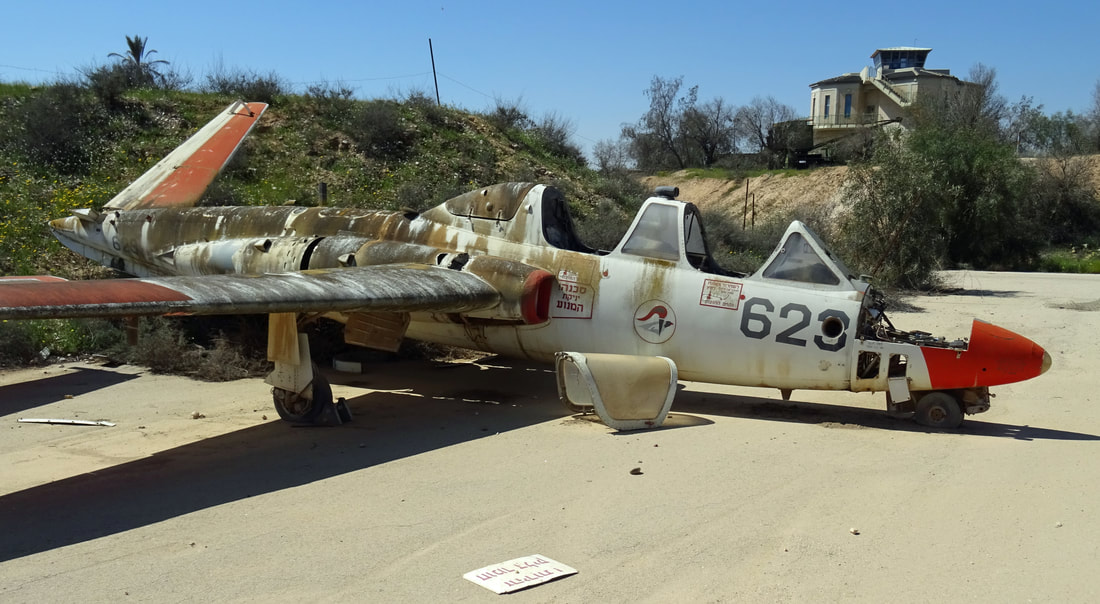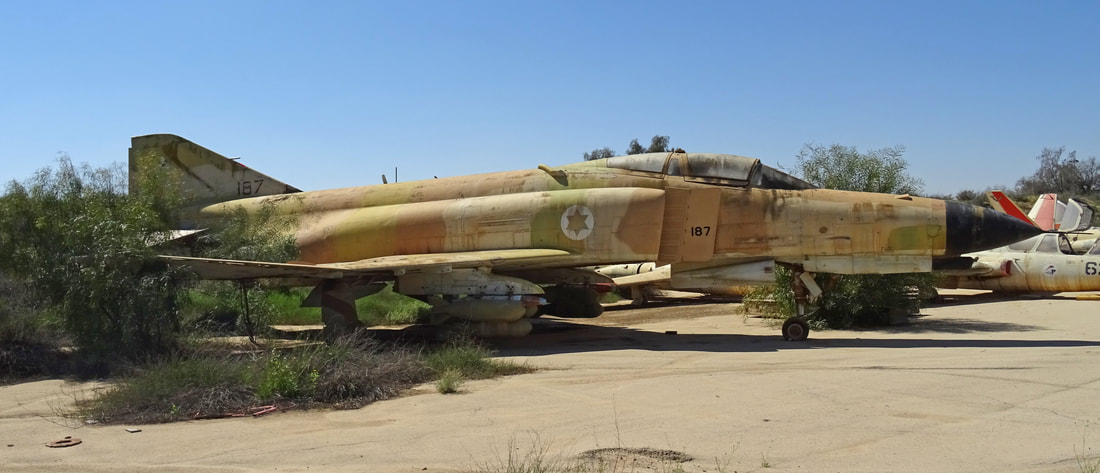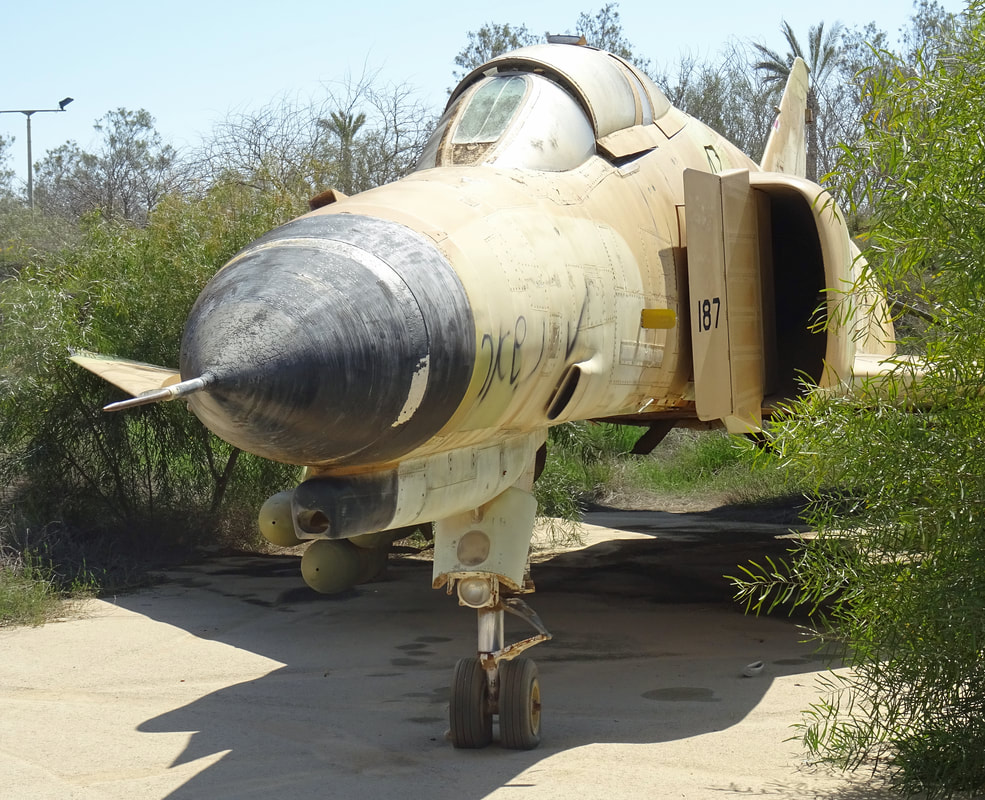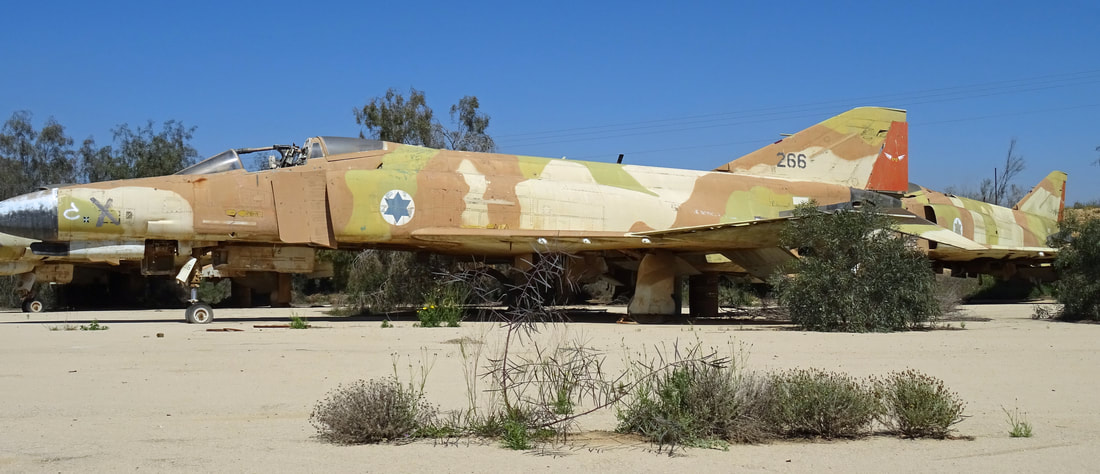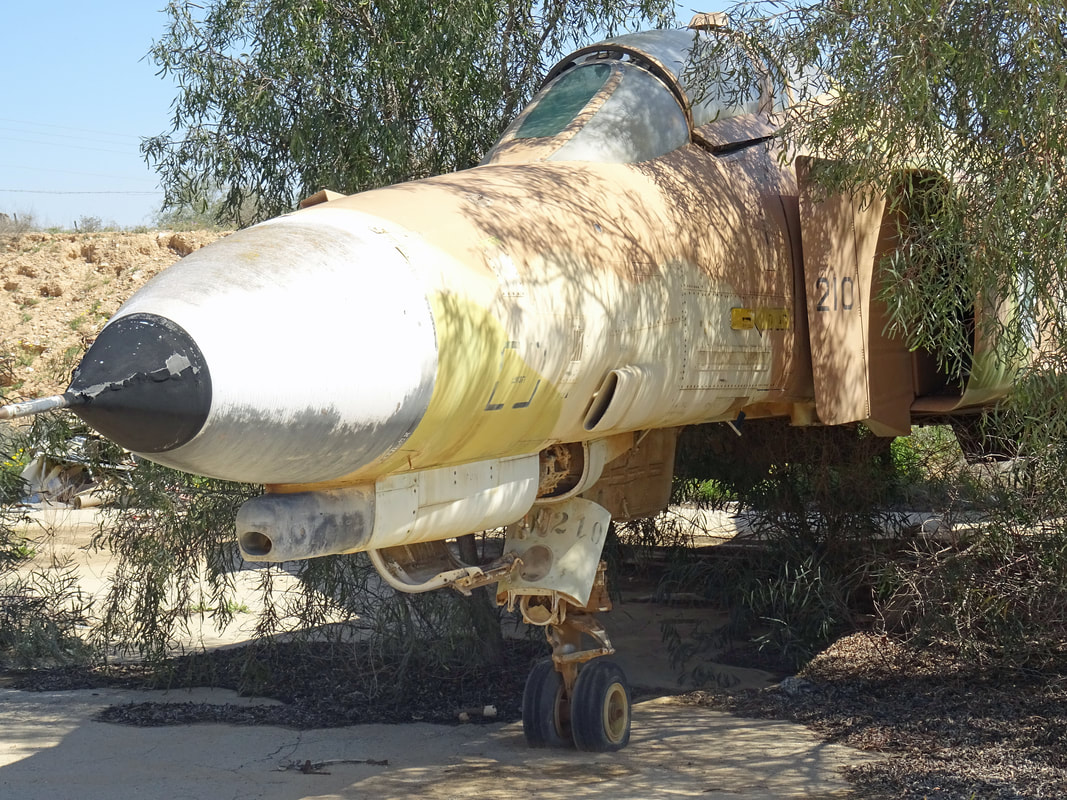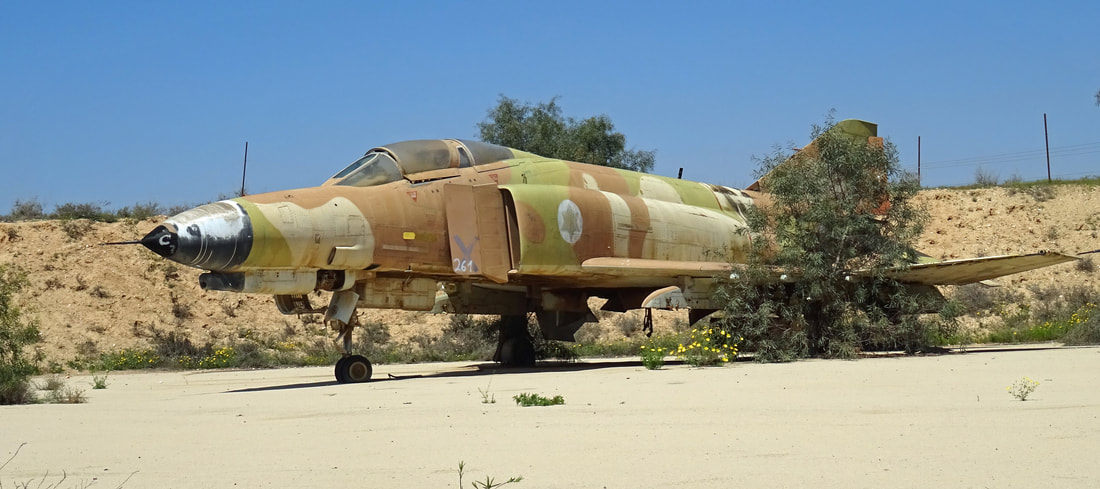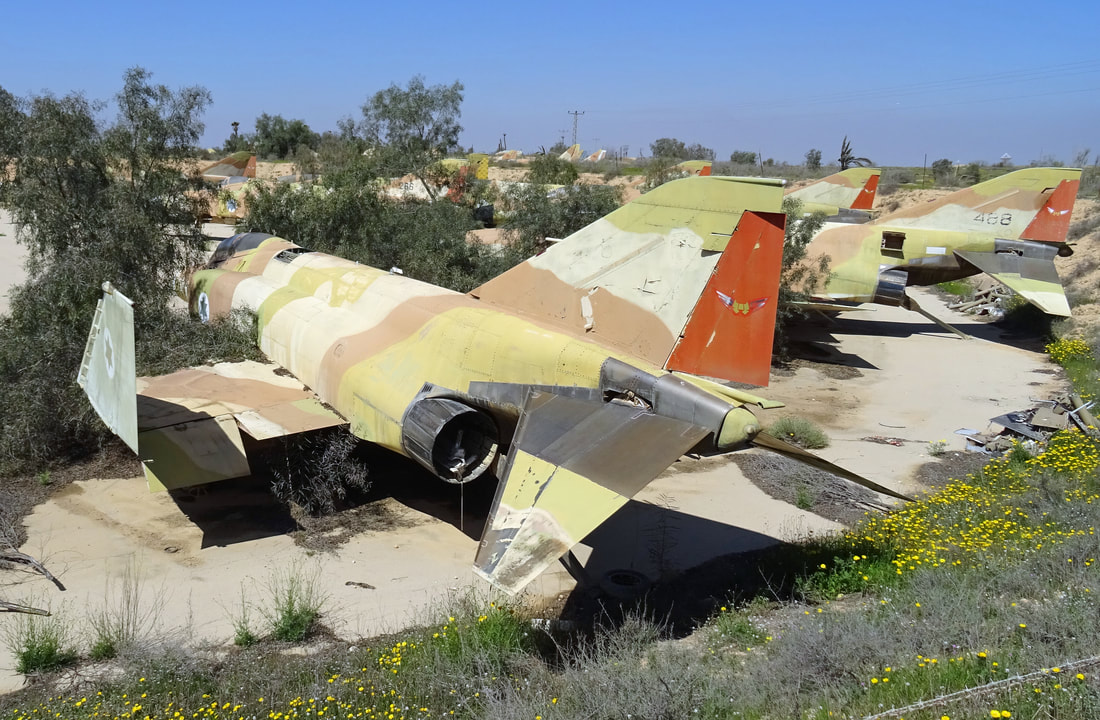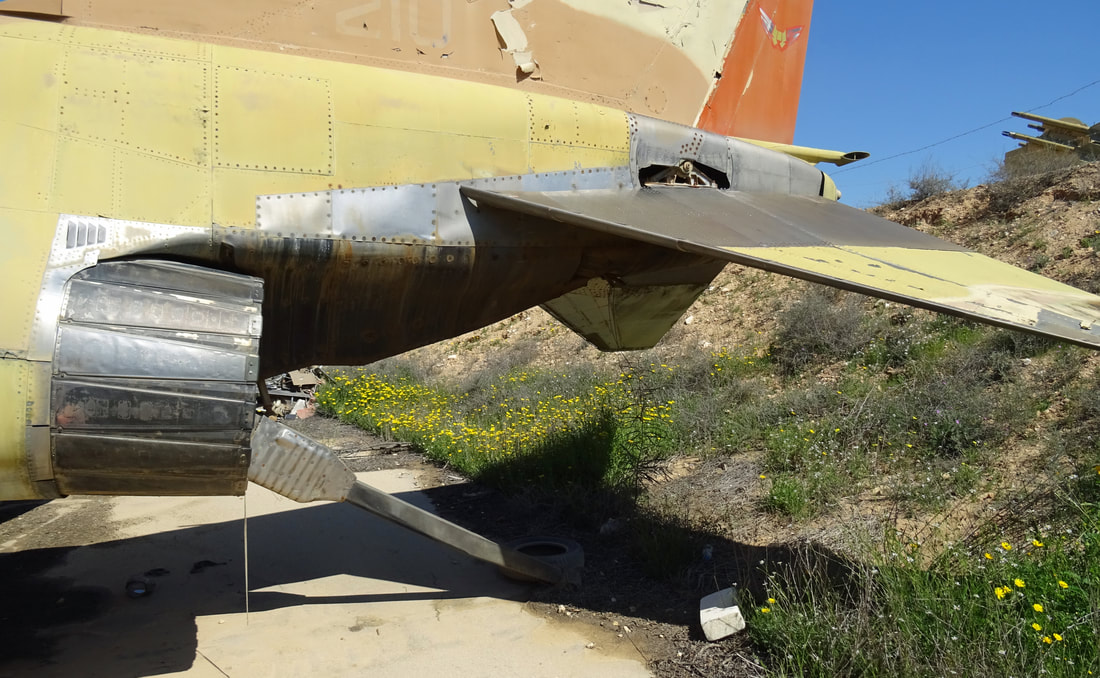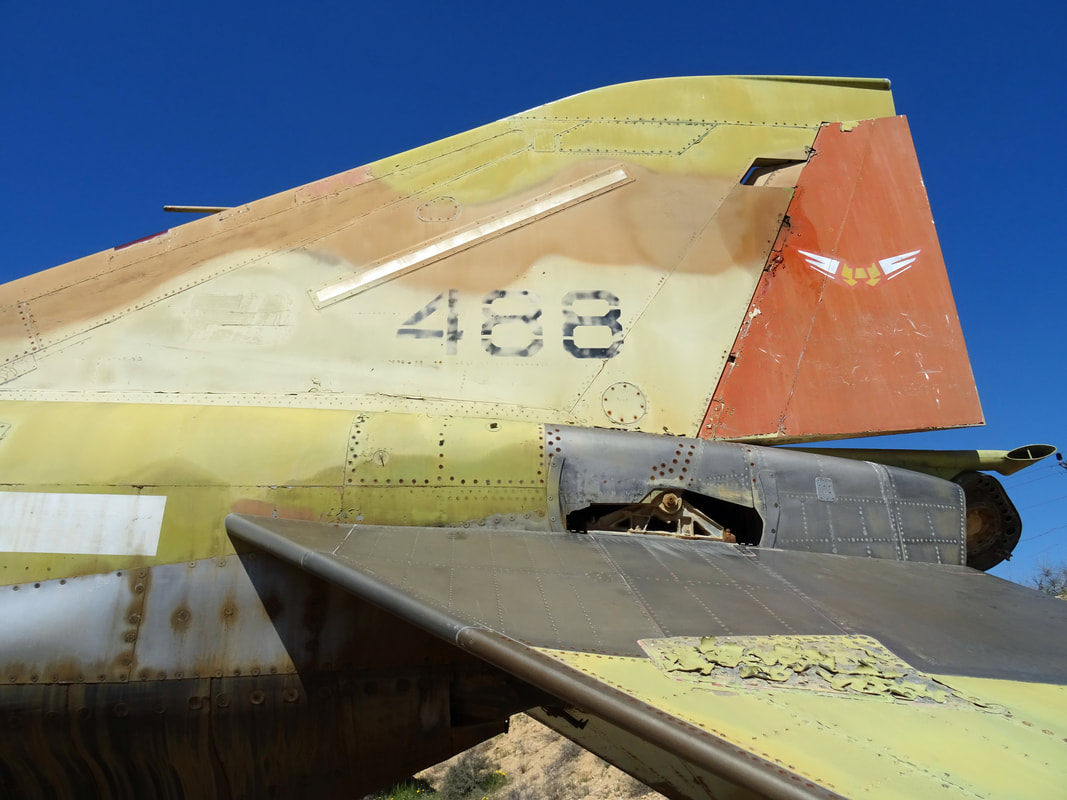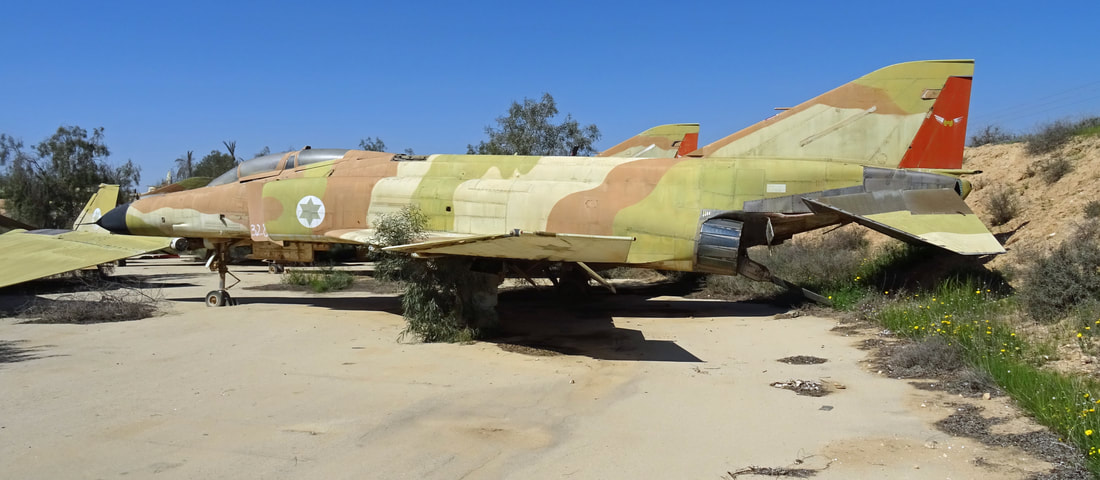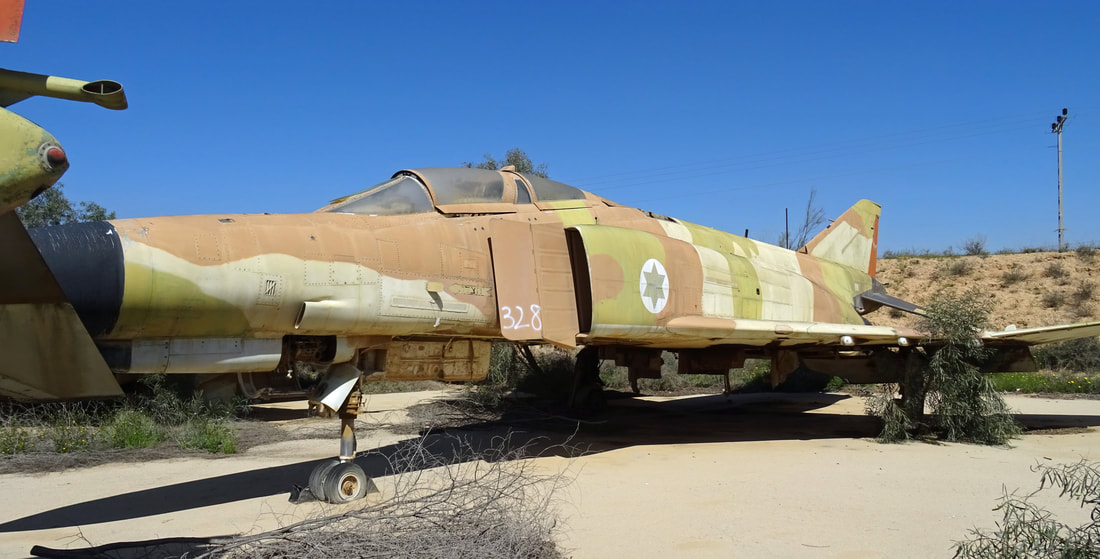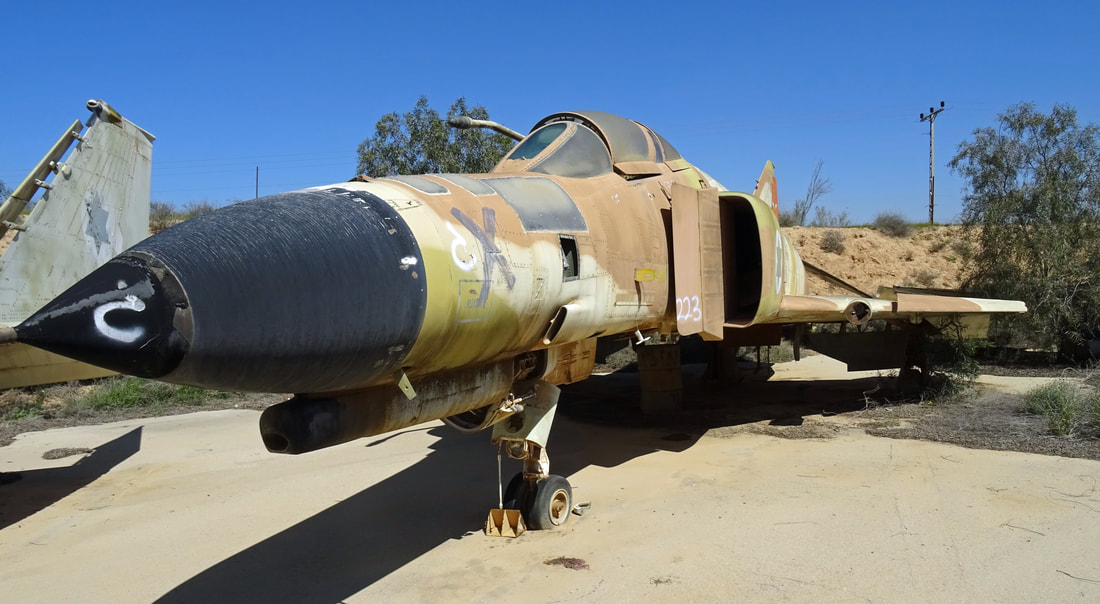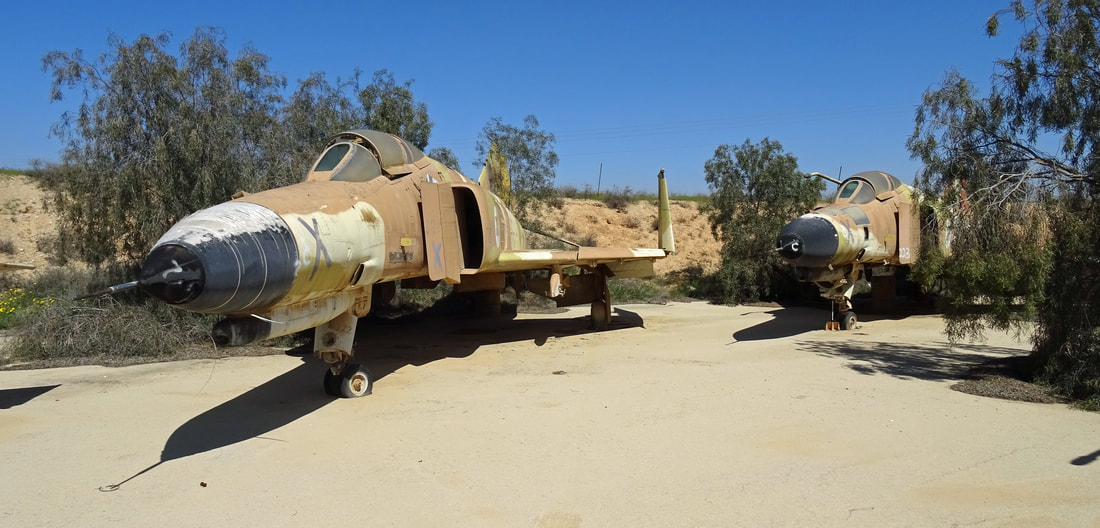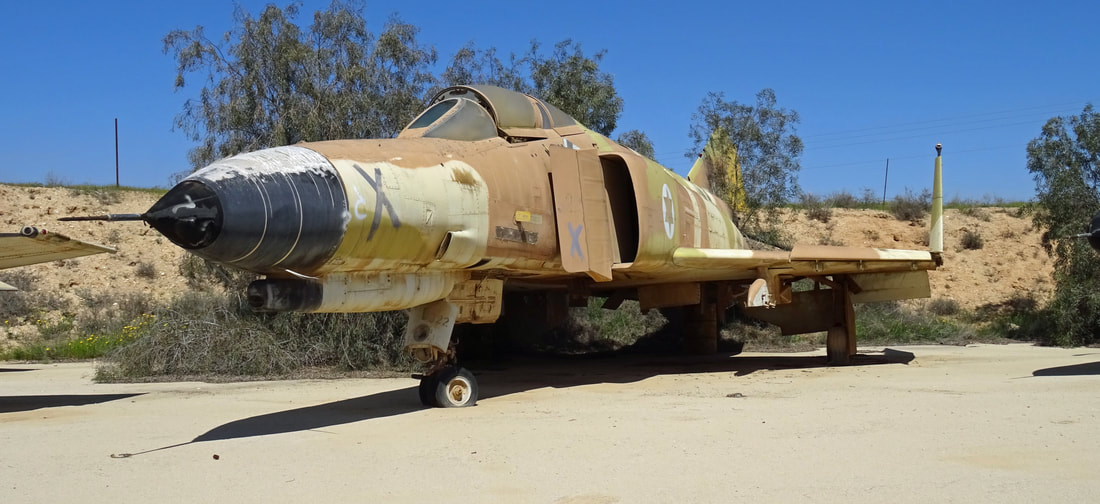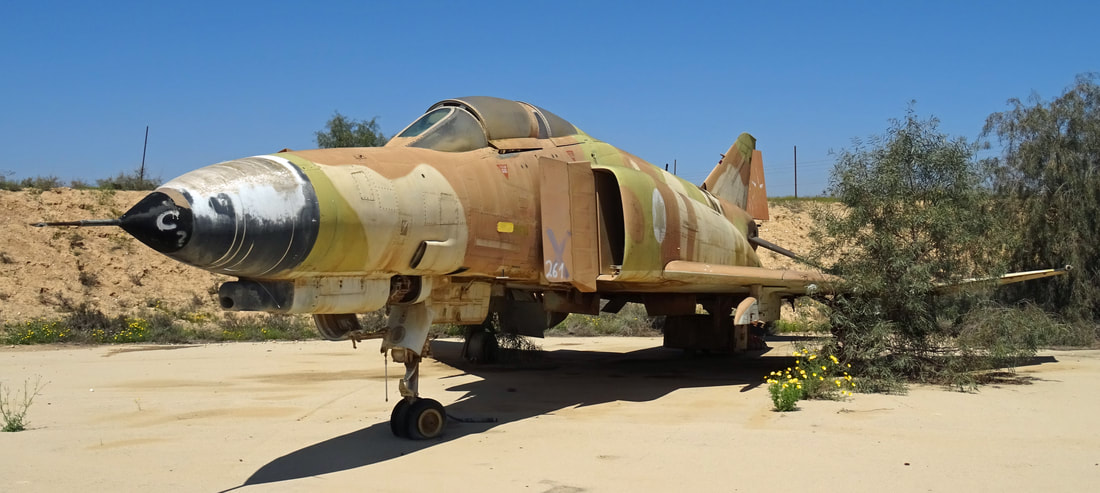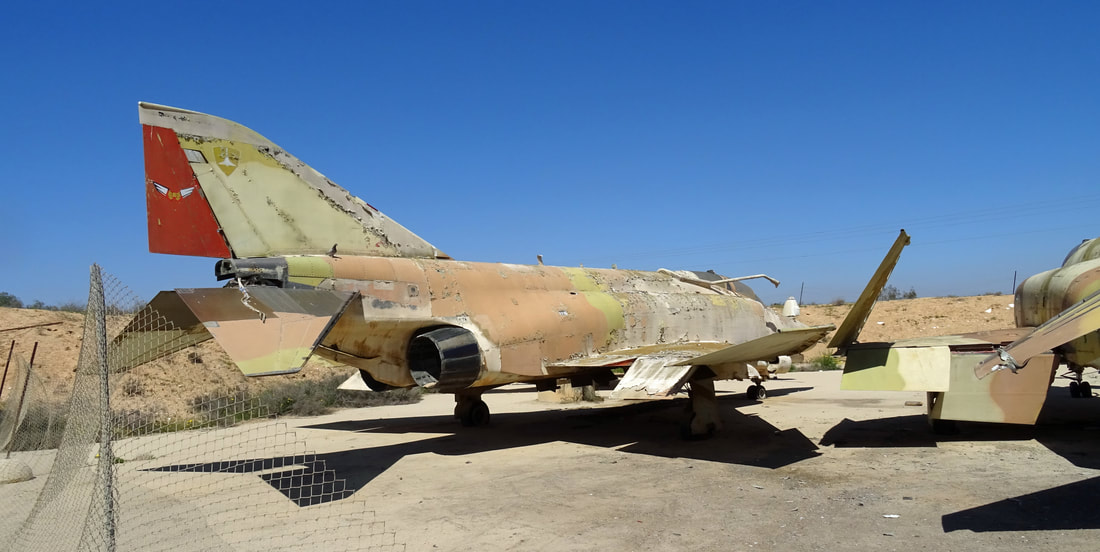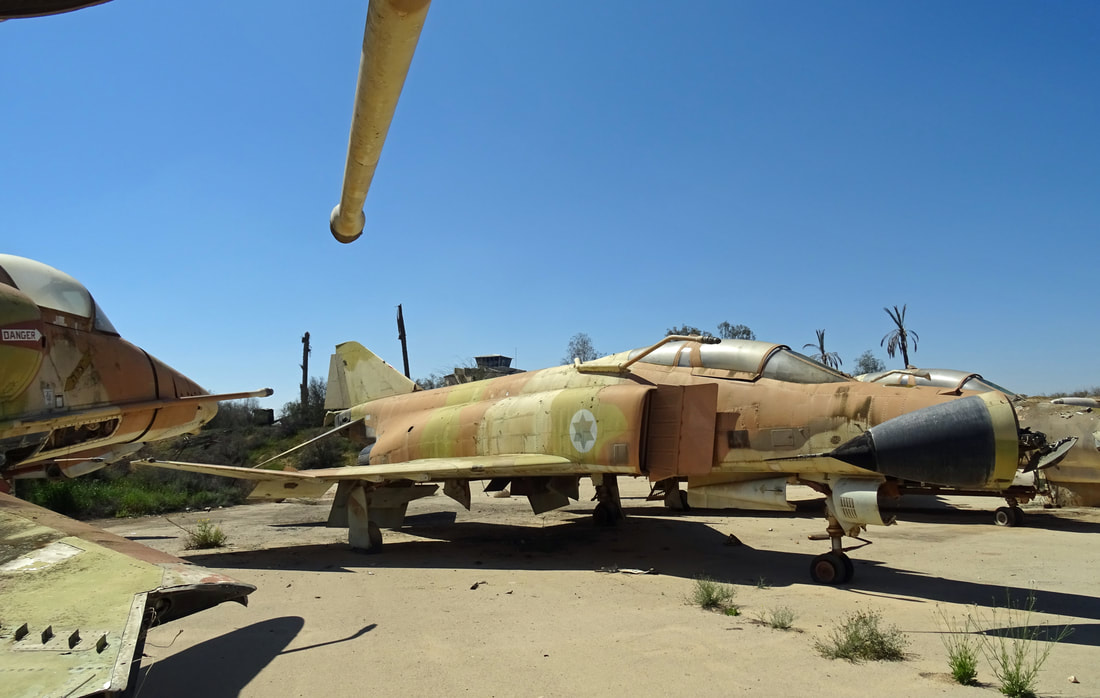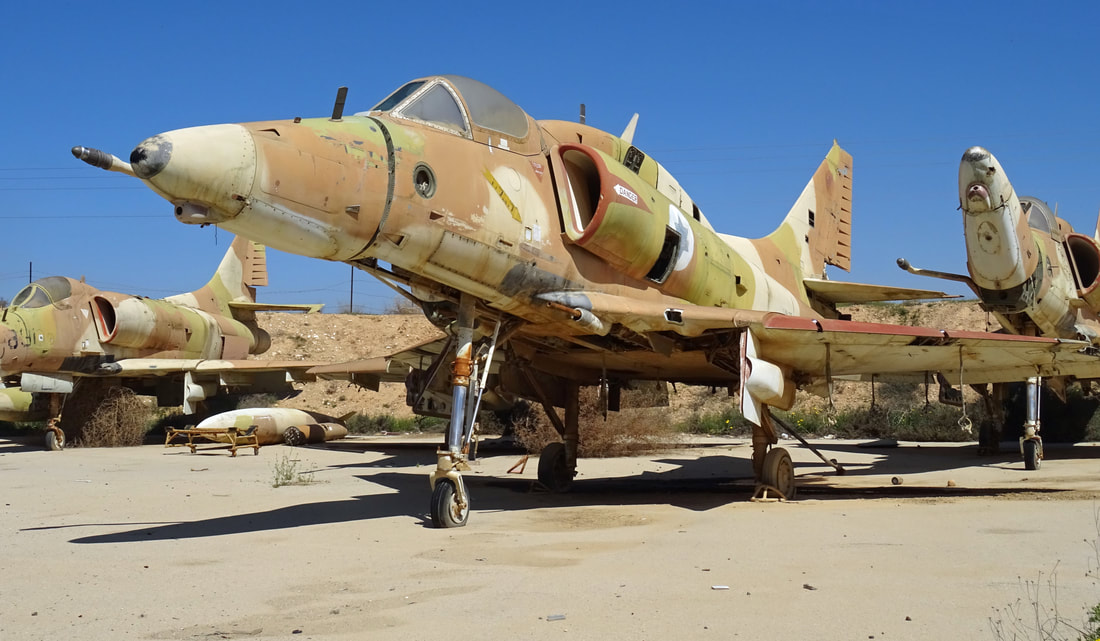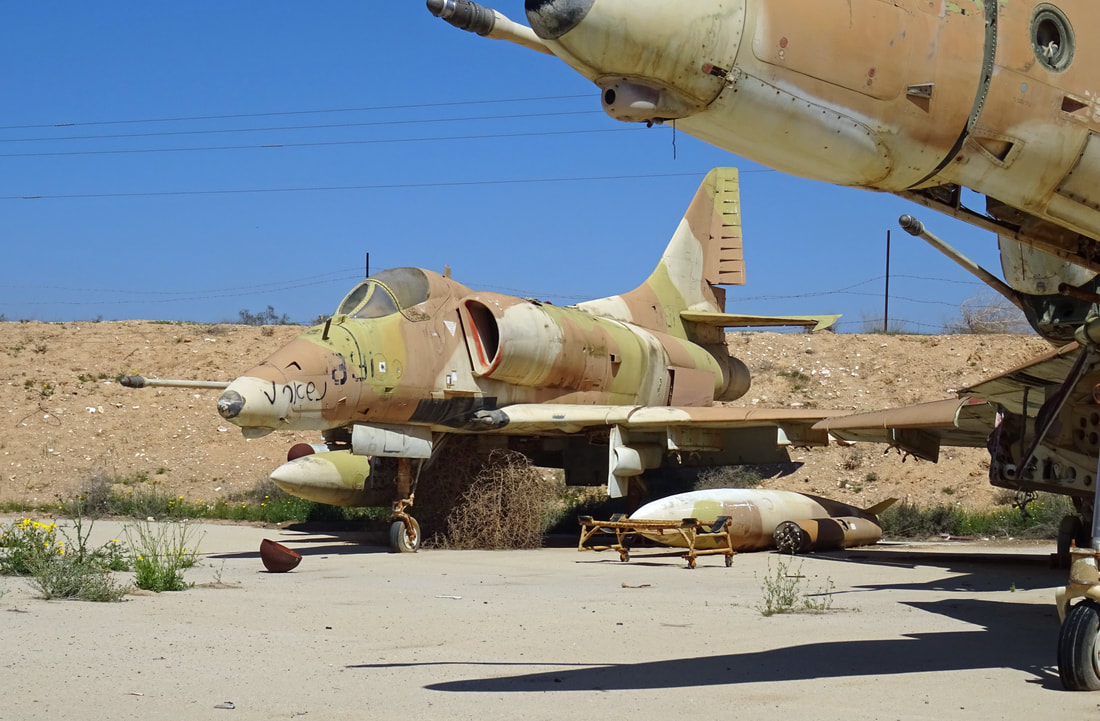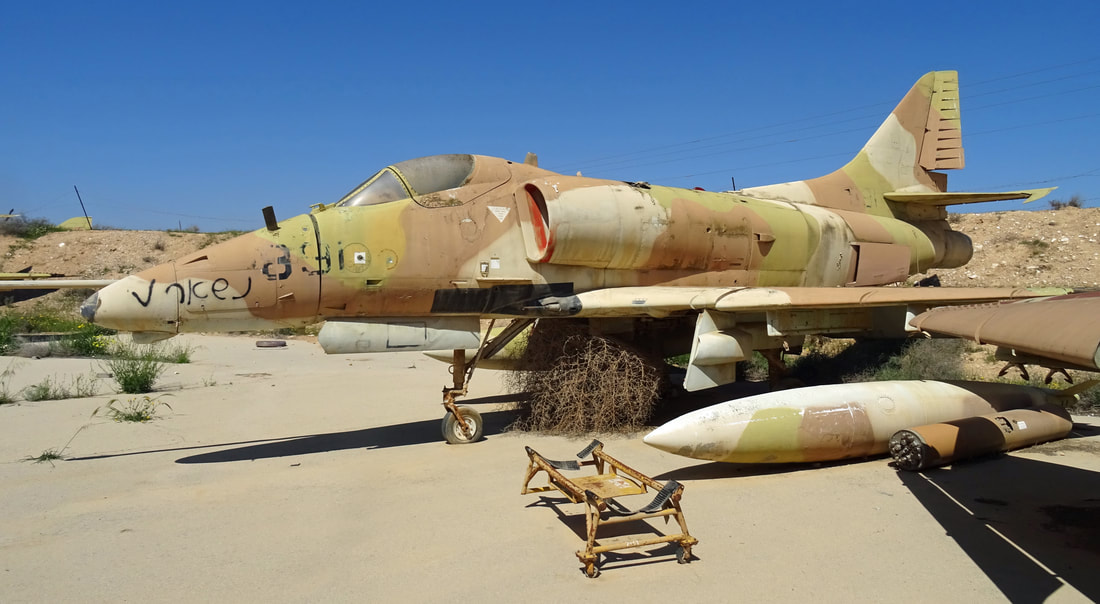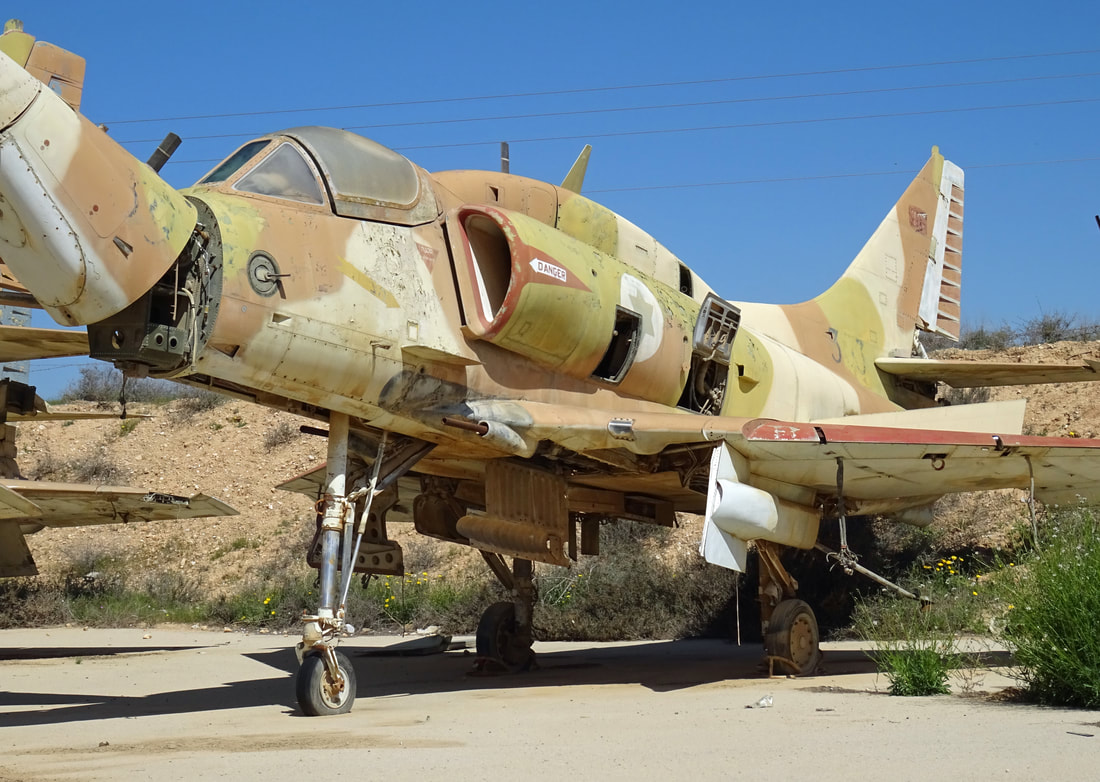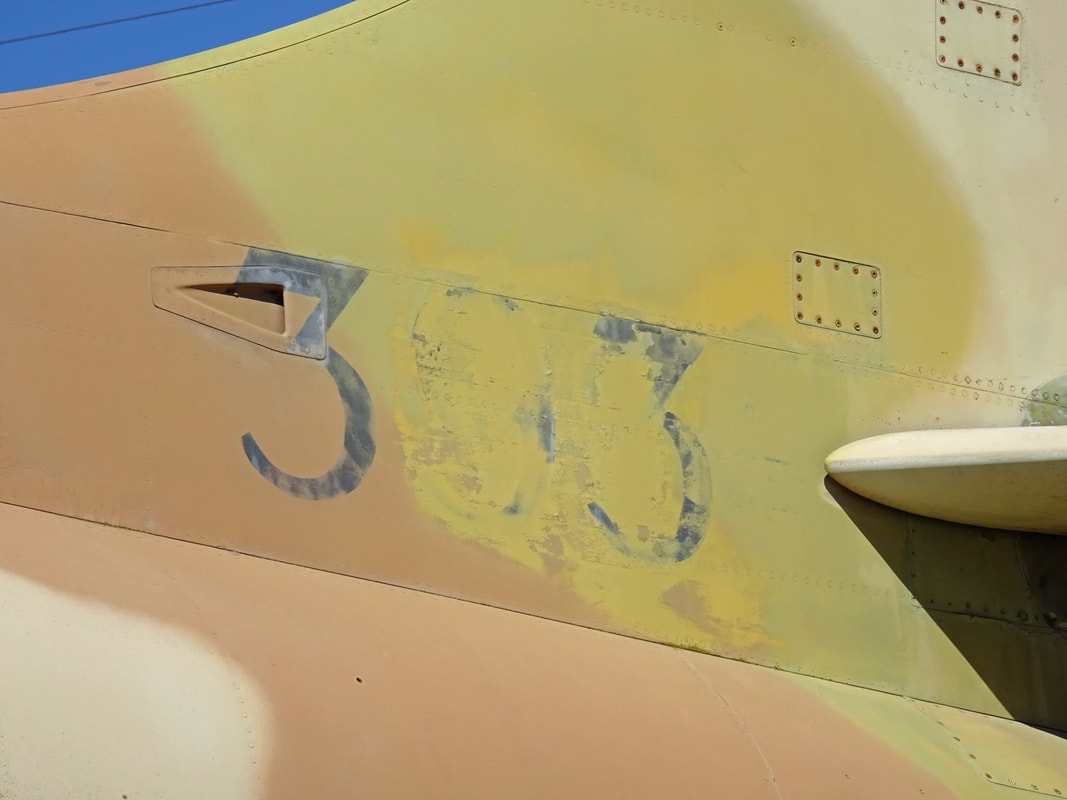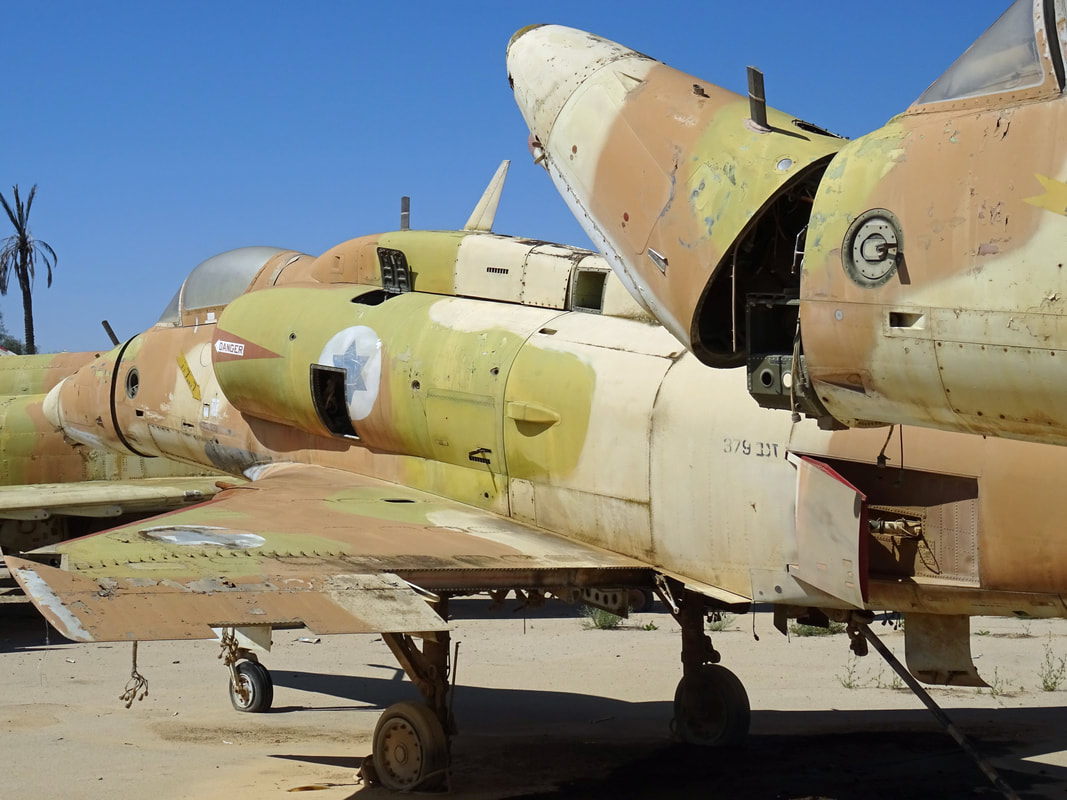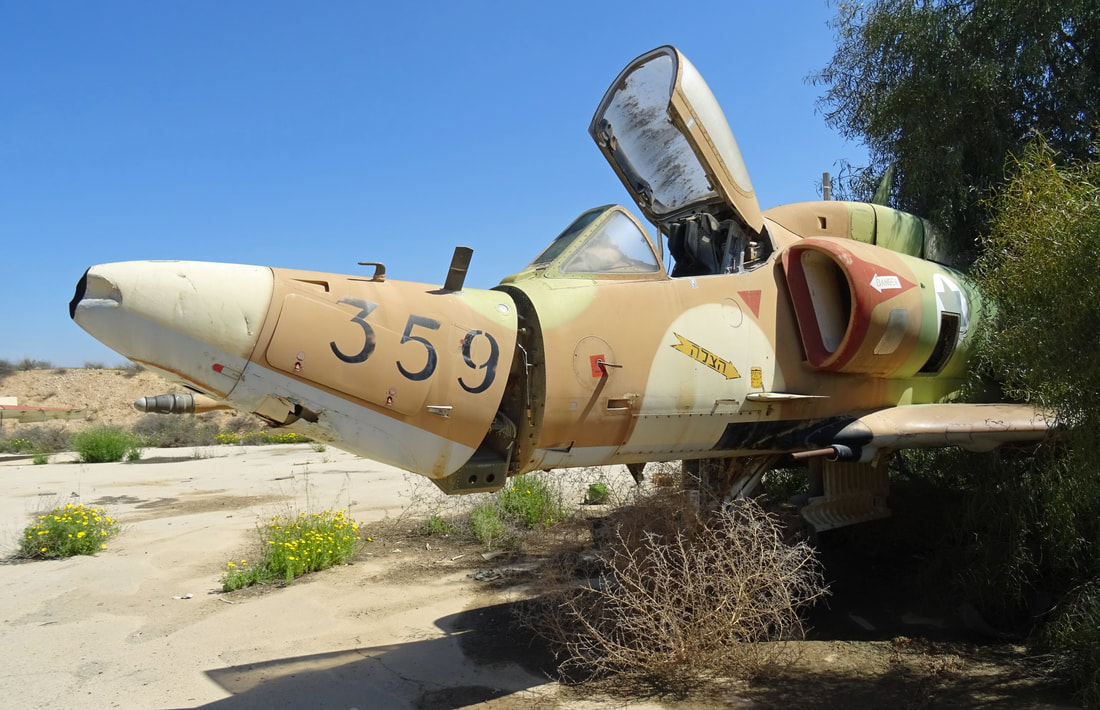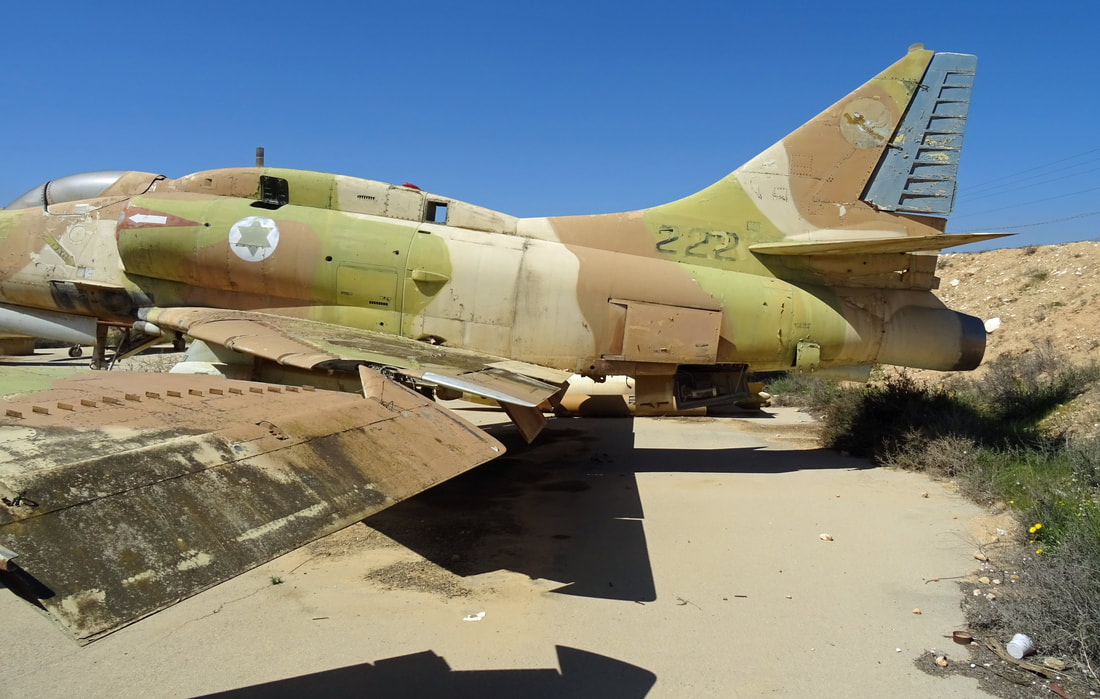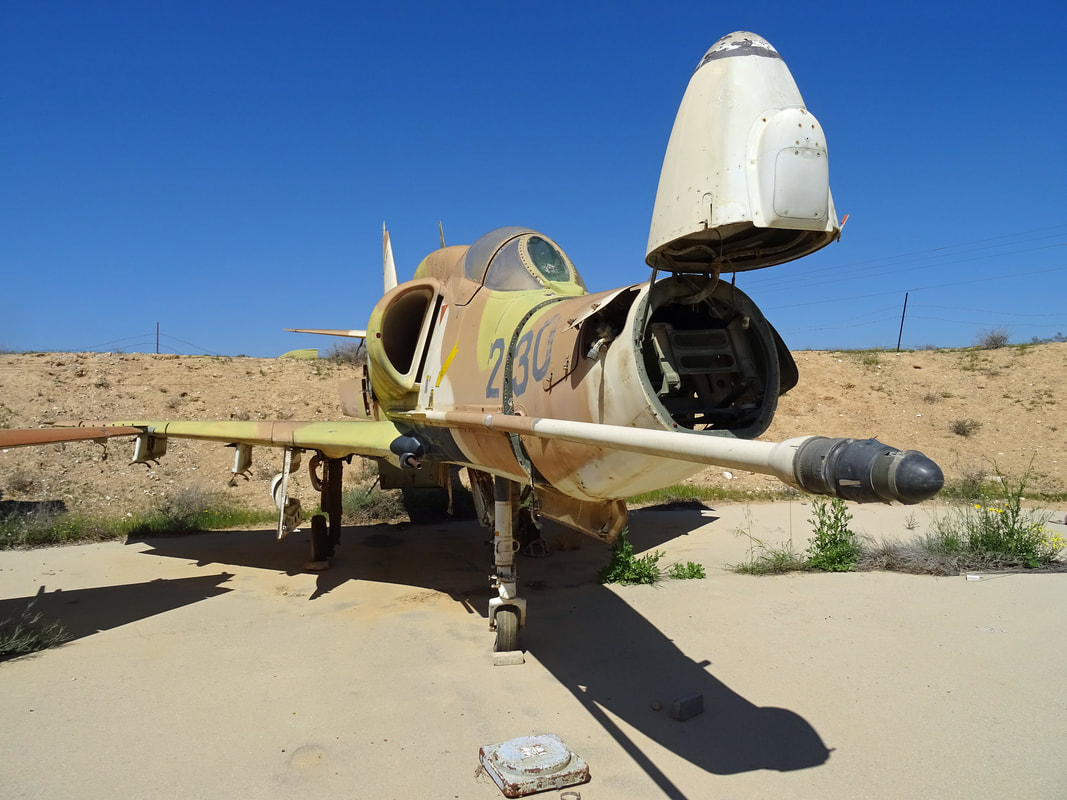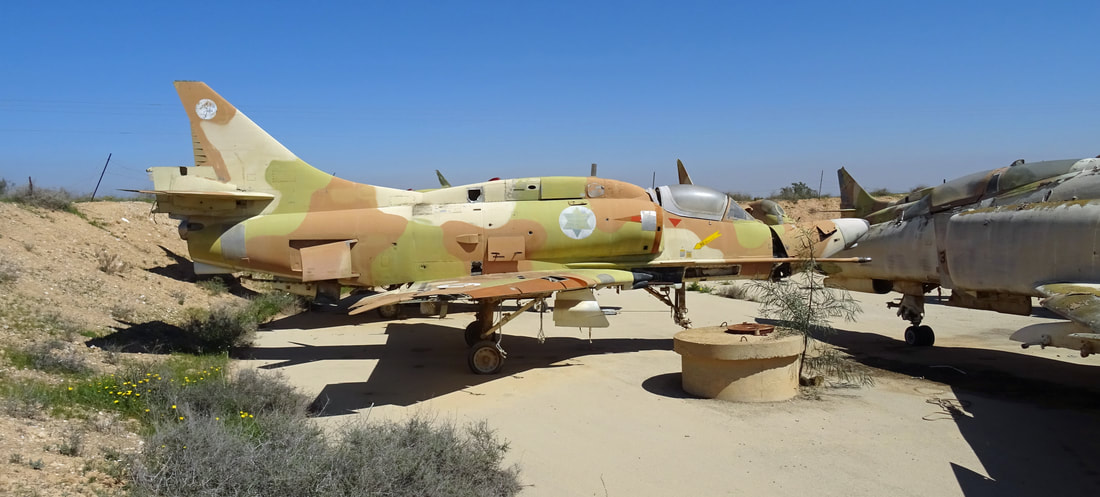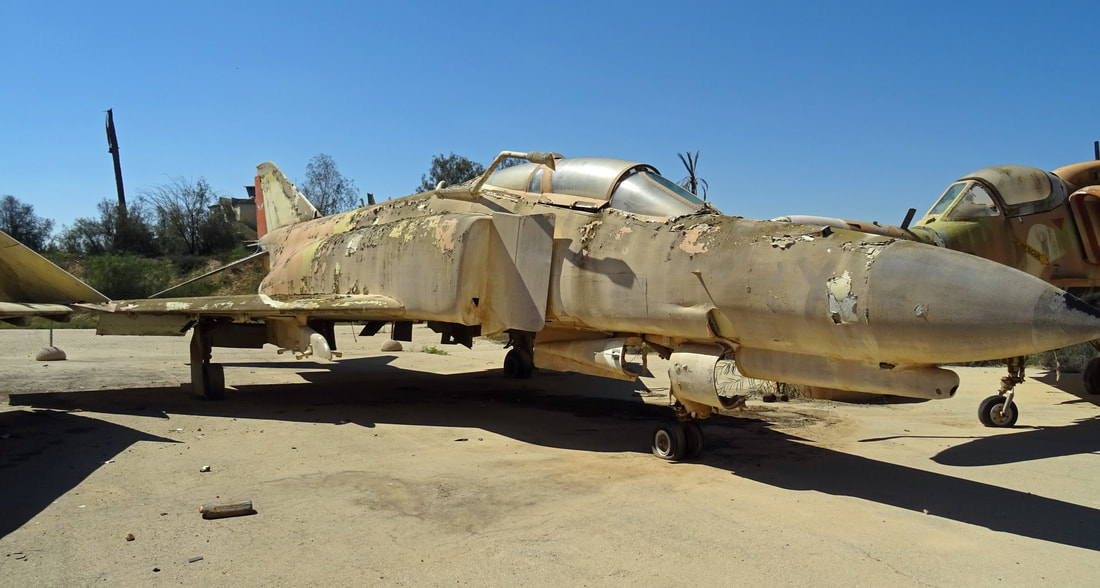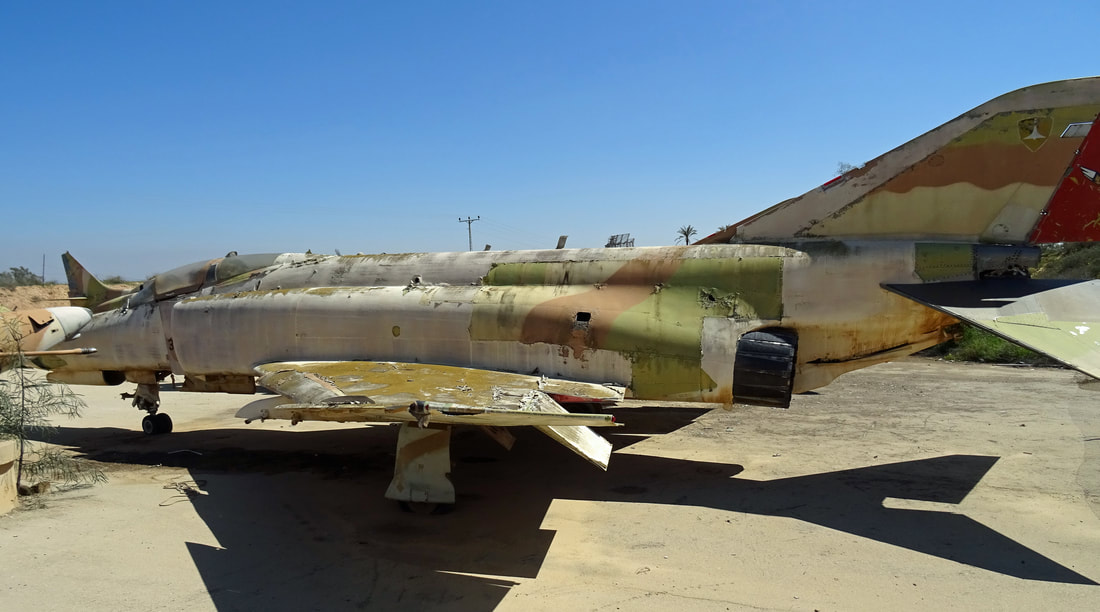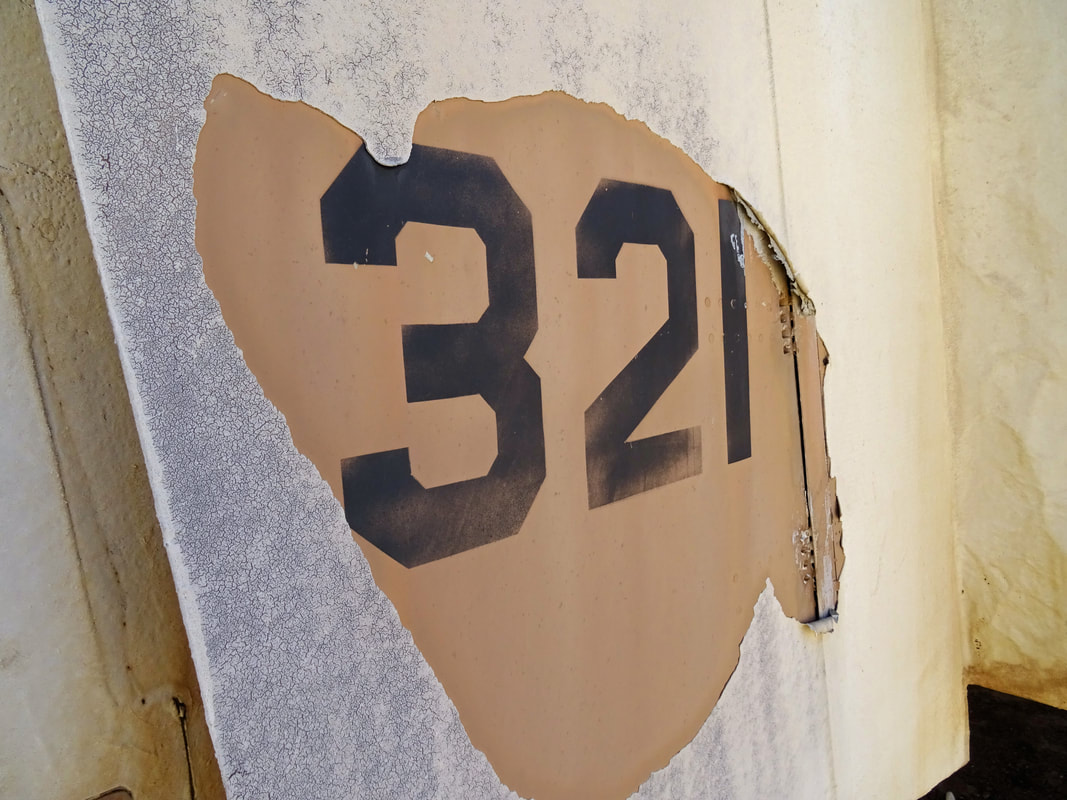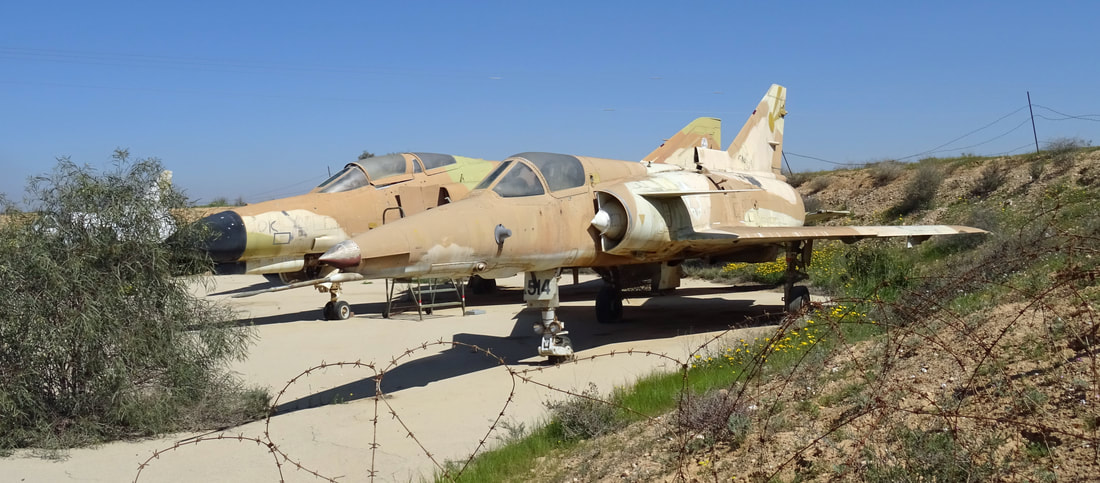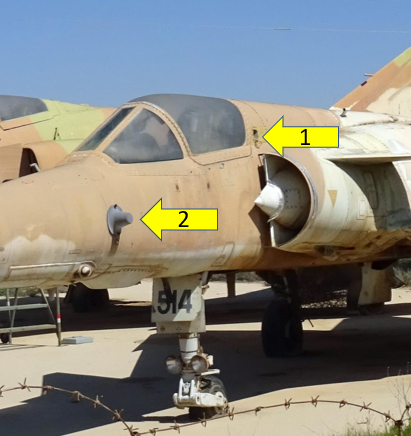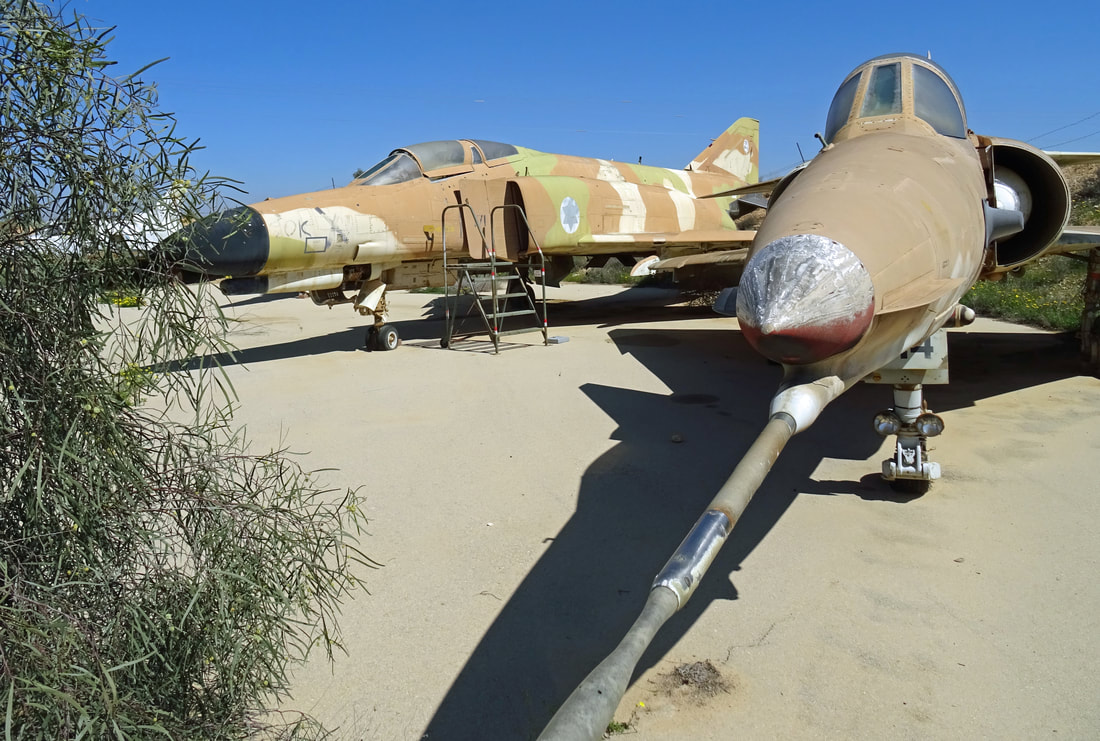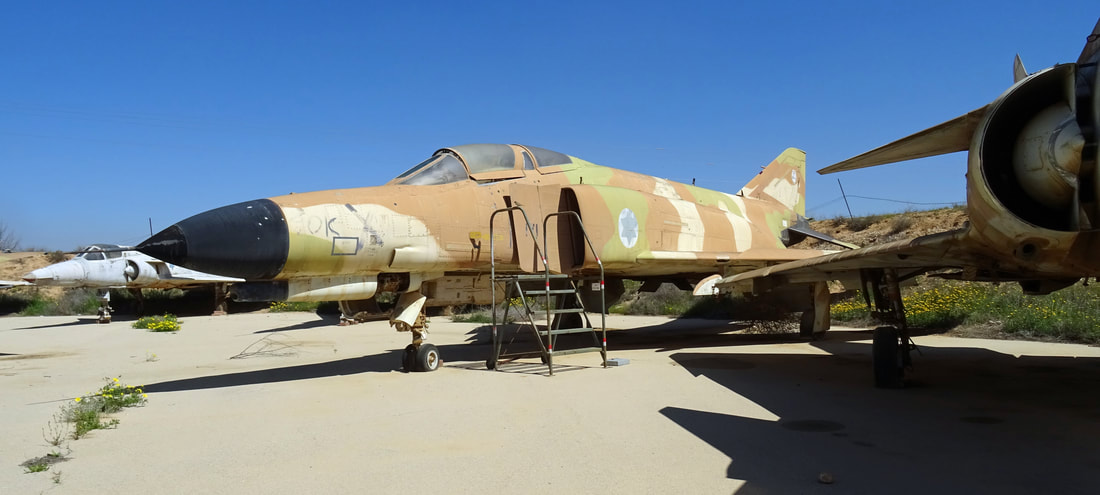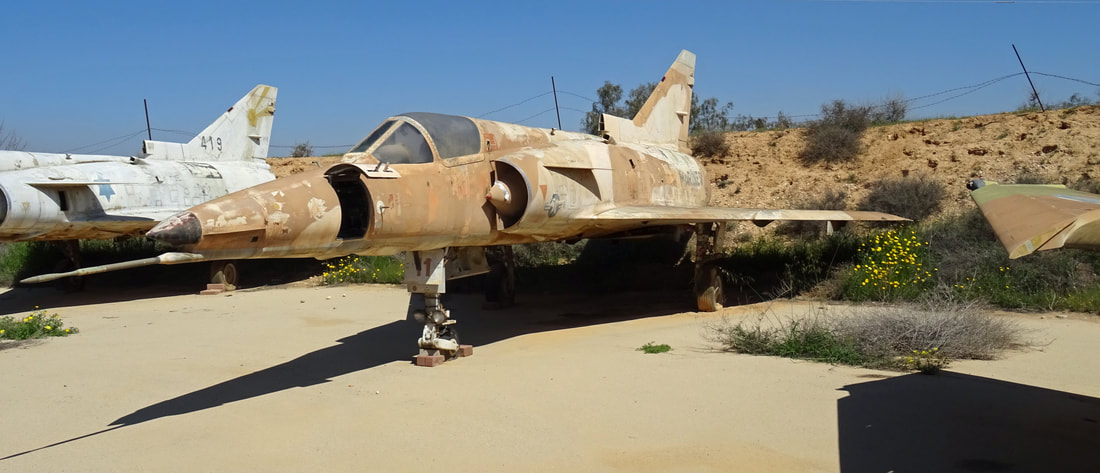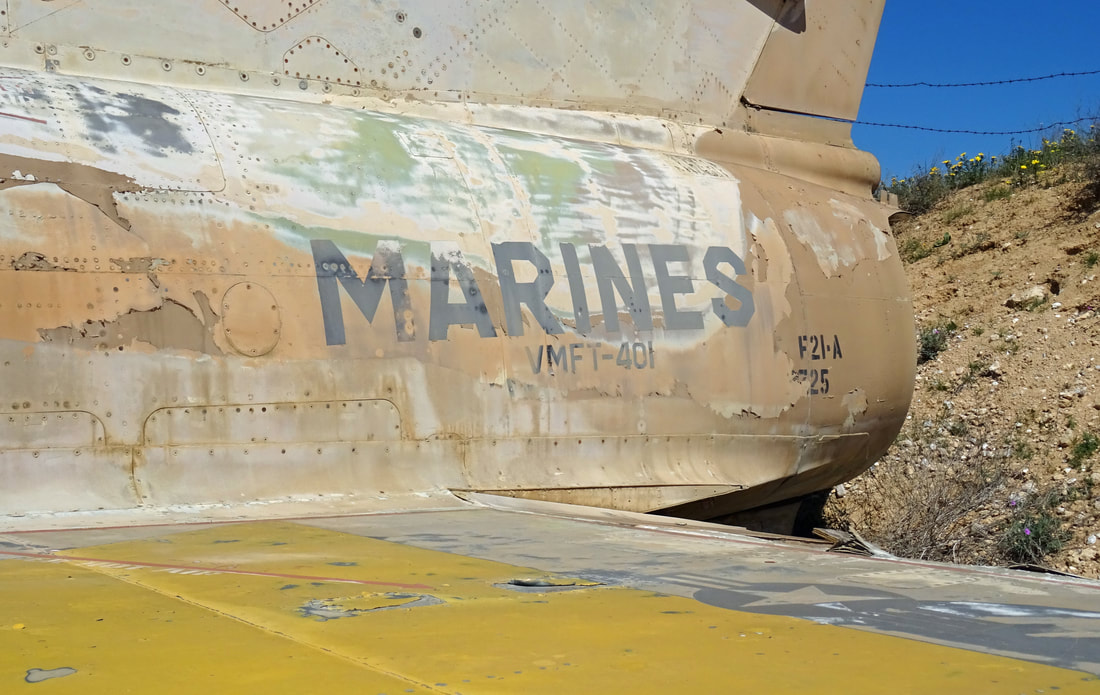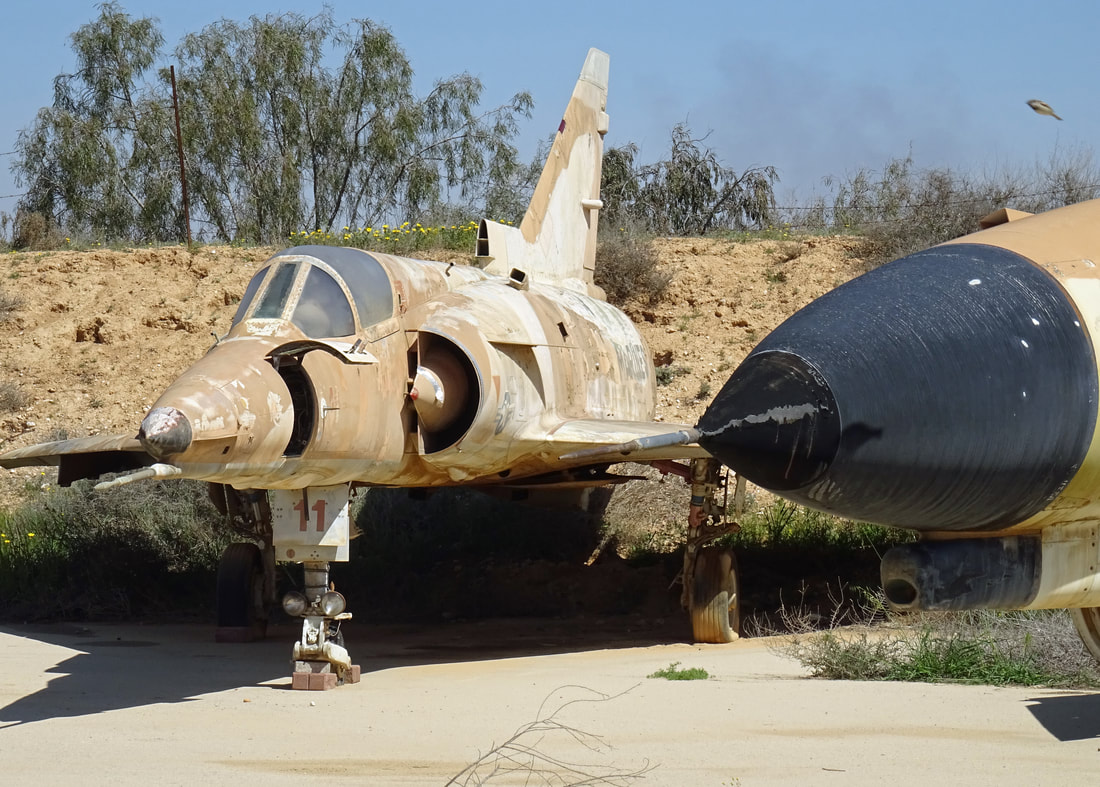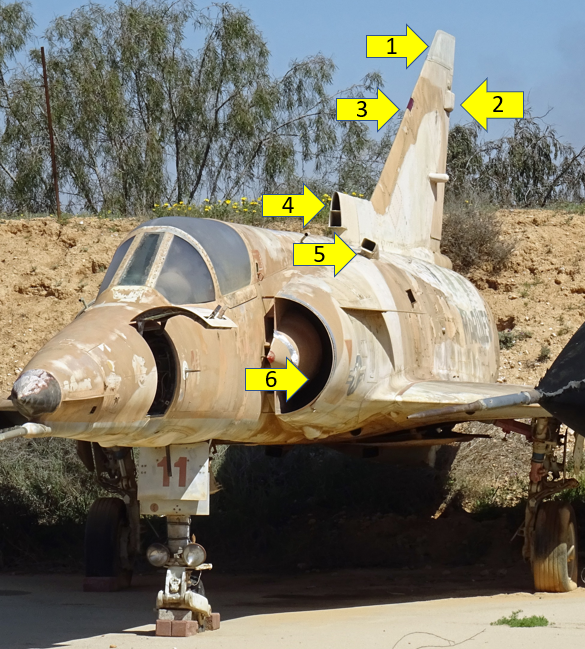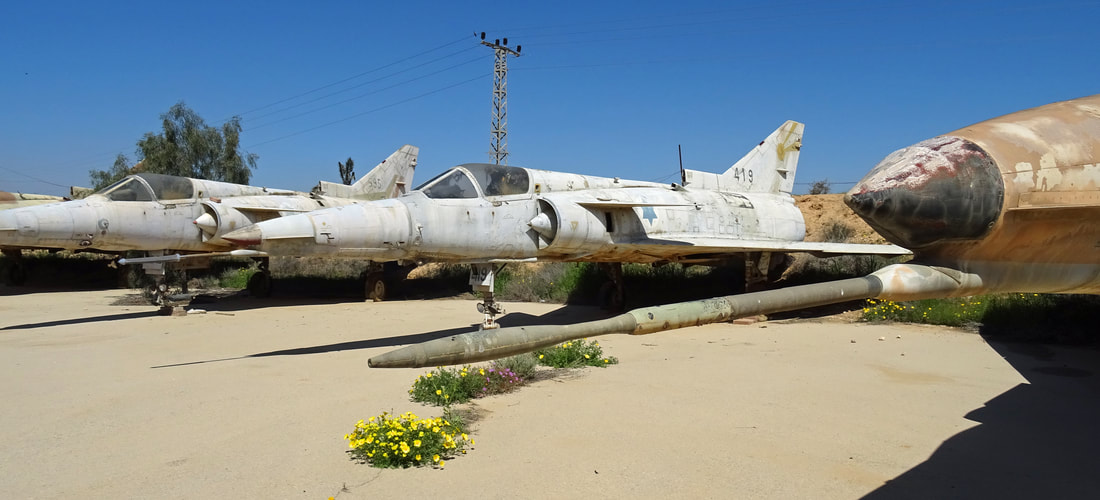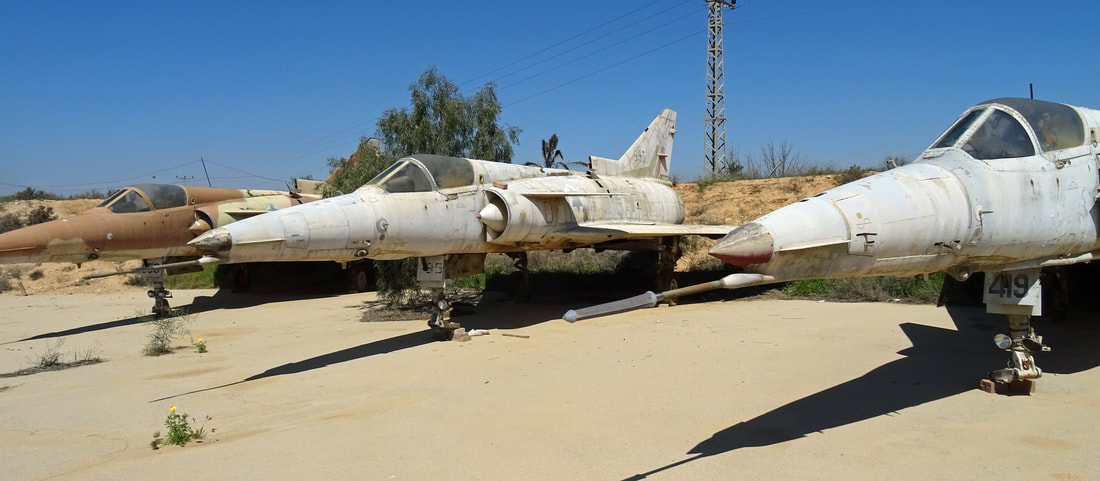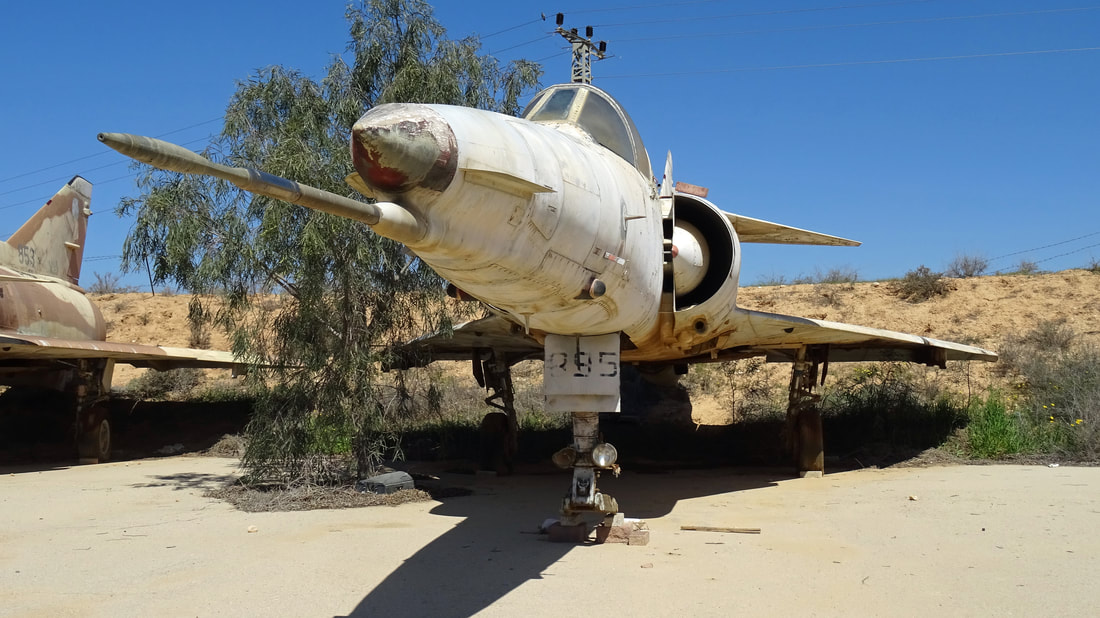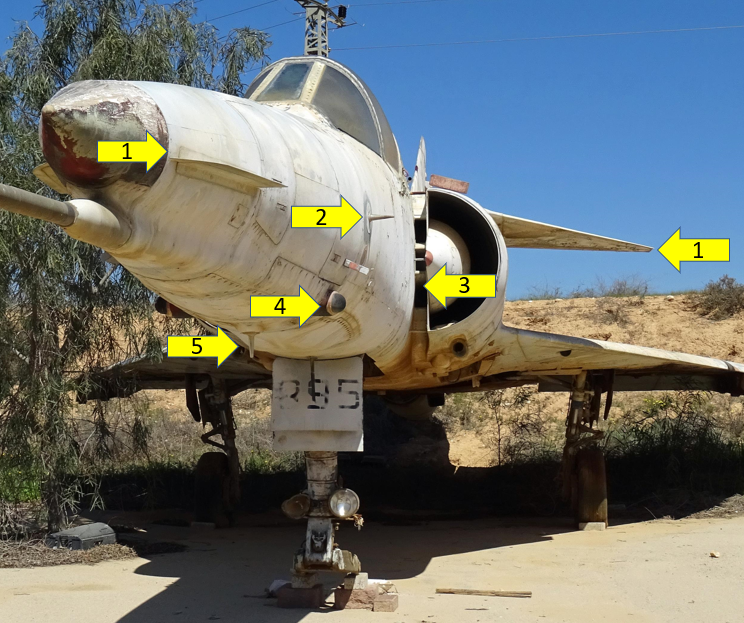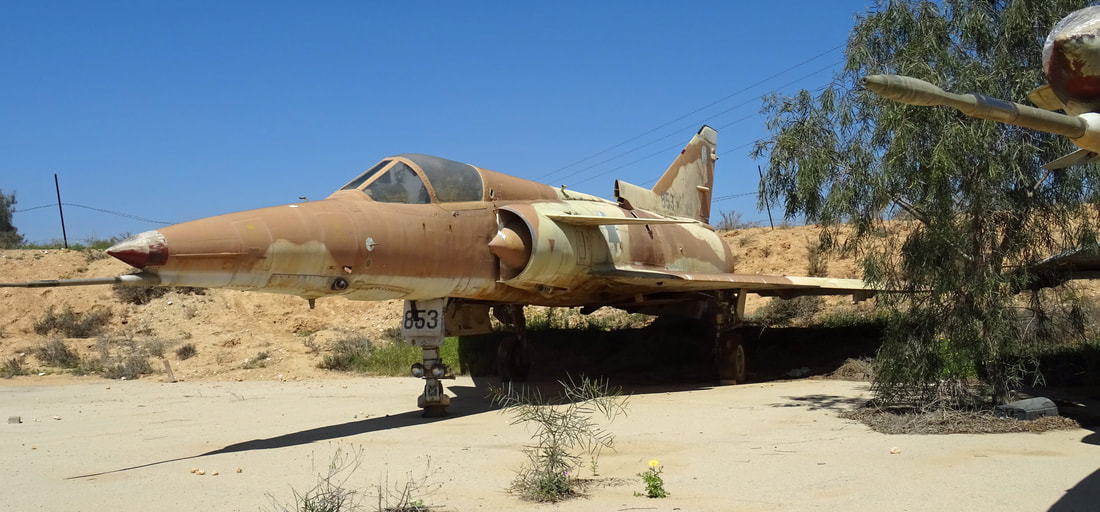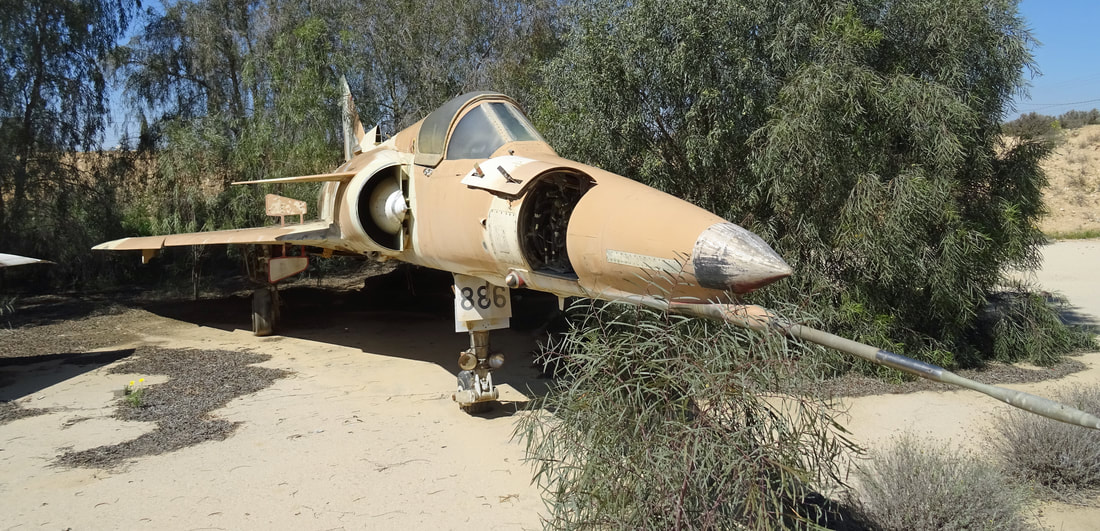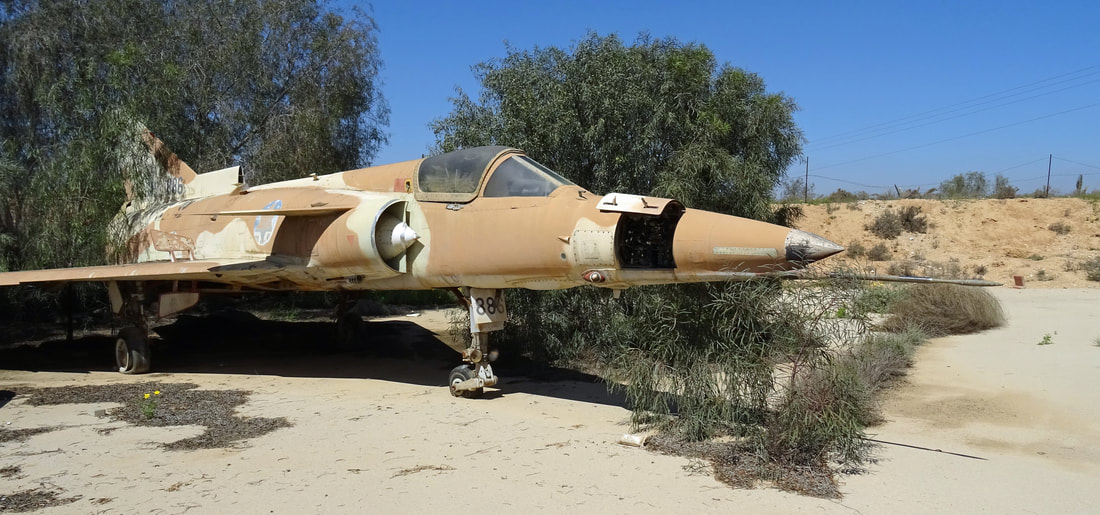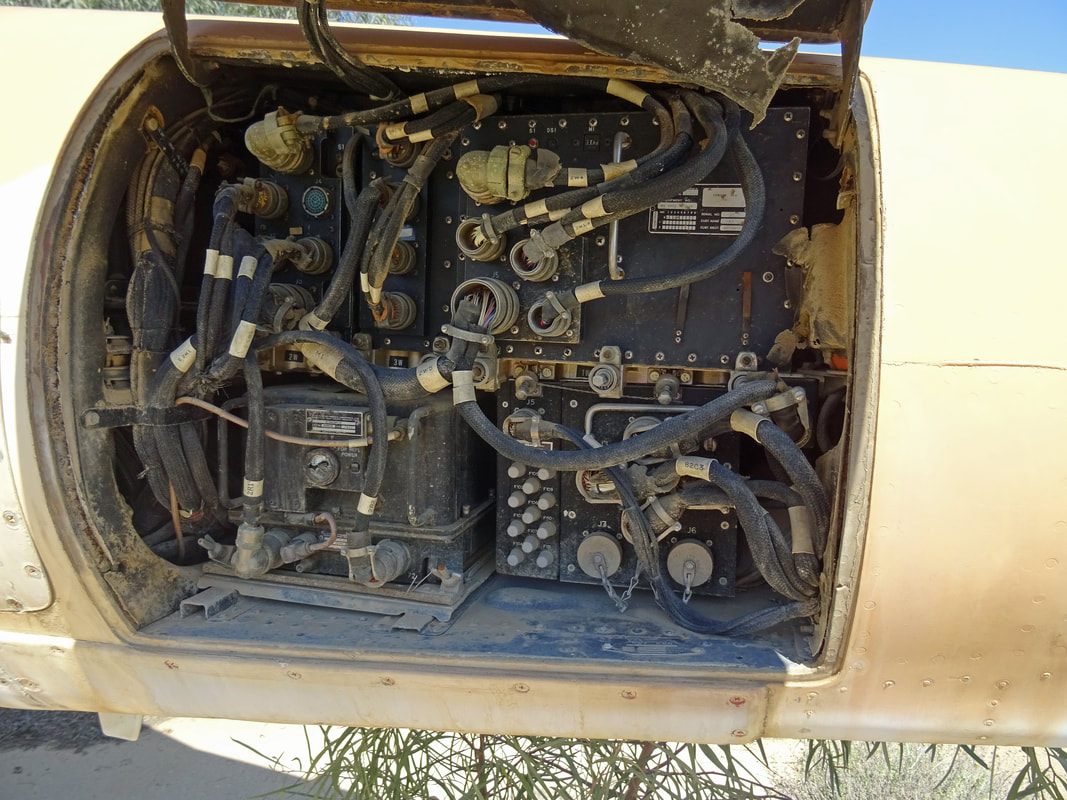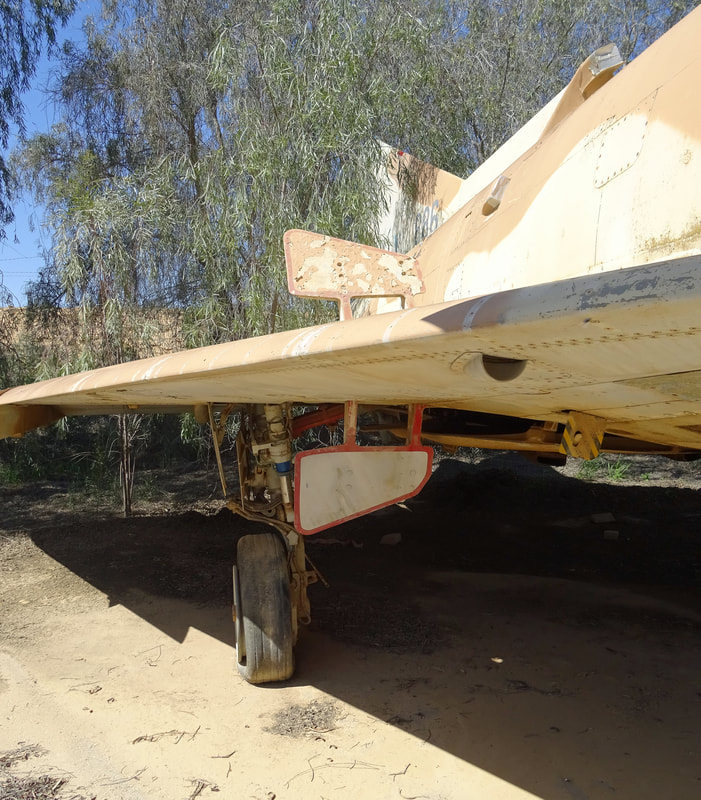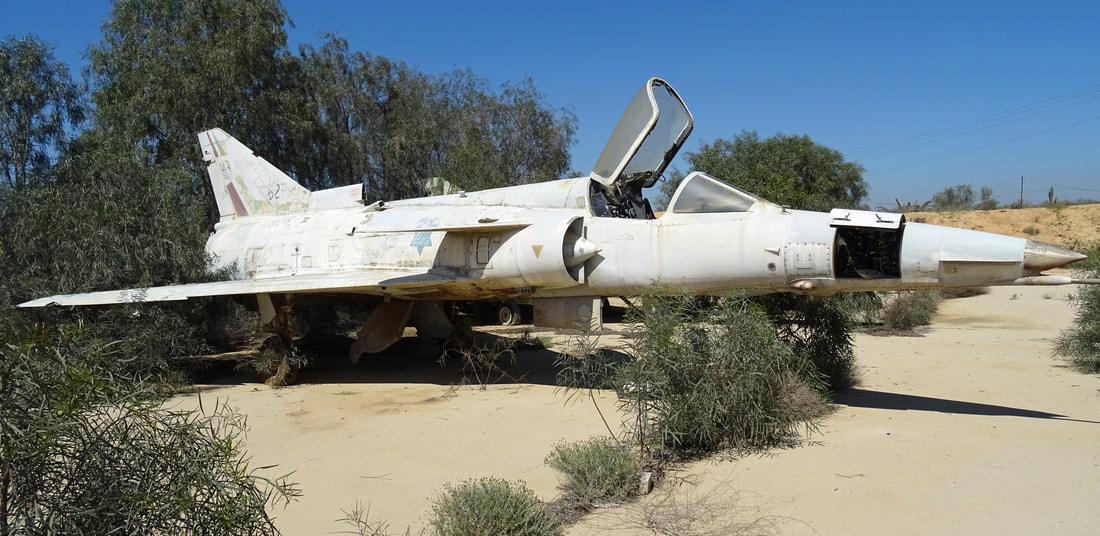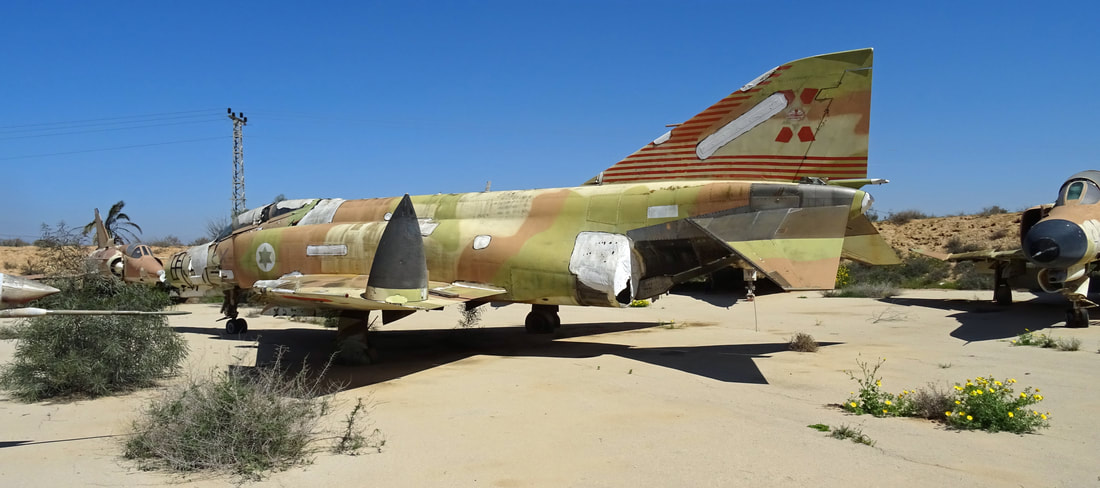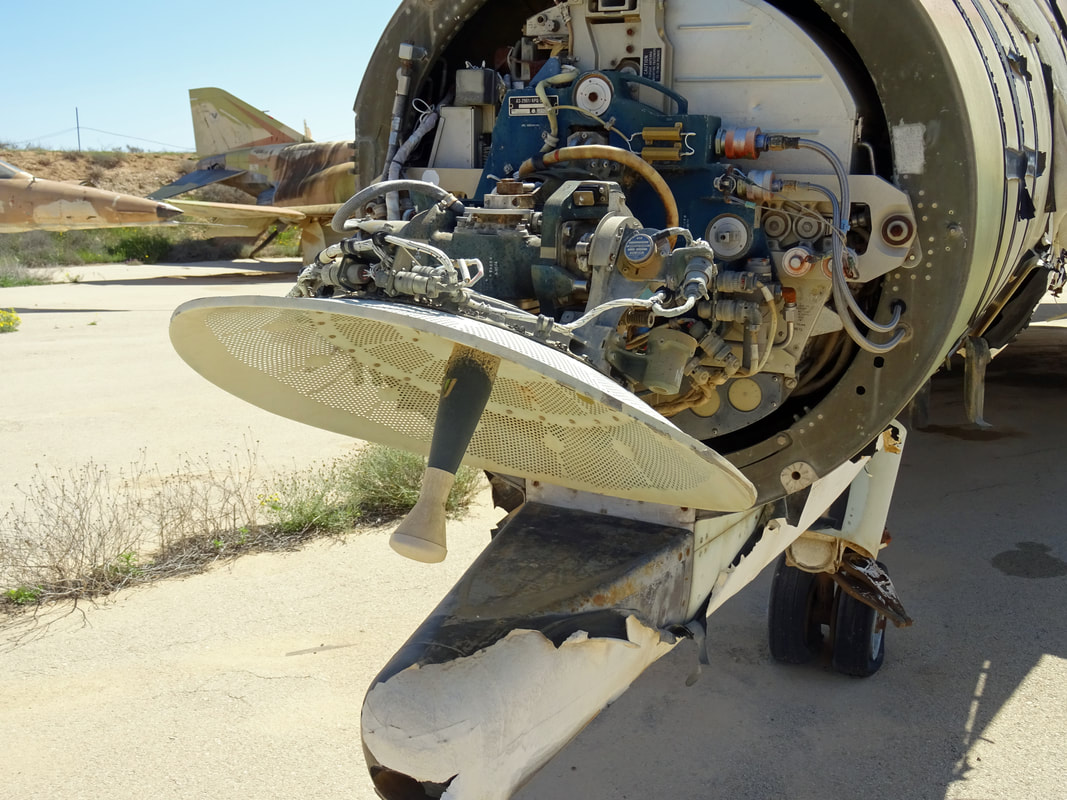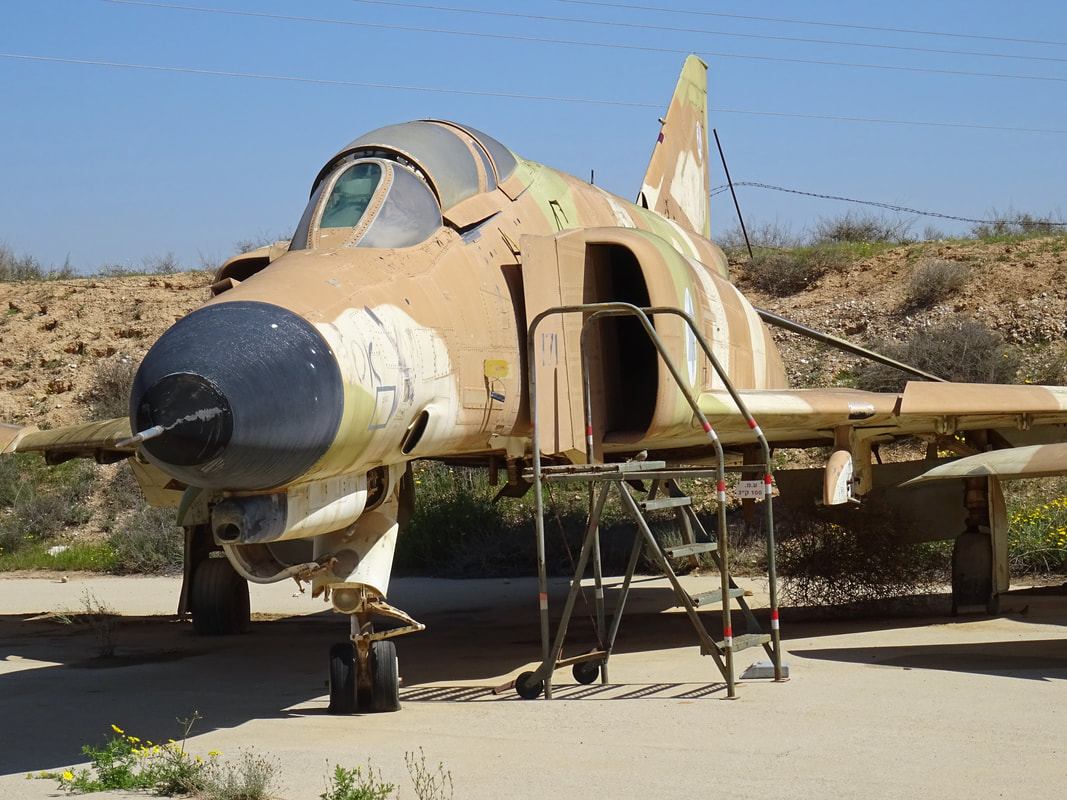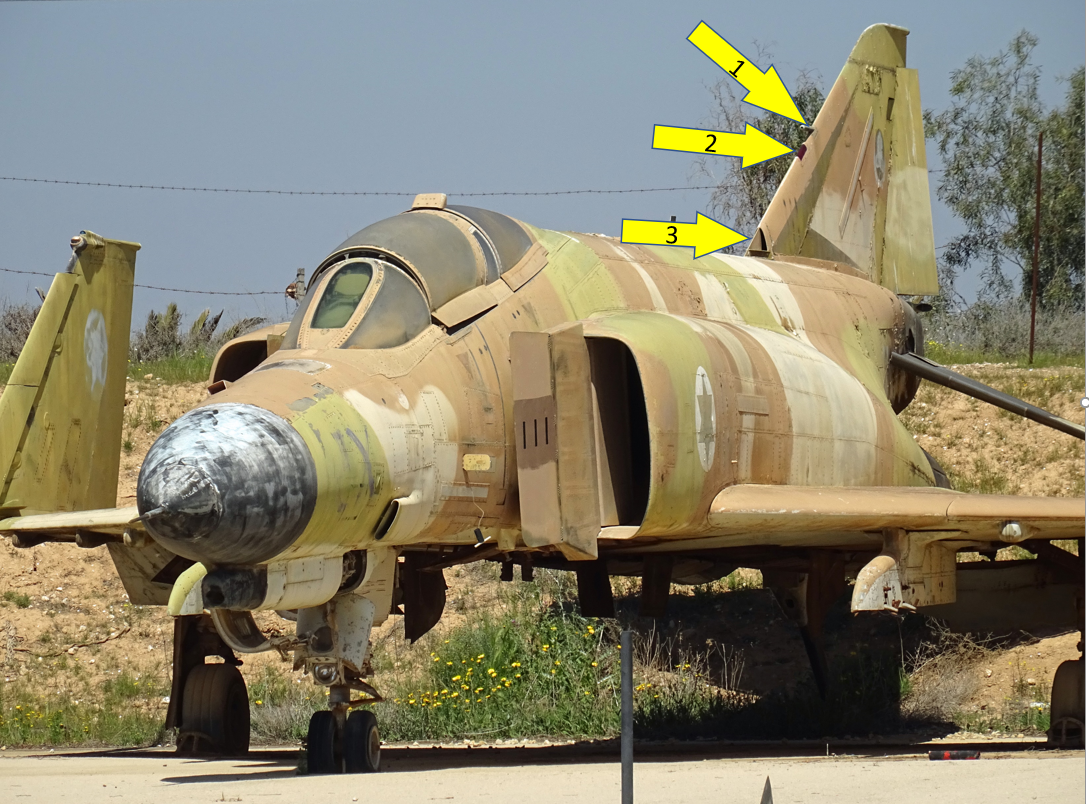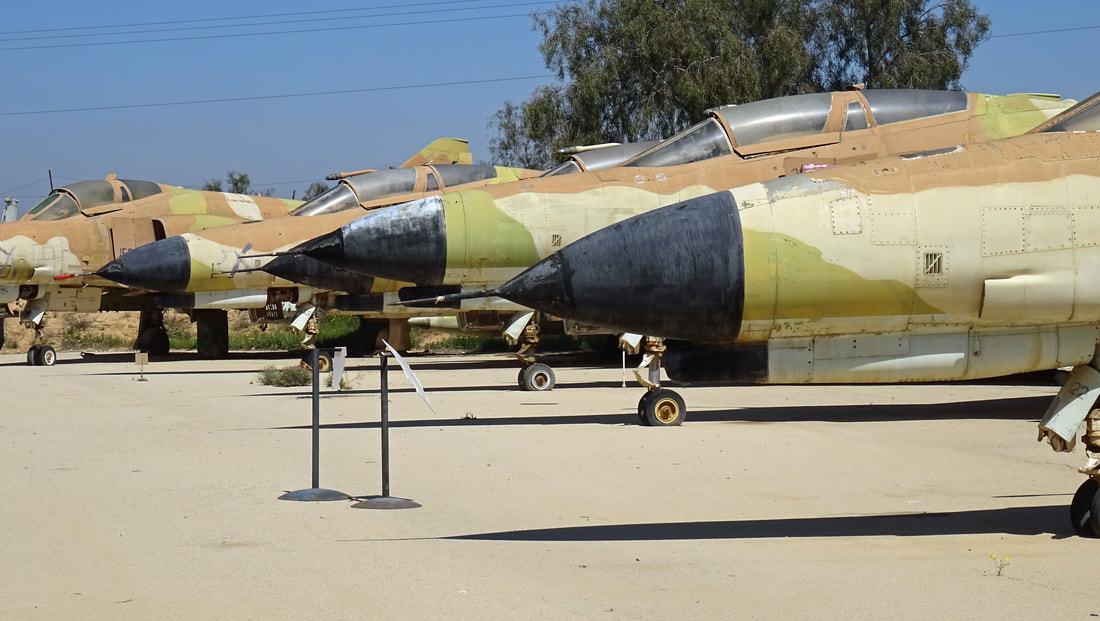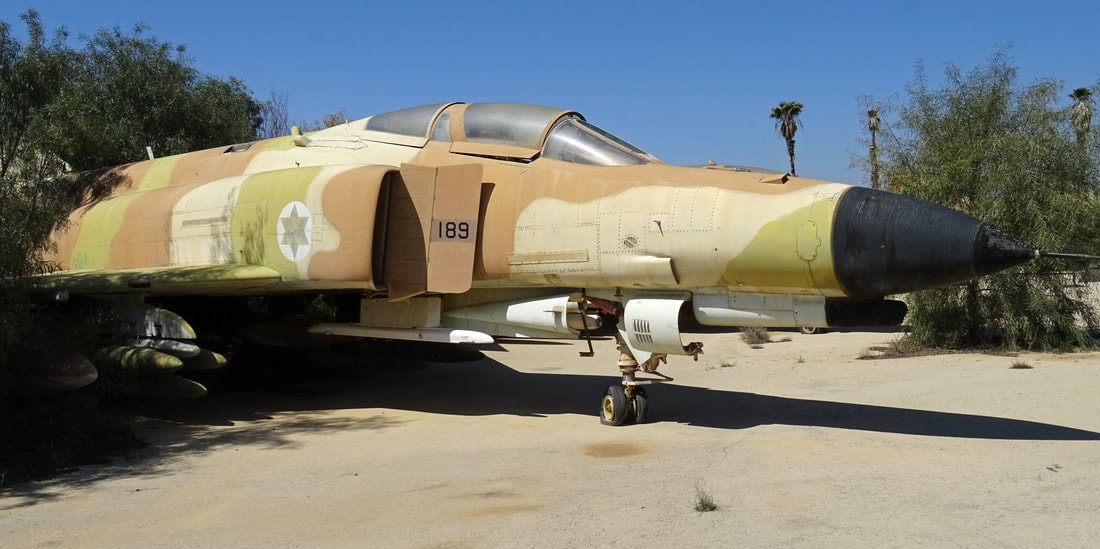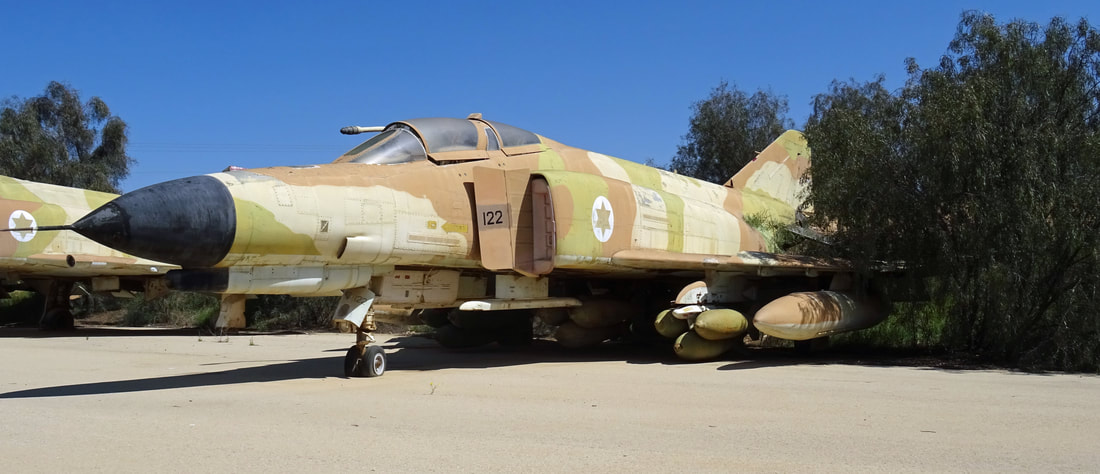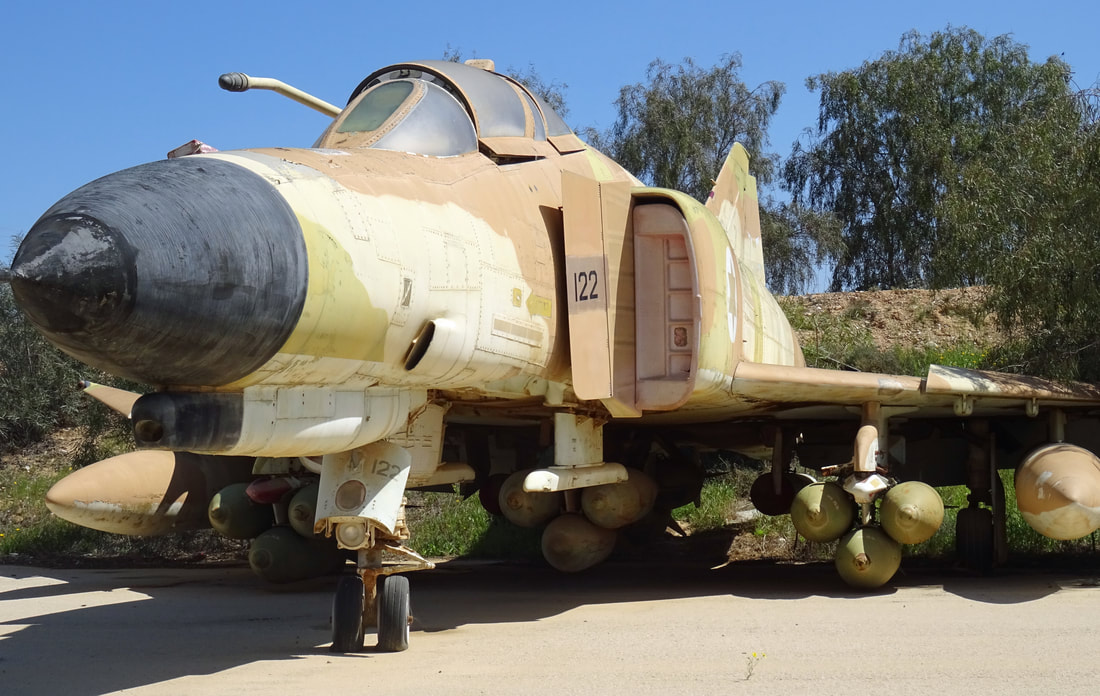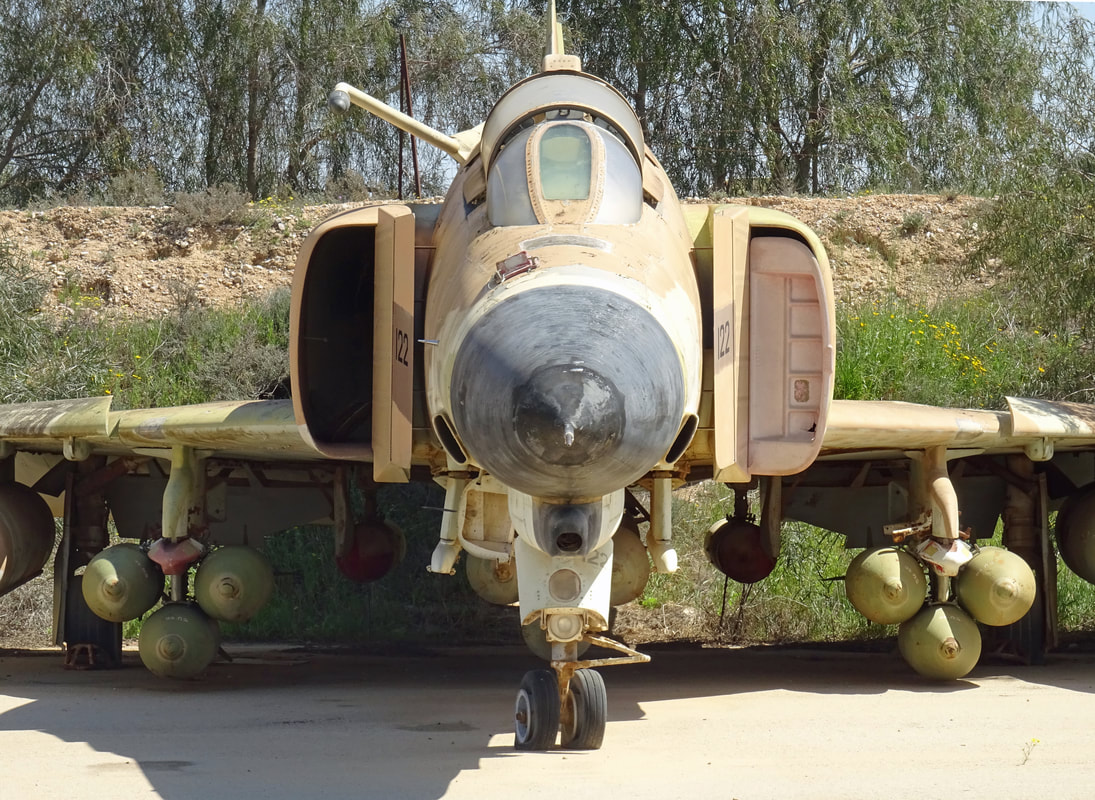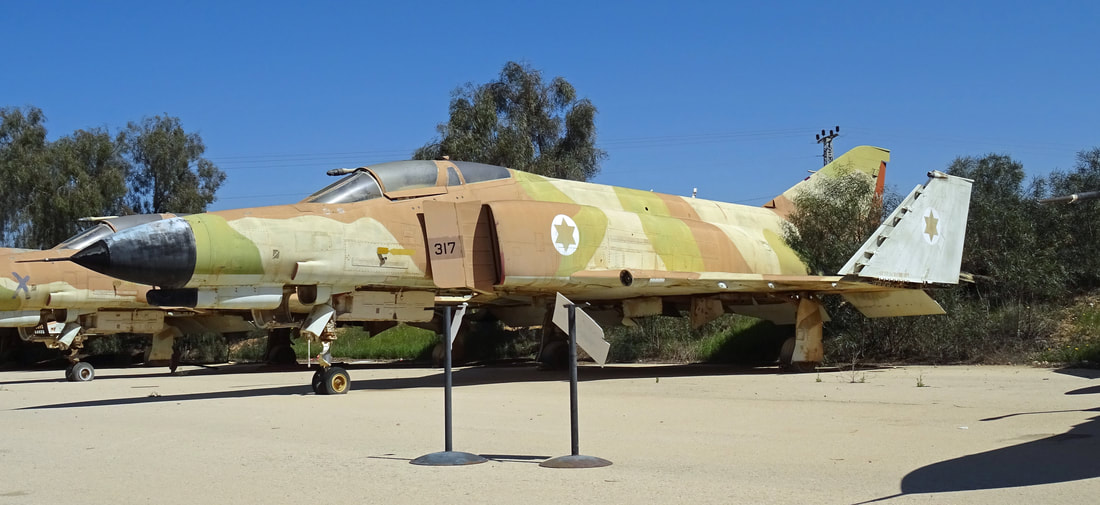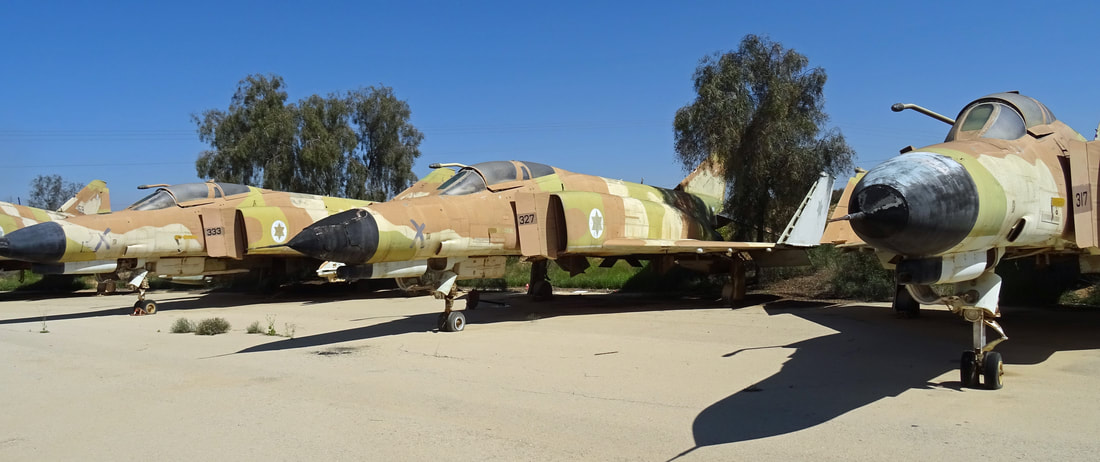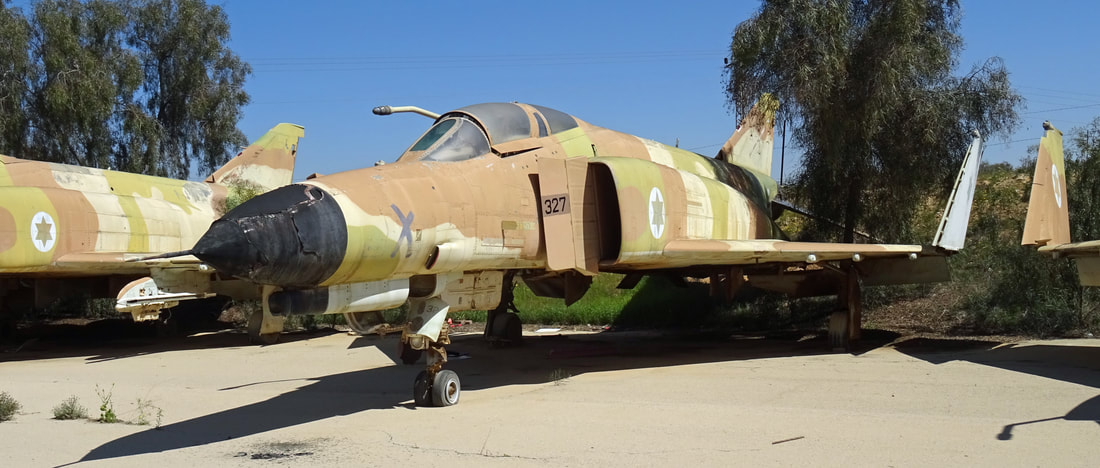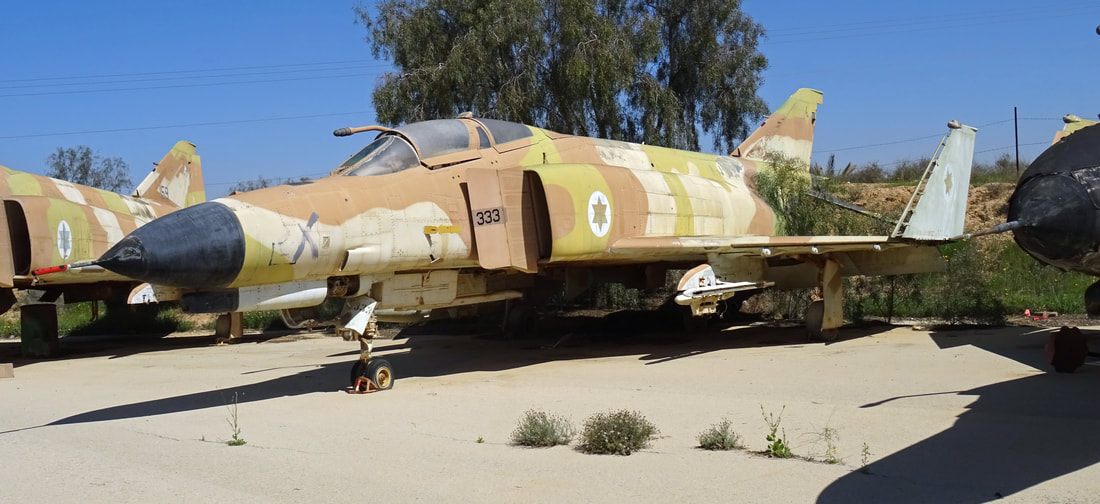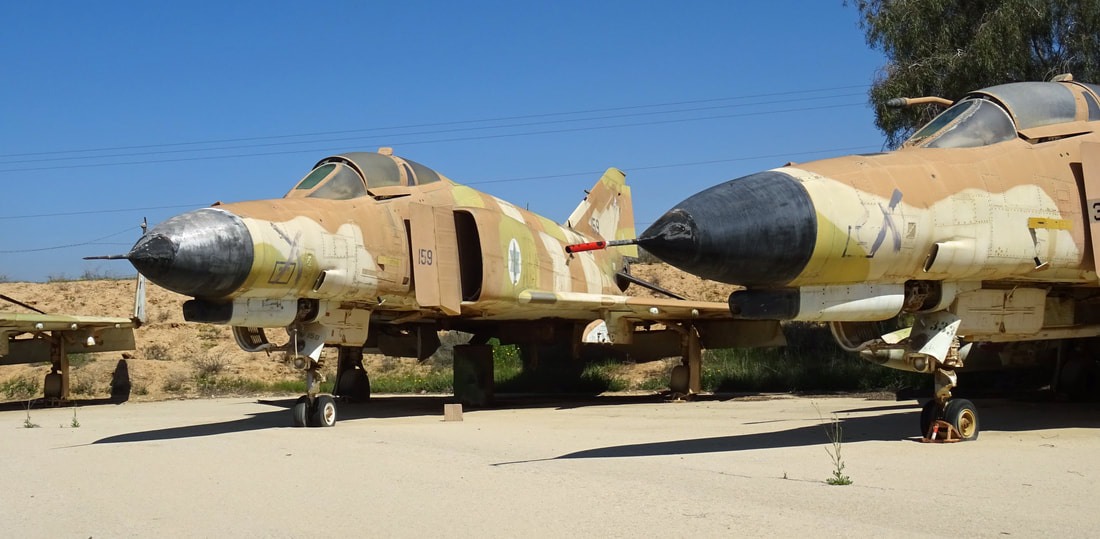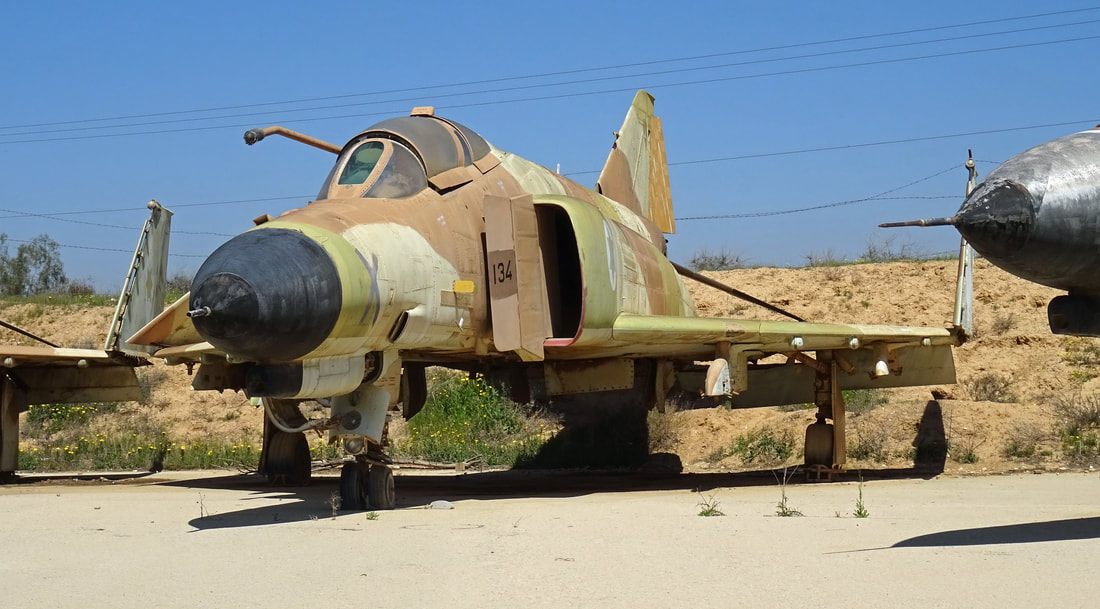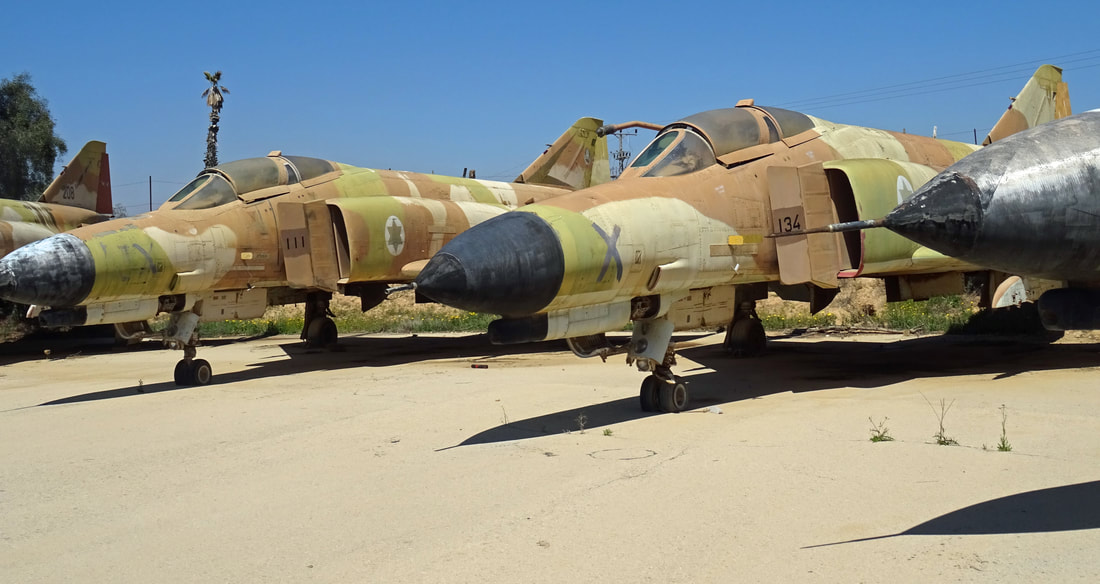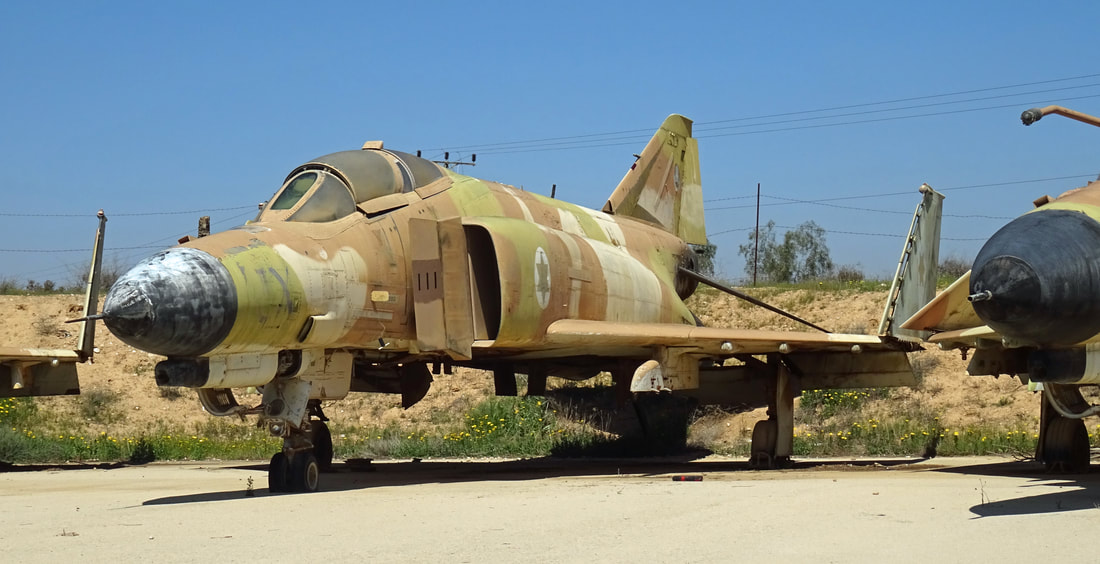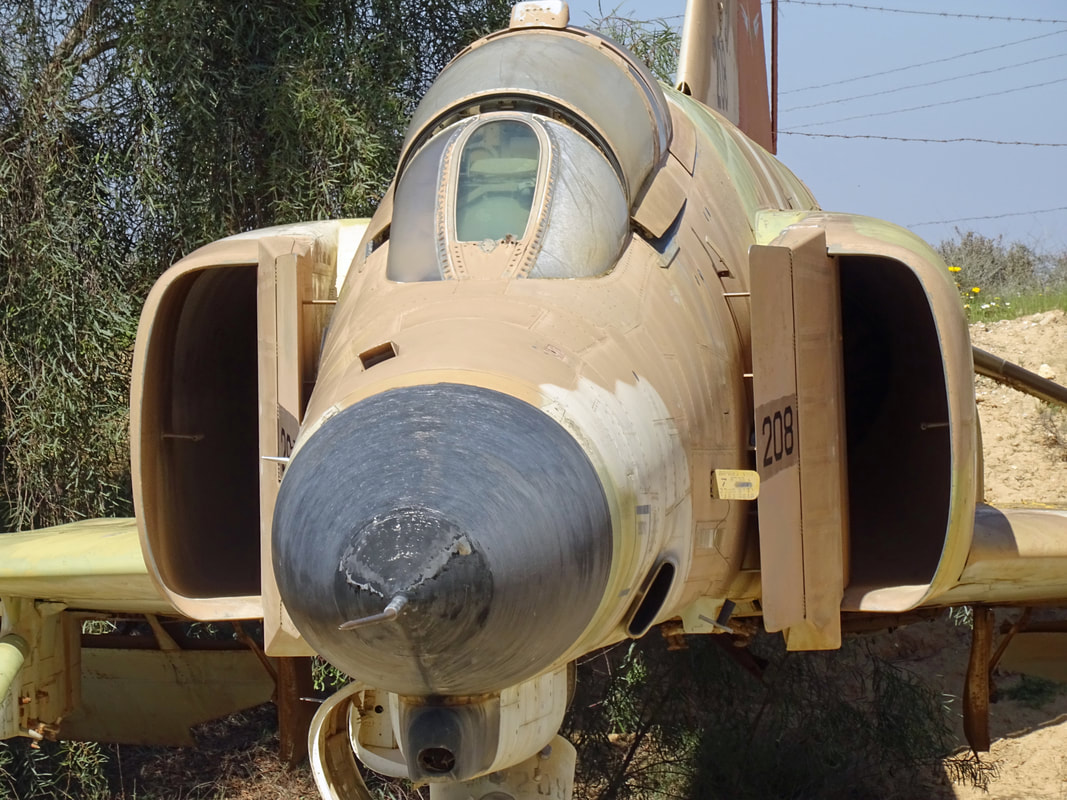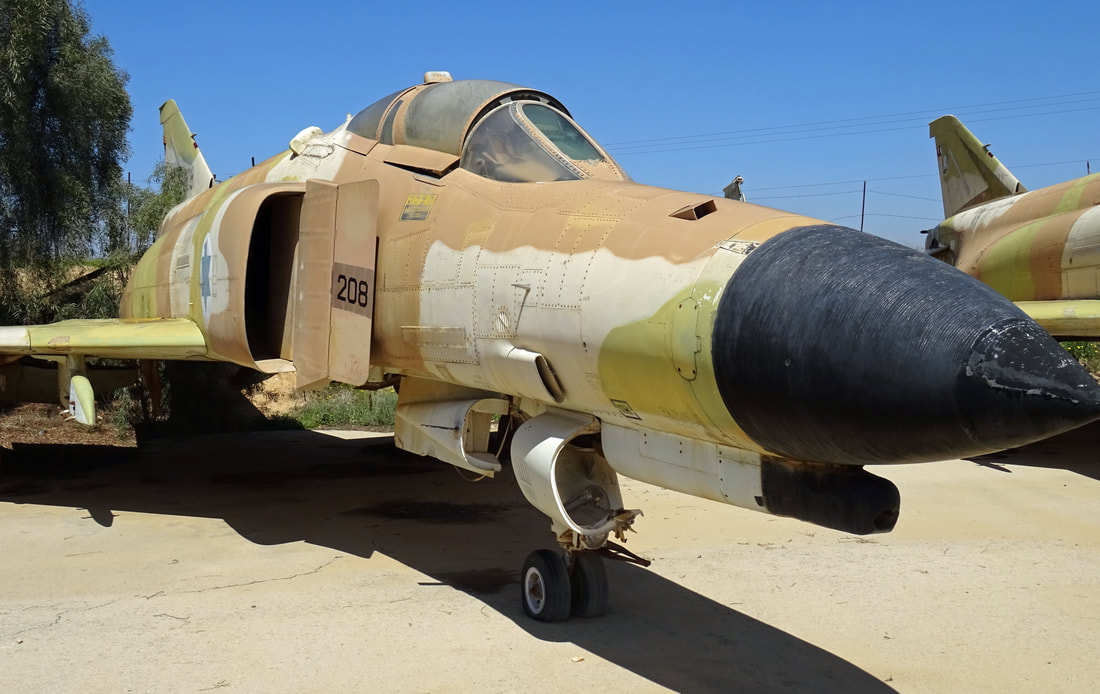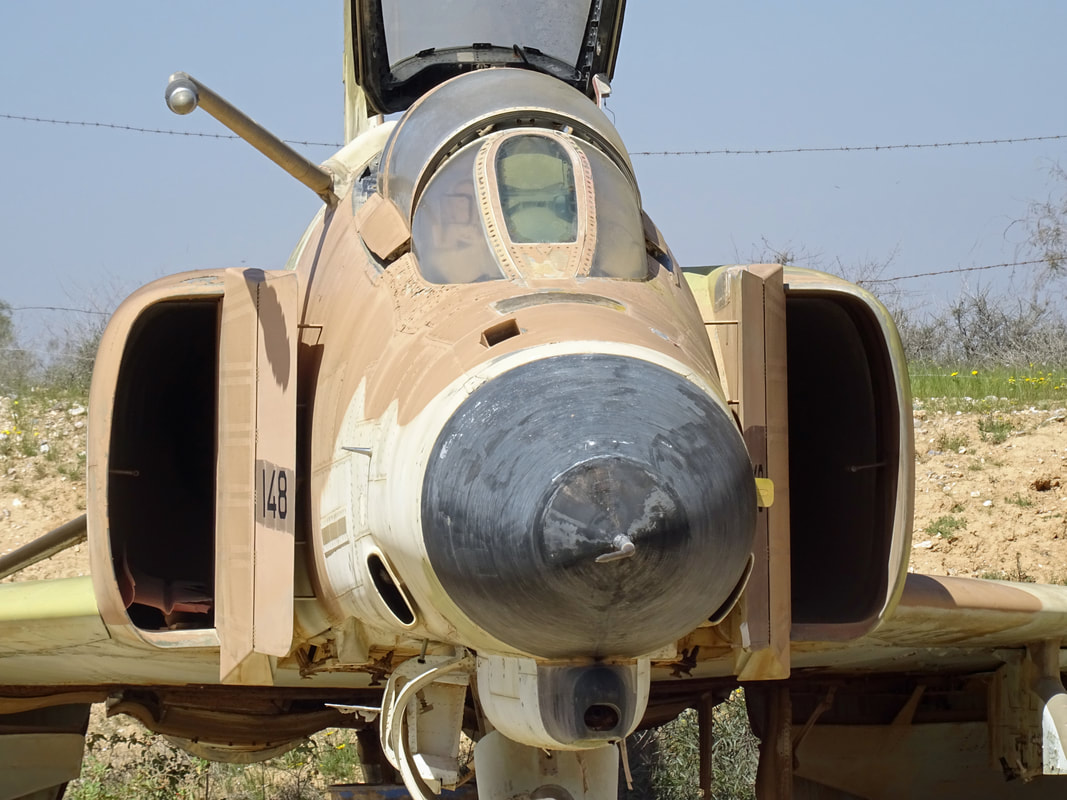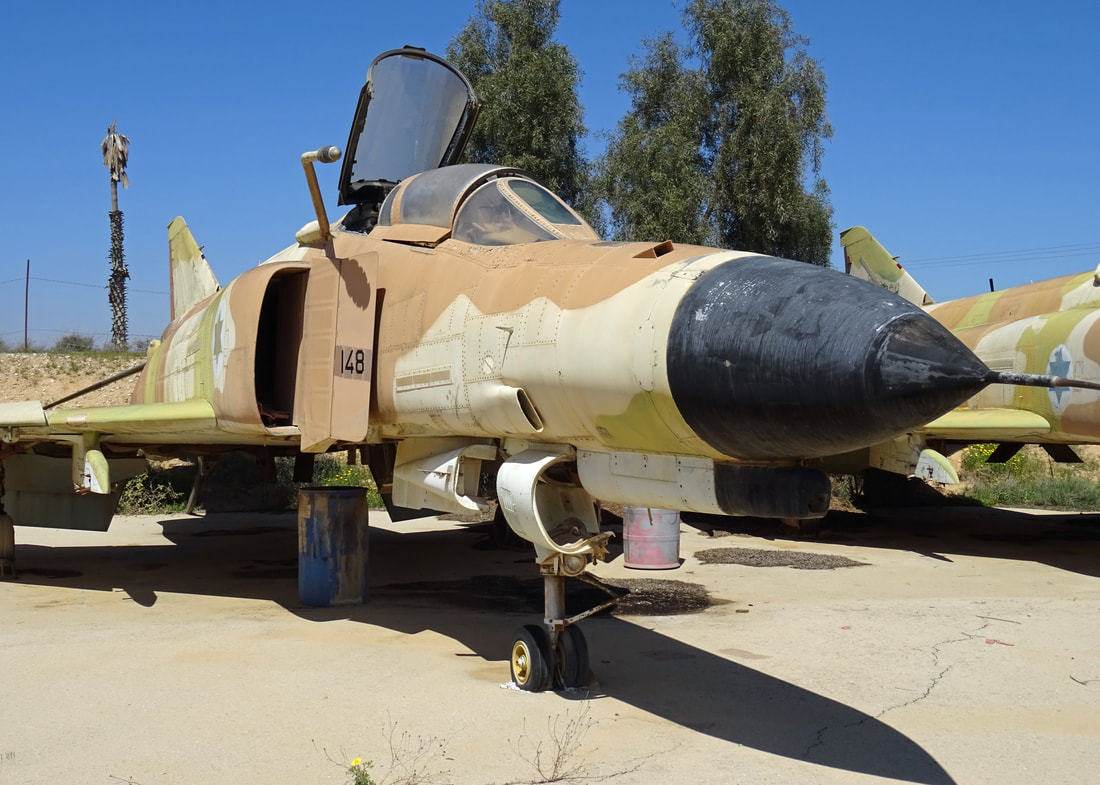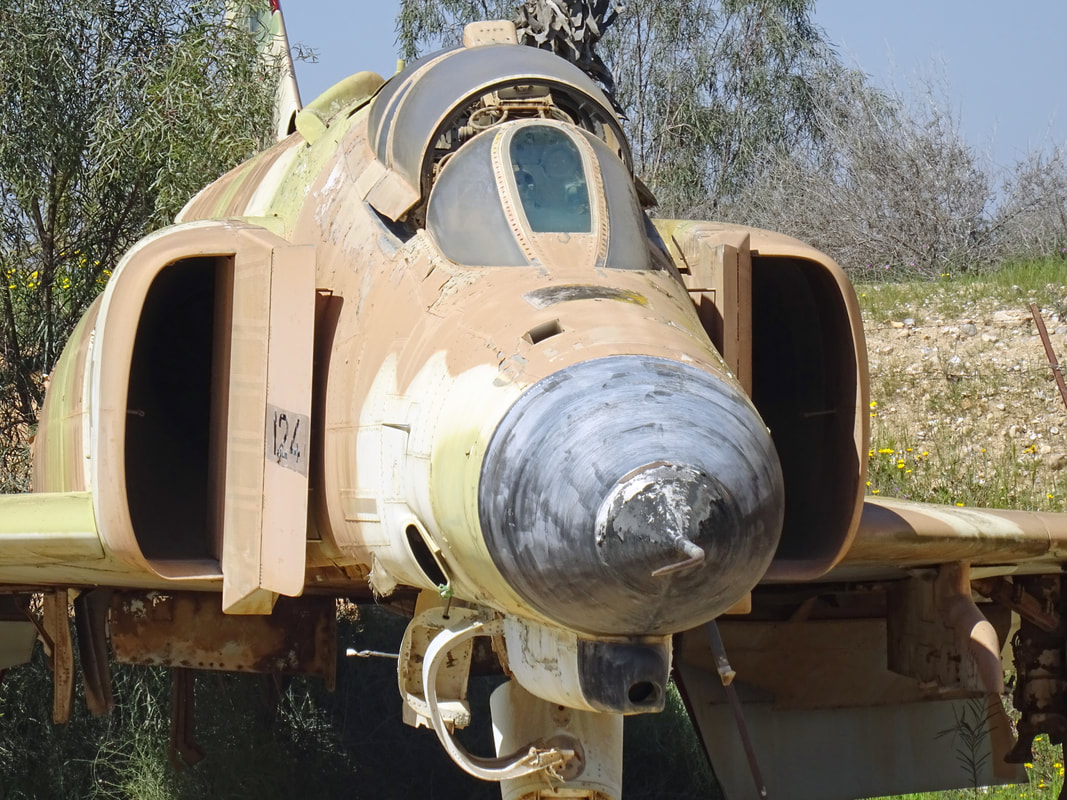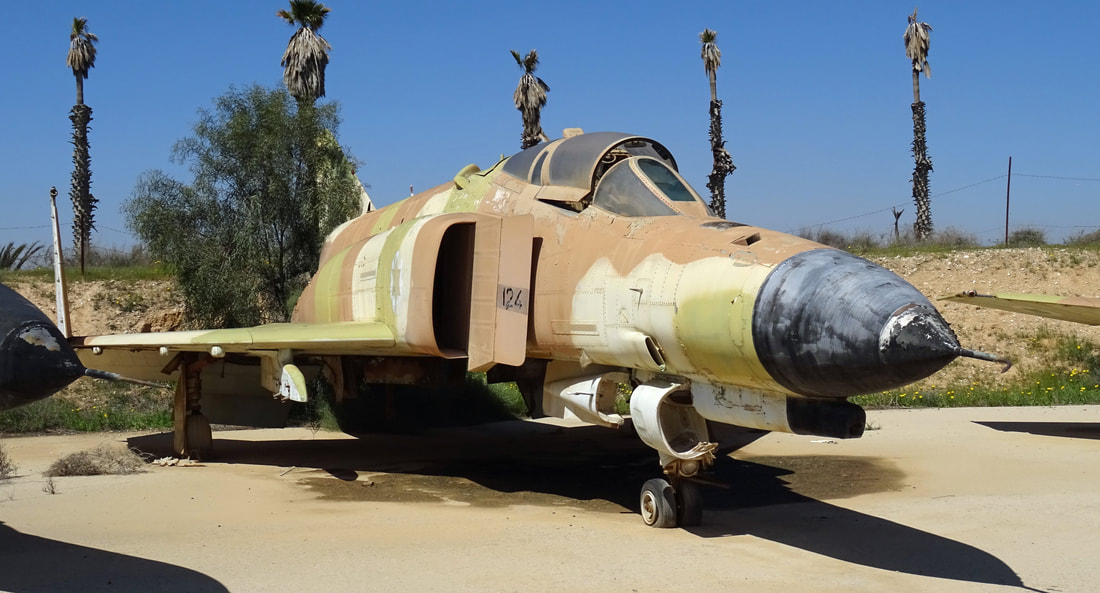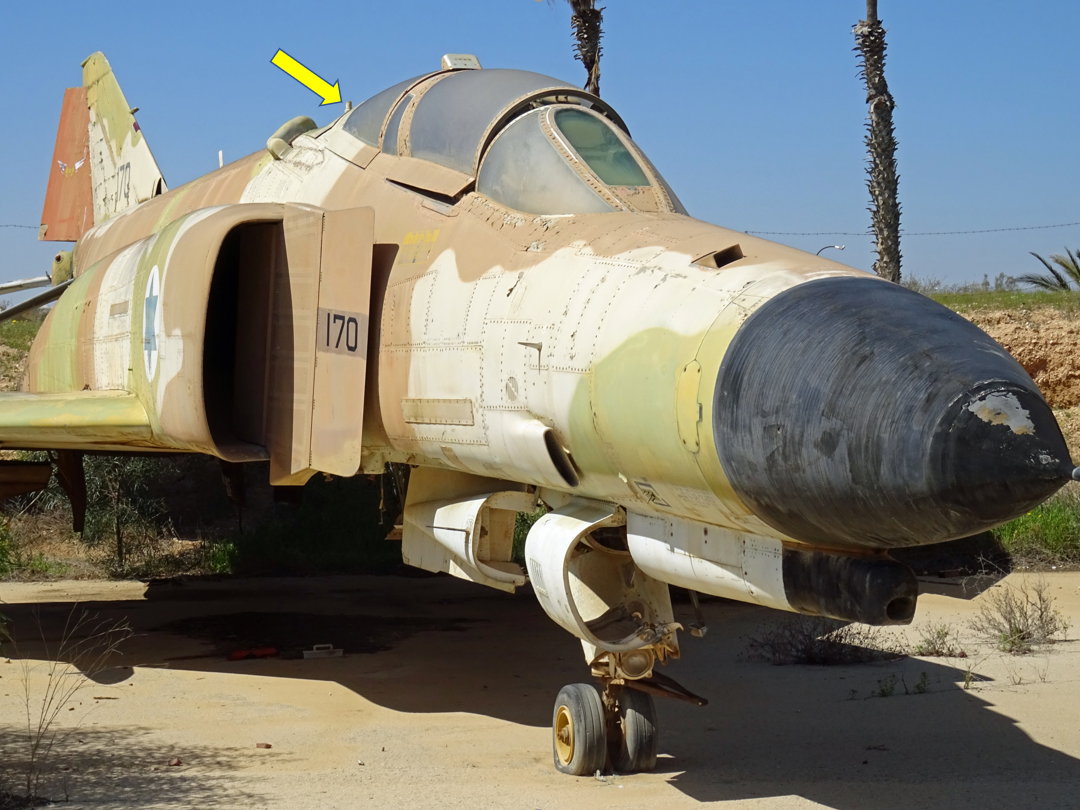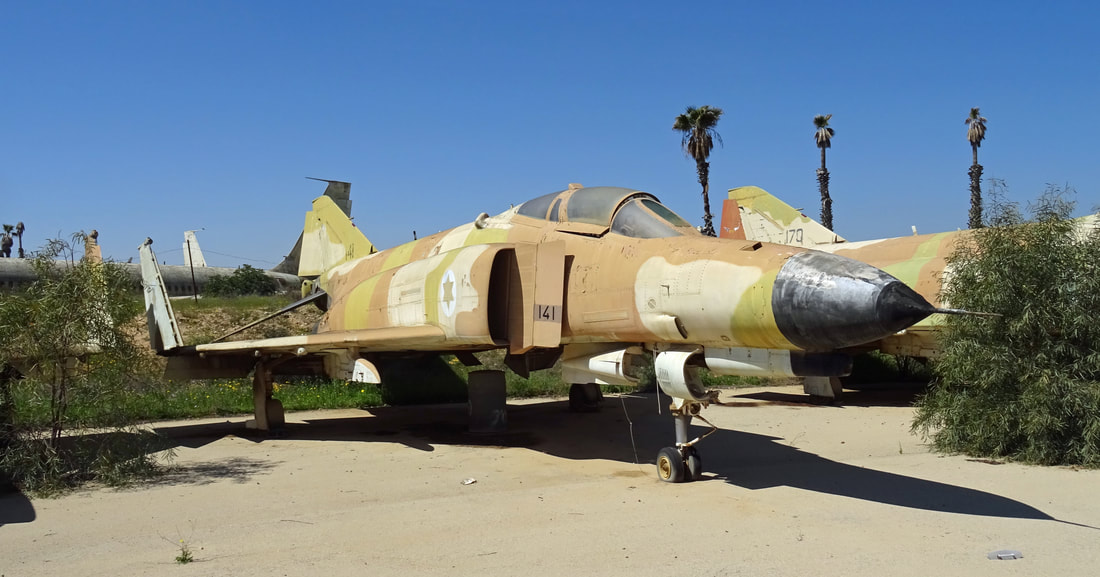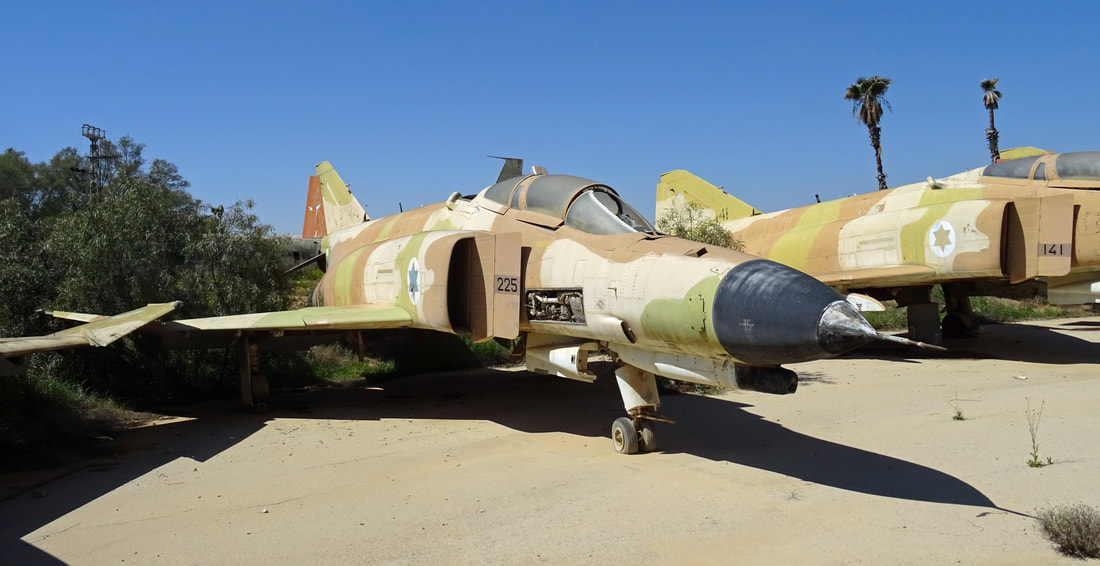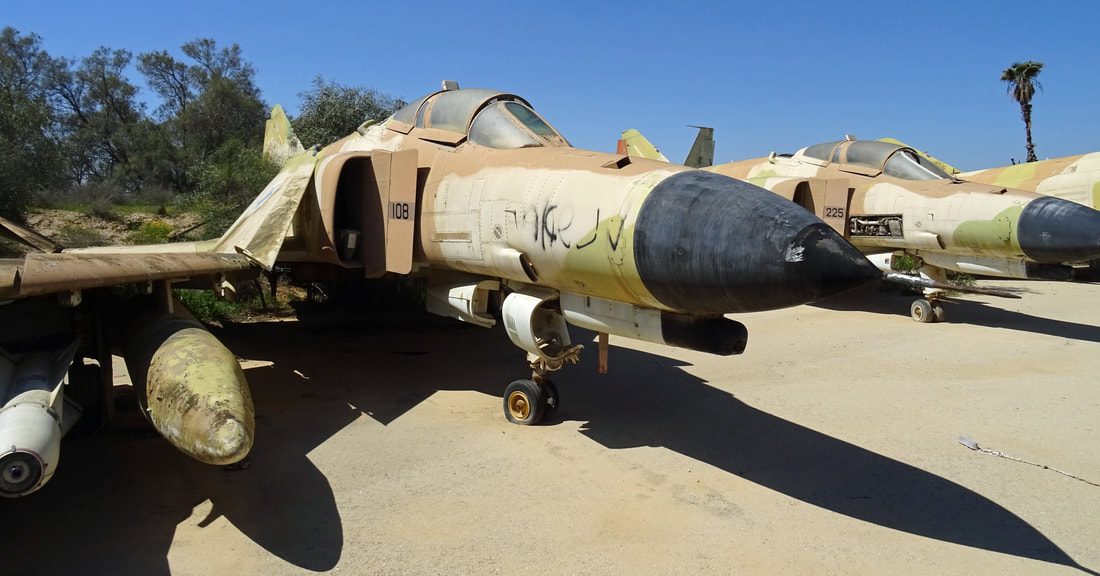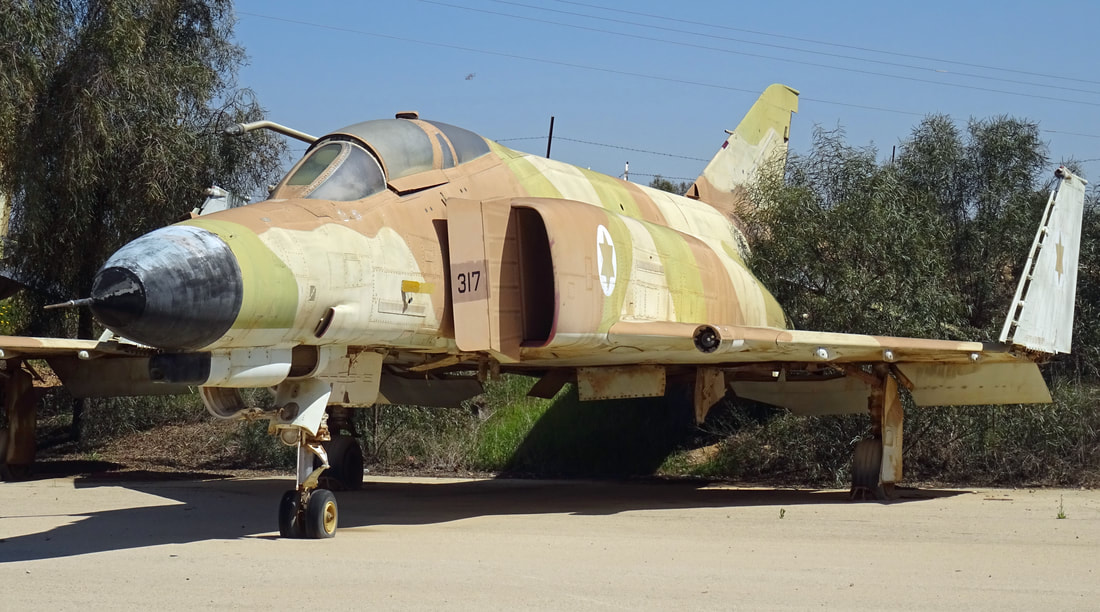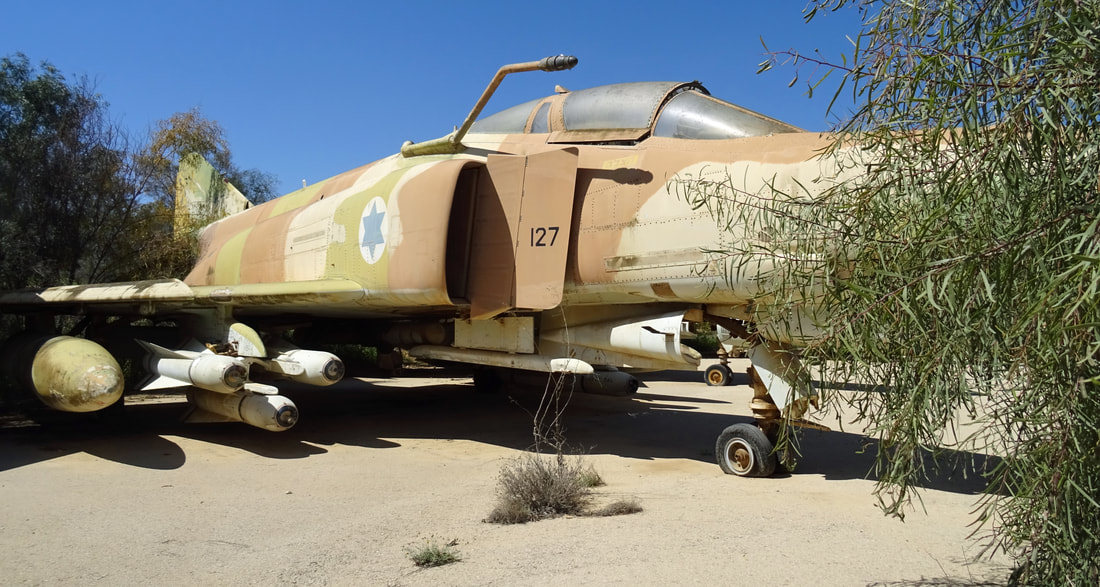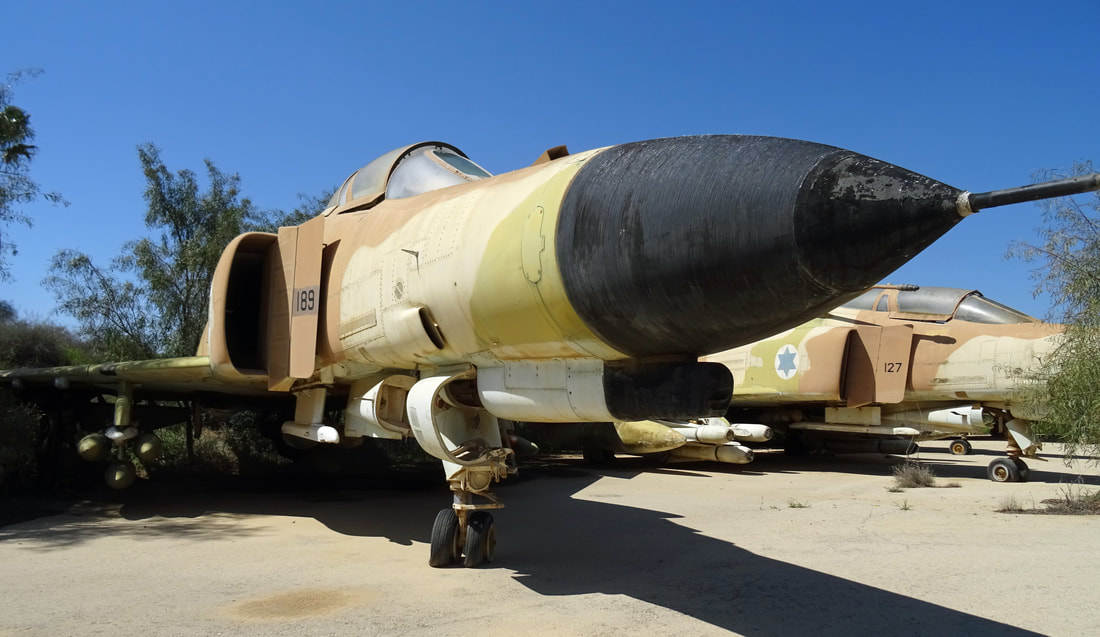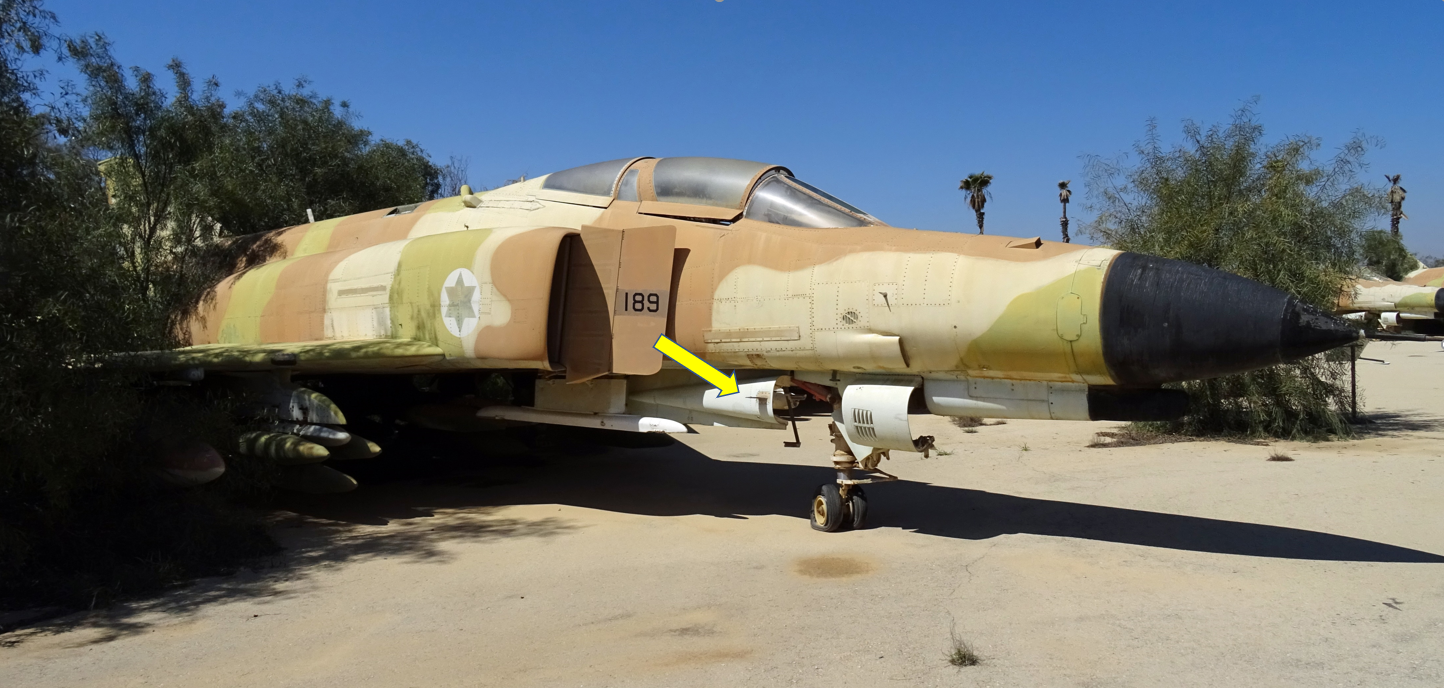Hatzerim Air Force museum
Beersheba, Israel
Part 01.
by Jan Koppen
Former 144 sqn. Kfir C7 '529' at the IAF museum gate- Hatzerim, in March 2019.
The Israeli Air Force Museum is located at Hatzerim Airbase in the Negev desert. The museum was established in 1977 and has been open to the public since 1991. The museum displays a variety of Israeli Air Force and foreign aircraft, as well as anti aircraft arms.
IAI Kfir C1 painted as 664, serial possibly 705, seen on a roundabout in Be'er Sheva, Israel in March 2019.
F-4E Phantom II, '277' from the "Orange Tail Knight" sqd. is displayed in Be'er-Sheva, Israel. Located outside Hatzerim Airbase this monument pays tribute to Ilan Ramon, an Israeli fighter pilot and astronaut who perished in the Columbia shuttle disaster.
|
‘39’ is a P-51D and a gate guardian of Hatzerim AFM.
A few P-51 Mustangs were illegally bought by Israel in 1948, crated, and smuggled into the country as agricultural equipment for use in the 1947–1949 Palestine war, serving alongside upwards of 23 Avia S-199 fighters (Czech-built Messerschmitt Bf 109Gs) in Israeli service, with the Mustangs quickly establishing themselves as the best fighter in the Israeli inventory. Further aircraft were bought from Sweden and were replaced by jets at the end of the 1950s, but not before the type was used in the Suez Crisis, at the opening of Operation Kadesh. In conjunction with a surprise parachute drop at the Mitla Pass, four P-51s were specially detailed to cut telephone and telegraph wires using their wings in extreme low level runs, which resulted in major interruptions to Egyptian communications.
|
‘40’ is a Gloster Meteor F.8 and like the P-51D
a gate guardian of Hatzerim AFM. |
The Classic lines of the Big Boeing are so evident in this full frontal.
088/4X-JYD Boeing 707-131 is seen here stored at the Israel Airforce museum, Beersheba - Hatzerim.
This 707 served as a part of TWA’s fleet until the 1970s, when it was sold to Israel for military use.
Trans World Airlines Boeing 707-131 N740TW was one of many non-fan-707s operated by TWA. TWA operated one of the biggest 707 fleet in the 60s. 4X-JYD made her first flight on May 03, 1959 and she was withdrawn from use in the first month of 1972. She quickly was bougth by the Israeli Air Force, modified as a EC-707 and registrated 4X-JYD/008. Named as ‘R’eem’, this aircraft was used as a flying command post during the famous Entebbe operation. Five years later she was transferred to Israel Aircraft Industries. She has been stored at the Israel Airforce museum for years.
4X-JYD was converted into an electronic command center. It was part of the operation at Entebbe in 1976, in which Israeli military rescued hostages from an Air France A300B2 airliner taken over by German and Palestinian militants from the PFLP.
The first versions of the 707 were powered by four Pratt & Whitney Turbo Wasp JT3C-6 turbojet engines, producing 11,200 pounds of thrust (49,820 kilonewtons), and 13,500 pounds (60.051 kilonewtons) with water injection. This engine was a civil variant of the military J57 series. It was a two-spool axial-flow turbojet engine with a 16-stage compressor and 2 stage turbine. The JT3C-6 was 11 feet, 6.6 inches (3.520 meters) long, 3 feet, 2.9 inches (0.988 meters) in diameter, and weighed 4,235 pounds (1,921 kilograms).
The early JT-3C’s had two or three radial layers of pipes and some JT4 engines had a flower-style inner exhaust encompassed by pipes. There were noise compressors with 8-pipe and 10-pipe exhausts. Thus, one could not figure out which engine was installed by checking its noise compressor configuration. Qantas, for example, had Boeing 707-120’s fitted with JT-3C, that even had 21 tubes!
Beautiful shaped Pratt & Whitney JT-3C's, almost a work of art, sadly showing advanced signs of decay.
4X-JYD is an early Boeing 707 with turbojet engines and ofcourse equipped with sound suppressors. The HF antenna on top of the vertical stabilizer was a distinctive feature of the 707.
Her switches and controls, worn smooth by the touch of a thousand hands.
De Havialland Vampire FB52 'L158' of the Lebanon Air Force, warms its natural metal finish in the strong desert sunshine. This Vampire is a former South-African Air Force fighter jet.
The de Havilland Vampire is a British jet fighter developed and manufactured by the de Havilland Aircraft Company. It was the second jet fighter to be operated by the RAF, after the Gloster Meteor, and the first to be powered by a single jet engine.
|
Work on the Vampire commenced during 1941 in the midst of the Second World War; it was initially intended as an experimental aircraft, albeit one that was suitable for combat, that harnessed the groundbreaking innovation of jet propulsion. Out of the company's design studies, it was quickly decided to settle on a single-engine, boom aircraft, powered by the Halford H.1 turbojet engine (later produced as the "Goblin"). Aside from its propulsion system and twin-boom configuration, it was a relatively conventional aircraft. Despite being originally ordered as an experimental aircraft only, during May 1944, it was decided to mass-produce the aircraft as an interceptor for the Royal Air Force (RAF). During 1946, the first production Vampire entered operational service with the RAF, only months after the conflict had come to an end.
|
‘353’ is an Iraq Air Force DH-112 Venom FB.50.
The de Havilland DH-112 Venom is a British post-war single-engined jet aircraft developed and manufactured by the de Havilland Aircraft Company. Much of its design was derived from the de Havilland Vampire, the firm's first jet-powered combat aircraft.
The Venom proved to be popular on the export market, being sold in substantial numbers. The Royal Iraq Air Force received de Havilland Venoms during the mid-1950s. The FB.50 variant is the export version used by Iraq in the 1950s.
The Venom proved to be popular on the export market, being sold in substantial numbers. The Royal Iraq Air Force received de Havilland Venoms during the mid-1950s. The FB.50 variant is the export version used by Iraq in the 1950s.
‘0053’ is a DH-115 Vampire T.55 which flew with the Nigeria Air Force in the 60s.
The T.55 was the export version of the DH-115 trainer; 216 were built and six converted from the T.11.
Captured Egypt Air Force MiG-15UTI ‘3507’ fighter jet is on display in the Hatzerim Airforce Museum.
The Mikoyan-Gurevich MiG-15, NATO reporting name: Fagot, is a jet fighter aircraft developed by Mikoyan-Gurevich for the Soviet Union. The MiG-15 was one of the first successful jet fighters to incorporate swept wings to achieve high transonic speeds. In combat over Korea, it outclassed straight-winged jet day fighters, which were largely relegated to ground-attack roles, and was quickly countered by the similar American swept-wing North American F-86 Sabre.
When refined into the more advanced MiG-17, the basic design would again surprise the West when it proved effective against supersonic fighters such as the Republic F-105 Thunderchief and McDonnell Douglas F-4 Phantom II in the Vietnam War of the 1960s.
The MiG-15 is believed to have been one of the most produced jet aircraft; in excess of 13,000 were manufactured. Licensed foreign production may have raised the production total to almost 18,000. The MiG-15 remains in service with the Korean People's Army Air Force as an advanced trainer.
When refined into the more advanced MiG-17, the basic design would again surprise the West when it proved effective against supersonic fighters such as the Republic F-105 Thunderchief and McDonnell Douglas F-4 Phantom II in the Vietnam War of the 1960s.
The MiG-15 is believed to have been one of the most produced jet aircraft; in excess of 13,000 were manufactured. Licensed foreign production may have raised the production total to almost 18,000. The MiG-15 remains in service with the Korean People's Army Air Force as an advanced trainer.
The MiG-15UTI is a two-seat dual-control jet trainer.
Egypt bought two squadrons of MiG-15bis and MiG-17 fighters in 1955 from Czechoslovakia with the sponsorship and support of the USSR, just in time to participate in the Suez Canal Crisis. By the outbreak of the Suez conflict in October 1956, four squadrons of the Egyptian Air Force were equipped with the type, although few pilots were trained to fly them effectively.
They first saw aerial action on the morning of 30 October, intercepting four RAF Canberra bombers on a reconnaissance mission over the Canal Zone, damaging one. Later that day, MiG-15s attacked Israeli forces at Mitla Pass and El Thamed in the Sinai, destroying half a dozen vehicles. As a result, the Israeli Air Force (IAF) instituted a standing combat air patrol over the Canal, and the next attack resulted in two MiGs downed by IAF Mysteres, although the Egyptian aircraft were able to successfully hit the Israeli troops.
The next day, the MiGs evened the score somewhat when they badly damaged two IAF Ouragan fighters, forcing one of them to crash-land in the desert. British and French warplanes then began a systematic bombing campaign of Egyptian air bases, destroying at least eight MiGs and dozens of other Egyptian aircraft on the ground and forcing the others to disperse. The remaining aircraft still managed to fly some attack missions, but the Egyptians had lost air superiority.
During air combat against the IAF, Egyptian MiG-15bis managed to shoot down only three Israeli aircraft: a Piper Cub and a Gloster Meteor F.8 on 30 October 1956, and a Dassault Ouragan on 1 November, which performed a belly landing.
They first saw aerial action on the morning of 30 October, intercepting four RAF Canberra bombers on a reconnaissance mission over the Canal Zone, damaging one. Later that day, MiG-15s attacked Israeli forces at Mitla Pass and El Thamed in the Sinai, destroying half a dozen vehicles. As a result, the Israeli Air Force (IAF) instituted a standing combat air patrol over the Canal, and the next attack resulted in two MiGs downed by IAF Mysteres, although the Egyptian aircraft were able to successfully hit the Israeli troops.
The next day, the MiGs evened the score somewhat when they badly damaged two IAF Ouragan fighters, forcing one of them to crash-land in the desert. British and French warplanes then began a systematic bombing campaign of Egyptian air bases, destroying at least eight MiGs and dozens of other Egyptian aircraft on the ground and forcing the others to disperse. The remaining aircraft still managed to fly some attack missions, but the Egyptians had lost air superiority.
During air combat against the IAF, Egyptian MiG-15bis managed to shoot down only three Israeli aircraft: a Piper Cub and a Gloster Meteor F.8 on 30 October 1956, and a Dassault Ouragan on 1 November, which performed a belly landing.
'1033' is an Egyptian Air Force Mig-17F.
The Mikoyan-Gurevich MiG-17, NATO reporting name: Fresco, is a high-subsonic fighter aircraft produced in the USSR from 1952 and operated by numerous air forces in many variants. It is an advanced development of the similar looking MiG-15 of the Korean War. The MiG-17 was license-built in China as the Shenyang J-5 and Poland as the PZL-Mielec Lim-6.
MiG-17s first saw combat in 1958 in the Second Taiwan Strait Crisis and later proved to be an effective threat against more modern supersonic fighters of the United States in the Vietnam War. It was also briefly known as the Type 38 by U.S. Air Force designation prior to the development of NATO codes.
MiG-17s first saw combat in 1958 in the Second Taiwan Strait Crisis and later proved to be an effective threat against more modern supersonic fighters of the United States in the Vietnam War. It was also briefly known as the Type 38 by U.S. Air Force designation prior to the development of NATO codes.
|
The MiG-17F ("Fresco C") is the basic fighter version powered by VK-1F engine with afterburner.
Sixty MiG-17s - including 20 radar-equipped MiG-17PFs - were ordered by the Syrian Air Force at the end of 1956 and Syrian pilots were dispatched to the USSR and Poland for training. The first aircraft arrived in January 1957 and by the end of the year, two MiG-17 squadrons were defending the capital from their base at Damasucus' Mezzeh Military Airport. |
Aerospatiale SA342L Gazelle '907' of the Syrian Air Force was captured by Israel in Lebanon in 1982.
The SA 342L is the military companion of the SA 342J. fitted with the Astazou XIV engine. Adaptable for many armaments and equipment, including six Euromissile HOT anti-tank missiles.
‘J-747’ is a Jordan Air Force Hawker Hunter FGA.9.
The Hawker Hunter is a transonic British jet-powered fighter aircraft that was developed by Hawker Aircraft for the Royal Air Force (RAF) during the late 1940s and early 1950s. It was designed to take advantage of the newly developed Rolls-Royce Avon turbojet engine and the swept wing, and was the first jet-powered aircraft produced by Hawker to be procured by the RAF. On 7 September 1953, the modified first prototype broke the world air speed record for aircraft, achieving a speed of 727.63 mph (1,171.01 km/h; 632.29 kn).
Between 1964 and 1975, both Britain and France delivered significant quantities of arms, including Hunters, to Iraq. The Hunters were far more effective in fighting guerrilla activity than the Russian MiG-17s then operated by Iraq. In 1967, Hunters of the Iraqi Air Force saw action during the War of Attrition. Some missions were flown by the Royal Jordanian Air Force, but most of the Jordanian Hunters were destroyed on the ground on the first day of the Six-Day War. Replacement Hunters for Jordanian service were acquired from both Britain and Saudi Arabia in the war's aftermath.
‘339’ is a former Madagascar Air Force Mig-21UM.
The Mikoyan-Gurevich MiG-21, NATO reporting name Fishbed, is a supersonic jet fighter and interceptor aircraft, designed by the Mikoyan-Gurevich Design Bureau in the Soviet Union. Its nicknames include: Balalaika, because its planform resembles the stringed musical instrument of the same name; Ołówek, Polish for "pencil", due to the shape of its fuselage and; Én bạc, meaning "Silver Swallow", in Vietnamese.
Former Madagascar Air Force Mig-21 '339', warms its natural metal finish in the strong Israelian sunshine.
‘007’ is a former Iraq Air Force Mig-21F-13-3.
Operation Diamond was an operation undertaken by the Mossad. Its goal was the acquisition of a Soviet-built Mikoyan-Gurevich MiG-21, the most advanced Soviet fighter plane at that time. The operation began in mid-1963 and ended on August 16, 1966, when an Iraqi Air Force MiG-21, flown by the Iraqi Assyrian defector Munir Redfa, landed at an air base in Israel. Israel and the United States were able to study the design of the plane.
MiG-21 production began in 1959, and Egypt, Syria and Iraq received numerous planes.
The first attempt to acquire the aircraft was conducted in Egypt by Mossad agent Jean Thomas. Thomas and his group were ordered to find a pilot, who for $1,000,000 would agree to fly the plane to Israel. However, their first attempt was unsuccessful. The Egyptian pilot they contacted, Adib Hanna, informed the authorities about Thomas' interest in the MiG. Thomas, his father, and three other people were arrested and charged with espionage. Thomas and two others were hanged in December 1962. The other three members of the group received long prison terms. The second attempt also failed. Mossad agents ended up assaulting two Iraqi pilots who refused to cooperate with them, in order to keep them quiet for some time.
In 1964 an Iraqi born Jew, Yusuf, contacted Israeli services in Tehran, at a time when Israel and Iran still had diplomatic relations, and Western Europe. Since he was 10 years old, Yusuf had worked as a servant for a Maronite Christian family. His girlfriend's friend was married to an Iraqi pilot named Munir Redfa. Redfa was annoyed that his Christian roots prevented his promotion in the military. He was also upset that he had been ordered to attack Iraqi Kurds. Yusuf understood that Redfa was ready to leave Iraq.
MiG-21 production began in 1959, and Egypt, Syria and Iraq received numerous planes.
The first attempt to acquire the aircraft was conducted in Egypt by Mossad agent Jean Thomas. Thomas and his group were ordered to find a pilot, who for $1,000,000 would agree to fly the plane to Israel. However, their first attempt was unsuccessful. The Egyptian pilot they contacted, Adib Hanna, informed the authorities about Thomas' interest in the MiG. Thomas, his father, and three other people were arrested and charged with espionage. Thomas and two others were hanged in December 1962. The other three members of the group received long prison terms. The second attempt also failed. Mossad agents ended up assaulting two Iraqi pilots who refused to cooperate with them, in order to keep them quiet for some time.
In 1964 an Iraqi born Jew, Yusuf, contacted Israeli services in Tehran, at a time when Israel and Iran still had diplomatic relations, and Western Europe. Since he was 10 years old, Yusuf had worked as a servant for a Maronite Christian family. His girlfriend's friend was married to an Iraqi pilot named Munir Redfa. Redfa was annoyed that his Christian roots prevented his promotion in the military. He was also upset that he had been ordered to attack Iraqi Kurds. Yusuf understood that Redfa was ready to leave Iraq.
Top-dressed Mig-21
A female Mossad agent befriended Redfa. He told her that he was forced to live far away from his family in Baghdad, he was not trusted by his commanders, and allowed to fly only with small fuel tanks because of his Christianity. He also expressed his admiration towards Israelis, "few against so many Muslims". Redfa was persuaded to travel to Europe to meet with Israeli agents. Meir Amit himself observed the meeting between Redfa and an intelligence officer, using a peep-hole. Redfa was offered $1 million, Israeli citizenship, and full-time employment. Redfa's conditions about smuggling all his relatives out of Iraq were accepted. Later Redfa traveled to Israel to see the airfield he was going to use to land the plane. He also met with the commander of Israeli Air Force, Major General Mordechai "Mottie" Hod. They discussed the dangerous flight and its path.
Numerous Mossad agents were sent to Iraq to assist the transfer of Redfa's wife Betty, their two children aged three and five, his parents and a number of other family members out of the country. Betty and their two children went to Paris for what she thought was a summer vacation. Redfa, who promised to prepare her for what was going to happen, told her nothing. When Betty was contacted by a Mossad agent, who had her new Israeli passport, she initially became very upset and threatened to contact the Iraqi embassy, before she calmed down. The other family members were taken to the Iranian border, where Kurdish guerillas helped them to cross into Iran, from where they were taken to Israel.
The opportunity to defect came about on August 16, 1966. While Redfa was flying over northern Jordan, his plane was tracked by radar. The Jordanians contacted Syria but were reassured that the plane belonged to the Syrian air force and was on a training mission. When Redfa's plane reached Israel, he was met by two Israeli Air Force Dassault Mirage IIIs, which escorted him to a landing at Hatzor. Later at a press conference, Redfa said that he had landed the plane on "the last drop of fuel".
Soon after his defection, Redfa's MiG was renumbered 007, reflecting the manner in which it had arrived. Within a few weeks the aircraft took off again with Israeli test pilot Danny Shapira at the controls, on the first of many test flights. The jet's strengths and weaknesses were analyzed and it was flown against IAF fighters, eventually training Israeli pilots to deal with the aircraft. In May 1967 director of CIA Richard Helms said that Israel had proven that it had made good use of the aircraft, when on April 7, 1967, during aerial battles over the Golan Heights, the Israeli Air Force brought down 6 Syrian MiG-21s without losing any of its Dassault Mirage IIIs.
In January 1968, Israel loaned the MiG to the United States, which evaluated the jet under the HAVE DOUGHNUT program. The transfer helped pave the way for the Israeli acquisition of the F-4 Phantom, which the Americans had been reluctant to sell to Israel.
Numerous Mossad agents were sent to Iraq to assist the transfer of Redfa's wife Betty, their two children aged three and five, his parents and a number of other family members out of the country. Betty and their two children went to Paris for what she thought was a summer vacation. Redfa, who promised to prepare her for what was going to happen, told her nothing. When Betty was contacted by a Mossad agent, who had her new Israeli passport, she initially became very upset and threatened to contact the Iraqi embassy, before she calmed down. The other family members were taken to the Iranian border, where Kurdish guerillas helped them to cross into Iran, from where they were taken to Israel.
The opportunity to defect came about on August 16, 1966. While Redfa was flying over northern Jordan, his plane was tracked by radar. The Jordanians contacted Syria but were reassured that the plane belonged to the Syrian air force and was on a training mission. When Redfa's plane reached Israel, he was met by two Israeli Air Force Dassault Mirage IIIs, which escorted him to a landing at Hatzor. Later at a press conference, Redfa said that he had landed the plane on "the last drop of fuel".
Soon after his defection, Redfa's MiG was renumbered 007, reflecting the manner in which it had arrived. Within a few weeks the aircraft took off again with Israeli test pilot Danny Shapira at the controls, on the first of many test flights. The jet's strengths and weaknesses were analyzed and it was flown against IAF fighters, eventually training Israeli pilots to deal with the aircraft. In May 1967 director of CIA Richard Helms said that Israel had proven that it had made good use of the aircraft, when on April 7, 1967, during aerial battles over the Golan Heights, the Israeli Air Force brought down 6 Syrian MiG-21s without losing any of its Dassault Mirage IIIs.
In January 1968, Israel loaned the MiG to the United States, which evaluated the jet under the HAVE DOUGHNUT program. The transfer helped pave the way for the Israeli acquisition of the F-4 Phantom, which the Americans had been reluctant to sell to Israel.
‘2781’ is a Syrian Air Force Mig-23ML Flogger.
The Mikoyan-Gurevich MiG-23 ; NATO reporting name: Flogger, is a variable-geometry fighter aircraft, designed by the Mikoyan-Gurevich design bureau in the Soviet Union. It is a third-generation jet fighter, the world's most-produced variable-geometry aircraft, along with similar Soviet fighters such as the Su-15 "Flagon". It was the first Soviet fighter to field a look-down/shoot-down radar and one of the first to be armed with beyond visual range missiles. Production started in 1969 and reached large numbers with over 5,000 aircraft built. Today the MiG-23 remains in limited service with some export customers.
The early "Flogger" variants were intended to be used in high-speed missile attacks, but it was soon noticed that fighters often had to engage in more stressful close-in combat. Early production aircraft had actually suffered cracks in the fuselage during their service career. Maneuverability of the aircraft was also criticized. A considerable redesign of the airframe was performed, resulting in the MiG-23ML (L – lightweight), which made it in some ways a new aircraft. Empty weight was reduced by 1250 kg, which was achieved partly by removing a rear fuselage fuel tank. Aerodynamics were refined for less drag. The dorsal fin extension was removed. The lighter weight of the airframe resulted in a different sit on the ground, with the aircraft appearing more level when at rest compared to the nose-high appearance of earlier variants. This has led to a belief that the undercarriage was redesigned for the ML variant, but it is identical to earlier variants. The airframe was now rated for a g-limit of 8.5, compared to 8 g for the early generation MiG-23M/MF "Flogger-B".
A new engine model, the R-35F-300, now provided a maximum dry thrust of 84 kN (18,800 lbf), and 127 kN (28,700 lb) with afterburner. This led to a considerable improvement in maneuverability and thrust-to-weight ratio. The avionics set was considerably improved as well. The S-23ML standard included Sapfir-23ML radar and TP-23ML IRST.[88] The new radar was more reliable and a had maximum detection range of about 65 km against a fighter-sized target (25 km in look-down mode). The navigation suite received a new, much improved autopilot. New radio and datalink systems were also installed. The prototype of this variant first flew in 1976 and production began 1978.
A new engine model, the R-35F-300, now provided a maximum dry thrust of 84 kN (18,800 lbf), and 127 kN (28,700 lb) with afterburner. This led to a considerable improvement in maneuverability and thrust-to-weight ratio. The avionics set was considerably improved as well. The S-23ML standard included Sapfir-23ML radar and TP-23ML IRST.[88] The new radar was more reliable and a had maximum detection range of about 65 km against a fighter-sized target (25 km in look-down mode). The navigation suite received a new, much improved autopilot. New radio and datalink systems were also installed. The prototype of this variant first flew in 1976 and production began 1978.
‘107’ is an IAF F-16A.
Israeli Aircraft Industry Decommissioned Prototype Lavi B-02 on display at the Israeli Air Force Museum located at Hatzerim Airbase in the Negev Desert Israel.
The Fouga CM.170 Magister is a 1950s French two-seat jet trainer aircraft, developed and manufactured by French aircraft manufacturer Fouga. Due to industrial mergers, the aircraft has been variously known as the Fouga CM.170 Magister, Potez (Fouga) CM.170 Magister, Sud Aviation (Fouga) CM.170 Magister and Aérospatiale (Fouga) CM.170 Magister, depending on where and when they were built.
The first Fouga arrived in Israel in 1957 and shortly later local license-manufacturing was started by IAI, with the aircraft named the IAI Tzukit. The first Tzukit was completed in 1959 and entered service in 1960.
The Fougas served with the IAF's flight school, where they were used for both basic and advanced jet training. The aircraft also formed the IAF Aerobatic Team. In 1974, the Magisters were replaced by A-4 Skyhawks in the advanced jet training role, keeping their basic training role alone. By the beginning of the 1980s, a plan was devised to upgrade and refurbish the aircraft, extending their service life. The refurbished aircraft featured over 250 modifications, including new engines and a newly designed cockpit. By 1986, the majority of the Fougas had been upgraded to Zukit standard, all have now been replaced by the Beechcraft T-6 Texan II.
The SA-318C Alouette II has a 550 shp (410 kW) Turbomeca Astazou IIA shaft turbine (derated to 360 shp) and strengthened transmission system of the Alouette III.
In 1964, the flight school organized a fighting squadron, manned by school instructors and IAF reservists, to use the Magister as light attack aircraft in case of hostilities. In the 1967 Six-Day War, 44 Fougas were used by 147 Squadron as a close support aircraft, attacking targets on the Sinai front during the first day of the war, when Israel's more capable combat aircraft were deployed on Operation Focus against Arab air bases. They were then deployed against Jordanian forces, including armor, on the West Bank. Fougas reportedly destroyed over 50 tanks and over 70 other armored vehicles, helping in holding back Jordanian armor which had been advancing towards Jerusalem. The Magister proved effective in the close support mission, albeit sustaining heavy casualties in the process, with seven aircraft and six pilots recorded as having been lost.
Piper PA.18-150, IAF serial 099, at the IAF Museum, Hatzerim, Israel.
‘212’ is a Hughes 500MD and was seen here in store during my visit in March 2019.
‘120D’ is an Avia S-199 Mezek.
The Avia S-199 is a propeller-driven fighter aircraft built after World War II, notable as the first fighter obtained by the Israeli Air Force, and used during the 1948 Arab-Israeli War.
Constructed in Czechoslovakia, with parts and plans left over from Luftwaffe aircraft production, the aircraft had numerous problems and was generally unpopular with its pilots. Czechoslovak pilots nicknamed it Mezek ("Mule"), while in Israel it was officially known as the Sakeen ("knife" in Hebrew). In practice, the aircraft was more often called Messerschmitt or Messer (which also means "knife", in German and Yiddish).
Israeli agents negotiated the purchase of Avia S-199s from the Czechoslovak government in defiance of an arms embargo that Israel faced at the time. Twenty-five aircraft were obtained and all but two were eventually delivered. The price for a fully equipped plane was $190,000. The first examples arrived on 20 May 1948, six days after Israel's declaration of independence and five days after the commencement of hostilities by Egypt. Forming Israel's first fighter squadron, they were assembled and sent into combat for the first time on May 29, attacking the Egyptian army between Isdud and the Ad Halombridge, south of Tel Aviv. A few days later, on 3 June, taking off from Herzliya Airport the type scored the Israeli Air Force's first aerial victories when Modi Alon shot down a pair of Royal Egyptian Air Force C-47s which had just bombed Tel Aviv.
The type proved unreliable and performed poorly in combat. However, the maintenance and flying difficulties may have been exacerbated by inexperience and the lack of training in type for both flying and maintenance. Furthermore, maintenance problems meant that no more than five were typically airworthy at any one time. The type scored victories over its opponents, including the Spitfire. The Avias were mostly withheld from service by the end of October, at which time only six remained operational. The S-199 continued making sporadic sorties until mid-December.
Constructed in Czechoslovakia, with parts and plans left over from Luftwaffe aircraft production, the aircraft had numerous problems and was generally unpopular with its pilots. Czechoslovak pilots nicknamed it Mezek ("Mule"), while in Israel it was officially known as the Sakeen ("knife" in Hebrew). In practice, the aircraft was more often called Messerschmitt or Messer (which also means "knife", in German and Yiddish).
Israeli agents negotiated the purchase of Avia S-199s from the Czechoslovak government in defiance of an arms embargo that Israel faced at the time. Twenty-five aircraft were obtained and all but two were eventually delivered. The price for a fully equipped plane was $190,000. The first examples arrived on 20 May 1948, six days after Israel's declaration of independence and five days after the commencement of hostilities by Egypt. Forming Israel's first fighter squadron, they were assembled and sent into combat for the first time on May 29, attacking the Egyptian army between Isdud and the Ad Halombridge, south of Tel Aviv. A few days later, on 3 June, taking off from Herzliya Airport the type scored the Israeli Air Force's first aerial victories when Modi Alon shot down a pair of Royal Egyptian Air Force C-47s which had just bombed Tel Aviv.
The type proved unreliable and performed poorly in combat. However, the maintenance and flying difficulties may have been exacerbated by inexperience and the lack of training in type for both flying and maintenance. Furthermore, maintenance problems meant that no more than five were typically airworthy at any one time. The type scored victories over its opponents, including the Spitfire. The Avias were mostly withheld from service by the end of October, at which time only six remained operational. The S-199 continued making sporadic sorties until mid-December.
Israel Air Force North American P-51D Mustang '38' - Israel Air Force Museum Gate Guardian.
The North American Aviation P-51 Mustang is an American long-range, single-seat fighter and bomber used during World War II and the Korean War, among other conflicts. The Mustang was designed in 1940 by North American Aviation (NAA) in response to a requirement of the British Purchasing Commission.
The first pair of Mustangs to arrive in Israel were quickly assembled and rushed into service in Israel's first fighter squadron. They were first stationed at Herzelia and later at Castina. The aircraft was by far the best in IDF/AF service. Its superior range enabled it to conduct reconnaissance missions all over the Middle East. In addition, it was faster than any airplane on the Arab side, and was not threatened by interception.
The first pair of Mustangs to arrive in Israel were quickly assembled and rushed into service in Israel's first fighter squadron. They were first stationed at Herzelia and later at Castina. The aircraft was by far the best in IDF/AF service. Its superior range enabled it to conduct reconnaissance missions all over the Middle East. In addition, it was faster than any airplane on the Arab side, and was not threatened by interception.
Israeli Air Force (IAF) North American P-51D Mustang ‘41’ on display at Beersheba Hatzerim AFB.
In the summer of 1948, Israel was desperately looking for new fighters to equip the Israeli Defense Force/Air Force. Israeli agents in the USA managed to purchase four P-51 Mustangs in the USA. These were shipped to Israel in crates, despite the arms embargo. The crates they were transported in were marked as agricultural equipment, the first two arriving in Israel in September 1948. They were used in the 1947–1949 Palestine war, serving alongside upwards of 23 Avia S-199 fighters (Czech-built Messerschmitt Bf 109Gs) in Israeli service, with the Mustangs quickly establishing themselves as the best fighter in the Israeli inventory.
Further aircraft were bought from Sweden and were replaced by jets at the end of the 1950s, but not before the type was used in the Suez Crisis, at the opening of Operation Kadesh. In conjunction with a surprise parachute drop at the Mitla Pass, four P-51s were specially detailed to cut telephone and telegraph wires using their wings in extreme low level runs, which resulted in major interruptions to Egyptian communications.
Further aircraft were bought from Sweden and were replaced by jets at the end of the 1950s, but not before the type was used in the Suez Crisis, at the opening of Operation Kadesh. In conjunction with a surprise parachute drop at the Mitla Pass, four P-51s were specially detailed to cut telephone and telegraph wires using their wings in extreme low level runs, which resulted in major interruptions to Egyptian communications.
‘14’ is a North American T-6 Texan.
The North American Aviation T-6 Texan is an American single-engined advanced trainer aircraft used to train pilots of the United States Army Air Forces (USAAF), United States Navy, Royal Air Force, and other air forces of the British Commonwealth during World War II and into the 1970s. Designed by North American Aviation, the T-6 is known by a variety of designations depending on the model and operating air force. The United States Army Air Corps (USAAC) and USAAF designated it as the AT-6, the United States Navy the SNJ, and British Commonwealth air forces the Harvard, the name by which it is best known outside the US. Starting in 1948, the new United States Air Force (USAF) designated it the T-6, with the USN following in 1962. It remains a popular warbird aircraft used for airshow demonstrations and static displays. It has also been used many times to simulate various Japanese aircraft, including the Mitsubishi A6M Zero, in movies depicting World War II in the Pacific. A total of 15,495 T-6s of all variants were built.
'61' is a Republic RC-3 Seabee.
In April 1947 Israel was declared an independent nation. War followed and hordes of Israel-friendly people went to Israel to support the new nation. At the same time the Israel Air Force was founded.
In 1947 Republic RC-3 Seabee was sold from Republic Aviation and officially delivered 14 October 1947 to Aerogypt High Speed Development Company, Palestine, Israel. The aircraft was soon registered VQ-PAV.
In the 80s a Republic Seabee was donated to the Israeli Air Force Museum, Beer Sheva, Israel, by an American businessman, Mr. Robert Hebron. The Seabee, c/n. 834 (ex N6564K), was put on display painted as the original Israel Air Force Seabee.
In 1947 Republic RC-3 Seabee was sold from Republic Aviation and officially delivered 14 October 1947 to Aerogypt High Speed Development Company, Palestine, Israel. The aircraft was soon registered VQ-PAV.
In the 80s a Republic Seabee was donated to the Israeli Air Force Museum, Beer Sheva, Israel, by an American businessman, Mr. Robert Hebron. The Seabee, c/n. 834 (ex N6564K), was put on display painted as the original Israel Air Force Seabee.
Auster VQ-PAH at the Israeli AF Museum, some day in March 2019, seems unrealistic 'good looking' for such an old aircraft!
VQ-PAU is a DH-82A Tiger Moth.
G-AHAY is a vintage AusterJ-1 Autocrat and seen at the Israeli AF Museum Hatzerim, March 2019.
The Fouga CM.170 Magister is a 1950s French two-seat jet trainer aircraft, developed and manufactured by French aircraft manufacturer Fouga. Due to industrial mergers, the aircraft has been variously known as the Fouga CM.170 Magister, Potez (Fouga) CM.170 Magister, Sud Aviation (Fouga) CM.170 Magister and Aérospatiale (Fouga) CM.170 Magister, depending on where and when they were built.
In 1948, development commenced at Fouga on a new primary trainer aircraft design that harnessed newly developed jet propulsion technology. The initial design was evaluated by the French Air Force (Armée de l'Air, AdA) and, in response to its determination that the aircraft lacked sufficient power for its requirements, was enlarged and adopted a pair of Turbomeca Marboré turbojet engines. First flying on 23 July 1952, the first production order for the type was received on 13 January 1954. Export orders for the Magister were received, which included arrangements to produce the type under license in West Germany, Finland and Israel. In addition, the related CM.175 Zéphyr was a carrier-capable version developed and produced for the French Navy.
While primarily operated as a trainer aircraft, the Magister was also frequently used in combat as a close air support platform by various operators. In the latter capacity, it saw action during the Six-Day War, the Salvadoran Civil War, the Western Sahara War, and the Congo Crisis. In French service, the Magister was eventually replaced by the Dassault/Dornier Alpha Jet. After its retirement by the French Air Force, Magisters were purchased by several private-owner pilots in the US and have since been operated in the experimental category.
While primarily operated as a trainer aircraft, the Magister was also frequently used in combat as a close air support platform by various operators. In the latter capacity, it saw action during the Six-Day War, the Salvadoran Civil War, the Western Sahara War, and the Congo Crisis. In French service, the Magister was eventually replaced by the Dassault/Dornier Alpha Jet. After its retirement by the French Air Force, Magisters were purchased by several private-owner pilots in the US and have since been operated in the experimental category.
The Gloster Meteor was the first British jet fighter and the Allies' only jet aircraft to achieve combat operations during the Second World War. The Meteor's development was heavily reliant on its ground-breaking turbojet engines, pioneered by Sir Frank Whittle and his company, Power Jets Ltd. Development of the aircraft began in 1940, although work on the engines had been under way since 1936. The Meteor first flew in 1943 and commenced operations on 27 July 1944 with No. 616 Squadron RAF. The Meteor was not a sophisticated aircraft in its aerodynamics, but proved to be a successful combat fighter.
Thousands of Meteors were built to fly with the RAF and other air forces and remained in use for several decades. The Meteor saw limited action in the Second World War. Meteors of the Royal Australian Air Force (RAAF) fought in the Korean War. Several other operators such as Argentina, Egypt and Israel flew Meteors in later regional conflicts. Specialized variants of the Meteor were developed for use in photographic aerial reconnaissance and as night fighters.
In the 1950s, the Meteor became increasingly obsolete as more nations introduced jet fighters, many of these newcomers having adopted a swept wing instead of the Meteor's conventional straight wing.
Thousands of Meteors were built to fly with the RAF and other air forces and remained in use for several decades. The Meteor saw limited action in the Second World War. Meteors of the Royal Australian Air Force (RAAF) fought in the Korean War. Several other operators such as Argentina, Egypt and Israel flew Meteors in later regional conflicts. Specialized variants of the Meteor were developed for use in photographic aerial reconnaissance and as night fighters.
In the 1950s, the Meteor became increasingly obsolete as more nations introduced jet fighters, many of these newcomers having adopted a swept wing instead of the Meteor's conventional straight wing.
Cleared skin Meteor is seen here at Hatzerim in March 2019.
The Meteor T.7, like this IAF '18', was a two-seat trainer variant of the F.4, company prototype first flew 19 March 1948, 640 production aircraft for the Royal Air Force and the Royal Navy (43) and 72 for export (Belgium, Brazil, Denmark, Egypt, France, Israel, Netherlands).
Due to tensions between the newly formed nation of Israel and its neighbors, both sides had commenced an arms race which led to jet aircraft being vigorously purchased by various countries in the region. In 1953 Israel ordered four T Mk.7s and 11 F Mk.8s, with delivery continuing until early 1954. The F Mk.8s were modified to carry American HVAR rockets but were otherwise identical to RAF aircraft. A second batch of seven refurbished FR Mk.9s and two more T Mk.7s was delivered in 1955. In 1956, Israel purchased six NF Mk.13s, with three delivered that year, and the remaining three, delayed by an arms embargo, in 1958. Five more T Mk.7s were later purchased, these were converted from ex-Belgian F Mk.4s and were fitted with the Mk.8 tail.
The Meteor played a key role during the Suez Crisis; on 28 October 1956, an Israeli NF.13 took part in Operation Tarnegol, in which it successfully located and shot down an Egyptian Ilyushin Il-14 that had been carrying several high-ranking Egyptian Military officers on the eve of the crisis. The operation had intended to shoot down the Il-14 that was supposed to be carrying the supreme commander of the Egyptian armed forces, Abdel Hakim Amer, however a different aircraft had been inadvertently attacked and destroyed instead. After deploying paratroopers east of the Suez Canal, the Israeli Air Force continued to support them on the ground predominantly using its jet aircraft, fearing its propeller-driven aircraft would be vulnerable against Egypt's own jet fighters. While initially flying combat air patrol missions, the Meteors and other Israeli aircraft could not prevent effective attacks by Egyptian aircraft on the ground forces. Israeli officers came to recognize that the Meteor was outclassed by Egyptian MiG-15s, and would subsequently limit the Meteor's employment as a fighter against other aerial adversaries. Following the start of the Anglo-French bombing campaign against Egyptian airbases, the Egyptian Air Force mostly withdrew from combat in the Sinai, allowing Israeli aircraft to operate unhindered.
The Meteor played a key role during the Suez Crisis; on 28 October 1956, an Israeli NF.13 took part in Operation Tarnegol, in which it successfully located and shot down an Egyptian Ilyushin Il-14 that had been carrying several high-ranking Egyptian Military officers on the eve of the crisis. The operation had intended to shoot down the Il-14 that was supposed to be carrying the supreme commander of the Egyptian armed forces, Abdel Hakim Amer, however a different aircraft had been inadvertently attacked and destroyed instead. After deploying paratroopers east of the Suez Canal, the Israeli Air Force continued to support them on the ground predominantly using its jet aircraft, fearing its propeller-driven aircraft would be vulnerable against Egypt's own jet fighters. While initially flying combat air patrol missions, the Meteors and other Israeli aircraft could not prevent effective attacks by Egyptian aircraft on the ground forces. Israeli officers came to recognize that the Meteor was outclassed by Egyptian MiG-15s, and would subsequently limit the Meteor's employment as a fighter against other aerial adversaries. Following the start of the Anglo-French bombing campaign against Egyptian airbases, the Egyptian Air Force mostly withdrew from combat in the Sinai, allowing Israeli aircraft to operate unhindered.
IAF serial '15' is a Gloster Meteor T.7. It is a two-seat trainer variant of the F.4
The Meteor T.7, serial '21', is a two-seat trainer variant of the F.4, company prototype first flew 19 March 1948, 640 production aircraft for the Royal Air Force and the Royal Navy (43) and 72 for export (Belgium, Brazil, Denmark, Egypt, France, Israel, Netherlands). Avions Fairey modified 20 Belgian Air Force F.4s to T.7 standard.
Serial '06' is a Gloster Meteor F.8. The Mk. F.8 was greatly improved from the F.4. Longer fuselage, greater fuel capacity, standard ejection seat and modified tail (derived from the E.1/44). A prolific frontline fighter in the RAF during 1950–54. This variant was ordered by the RAAF, with which it saw action in the Korea War.
Ultra violet light is the culprit, bleaching out colors. Airplanes displayed in a museum are no different.
The Meteor NF.13, like this IAF '51' was a tropicalized version of the NF.11. Former Royal Air Force aircraft were later sold to Egypt (6 aircraft), France (2 aircraft), Israel (6 aircraft) and Syria (6 aircraft).
Serial '157' is a Gloster Meteor NF.13. This is a tropicalized version of the NF.11. Six former Royal Air Force aircraft were later sold to Israel.
Dassault Super Mystere B2, serial ‘096’, seen preserved at Israel Air Force museum, Hatzerim in March 2019.
The Dassault Super Mystère is a French fighter-bomber and was the first Western European supersonic aircraft to enter mass production.
‘60’ is a Dassault MD452 Mystere IVA.
The Dassault MD.454 Mystère IV is a 1950s French fighter-bomber aircraft and the first transonic aircraft to enter service with the French Air Force. It was used in large-scale combat in the Israeli Air Force during the 1967 Six Day War.
'09' is a Dassault Mystere MD.IV-A.
‘80’ is a Dassault MD450 Ouragan.
The Dassault M.D.450 Ouragan (French: Hurricane) is a French fighter-bomber developed and produced by Dassault Aviation. It has its origins in a private venture by Dassault to produce an all-French aircraft which would make use of jet propulsion, which subsequently would receive orders from the French Air Force.
The Ouragan holds the distinction of being the first jet-powered French-designed combat aircraft to enter production, and thus played a key role in the resurgence of the French aviation industry following the Second World War. The Ouragan was operated by France, India, Israel and El Salvador. While in Israeli service, the type participated in both the Suez Crisis and the Six-Day War.
The Ouragan holds the distinction of being the first jet-powered French-designed combat aircraft to enter production, and thus played a key role in the resurgence of the French aviation industry following the Second World War. The Ouragan was operated by France, India, Israel and El Salvador. While in Israeli service, the type participated in both the Suez Crisis and the Six-Day War.
In contrast to France and India, the Israel Air Force (IAF) became an enthusiastic Ouragan user. During the early 1950s, Israel, under pressure from regional hostilities with neighbouring Arab nations, was keen to acquire new military equipment of its own, particularly as Arab air forces were themselves commonly procuring advanced Soviet armaments such as the Mikoyan-Gurevich MiG-15 fighter. Seeking to augment its jet aircraft fleet of British Gloster Meteors, the IAF initially evaluated both French Dassault Mystère IIC and Canadian-built Canadair Sabre Mk.6 fighters. Due to development problems with the Mystère and a Canadian embargo on the Sabres, the order was changed to Mystère IVAs alongside a batch of Ouragans that were purchased as a stop-gap measure.
By 1955, the IAF had received at least 75 aircraft, comprising a mix of newly-built and retired French Air Force examples, with deliveries being completed that year. The Israeli Ouragans were assigned to a total of five squadrons for the purpose of performing close air support operations, since they could not match the performance of Egyptian MiG-15s. On 12 April 1956, an Israeli Ouragan shot down an Egyptian de Havilland Vampire flying over Israeli territory, it being the first recorded kill by an Ouragan in Israeli service.
Dassault Ouragan '49' in March 2019 at the Israel Air Force Museum located in the Hatzerim Air Force Base (Negev Desert). The Ouragan (Hurricane in English) was used by the French Air Force as a fighter/bomber from 1952 to 1961. The type was also exported to Israel and India. Israel (who bought 75 of them) used it in both the 1956 Suez war and the Six Day War in 1967. 18 refurbished Israeli machines were sold to El Salvador as of 1973.
During the 1956 Suez Crisis, Ouragans principally flew ground-attack missions, but also flew escort missions. In the early hours of 30 October 1956, a pair of Ouragans shot down four hostile de Havilland Vampires in the Mitla Pass area. The two documented encounters between the Soviet-built MiG-15 fighters and the Ouragan (which were also powered by the Nene engine but furnished with a more modern swept wing) ended with one Ouragan surviving several 37 mm (1.46 in) cannon hits to fly the next day and one MiG-15 being heavily damaged by cannon fire after it entered a turning dogfight with the Ouragans. The poor training of the Egyptian pilots who were consistently unable to realize their advantage in numbers as well as the MiG-15's speed and climb characteristics, helped Ouragans to survive despite their inferior performance.
On 31 October 1956, a pair of Ouragans armed with rockets strafed the Egyptian destroyer Ibrahim el Awal (ex-HMS Mendip), contributing to the capture of the ship. According to Munson, Israeli Ouragans were responsible for the destruction of a major proportion of the hostile tanks and military vehicles that came under aerial attack during the conflict, while only two Ouragans were lost during the five days of fighting, both of which were attributed to small arms fire. The Commander-in-Chief of the Israel Defense Forces (IDF) is reported to have later stated "The Ouragan was a much better aeroplane than had been thought".
In the aftermath of the Suez Crisis, the Ouragans were soon mostly relegated to secondary roles such as advanced training; by 1967, the type still equipped two close-support units along with an operational training unit. Israeli Ouragans saw more combat in the 1967 Six-Day War. In 1975, the IAF sold 18 Ouragans to El Salvador, where they remained in service until the late 1980s.
On 31 October 1956, a pair of Ouragans armed with rockets strafed the Egyptian destroyer Ibrahim el Awal (ex-HMS Mendip), contributing to the capture of the ship. According to Munson, Israeli Ouragans were responsible for the destruction of a major proportion of the hostile tanks and military vehicles that came under aerial attack during the conflict, while only two Ouragans were lost during the five days of fighting, both of which were attributed to small arms fire. The Commander-in-Chief of the Israel Defense Forces (IDF) is reported to have later stated "The Ouragan was a much better aeroplane than had been thought".
In the aftermath of the Suez Crisis, the Ouragans were soon mostly relegated to secondary roles such as advanced training; by 1967, the type still equipped two close-support units along with an operational training unit. Israeli Ouragans saw more combat in the 1967 Six-Day War. In 1975, the IAF sold 18 Ouragans to El Salvador, where they remained in service until the late 1980s.
‘09’ is a Sud Aviation SO.4050 Vautour IIA.
The Sud-Ouest Aviation (SNCASO) S.O. 4050 Vautour II (French for vulture) was a French jet-powered bomber, interceptor, and attack aircraft developed and manufactured by aircraft company Sud Aviation.
The Vautour was operated by France's Armée de l'Air, having been originally developed by Sud Aviation in response to a French requirement for a jet aircraft for bombing, low-level attack and all-weather interception operations. The Vautour was used in the Force de frappe under the Commandement des Forces Aériennes Stratégiques; each aircraft was suitable for the carriage of a nuclear weapon. The shortcomings of the type as a bomber, such as its lack of radar or other advanced navigation/attack systems, led to the type being replaced by the more capable Dassault Mirage IV. The Vautour never saw combat use with the French Air Force.
The only other customer for the Vautour was Israel. During its service with the Israeli Air Force (IAF), the type undertook various mission and roles and was quickly used in combat. Vautours were used during the wars between Israel and its neighbors, including the Six-Day War and the War of Attrition. Only one air-to-air kill was recorded by a Vautour; the type was used more for bombing and ground strafing and was reportedly considered by Israel to be a contemporary of the Soviet-built Ilyushin Il-28 medium bombers used by its regional adversaries. During the early 1970s, the Vautour was replaced by the American Douglas A-4 Skyhawk.
‘33’ is a Vautour IIB.
As early as 1955, preliminary agreements for Israel's procurement of the Vautour were being drawn up and advanced plans being laid for its deployment. During early 1957, the type was officially selected to replace the British-built de Havilland Mosquito then in service the Israeli Air Force (IAF). On 1 August 1957, the first Vautour arrived in Israel, delivered secretly via French air bases in Tunisia and with AdA markings. The planes were delivered at a rate of 1 or 2 per month. Their entry into service had allegedly been delayed by several months due to political issues between Israel and France, which was resolved when permission to commence operations was granted by the latter. Deliveries of the type were completed in 1958. During August 1958, the existence of Israeli Vautours was publicly revealed in an air display.
The Vautour was described as being "Israel's most important delivery system at the time", also observing the type to possess the capability to launch attacks upon the majority of Egyptian targets while carrying a payload of 6,000-8,000lb bombs. The IAF fielded a pair of squadrons equipped with the type. In Israeli service, the Vautour was used to perform many different roles, the IIN variant were initially tasked with night fighter operations, before transitioning to the attack role or being converted to perform aerial reconnaissance or electronic warfare operations. The Vautour proved to be quite capable as a reconnaissance aircraft; on 23 January 1962, one overflew right across Egypt to the Libyan border, evading repeated attempts at interception; during the following years, the type was used to gather evidence of Soviet-provided surface to air missiles (SAM) present in Egypt. Likewise, in the electronic warfare mission, the aircraft proved effective at disabling Egyptian air defenses via onboard jamming equipment.
The Vautour IIA was a single-seat, long-range attack aircraft, armed with cannon and bombs (carried internally or on four underwing pylons)
The Vautour IIB was a two-seat bomber with glazed nose position for bombardier/observer replacing cannon pack, carrying bombs internally and on underwing pylons.
The Vautour IIN was a two-seat, all-weather interceptor with DRAC-25AI or DRAC-32AI radar in nose, pilot and co-pilot in tandem seats, armed with cannon, air-to-air missiles, and (theoretically) unguided rockets. The designation was later changed to II-1N.
Total production was 149 aircraft, divided as follows:
IIA: 30 (13 for France, 17 for Israel)
IIB: 40 (36 for France, 4 for Israel)
IIN: 70 (63 for France, 7 for Israel)
The Vautour IIB was a two-seat bomber with glazed nose position for bombardier/observer replacing cannon pack, carrying bombs internally and on underwing pylons.
The Vautour IIN was a two-seat, all-weather interceptor with DRAC-25AI or DRAC-32AI radar in nose, pilot and co-pilot in tandem seats, armed with cannon, air-to-air missiles, and (theoretically) unguided rockets. The designation was later changed to II-1N.
Total production was 149 aircraft, divided as follows:
IIA: 30 (13 for France, 17 for Israel)
IIB: 40 (36 for France, 4 for Israel)
IIN: 70 (63 for France, 7 for Israel)
‘70’ is a Sud Aviation SO.4050 Vautour IIN.
In Israeli service, the Vautour had a relatively active combat career. As early as 1959, the type was being used against Egyptian targets; the Vautour would also participate in a series of actions throughout major conflicts between Israel and its neighbours, including the Six-Day War and the War of Attrition. Israeli Vautours were normally used to conduct bombing and strafing runs, along with several air-to-air engagements. During the Six-Day War, Israeli Vautours engaged in air-to-air combat with Iraqi Air Force aircraft while in the process of performing raiding missions against H-3 airfield in Iraq's western region.
On 6 June 1967, Captain Ben-Zion Zohar scored the type's only aerial victory, having downed an Iraqi Hawker Hunter during one such engagement, although this did not mean the aircraft had a clear advantage over the latter, emphasized by a pair of Vautours being downed after having been struck by cannon fire from Iraqi Hunters on the following day. Overall, a total of 15 Vautours were recorded as having been lost in combat. Remaining examples of the type were retired during 1971 in favor of the American-built Douglas A-4 Skyhawk; the last aircraft left operational service during March 1972, their final role being decoy aircraft flown in the vicinity of the Sinai. The Israelis were pleased with the Vautour's range and versatility, and it was well regarded in Israeli service.
‘158’ is a Mirage IIICJ Shacak.
Initial Israeli operations were conducted in a close cooperative relationship with both Dassault and France itself, the former sharing large amounts of operational data and experience with the other parties. However, Israel was forced into updating its own Mirages when France imposed an arms embargo on the region after the 1967 Six-Day War. For many years, official relations did not exist between France and Israel, however, spare components remained available. The result of these troubles was the development of Israel Aircraft Industries ‘Nesher’ fighter, which was based on the Mirage 5. Nevertheless, Mirage IIIB upgrades up to and including a full Kfir-type conversion have also been made available to third parties by IAI.
‘159’ is a Mirage IIICJ.
The Israeli Air Force (IAF) purchased three variants of the Mirage III:
- 70 Mirage IIICJ single-seat fighters, received between April 1962 and July 1964.
- Two Mirage IIIRJ single-seat photo-reconnaissance aircraft, received in March 1964.
- Four Mirage IIIBJ two-seat combat trainers, three received in 1966 and one in 1968.
‘501’ is an IAI Nesher A.
The Israel Aircraft Industries Nesher was the Israeli version of the French Dassault Mirage 5 multirole fighter.
Having sustained aircraft losses during the Six-Day War of 1967 and the War of Attrition fought during the late 1960s, the Israeli Air Force (IAF) sought to procure an improved variant of the highly successful Dassault Mirage III fighter aircraft. While a partnership to produce such an aircraft, the Mirage 5, was formed between French manufacturer Dassault Aviation and Israeli aerospace company Israel Aircraft Industries (IAI), during January 1969, in response to the 1968 Israeli raid on Lebanon, the French government announced that it would be imposing an arms embargo on Israel. In response to the embargo, Israel decided to proceed with the venture, but to domestically manufacture the airframes instead.
Having sustained aircraft losses during the Six-Day War of 1967 and the War of Attrition fought during the late 1960s, the Israeli Air Force (IAF) sought to procure an improved variant of the highly successful Dassault Mirage III fighter aircraft. While a partnership to produce such an aircraft, the Mirage 5, was formed between French manufacturer Dassault Aviation and Israeli aerospace company Israel Aircraft Industries (IAI), during January 1969, in response to the 1968 Israeli raid on Lebanon, the French government announced that it would be imposing an arms embargo on Israel. In response to the embargo, Israel decided to proceed with the venture, but to domestically manufacture the airframes instead.
During 1969, IAI commenced manufacturing work on the type. According to official accounts, Israel had already obtained a complete set of drawings and detailed information prior to the embargoes enactment. The Neshers' airframe was identical to the Mirage 5, but was refitted with Israeli-built avionics, a Martin-Baker zero-zero ejection seat, and provisions for a wider range of AAMs (Air-to-Air Missiles), including the Israeli Shafrir heat-seeking missile. During September 1969, the first Nesher prototype performed its maiden flight. During May 1971, the first Raam A was delivered to the IAF. During November 1971, the aircraft was officially renamed as the Nesher. The high point of the Nesher's career with the IAF was during the 1973 Yom Kippur War. The type reportedly performed well during the conflict, IAF pilots flying the type cumulatively claimed over a hundred kills.
During 1974, production of the Nesher was phased out in favor of a more advanced Mirage derivative which had been planned in parallel to the Nesher, known as the IAI Kfir. The IAF retired the type during the 1970s. The aircraft were later sold to the Argentine Air Force, where they were operated under the name Dagger. During 1978, Argentina urgently deployed their first Daggers due to the Beagle conflict, a territorial dispute and war scare between Argentina and neighboring Chile. Daggers were also used during the 1982 Falklands War between Argentina and the United Kingdom, conducting a total of 153 sorties against both ground and naval targets across the 45 days of combat operations. During their anti-ship attacks, they were reportedly responsible for damaging several vessels, including HMS Antrim, Brilliant, Broadsword, Ardent, Arrow and Plymouth. In total, 11 Daggers were lost in combat with the British. The remaining aircraft were later upgraded into the Finger standard.
During 1974, production of the Nesher was phased out in favor of a more advanced Mirage derivative which had been planned in parallel to the Nesher, known as the IAI Kfir. The IAF retired the type during the 1970s. The aircraft were later sold to the Argentine Air Force, where they were operated under the name Dagger. During 1978, Argentina urgently deployed their first Daggers due to the Beagle conflict, a territorial dispute and war scare between Argentina and neighboring Chile. Daggers were also used during the 1982 Falklands War between Argentina and the United Kingdom, conducting a total of 153 sorties against both ground and naval targets across the 45 days of combat operations. During their anti-ship attacks, they were reportedly responsible for damaging several vessels, including HMS Antrim, Brilliant, Broadsword, Ardent, Arrow and Plymouth. In total, 11 Daggers were lost in combat with the British. The remaining aircraft were later upgraded into the Finger standard.
'712' is a Kfir C.1, the basic production variant.
‘988’ is a Kfir C.2.
The Kfir C.2 is an improved C.1 that featured many aerodynamic improvements. Changes included "dog toothed" leading edges on the wings, small strakes under the nose and a larger sweep angle of the canards.
'874' is a Kfir C.2. This is an improved C.1 that featured many aerodynamic improvements. Changes included "dog toothed" leading edges on the wings, small strakes under the nose and a larger sweep angle of the canards.
In the early 1990s, IAI was looking to export 40 Kfir-C fighters to Taiwan in a deal estimated to have been worth US$400 million to $1 billion; however, the deal ultimately fell through.
In the early 1990s, IAI was looking to export 40 Kfir-C fighters to Taiwan in a deal estimated to have been worth US$400 million to $1 billion; however, the deal ultimately fell through.
'451' is a Kfir RC.2: A recon variant developed from the C.2. It has a longer nose for reccon equipment.
‘451’ is a Kfir RC.2.
‘03’ is an IAI F-21A and ex US Marines.
The F-21A Kfir: 25 upgraded Kfir C.1 aircraft were leased to the USN and USMC for an aggressor role and were designated F-21A Lion. These aircraft had been modified and included canards on the air intakes. These canards greatly improved the aircraft maneuverability and slow speed control, and were adopted on later variants.
This is a Kfir TC.2: A two-seat training variant developed from the C.2. It has a longer and lowered nose to improve the pilot's view.
A special version of the A-4 was developed for the IAF, the A-4H. This was an A-4E which featured improved avionics and the improved thrust J52-P-8A engine. Armament consisted of twin DEFA 30 mm cannon in place of the Colt Mk.12 20 mm cannons. Later modifications included the avionics hump and an extended tailpipe, implemented in Israel by IAI. The extended tailpipe gave greater protection against heat-seeking surface-to-air missiles. A total of 90 A-4Hs were delivered, and were Heyl Ha'avir's (Israels Air Force) primary attack plane in the War of Attrition.
‘272’ is an A-4H Skyhawk.
A special version of the A-4 was developed for the IAF. Modifications included the avionics hump and an extended tailpipe. The extended tailpipe gave greater protection against heat-seeking surface-to-air missiles. A total of 90 A-4Hs were delivered, and were Heyl Ha'avir's (Israels Air Force) primary attack plane in the War of Attrition.
The A-4 was also designed to be able to make an emergency landing, in the event of a hydraulic failure, on the two drop tanks nearly always carried by these aircraft. Such landings resulted in only minor damage to the nose of the aircraft which could be repaired in less than an hour.
The A-4 was also designed to be able to make an emergency landing, in the event of a hydraulic failure, on the two drop tanks nearly always carried by these aircraft. Such landings resulted in only minor damage to the nose of the aircraft which could be repaired in less than an hour.
RF-4E(S) Phantom II, "498".
The Israeli Air Force was the largest foreign operator of the Phantom, flying both newly built and ex-USAF aircraft, as well as several one-off special reconnaissance variants. The first F-4Es, nicknamed "Kurnass" (Sledgehammer), and RF-4Es, nicknamed "Orev" (Raven), were delivered in 1969 under the "Peace Echo I" program. Additional Phantoms arrived during the 1970s under "Peace Echo II" through "Peace Echo V" and "Nickel Grass" programs. Israeli Phantoms saw extensive combat during Arab–Israeli conflicts, first seeing action during the War of Attrition. In the 1980s, Israel began the "Kurnass 2000" modernization program which significantly updated avionics. The last Israeli F-4s were retired in 2004.
‘695’ is a McDonnell Douglas F-15C.
'229' is a F-4E Phantom II and flew for the IAF's 107 Squadron. A variant which was build for the U.S. Air Force. The F-4E introduced an internal M61 Vulcan cannon. The F-4D and E were the most numerously built, widely exported.
'614' is a F-4E Phantom II.
'323' is a F-4E Phantom II and flew for the USAF with serial 68-0380.
RF-4E Phantom II, "485" is a tactical reconnaissance variant of the F-4E and was part of IAF's 107 Squadron.
‘26’ is an Augusta Bell AB-205A Huey.
IAF Bell 205's in an open storage at Hatzerim AFB.
‘002’ is a Bell 212 Anafa.
‘3401’ is a Consolidated PBY-5A Catalina.
PBY-5A (Model 28-5A) is an amphibious version of the PBY-5 with two 1,200 hp R-1830-92 engines, first batch (of 124) had one 0.3in bow gun, the remainder had two bow guns; 803 built including diversions to the United States Army Air Forces, the RAF (as the Catalina IIIA) and one to the United States Coast Guard.
Between 1951 and 1956, three PBY-5A models of the Catalina served alongside the Israeli Air Force Hammer squadron's three B-17 bombers. The Catalinas served in their original US Navy FS15042 Gloss Dark Sea Blue color and had four digit identification numbers 3401, 3402 and 3403 assigned. Roundels were applied on both sides of the nose, atop the right wing and to the bottom of the left wing. The four-digit ID number was applied to the vertical fin root and inboard of the wing ID roundels.
69 "Hammers" Squadron was founded in Haifa in 1954.
‘444’ is a Bell AH1G Cobra/Tsefa.
‘126’ is a Bell AH1G Cobra/Tsefa.
‘03’ is a Sikorsky S-55.
The first two Israeli S-55s arrived in Israel shortly before operation "Kadesh" (the Suez campaign) in late 1956, but did not take any part in the fighting. Although helicopters of the same type were used by the British and French during their seizure of the Suez Canal, the IAF made no use of the type until the fighting had ended. Six more S-55 were purchased for the IAF in 1958 following the Suez campaign and the subsequent requirement for a troop transport. The helicopters also served as Search and Rescue (SAR) aircraft but were soon replaced by the Sikorsky S-58 when their engines proved unsuitable for Israel's humid climate. The type continued to fly maritime missions until it was finally retired from IAF service in 1963.
The helicopter's paint has faded extremely due to ultra-violet exposure.
‘02’ is a SA-321K N.125 Super Frelon.
The Aérospatiale (formerly Sud Aviation) SA 321 Super Frelon ("Super Hornet") is a three-engined heavy transport helicopter produced by aerospace manufacturer Sud Aviation (later Aérospatiale) of France. It held the distinction of being the most powerful helicopter to be built in Europe at one point, as well as being the world's fastest helicopter.
‘204’ is a Hughes 500MD and was seen here on display during my visit in March 2019.
‘010’ is a SA-321K N.125.
During 1965, Israel placed an order for six SA 321K Super Frelons to equip the Israeli Air Force with a heavy lift transport capability. On 20 April 1966, the first of these rotorcraft arrived, enabling the inauguration of 114 Squadron, which operated the type out of Tel Nof. An additional six Super Frelons were ordered during the following year. The Israeli military had initially hoped to use the Super Frelons for deploying Panhard AML-90 light armoured cars in support of airborne operations, but this concept was dropped when tests revealed the helicopter was incapable of handling the vehicle's combat weight. A total of four helicopters had arrived by the start of the 1967 Six-Day War, during which they flew 41 sorties. Israeli Super Frelons saw extensive service during the War of Attrition, participating in operations such as Helem, Tarnegol 53 and Rhodes.
The type was once again in service during the Yom Kippur War, following which Israel replaced the original Turbomeca Turmo engines with the 1,390 kW (1,870 shp) General Electric T58-GE-T5D engine. The Super Frelons also took part in the Israeli invasion of Lebanon in June 1982.
Due to their relatively high maintenance cost and poor performance capabilities compared to the IAF CH-53s, they were finally retired in 1991.
The type was once again in service during the Yom Kippur War, following which Israel replaced the original Turbomeca Turmo engines with the 1,390 kW (1,870 shp) General Electric T58-GE-T5D engine. The Super Frelons also took part in the Israeli invasion of Lebanon in June 1982.
Due to their relatively high maintenance cost and poor performance capabilities compared to the IAF CH-53s, they were finally retired in 1991.
‘471’ is a Sikorsky CH-53 Sea Stallion/Yasur.
The CH-53 Sea Stallion is the most common name for the Sikorsky S-65 family of heavy-lift transport helicopters. Originally developed for use by the United States Marine Corps, it is in service with Germany, Iran, Israel, and Mexico. The United States Air Force operated the HH-53 "Super Jolly Green Giant" during the late– and post–Vietnam-War era.
In August 1968, an Israeli Air Force delegation went to the Sikorsky plant in Connecticut to choose the service's next assault helicopter. The delegation was looking for a helicopter with augmented payload carry capacity, highly maneuverable and robust, that could survive direct hits from different caliber projectiles. They examined Boeing's CH-47 Chinook, and Sikorsky's CH-53. Lessons that had been learned in the Six-Day War led the delegation to choose Sikorsky.
The CH-53 was bigger and stronger than the IAF's other helicopters, and represented a leap forward in capability to undertake rescue operations, transport missions and tactical troop landings. In September 1969, in the course of the War of Attrition, the first two CH-53s arrived at the port of Ashdod, and received their Hebrew name, Yas'ur (Petrel). They were sent into action in short order. On 6 August 1970 the first Yas'ur squadron was established. They are the main cargo helicopters of the IAF, carrying troops and heavy equipment.
In 1969, during the War of Attrition, IAF Yas'ur CH-53s landed in Egypt and conveyed a captured Soviet advanced radar system back to Israel for examination by Israeli scientists and engineers (see Operation Rooster 53). In the 1973 Yom Kippur War, the Yas'urs moved artillery batteries around the fronts, evacuated wounded soldiers and rescued pilots from behind enemy lines. In one engagement, a Yas'ur was damaged by cannon fire from a MiG-21 but returned safely to base. Since 1973, Yas'urs have also been used by the IDF to land and extract Sayeret commandos on deep raids into Lebanon and Syria.
During the 1980s, Israel Aircraft Industries, along with military high-tech firm Elbit Systems, upgraded and improved the IAF Yas'ur fleet. The project, ended in 1997, improved the CH-53's avionics and robustness and extended its life span by at least two decades.
In 1989, Yas'urs were used to fight a huge blaze on Mount Carmel. They performed dozens of low flyovers into the smoke and flames, dumped 700 tons of water on the fire, and doused it.
During the 2006 Lebanon War, Hezbollah shot down an Israeli CH-53 Yas'ur with an anti-tank missile, killing five air crew members.
On 16 August 2012, the Israeli Air Force grounded its fleet following a CH-53 having an in-flight problem that led to an emergency landing; initial reports state the problem was with the rotor blades.
In August 1968, an Israeli Air Force delegation went to the Sikorsky plant in Connecticut to choose the service's next assault helicopter. The delegation was looking for a helicopter with augmented payload carry capacity, highly maneuverable and robust, that could survive direct hits from different caliber projectiles. They examined Boeing's CH-47 Chinook, and Sikorsky's CH-53. Lessons that had been learned in the Six-Day War led the delegation to choose Sikorsky.
The CH-53 was bigger and stronger than the IAF's other helicopters, and represented a leap forward in capability to undertake rescue operations, transport missions and tactical troop landings. In September 1969, in the course of the War of Attrition, the first two CH-53s arrived at the port of Ashdod, and received their Hebrew name, Yas'ur (Petrel). They were sent into action in short order. On 6 August 1970 the first Yas'ur squadron was established. They are the main cargo helicopters of the IAF, carrying troops and heavy equipment.
In 1969, during the War of Attrition, IAF Yas'ur CH-53s landed in Egypt and conveyed a captured Soviet advanced radar system back to Israel for examination by Israeli scientists and engineers (see Operation Rooster 53). In the 1973 Yom Kippur War, the Yas'urs moved artillery batteries around the fronts, evacuated wounded soldiers and rescued pilots from behind enemy lines. In one engagement, a Yas'ur was damaged by cannon fire from a MiG-21 but returned safely to base. Since 1973, Yas'urs have also been used by the IDF to land and extract Sayeret commandos on deep raids into Lebanon and Syria.
During the 1980s, Israel Aircraft Industries, along with military high-tech firm Elbit Systems, upgraded and improved the IAF Yas'ur fleet. The project, ended in 1997, improved the CH-53's avionics and robustness and extended its life span by at least two decades.
In 1989, Yas'urs were used to fight a huge blaze on Mount Carmel. They performed dozens of low flyovers into the smoke and flames, dumped 700 tons of water on the fire, and doused it.
During the 2006 Lebanon War, Hezbollah shot down an Israeli CH-53 Yas'ur with an anti-tank missile, killing five air crew members.
On 16 August 2012, the Israeli Air Force grounded its fleet following a CH-53 having an in-flight problem that led to an emergency landing; initial reports state the problem was with the rotor blades.
Boeing C-97G Stratofreighter 4X-FPN "Masada" still manages to look majestic despite being parked amid the aeronautical trash at Hatzerim AFB in March 2019.
Most often found around the cowl and engine compartment, fretting occurs where two pieces of metal are rubbing together, leaving a black oily deposit. Cowl fasteners are a favorite location due to engine vibration. Lubrication on hinge points, either control surfaces or access hatches, can also produce fretting marks.
The IAI Flying Globe logo is one of the smartest look ever. Real class!
So love this iconic majesty
The Boeing C-97G is a IAF´s aircraft 4X-FPN/039, named Masada.
A rather scruffy 'Pappa November 39' stands proud in front of all the displayed fighters at Hatzerim AFM.
Still good looking as ever. As a note, she is currently over 60 years old.
This KC-97G Stratofreighter is ex USAF 52-2736.
The first Stratocruisers arrived in Israel in 1962 in poor mechanical shape and civilian configuration. The IAI upgraded the planes to military configuration, replacing their tails with ones that had cargo hatches. Two of the planes were given an openable, hinged tail for loading heavy machinery. The planes served for transport and airdrop of equipment and supplies. They also took part in the Six Day War, the War of Attrition and the Yom Kippur War. One plane was even transformed into a VIP plane and served Prime Minister Levi Eshkol on his trip to Africa.
'03' is an Aerospatiale AS313B Alouette II.
'07' is a Sikorsky CH-34C Choctaw.
'203' is warming her grey skin in de desert sun. '203' is an IAI Arava type 201.
The Israeli Aircraft Ind. Arava, was named after the Aravah of the Jordan Rift Valley, is a light STOL utility transport aircraft developed and produced by Israeli aerospace company Israel Aerospace Industries (IAI). It holds the distinction of being IAI's first indigenously-developed aircraft design to enter production.
The IAI Arava 201 was the military transport version of the IAI Arava.
The Arava had been developed during the 1960s, during which time it was intended to be adopted in large numbers by international customers in both the military and civil markets. Its design draws some influence from the French Nord Noratlas transport plane. Both the Israeli government and IAI's management were enthusiastic to develop the Arava, seeing it as a means of advancing the country's industrial capabilities as well as a source of revenue. On 27 November 1969, the first prototype performed its maiden flight; it would be destroyed on 19 November 1970 after a wing strut failed mid-flight due to excessive flutter. This accident has been attributed as being a major setback to both the Arava's development and its sales opportunities.
Despite an otherwise unremarkable development process, the Arava would ultimately only be built in relatively small numbers; many would-be operators, including the Israeli Air Force (IAF), determined that the aircraft lacked appeal over several existing market entrants. By 1973, the Arava programme and IAI wee being heavily criticised for overoptimistic forecasting against its actual sales performance. Following an aggressive marketing campaign and new pricing strategies, multiple customers for the type were found, mainly amongst the developing countries, especially in Central and South America, as well as outliers in Swaziland and Thailand. The IAF was largely unimpressed by the Arava, exercising a short-term lease of three aircraft during the Yom Kippur War of 1973; during the 1980s, the service opted to procure a small fleet of SIGINT-configured Aravas using American aid. During 2004, the IAF opted to retire its Arava fleet. As of 2019, a handful of aircraft remain operational around the world.
Despite an otherwise unremarkable development process, the Arava would ultimately only be built in relatively small numbers; many would-be operators, including the Israeli Air Force (IAF), determined that the aircraft lacked appeal over several existing market entrants. By 1973, the Arava programme and IAI wee being heavily criticised for overoptimistic forecasting against its actual sales performance. Following an aggressive marketing campaign and new pricing strategies, multiple customers for the type were found, mainly amongst the developing countries, especially in Central and South America, as well as outliers in Swaziland and Thailand. The IAF was largely unimpressed by the Arava, exercising a short-term lease of three aircraft during the Yom Kippur War of 1973; during the 1980s, the service opted to procure a small fleet of SIGINT-configured Aravas using American aid. During 2004, the IAF opted to retire its Arava fleet. As of 2019, a handful of aircraft remain operational around the world.
In the picture; - Retired Douglas C-47B 4X-FNZ / 038 of the Israeli Air Force. Hatzerim Air Force base, Israel, March 2019.
4X-FNZ/038 had faded paint and flat tires during my visit in March 2019.
4X-FAE/045 (c/n. D-151) is a Nord 2501D Noratlas. She is ex German Air Force.
This Noratlas has been standing outside for over many years at Hatzerim. Dirt has gathered in all her panel lines showing most clearly around the nose and engine cowlings.
The Nord Noratlas was a dedicated military transport aircraft, developed and manufactured by French aircraft manufacturer Nord Aviation.
'26' is a Supermarine Mk. LF.IXe Spitfire.
'334' is a Socata TB-20 Pashosh.
'059' is a Cessna U206G Stationair.
'059' is a Cessna U206G Stationair.
'027' is a Dornier Do-27.
|
The Dornier Do-27 is a German single-engine STOL utility aircraft, manufactured by Dornier GmbH (later DASA Dornier, Fairchild-Dornier). Configuration was a classic high-wing, "tail-dragger" aircraft with fixed landing gear.
|
'005' is a Dornier Do-28 Skyservant.
'109' is an IAF Beech Queen Air at the, Hatzerim Israel Air Force museum.
4X-SVV is a Pilatus PC-6 Turbomeca.
|
The Pilatus PC-6 Porter is a single-engined STOL utility aircraft designed by Pilatus Aircraft of Switzerland. First flown in 1959, the PC-6 continues in production at Pilatus Flugzeugwerke in Stans, Switzerland. It has been built in both piston engine- and turboprop-powered versions and was produced under licence for a time by Fairchild Hiller in the United States. After around 600 deliveries in six decades, Pilatus will produce the last one in early 2019.
|
'004' (4X-FNP) is a Britain Norman Islander 2A.
Revetment No. 01
Retired Israeli Air Force A-4 Skyhawks at Hatzerim AFB, Israel.
The Douglas A-4 Skyhawk is a single-seat subsonic carrier-capable attack aircraft developed for the United States Navy and United States Marine Corps in the early 1950s. The delta-winged, single turbojet engined Skyhawk was designed and produced by Douglas Aircraft Company, and later by McDonnell Douglas. It was originally designated A4D under the U.S. Navy's pre-1962 designation system.
The Skyhawk is a relatively lightweight aircraft with a maximum takeoff weight of 24,500 pounds (11,100 kg) and has a top speed of more than 670 miles per hour (1,080 km/h). The aircraft's five hardpoints support a variety of missiles, bombs and other munitions. It is capable of carrying a bomb load equivalent to that of a World War II–era Boeing B-17 bomber, and can deliver nuclear weapons using a low-altitude bombing system and a "loft" delivery technique. The A-4 was originally powered by the Wright J65 turbojet engine; from the A-4E onwards, the Pratt & Whitney J52 engine was used.
|
The turbojet engine was accessed for service or replacement by removing the aft section of the fuselage and sliding out the engine. This obviated the need for access doors with their hinges and latches further reducing weight and complexity. This is the opposite of what can often happen in aircraft design where a small weight increase in one area leads to a compounding increase in weight in other areas to compensate, creating a demand for more powerful, heavier engines, larger wing and empennage area, and so on in a vicious circle.
|
Skyhawks played key roles in the Vietnam War, the Yom Kippur War, and the Falklands War. Sixty years after the aircraft's first flight in 1954, some of the 2,960 produced (through February 1979) remain in service with the Argentine Air Force.
The port air intakes, with boundary layer splitter plates, of ship '710' and '542'.
Behind the intake is the powerful Pratt & Whitney J52-P-408 turbojet.
Behind the intake is the powerful Pratt & Whitney J52-P-408 turbojet.
The Skyhawk was designed by Douglas Aircraft's Ed Heinemann in response to a U.S. Navy call for a jet-powered attack aircraft to replace the older Douglas AD Skyraider (later redesignated A-1 Skyraider). Heinemann opted for a design that would minimize its size, weight, and complexity. The result was an aircraft that weighed only half of the Navy's weight specification. It had a wing so compact that it did not need to be folded for carrier stowage. The first 500 production examples cost an average of $860,000 each, less than the Navy's one million dollar maximum.
The diminutive Skyhawk received the nicknames "Scooter", "Kiddiecar", "Bantam Bomber", "Tinker Toy Bomber" and, on account of its speed and nimble performance, "Heinemann's Hot-Rod".
Above the intake gun gas shield (the shiel above the cannons) we can see a small round intake. This is emergency canopy release handle.
The aircraft is of conventional post-World War II design, with a low-mounted delta wing, tricycle undercarriage, and a single turbojet engine in the rear fuselage, with two air intakes on the fuselage sides. The tail is of cruciform design, with the horizontal stabilizer mounted above the fuselage. Armament consisted of two 20 mm (.79 in caliber) Colt Mk 12 cannons, one in each wing root, with 100 rounds per gun (the A-4M Skyhawk II and types based on the A-4M have 200 rounds per gun), plus a large variety of bombs, rockets, and missiles carried on a hardpoint under the fuselage centerline and hardpoints under each wing (originally one per wing, later two).
'542' her avionics access panel is standing wide open but her avionics are gone!
The short-span delta wing did not require the complexity of wingtip folding, saving an estimated 200 pounds (91 kg). Its spars were machined from a single forging that spanned across both wingtips. The leading edge slats were designed to drop automatically at the appropriate speed by gravity and air pressure, saving weight and space by omitting actuation motors and switches. Similarly the main undercarriage did not penetrate the main wing spar, designed so that when retracted only the wheel itself was inside the wing and the undercarriage struts were housed in a fairing below the wing. Thus the wing structure was lighter with the same overall strength. The rudder was constructed of a single panel reinforced with external ribs.
The A-4 was also designed to be able to make an emergency landing, in the event of a hydraulic failure, on the two drop tanks nearly always carried by these aircraft. Such landings resulted in only minor damage to the nose of the aircraft which could be repaired in less than an hour.
The US Navy issued a contract for the type on 12 June 1952, and the first prototype first flew from Edwards Air Force Base, California on 22 June 1954. Deliveries to Navy and Marine Corps squadrons (to VA-72 and VMA-224 respectively) commenced in late 1956.
The Skyhawk remained in production until 1979, with 2,960 aircraft built, including 555 two-seat trainers.
The Skyhawk proved to be a relatively common United States Navy aircraft export of the postwar era. Due to its small size, it could be operated from the older, smaller World War II-era aircraft carriers still used by many smaller navies during the 1960s. These older ships were often unable to accommodate newer Navy fighters such as the F-4 Phantom II and F-8 Crusader, which were faster and more capable than the A-4, but significantly larger and heavier than older naval fighters.
The US Navy operated the A-4 in both Regular Navy and Naval Reserve light attack squadrons (VA). Although the A-4's use as a training and adversary aircraft would continue well into the 1990s, the Navy began removing the aircraft from its frontline attack squadrons in 1967, with the last ones (Super Foxes of VA-55/212/164) being retired in 1976.
Skyhawks were well loved by their crews for being tough and agile. These attributes, along with their low purchase and operating cost as well as easy maintenance, have contributed to the popularity of the A-4 with American and international armed forces. Besides the U.S., at least three other nations have used A-4 Skyhawks in combat (Argentina, Israel, and Kuwait).
The aft-end of an A-4 Skyhawk with her port airbrake still in open position.
Skyhawks were the U.S. Navy's primary light attack aircraft used over North Vietnam during the early years of the Vietnam War; they were later supplanted by the A-7 Corsair II in the U.S. Navy light attack role. Skyhawks carried out some of the first air strikes by the US during the conflict, and a Marine Skyhawk is believed to have dropped the last American bombs on the country. A notable naval aviator who flew the Skyhawk was John McCain.
The small size of the Skyhawk and superb low speed handling in the hands of a well trained aviator made it ideal to teach fleet aviators the finer points of DACT.
Israel was the largest export customer for Skyhawks. The Skyhawk was the first U.S. warplane to be offered to the Israeli Air Force, marking the point where the U.S. took over from France as Israel's chief military supplier. Deliveries began after the Six-Day War, and A-4s soon formed the backbone of the IAF's ground-attack force. In IAF Service, the A-4 Skyhawk was named as the Ayit.
The A4 cost only a quarter of what a Phantom II cost and carried more bombs. Starting in 1966, Israel purchased 217 A-4s, plus another 46 that were transferred from U.S. units in Operation Nickel Grass to compensate for large losses during the Yom Kippur War.
On top of the nose and the avionics hump we see a large black atenna. This is the ultra high frequency (UHF) aerial.
In the late 1960s and 1970s, Israeli Air Force Skyhawks were the primary ground attack aircraft in the War of Attrition and the Yom Kippur War. Skyhawks carried out bombing missions in the Yom Kippur War, and a considerable proportion of the tactical sorties. It is claimed that at least 9 A-4 Skyhawks were downed by MiG-21s and MiG-17s during Yom Kippur war. Formal Israeli sources claim only five Israeli Air Force aircraft, of any type, were shot down in air-to-air duels.
The Yom Kippur War, was a war fought from October 6 to 25, 1973, by a coalition of Arab states led by Egypt and Syria against Israel. The war took place mostly in Sinai and the Golan--occupied by Israel during the 1967 Six-Day War—with some fighting in African Egypt and northern Israel. Egypt's initial war objective was to use its military to seize a foothold on the east bank of the Suez Canal and use this to negotiate the return of the rest of Sinai.
The angle of attack sensor of A-4N '337' is not visible as she is covered with a fabric cap.
In May 1970, an Israeli Skyhawk piloted by Col. Ezra Dotan shot down two MiG-17s over south Lebanon (one with unguided rockets, the other with 30mm cannon fire) even though the Skyhawk's heads-up display has no "air-to-air mode". However, up to three Skyhawks were downed by Egyptian MiG-21 fighters, plus two were downed by Soviet-piloted MiG-21s during the War of Attrition.
Clearly visible in the wingroots are the port cannon muzzles and the housings of her Mk.12 20-mm cannons.
A special version of the A-4 was developed for the IAF, the A-4H. This was an A-4E which featured improved avionics and the improved thrust J52-P-8A engine. Armament consisted of twin DEFA 30 mm cannon in place of the Colt Mk.12 20 mm cannons. Later modifications included the avionics hump and an extended tailpipe, implemented in Israel by IAI. The extended tailpipe gave greater protection against heat-seeking surface-to-air missiles. A total of 90 A-4Hs were delivered, and were Heyl Ha'avir's (Israels Air Force) primary attack plane in the War of Attrition.
"Long legs Skyhawks"; - The A4's nose undercarriage leg strut is extremely long.
In early 1973, the improved A-4N Skyhawk for Israel entered service, based on the A-4M models used by the U.S. Marine Corps. The different model Skyhawks carried out bombing missions in the Yom Kippur War, and a considerable proportion of the tactical sorties. They also attacked in Operation Peace for the Galilee, and one of them shot down a Syrian MiG-17.
The IAF also operated two-seat models, for operations as well as advanced training and retraining. The first training models arrived in 1967, with the first batch of Skyhawks. During the Yom Kippur war, the Skyhawk order of battle was reinforced with TA-4F and TA-4J models. The IAF selected in 2003 RADA Electronic Industries Ltd. to upgrade its A-4 trainer fleet with weapon delivery, navigation and training systems. Integration of a multifunction and Head-up Display produced an advanced Lead in fighter trainer for the IAF's future fighter pilots.
A-4 modifications for the IAF included the avionics hump and an extended tailpipe.
In the picture we see the dorsal avionics bays in open postion.
In the picture we see the dorsal avionics bays in open postion.
Syria claimed that two Israeli A-4 Skyhawks were downed by Syrian MiG-23s over northern Lebanon on 26 April 1981. However, official Israeli Air Force statistics do not list any downing of Israeli warplanes since the Yom Kippur War, and no loss of aircraft was reported on that date.
During the 1982 Lebanon War an Israeli A-4 piloted by Aharon Achiaz was shot down over Lebanon by a SA-7 on 6 June 1982. Israel reported this was one of its only two fixed-wing aircraft shot down over the Beqaa Valley during air battles spanning from 6 June 1982 to 11 June 1982 where 150 aircraft took part, including the battle on 9 June 1982 known as Operation Mole Cricket 19.
In October 2008, it was decided due to maintenance issues that the A-4 Skyhawk fleet would be withdrawn and replaced by more modern aircraft, able to perform equally well in the training role and, if required, close support and interdiction missions on the battlefield. Some of Israel's A-4s were later exported to Indonesia. The Skyhawks have been replaced by F-16s in combat roles but are still used for pilot training. All the remaining A-4s aircraft were to be fully phased out beginning by 2014 as the IAF accepts delivery of Alenia Aermacchi M-346 Master jets. Skyhawks were last used in combat operations in the Israel airforce in 2012, when they dropped leaflets to Gaza in 2012.
In July 2013, Israel began a program called Teuza (boldness) for the purpose of turning some military bases into sales lots for obsolete IDF equipment. Older models that are not suited for Israel's modern high-tech forces will be sold off, or sold for scrap if there are no buyers. A-4 Skyhawk jets are among those being offered.
On 13 December 2015, all remaining Israeli A-4 Skyhawks were retired from service. The retirement ceremony took place at Hatzerim IDF base.
On 1 May 1983, during an Israeli Air Force dissimilar air combat training session over the Negev, an F-15D Eagle (or Baz) collided with an A-4 Skyhawk. The pilot of the Skyhawk ejected and his aircraft disintegrated. The right wing of the Eagle was sheared off roughly 2 ft (60 cm) from the root. The F-15 crew, pilot Ziv Nedivi and navigator Yehoar Gal, did not initially realize the extent of the damage, as fuel leaking profusely and vaporizing at the wing attachment was obscuring their view of the area where the wing once was.
The F-15 started rolling uncontrollably after the collision. Nedivi attempted recovery by engaging the afterburner, and eventually regained control of the aircraft. He was able to maintain control because of the lift generated by the large areas of the fuselage, stabilators, and remaining wing. Diverting to Ramon Airbase, the F-15 landed at twice the normal speed to maintain the necessary lift, and its tailhook was torn off completely during the landing. Nedivi managed to bring his F-15 to a complete stop approximately 20 ft (6 m) from the end of the runway. He was later quoted as saying "(I) probably would have ejected if I knew what had happened." However, he also stated that above a certain speed, the F-15 acted "like a rocket" and did not need wings, effectively becoming something similar to a lifting body.
The F-15 started rolling uncontrollably after the collision. Nedivi attempted recovery by engaging the afterburner, and eventually regained control of the aircraft. He was able to maintain control because of the lift generated by the large areas of the fuselage, stabilators, and remaining wing. Diverting to Ramon Airbase, the F-15 landed at twice the normal speed to maintain the necessary lift, and its tailhook was torn off completely during the landing. Nedivi managed to bring his F-15 to a complete stop approximately 20 ft (6 m) from the end of the runway. He was later quoted as saying "(I) probably would have ejected if I knew what had happened." However, he also stated that above a certain speed, the F-15 acted "like a rocket" and did not need wings, effectively becoming something similar to a lifting body.
This was one tough jet.
I completed the descent to the MiGs' altitude and sat on the tail of one of them. I decided to use the fire power of the air-to-ground rocket pod in order to hit the MiG. I shot off a first salvo from both pods, at a range of 50 meters. The rockets went very low and passed under the MiG without the pilot even noticing them. I raised the sights, shot off another salvo, and the MiG disappeared in a great explosion.
Dotan went on to bump into another flight of four MiG-17s and chased one of them down to low altitude:
I found him exiting one of the wadis with a sharp bank. I was going at about 570 knots, and in order not to pass by him, I turned off everything I could turn off to slow the plane down. I would have spread my ears out to the sides, too, if that could have slowed the plane some more. . . .
I pulled up so close to him that I couldn't even point the nose down at him. He got some distance between us and we started playing cat and mouse: He banks right, I turn to follow. He banks hard to the left - I do the same. At a certain point I shot a burst at him. The bullets ripped off the left wing and the MiG rolled right and rammed into the ground.
However, the Skyhawk force suffered in the 1973 Yom Kippur War, as the relatively slow jets were called upon to hammer advancing Egyptian tanks covered by patrolling MiG-21s and long-range SA-6 surface-to-air missile batteries deployed along the Suez Canal. Until Israeli ground forces knocked them out, the SAM batteries reaped a fearsome toll. Israel lost fifty-three of its roughly two hundred Skyhawks in the conflict.
Yet despite this rough handling, the old attack jet remained a fixture in the Israeli Air Force for decades to come, and would see further action during the war in Lebanon, where a Skyhawk shot down another MiG-17. The last Israeli Skyhawks, serving largely in a training capacity, were not retired until 2015.
Credit: Sebastien Roblin
Dotan went on to bump into another flight of four MiG-17s and chased one of them down to low altitude:
I found him exiting one of the wadis with a sharp bank. I was going at about 570 knots, and in order not to pass by him, I turned off everything I could turn off to slow the plane down. I would have spread my ears out to the sides, too, if that could have slowed the plane some more. . . .
I pulled up so close to him that I couldn't even point the nose down at him. He got some distance between us and we started playing cat and mouse: He banks right, I turn to follow. He banks hard to the left - I do the same. At a certain point I shot a burst at him. The bullets ripped off the left wing and the MiG rolled right and rammed into the ground.
However, the Skyhawk force suffered in the 1973 Yom Kippur War, as the relatively slow jets were called upon to hammer advancing Egyptian tanks covered by patrolling MiG-21s and long-range SA-6 surface-to-air missile batteries deployed along the Suez Canal. Until Israeli ground forces knocked them out, the SAM batteries reaped a fearsome toll. Israel lost fifty-three of its roughly two hundred Skyhawks in the conflict.
Yet despite this rough handling, the old attack jet remained a fixture in the Israeli Air Force for decades to come, and would see further action during the war in Lebanon, where a Skyhawk shot down another MiG-17. The last Israeli Skyhawks, serving largely in a training capacity, were not retired until 2015.
Credit: Sebastien Roblin
Under the aft fuselage we see a white casing. This is the brake parachute housing for 16-ft. diameter ribbon type chute.
In April 1982, Argentine troops seized the Falkland Islands, known as the Malvinas by Buenos Aires. In response, the United Kingdom dispatched an amphibious task force to take them back. Lacking the naval power to confront the fleet, Buenos Aires flung its land-based fighters at the British warships instead.
Argentine Etendard fighters famously sank two ships in the conflict using Exocet antiship missiles with a range of forty-three miles. But Argentina had only four air-launched Exocets available, and so the brunt of the antiship raids had to be performed the old-fashioned way, with its forty-eight Skyhawks, which included a mixture of A-4Bs and Cs, as well A-4Qs operated by the Argentine Navy. These had defective ejection seats due to a U.S. arms embargo, had little in the way of defensive countermeasures and required multiple refuelings via KC-130 Hercules tankers to even make it to the combat zone.
Upon arriving, they would have to brave the firepower of a British fleet bristling with high-altitude Sea Dart surface-to-air missiles and avoid the combat air patrols of Sea Harrier jump jets, then dodge shorter-range Sea Wolf and Sea Cat point-defense missiles in order to drop iron bombs directly on top of warships still equipped with old-fashioned flak cannons and even huge 4.5-inch dual-purpose guns with air bursting shells. Even worse for the Argentine pilots, their bombs were notorious for their faulty fuses, and many failed to detonate even after scoring a direct hit.
Despite the long odds, when British troops began landing on the Falklands, the Argentine pilots gave it their all in the Battle of San Carlos starting on May 21. After five days of intense air-sea warfare, nearly half of the Skyhawk force—twenty-two planes—had been picked off while running the deadly gauntlet. Sea Harriers shot down eight, flak blasted two more, and missiles and accidents claimed the rest.
But the A-4s that got through managed to sink the destroyer Coventry and the frigates Antelope and Ardent, as well as crippling the Landing Support Ship Galahad and badly damaging several more destroyers and frigates. The other Argentine aircraft—Dagger fighters and Pucará attack planes—suffered similar losses but inflicted less damage.
Argentine Etendard fighters famously sank two ships in the conflict using Exocet antiship missiles with a range of forty-three miles. But Argentina had only four air-launched Exocets available, and so the brunt of the antiship raids had to be performed the old-fashioned way, with its forty-eight Skyhawks, which included a mixture of A-4Bs and Cs, as well A-4Qs operated by the Argentine Navy. These had defective ejection seats due to a U.S. arms embargo, had little in the way of defensive countermeasures and required multiple refuelings via KC-130 Hercules tankers to even make it to the combat zone.
Upon arriving, they would have to brave the firepower of a British fleet bristling with high-altitude Sea Dart surface-to-air missiles and avoid the combat air patrols of Sea Harrier jump jets, then dodge shorter-range Sea Wolf and Sea Cat point-defense missiles in order to drop iron bombs directly on top of warships still equipped with old-fashioned flak cannons and even huge 4.5-inch dual-purpose guns with air bursting shells. Even worse for the Argentine pilots, their bombs were notorious for their faulty fuses, and many failed to detonate even after scoring a direct hit.
Despite the long odds, when British troops began landing on the Falklands, the Argentine pilots gave it their all in the Battle of San Carlos starting on May 21. After five days of intense air-sea warfare, nearly half of the Skyhawk force—twenty-two planes—had been picked off while running the deadly gauntlet. Sea Harriers shot down eight, flak blasted two more, and missiles and accidents claimed the rest.
But the A-4s that got through managed to sink the destroyer Coventry and the frigates Antelope and Ardent, as well as crippling the Landing Support Ship Galahad and badly damaging several more destroyers and frigates. The other Argentine aircraft—Dagger fighters and Pucará attack planes—suffered similar losses but inflicted less damage.
The aft-end of Skyhawk '316' is missing a panel of her tail section. Because of
this we have good look at the rudder hydraulic jack and the artificial feel spring unit.
this we have good look at the rudder hydraulic jack and the artificial feel spring unit.
The Skyhawk had one more crazy battle ahead, as twenty-nine were in service in the Kuwait Air Force. When Saddam Hussein’s troops stormed the small country on August 2, 1990, the Kuwaiti A-4KUs shot down three helicopters full of Iraqi commandos and strafed the advancing tanks of the Medina Armored division. By the second day of hostilities, the Kuwaiti pilots were taking off from desert roads, as their air bases were damaged by Iraqi bombing. As Kuwait succumbed to invasion, nearly the entire A-4 force then fled to neighboring Saudi Arabia. When an American-led coalition embarked on Operation Desert Storm to liberate Kuwait in 1991, the Kuwaiti Skyhawk flew more than a thousand combat missions in support, losing one jet to a radar-guided missile, though the pilot successfully ejected. One Kuwaiti Skyhawk pilot even had the rare pleasure of blowing up his old office at an air base with a five-hundred-pound bomb.
Revetment No. 02
CM.170 Magister's seen in store at Hatzerim AFB. These were known localy as the I.A.I Zukit.
|
The Fouga CM.170 Magister is a 1950s French two-seat jet trainer aircraft, developed and manufactured by French aircraft manufacturer Fouga. Due to industrial mergers, the aircraft has been variously known as the Fouga CM.170 Magister, Potez (Fouga) CM.170 Magister, Sud Aviation (Fouga) CM.170 Magister and Aérospatiale (Fouga) CM.170 Magister, depending on where and when they were built.
In 1948, development commenced at Fouga on a new primary trainer aircraft design that harnessed newly developed jet propulsion technology. The initial design was evaluated by the French Air Force (Armée de l'Air, AdA) and, in response to its determination that the aircraft lacked sufficient power for its requirements, was enlarged and adopted a pair of Turbomeca Marboré turbojet engines. First flying on 23 July 1952, the first production order for the type was received on 13 January 1954. Export orders for the Magister were received, which included arrangements to produce the type under license in West Germany, Finland and Israel. In addition, the related CM.175 Zéphyr was a carrier-capable version developed and produced for the French Navy. |
While primarily operated as a trainer aircraft, the Magister was also frequently used in combat as a close air support platform by various operators. In the latter capacity, it saw action during the Six-Day War, the Salvadoran Civil War, the Western Sahara War, and the Congo Crisis. In French service, the Magister was eventually replaced by the Dassault/Dornier Alpha Jet. After its retirement by the French Air Force, Magisters were purchased by several private-owner pilots in the US and have since been operated in the experimental category.
The first Fouga arrived in Israel in 1957 and shortly later local license-manufacturing was started by IAI, with the aircraft named the IAI Tzukit. The first Tzukit was completed in 1959 and entered service in 1960.
The Fougas served with the IAF's flight school, where they were used for both basic and advanced jet training. The aircraft also formed the IAF Aerobatic Team. In 1974, the Magisters were replaced by A-4 Skyhawks in the advanced jet training role, keeping their basic training role alone. By the beginning of the 1980s, a plan was devised to upgrade and refurbish the aircraft, extending their service life. The refurbished aircraft featured over 250 modifications, including new engines and a newly designed cockpit. By 1986, the majority of the Fougas had been upgraded to Zukit standard, all have now been replaced by the Beechcraft T-6 Texan II.
In 1964, the flight school organized a fighting squadron, manned by school instructors and IAF reservists, to use the Magister as light attack aircraft in case of hostilities. In the 1967 Six-Day War, 44 Fougas were used by 147 Squadron as a close support aircraft, attacking targets on the Sinai front during the first day of the war, when Israel's more capable combat aircraft were deployed on Operation Focus against Arab air bases. They were then deployed against Jordanian forces, including armor, on the West Bank. Fougas reportedly destroyed over 50 tanks and over 70 other armored vehicles, helping in holding back Jordanian armor which had been advancing towards Jerusalem. The Magister proved effective in the close support mission, albeit sustaining heavy casualties in the process, with seven aircraft and six pilots recorded as having been lost.
The McDonnell Douglas F-4 Phantom II is a tandem two-seat, twin-engine, all-weather, long-range supersonic jet interceptor and fighter-bomber originally developed for the United States Navy by McDonnell Aircraft. It first entered service in 1960 with the Navy. Proving highly adaptable, it was also adopted by the United States Marine Corps and the United States Air Force, and by the mid-1960s had become a major part of their air arms.
The Phantom is a large fighter with a top speed of over Mach 2.2. It can carry more than 18,000 pounds (8,400 kg) of weapons on nine external hardpoints, including air-to-air missiles, air-to-ground missiles, and various bombs. The F-4, like other interceptors of its time, was initially designed without an internal cannon. Later models incorporated an M61 Vulcan rotary cannon. Beginning in 1959, it set 15 world records for in-flight performance, including an absolute speed record and an absolute altitude record.
The F-4 was used extensively during the Vietnam War. It served as the principal air superiority fighter for the U.S. Air Force, Navy, and Marine Corps and became important in the ground-attack and aerial reconnaissance roles late in the war. During the Vietnam War, one U.S. Air Force pilot, two weapon systems officers (WSOs), one U.S. Navy pilot and one radar intercept officer (RIO) became aces by achieving five aerial kills against enemy fighter aircraft. The F-4 continued to form a major part of U.S. military air power throughout the 1970s and 1980s, being gradually replaced by more modern aircraft such as the F-15 Eagle and F-16 Fighting Falcon in the U.S. Air Force, the F-14 Tomcat in the U.S. Navy, and the F/A-18 Hornet in the U.S. Navy and U.S. Marine Corps.
Clearly visible under the nose of Phantom II '122' is the cannon port with MIDAS flash suppressor
in its "black" painted casing and the M61A-1 Vulcan six-barrel rotaty cannon in the white casing.
in its "black" painted casing and the M61A-1 Vulcan six-barrel rotaty cannon in the white casing.
The F-4 Phantom II remained in use by the U.S. in the reconnaissance and Wild Weasel (Suppression of Enemy Air Defenses) roles in the 1991 Gulf War, finally leaving service in 1996. It was also the only aircraft used by both U.S. flight demonstration teams: the United States Air Force Thunderbirds (F-4E) and the United States Navy Blue Angels (F-4J). The F-4 was also operated by the armed forces of 11 other nations. Israeli Phantoms saw extensive combat in several Arab–Israeli conflicts, while Iran used its large fleet of Phantoms, acquired before the fall of the Shah, in the Iran–Iraq War. Phantom production ran from 1958 to 1981, with a total of 5,195 built, making it the most produced American supersonic military aircraft. As of 2018, 60 years after its first flight, the F-4 remains in service with Iran, Japan, South Korea, Greece, and Turkey. The aircraft has most recently been in service against the Islamic State group in the Middle East.
In 1952, McDonnell's Chief of Aerodynamics, Dave Lewis, was appointed by CEO Jim McDonnell to be the company's preliminary design manager. With no new aircraft competitions on the horizon, internal studies concluded the Navy had the greatest need for a new and different aircraft type: an attack fighter.
In 1953, McDonnell Aircraft began work on revising its F3H Demon naval fighter, seeking expanded capabilities and better performance. The company developed several projects, including a variant powered by a Wright J67 engine, and variants powered by two Wright J65 engines, or two General Electric J79 engines. The J79-powered version promised a top speed of Mach 1.97. On 19 September 1953, McDonnell approached the United States Navy with a proposal for the "Super Demon". Uniquely, the aircraft was to be modular, as it could be fitted with one- or two-seat noses for different missions, with different nose cones to accommodate radar, photo cameras, four 20 mm (.79 in) cannon, or 56 FFAR unguided rockets in addition to the nine hardpoints under the wings and the fuselage. The Navy was sufficiently interested to order a full-scale mock-up of the F3H-G/H, but felt that the upcoming Grumman XF9F-9 and Vought XF8U-1 already satisfied the need for a supersonic fighter.
In 1953, McDonnell Aircraft began work on revising its F3H Demon naval fighter, seeking expanded capabilities and better performance. The company developed several projects, including a variant powered by a Wright J67 engine, and variants powered by two Wright J65 engines, or two General Electric J79 engines. The J79-powered version promised a top speed of Mach 1.97. On 19 September 1953, McDonnell approached the United States Navy with a proposal for the "Super Demon". Uniquely, the aircraft was to be modular, as it could be fitted with one- or two-seat noses for different missions, with different nose cones to accommodate radar, photo cameras, four 20 mm (.79 in) cannon, or 56 FFAR unguided rockets in addition to the nine hardpoints under the wings and the fuselage. The Navy was sufficiently interested to order a full-scale mock-up of the F3H-G/H, but felt that the upcoming Grumman XF9F-9 and Vought XF8U-1 already satisfied the need for a supersonic fighter.
Revetment No. 03
In the green colored housing, of the aft tail cone, of fighter ‘210’ is the hinged parachute door.
In front of this housing is the brake parachute housing.
In front of this housing is the brake parachute housing.
The McDonnell design was therefore reworked into an all-weather fighter-bomber with 11 external hardpoints for weapons and on 18 October 1954, the company received a letter of intent for two YAH-1 prototypes. On 26 May 1955, four Navy officers arrived at the McDonnell offices and, within an hour, presented the company with an entirely new set of requirements. Because the Navy already had the Douglas A-4 Skyhawk for ground attack and F-8 Crusader for dogfighting, the project now had to fulfill the need for an all-weather fleet defense interceptor. A second crewman was added to operate the powerful radar.
In the picture; - Ship ‘210’ with its variable area afterburner nozzle shroud and the lowered arrestor hook.
Located above the aft tail cone of ship ‘488’ is the Phantom’s fuel jettison tube.
The white strip, which is diagonally attached on the tail, is the formation lightning strip.
The white strip, which is diagonally attached on the tail, is the formation lightning strip.
On 25 July 1955, the Navy ordered two XF4H-1 test aircraft and five YF4H-1 pre-production examples. The Phantom made its maiden flight on 27 May 1958 with Robert C. Little at the controls. A hydraulic problem precluded retraction of the landing gear, but subsequent flights went more smoothly. Early testing resulted in redesign of the air intakes, including the distinctive addition of 12,500 holes to "bleed off" the slow-moving boundary layer air from the surface of each intake ramp. Series production aircraft also featured splitter plates to divert the boundary layer away from the engine intakes. The aircraft soon squared off against the XF8U-3 Crusader III. Due to operator workload, the Navy wanted a two-seat aircraft and on 17 December 1958 the F4H was declared a winner. Delays with the J79-GE-8 engines meant that the first production aircraft were fitted with J79-GE-2 and −2A engines, each having 16,100 lbf (71.8 kN) of afterburning thrust. In 1959, the Phantom began carrier suitability trials with the first complete launch-recovery cycle performed on 15 February 1960 from Independence.
Phantom II production ended in the United States in 1979 after 5,195 had been built (5,057 by McDonnell Douglas and 138 in Japan by Mitsubishi). Of these, 2,874 went to the USAF, 1,264 to the Navy and Marine Corps, and the rest to foreign customers. The last U.S.-built F-4 went to South Korea, while the last F-4 built was an F-4EJ built by Mitsubishi Heavy Industries in Japan and delivered on 20 May 1981. As of 2008, 631 Phantoms were in service worldwide, while the Phantoms were in use as a target drone (specifically QF-4Cs) operated by the U.S. military until 21 December 2016, when the Air Force officially ended use of the type.
The F-4 Phantom is a tandem-seat fighter-bomber designed as a carrier-based interceptor to fill the U.S. Navy's fleet defense fighter role. Innovations in the F-4 included an advanced pulse-Doppler radar and extensive use of titanium in its airframe.
There were proposals to name the F-4 "Satan" and "Mithras". In the end, the aircraft was given the less controversial name "Phantom II", the first "Phantom" being another McDonnell jet fighter, the FH-1 Phantom. The Phantom II was briefly given the designation F-110A and the name "Spectre" by the USAF, but neither name was officially used.
Despite imposing dimensions and a maximum takeoff weight of over 60,000 lb (27,000 kg), the F-4 has a top speed of Mach 2.23 and an initial climb rate of over 41,000 ft/min (210 m/s). The F-4's nine external hardpoints have a capability of up to 18,650 pounds (8,480 kg) of weapons, including air-to-air and air-to-surface missiles, and unguided, guided, and thermonuclear weapons. Like other interceptors of its day, the F-4 was designed without an internal cannon.
In air combat, the Phantom's greatest advantage was its thrust, which permitted a skilled pilot to engage and disengage from the fight at will. As a massive fighter aircraft designed to fire radar-guided missiles from beyond visual range, it lacked the agility of its Soviet opponents and was subject to adverse yaw during hard maneuvering. Although thus subject to irrecoverable spins during aileron rolls, pilots reported the aircraft to be very responsive and easy to fly on the edge of its performance envelope. In 1972, the F-4E model was upgraded with leading edge slats on the wing, greatly improving high angle of attack maneuverability at the expense of top speed.
The J79 engines produced noticeable amounts of black smoke (at mid-throttle/cruise settings), a severe disadvantage in that it made it easier for the enemy to spot the aircraft. This was solved on the F-4S, which was fitted with the −10A engine variant with a smokeless combustor.
A very scruffy and weathered Phantom II in revetment 3.
The F-4's biggest weakness, as it was initially designed, was its lack of an internal cannon. For a brief period, doctrine held that turning combat would be impossible at supersonic speeds and little effort was made to teach pilots air combat maneuvering. In reality, engagements quickly became subsonic, as pilots would slow down in an effort to get behind their adversaries. Furthermore, the relatively new heat-seeking and radar-guided missiles at the time were frequently reported as unreliable and pilots had to fire multiple missiles (also known as ripple-firing), just to hit one enemy fighter. To compound the problem, rules of engagement in Vietnam precluded long-range missile attacks in most instances, as visual identification was normally required. Many pilots found themselves on the tail of an enemy aircraft, but too close to fire short-range Falcons or Sidewinders. Although by 1965 USAF F-4Cs began carrying SUU-16 external gunpods containing a 20 mm (.79 in) M61A1 Vulcan Gatling cannon, USAF cockpits were not equipped with lead-computing gunsights until the introduction of the SUU-23, virtually assuring a miss in a maneuvering fight. Some Marine Corps aircraft carried two pods for strafing. In addition to the loss of performance due to drag, combat showed the externally mounted cannon to be inaccurate unless frequently boresighted, yet far more cost-effective than missiles. The lack of a cannon was finally addressed by adding an internally mounted 20 mm (.79 in) M61A1 Vulcan on the F-4E.
The Israeli Air Force was the largest foreign operator of the Phantom, flying both newly built and ex-USAF aircraft, as well as several one-off special reconnaissance variants. The first F-4Es, nicknamed "Kurnass" (Sledgehammer), and RF-4Es, nicknamed "Orev" (Raven), were delivered in 1969 under the "Peace Echo I" program. Additional Phantoms arrived during the 1970s under "Peace Echo II" through "Peace Echo V" and "Nickel Grass" programs. Israeli Phantoms saw extensive combat during Arab–Israeli conflicts, first seeing action during the War of Attrition. In the 1980s, Israel began the "Kurnass 2000" modernization program which significantly updated avionics. The last Israeli F-4s were retired in 2004.
Next to the Americans, Israeli's, Argentianians and Kuwaiti, there were several other operators of the Skyhawk. Indonesia flew A-4 into combat against insurgents and East Timorese separatists. The Skyhawk also saw more peaceful service with the air forces of Malaysia, Singapore, Australia and New Zealand, the last three of which flew their own unique variants designated the A-4S, G and K respectively.
Beneath the nose cone one can find the angle rate bombing system (ARBS) laser seeker head.
Argentina and Brazil both continue to operate Skyhawk combat squadrons today. The Brazilian Skyhawks were purchased from the Kuwait Air Force and extensively modernized. For years they served as South America’s last carrier-borne fighters until the decommissioning of the carrier São Paulo (formerly the Foch) in February of 2017. However, the Brazilian Skyhawks (known as AF-1s) have not been retired, nor the upgraded A-4R Fightinghawks serving with the Argentine Air Force.
The A-4 exemplified virtues of simplicity and cost-efficiency that have seemingly been forgotten in modern warplane design. It was light and easy to handle, and could deliver a nasty punch at its targets, without being weighed down with capabilities unnecessary for its primary mission.
But there is a flipside to the Skyhawk story: its American, Israeli and Argentine combat pilots flew in an era when attack pilots had to dive into the teeth of fearsome enemy air defenses to deliver their payloads—and it was simply accepted that many would pay a terrible price for their bravery, which did in fact occur.
But there is a flipside to the Skyhawk story: its American, Israeli and Argentine combat pilots flew in an era when attack pilots had to dive into the teeth of fearsome enemy air defenses to deliver their payloads—and it was simply accepted that many would pay a terrible price for their bravery, which did in fact occur.
Skyhawks cost around $750,000 to produce each, equivalent to roughly $6 or $7 million in inflation-adjusted dollars. Today, the Pentagon may spend thirteen times that price to purchase a single F-35 stealth fighter, with the expectation that said airplane will remain nearly immune to enemy fire in any war not involving a peer opponent.
The costs and benefits of that tradeoff bear consideration, but if nothing else, that reality should inspire renewed respect for the combat pilots of aircraft like the Skyhawk, who routinely undertook dangerous missions and suffered heavy losses that today would be deemed unacceptable.
The costs and benefits of that tradeoff bear consideration, but if nothing else, that reality should inspire renewed respect for the combat pilots of aircraft like the Skyhawk, who routinely undertook dangerous missions and suffered heavy losses that today would be deemed unacceptable.
This A-4N Skyhawk serial 379, was part of the famous 116 Sqd. and is now in open store at the Hatzerim Museum.
IAF’s 116 Squadron also had the unoffical nickname of 'The Wirecutters Squadron'. The famed wire-cutters squadron was formed at Ekron (Tel Nof) in February 1956.
In 1970, the squadron began to receive ex-USN A-4E Skyhawks, allowing it to finally retire its Mystere IVAs in February 1971. It was the sixth unit to operate the Skyhawk. A-4 use in the Yom Kippur War is described elsewhere. By 1975, the unit had converted to the A-4N variant. Its base was Nevatim. The unit later disbanded prior to re-equipment with the F-16.
In 1970, the squadron began to receive ex-USN A-4E Skyhawks, allowing it to finally retire its Mystere IVAs in February 1971. It was the sixth unit to operate the Skyhawk. A-4 use in the Yom Kippur War is described elsewhere. By 1975, the unit had converted to the A-4N variant. Its base was Nevatim. The unit later disbanded prior to re-equipment with the F-16.
From left to right we can see on the top of '359' nose:
- Electronics cooling air inlet.
- Pitot tube.
- An (for me) unkown sensor device (most probably an UHF atenna).
- Pressurization valve.
'230' fixed inflight-refuelling probe can't be missed in this picture.
Cocooning is the practice of coating aircraft for protection. Protective Peelable Coatings for Aerospace is a liquid coating, applied by
spray or roller. These coatings forms a skin-tight protective layer that will prevent damage of flat, shaped and uneven surfaces.
spray or roller. These coatings forms a skin-tight protective layer that will prevent damage of flat, shaped and uneven surfaces.
Fuselage protection coatings will protect surfaces from dirt, damage, weathering and UV attack storage. The peelable coating will reduce the cost of damage and prevent the need to repair or replace items. The liquid applied, peelable protective coating dries to form skin tight protection that makes it ideal for uneven shapes and surfaces.
|
Protective peelable coatings is seen here partly removed from the splitter plate of IAF F-4 Phantom II '321'.
Protective peelable coatings adheres to the surface via surface tension which means that it is simple to remove by hand peeling. Most of these coatings are environmentally smart, once removed the peelable coating is condensed into a small ball and disposed of as non-hazardous waste. A splitter plate is a component in some jet aircraft, used to control the airflow into the engine. Where the engine air intake is mounted partway back along the fuselage or under the wing, the splitter plate diverts the boundary layer away from the engine intake. It is a form of boundary layer control. |
Revetment No. 04
|
The Israel Aircraft Industries Kfir is an Israeli-built all-weather multirole combat aircraft based on the French Dassault Mirage 5, with Israeli avionics and an Israeli-built version of the General Electric J79 turbojet engine.
The project that would ultimately give birth to the Kfir can be traced back to Israel's need for adapting the Dassault Mirage IIIC to the specific requirements of the Israeli Air Force (IAF). In the picture:
|
In the picture; - The pitot head can’t be missed in this image.
The Kfir C.7 (seen here on the right side) is a vastly modified variant. Most if not all C.2 aircraft were modified to this variant. It included an improved J79-GE-J1E engine that offered more 1,000 lbs of thrust at full afterburner (and as a result increasing the Maximum Take-off Weight by 3,395 lbs), 2 more hardpoints under the air intakes, better avionics such as the Elta EL/M-2021B radar, HOTAS configured cockpit and inflight refueling capability.
'171' is a F-4E Phantom II and flew for the USAF with serial 68-0524.
Early in production, the radar of the Phantom II was upgraded to the Westinghouse AN/APQ-72, an AN/APG-50 with a larger radar antenna, necessitating the bulbous nose, and the canopy was reworked to improve visibility and make the rear cockpit less claustrophobic. During its career the Phantom underwent many changes in the form of numerous variants developed.
In the picture; - The open panel gives access to the extended nose avionics equipment bay.
Between 1985 and 1989, the United States Navy and United States Marine Corps leased 25 examples of the Kfir C.1, which were officially designated F-21A Lion and modified for use as unarmed adversaries: mock opponents in dissimilar air combat training (DACT). These aircraft had narrow-span canard foreplanes and two small rectangular strakes, one on either side of the nose, which considerably improved the aircraft's maneuverability and handling at low speeds.
|
The 13 F21-A aircraft leased to the U.S. Marine Corps were operated by Marine Fighter Training Squadron 401 (VMFT-401), a 4th Marine Aircraft Wing/ Marine Corps Reserve squadron at Marine Corps Air Station Yuma, Arizona. In addition to the blue-gray painted aircraft, the USMC also had some F-21s painted in Israeli colors and desert "flogger" schemes (named because they were to represent the schemes often worn by Warsaw Pact MiG-23 "Floggers"). The Kfir was utilized because they both shared the common characteristic of being very fast (Mach 2+) and fast-accelerating aircraft with relatively poor maneuverability. The MiG-23 was targeted as the "enemy" aircraft because at this time the MiG-23 was being introduced in very large numbers, and was a very capable aircraft compared to earlier Soviet types. These USMC F-21 aircraft were replaced by F-5E aircraft when the F-21s were returned in 1989 (although this left the training units without any aircraft capable of accurately simulating the Mach 2+ and fast-accelerating MiG-23).
|
|
Marine Fighter Training Squadron 401 (VMFT-401) was activated on March 18, 1986 at Marine Corps Air Station Yuma, Arizona. In June 1987 the squadron received a number of Israeli F-21A Kfirs and during that year logged more than 4,000 hours of flight time during 16 major exercises. In 1989, they transitioned to the F-5E Tiger II which they still use.
In the picture:
|
The all-weather, delta-winged Mirage IIICJ was the first Mach 2 aircraft acquired by Israel from then-close ally France, and constituted the backbone of the IAF during most of the 1960s, until the arrival of the Douglas A-4 Skyhawk and, most importantly, the McDonnell Douglas F-4 Phantom II, by the end of the decade. While the Mirage IIICJ proved to be extremely effective in the air-superiority role, its relatively short range of action imposed some limitations on its usefulness as a ground-attack aircraft.
Thus, in the mid-1960s, at the request of Israel, Dassault Aviation began developing the Mirage 5, a fair-weather, ground-attack version of the Mirage III. Following the suggestions made by the Israelis, advanced avionics located behind the cockpit were removed, allowing the aircraft to increase its fuel-carrying capacity while reducing maintenance costs.
By 1968, Dassault had finished production of the 50 Mirage 5Js paid for by Israel, but an arms embargo imposed upon Israel by the French government in 1967 prevented deliveries from taking place. The Israelis replied by producing an unlicensed copy of the Mirage 5, the Nesher, with technical specifications for both the airframe and the engine obtained by Israeli spies. Some sources claim Israel received 50 Mirage 5s in crates from French Air Force (AdA), while the AdA took over the 50 aircraft originally intended for Israel.
‘895’ canards are clearly visible in this picture.
'895' is a Kfir C.7. Most if not all C.2 aircraft were modified to this variant. It included an improved J79-GE-J1E engine that offered more 1,000 lbs of thrust at full afterburner (and as a result increasing the Maximum Take-off Weight by 3,395 lbs), 2 more hardpoints under the air intakes, better avionics such as the Elta EL/M-2021B radar, HOTAS configured cockpit and inflight refueling capability.
The Kfir programme originated in the quest to develop a more capable version of the IAI Nesher, which was already in series production. After General De Gaulle embargoed the sale of arms to Israel, the IAF feared that it might lose qualitative superiority over its adversaries in the future, which were receiving increasingly advanced Soviet aircraft. The main and most advanced type of aircraft available to the IAF was the Mirage, but a severe problem developed due to the Mirage fleet's depletion due to attrition after the Six-Day War. Domestic production would avoid the problem of the embargo completely; efforts to reverse engineer and reproduce components of the Mirage were aided by Israeli espionage efforts to obtain technical assistance and blueprints from third party Mirage operators.
|
In the picture:
A canard is an aeronautical arrangement wherein a small forewing or foreplane is placed forward of the main wing of a fixed-wing aircraft. Rather than use the conventional tailplane configuration found on most aircraft, an aircraft designer may adopt the canard configuration to reduce the main wing loading, to better control the main wing airflow, or to increase the aircraft’s maneuverability, especially at high angles of attack or during a stall. |
'853' is a IAI Kfir C.2.
Two powerplants were initially selected for trials, the General Electric J79 turbojet and the Rolls-Royce Spey turbofan. In the end, the J79 was selected, not least because it was the same engine used on the McDonnell Douglas F-4 Phantom II, which the Israelis began to acquire from the United States in 1969, along with a license to produce the J79 themselves. The J79 was clearly superior to the original French Atar 09, providing a dry thrust of 49 kN (11,000 lbf) and an afterburning thrust of 83.4 kN (18,750 lbf).
In order to accommodate the new powerplant on the Mirage III's airframe, and to deliver the added cooling required by the J79, the aircraft's rear fuselage was slightly shortened and widened, its air intakes were enlarged, and a large air inlet was installed at the base of the vertical stabilizer, so as to supply the extra cooling needed for the afterburner. The engine itself was encased in a titanium heatshield.
A two-seat Mirage IIIBJ fitted with the GE J79 made its first flight in September 1970, and was soon followed by a re-engined Nesher, which flew in September 1971.
A two-seat Mirage IIIBJ fitted with the GE J79 made its first flight in September 1970, and was soon followed by a re-engined Nesher, which flew in September 1971.
The Kfir's extended nose avionics equipment bay.
The Kfir entered service with the IAF in 1975, the first units being assigned to the 101st "First Fighter" Squadron. Over the following years, several other squadrons were also equipped with the new aircraft. The role of the Kfir as the IAF's primary air superiority asset was short-lived, as the first F-15 Eagle fighters from the United States were delivered to Israel in 1976.
|
The Kfir's first recorded combat action took place on November 9, 1977, during an Israeli air strike on a training camp at Tel Azia, in Lebanon. The only air victory claimed by a Kfir during its service with the IAF occurred on June 27, 1979 when a Kfir C.2 shot down a Syrian MiG-21, the only air victory in Israeli service.
By the time of the Israeli invasion of southern Lebanon in 1982 (Operation Peace for Galilee) the IAF was able to use both its F-15s and F-16s for air superiority roles, leaving the Kfirs to carry out unescorted strike missions. Shortly afterwards, all IAF C.2s began to be upgraded to the C.7 version, with enhanced weight performance, making the Kfir more suitable to its new fighter-bomber role. During the second half of the 1990s, the Kfirs were withdrawn from active duty in the IAF, after almost twenty years of continuous service.
On the right side; - Extended upper and lower surface airbrake panels. |
'826' is a IAI Kfir C.2.
|
Israel Aerospace Industries announced in August 2013 it will offer pre-owned Kfir fighter jets to foreign customers, with a 40-year guarantee. Unit price is reported to be $20 million. A few Eastern European and Latin American countries have expressed interest, Israel's Globes business daily reported. By October 2013, Israel Aerospace Industries was in "very advanced negotiations" with at least two air forces interested in the Kfir Block 60. An aircraft can be delivered within one year, with two squadrons to be sold in two to three years. The Block 60 is offered with the Elta EL/M-2032 with open architecture avionics to allow a customer to install other systems. The sensor provides an all-aspect, look-down/shoot-down performance in air-to-air and air-to-ground missions, with the capability to simultaneously track up to 64 targets. The J79 has been overhauled to zero flight hours, and would need replacement after 1,600 hours.
|
An HUD-display, lying for trash at the desert floor!
|
A partly cocooned F-4 Phantom amids a revetment full of Kfir fighters.
The F-4's radar scanner, AN/AWG radar and fire control system.
Revetment No. 05
Ready to Go to another War!
On the forward tail section of '111' one can see from top to bottom:
- The stabilliser feel system pressure head.
- The anti-collision beacon.
- The fuselage tailcone venting ram air intake.
Phantoms in a row!
'189' is a F-4E-48-MC Phantom II and flew for the USAF with serial 71-0235.
‘122’ is a McDonnell Douglas F-4E Phantom II (Kurnass) and flew for the USAF with serial 68-0417.
Clearly visible under the nose of Phantom II '122' is the cannon port with MIDAS flash suppressor
in its black painted casing and the M61A-1 Vulcan six-barrel rotaty cannon in the white casing.
in its black painted casing and the M61A-1 Vulcan six-barrel rotaty cannon in the white casing.
The engine air intakes and splitter plates of IAF F-4 Phantom II '122' are clearly visible in this picture.
A splitter plate is a component in some jet aircraft, used to control the airflow into the engine. Where the engine air intake is mounted partway back along the fuselage or under the wing, the splitter plate diverts the boundary layer away from the engine intake. It is a form of boundary layer control.
‘317’ is a McDonnell Douglas F-4E Phantom II (Kurnass) and flew for the USAF with serial 71-1394.
‘333’, '327' and '317' are McDonnell Douglas F-4E Phantom II's and all flew for the USAF.
‘327’ is a McDonnell Douglas F-4E Phantom II (Kurnass) and flew for the USAF with serial 67-0346.
‘333’ is a McDonnell Douglas F-4E Phantom II (Kurnass) and flew for the USAF with serial 67-0368.
The square part, on top the cockpit and between the pilot and WSO canopy's, is the periscope used by the F-4 "wizzo".
A Weapon Systems Officer (WSO, or wizzo as a common nickname ) is an air flight officer directly involved in all air operations and weapon systems of a military aircraft.
Historically, aircrew duties in military aircraft were highly specialized and rigid, because the relevant controls, instruments/displays, and/or weapons were concentrated in front of particular seats, panels or positions. That included two-seat variants of fighter or attack/strike aircraft (including late 20th century types such as the F-4 Phantom II, A-6 Intruder, F-111, Panavia Tornado, Su-24 Fencer and Su-30MK Flanker-C, Dassault Mirage 2000N/2000D).
From the 1970s onwards, aircraft with two-member crews, such as the F-14 Tomcat, F-15E Strike Eagle, F/A-18F Super Hornet or Su-34 Fullback and Dassault Rafale B, have often featured programmable multi-function displays. These allow roles to be more flexible than previous generation aircraft: multiple crew members can be responsible for detecting, targeting and engaging air-to-air or ground targets, communications, datalinks and/or defensive systems. Roles can be customized, based on experience, expertise, workload, tactics, and weapons being employed. Pilots usually retain the responsibility for flying the aircraft in tactical situations. However, the crews of dedicated bomber aircraft usually retain distinct, rigidly-defined and conventional roles.
Historically, aircrew duties in military aircraft were highly specialized and rigid, because the relevant controls, instruments/displays, and/or weapons were concentrated in front of particular seats, panels or positions. That included two-seat variants of fighter or attack/strike aircraft (including late 20th century types such as the F-4 Phantom II, A-6 Intruder, F-111, Panavia Tornado, Su-24 Fencer and Su-30MK Flanker-C, Dassault Mirage 2000N/2000D).
From the 1970s onwards, aircraft with two-member crews, such as the F-14 Tomcat, F-15E Strike Eagle, F/A-18F Super Hornet or Su-34 Fullback and Dassault Rafale B, have often featured programmable multi-function displays. These allow roles to be more flexible than previous generation aircraft: multiple crew members can be responsible for detecting, targeting and engaging air-to-air or ground targets, communications, datalinks and/or defensive systems. Roles can be customized, based on experience, expertise, workload, tactics, and weapons being employed. Pilots usually retain the responsibility for flying the aircraft in tactical situations. However, the crews of dedicated bomber aircraft usually retain distinct, rigidly-defined and conventional roles.
‘111’ and '134' are McDonnell Douglas F-4E Phantom II (Kurnass) and they both flew for the USAF.
The F-4 Phantom II was also known as ‘the flying brick’.
I can't recall the name of the sensor in the engine air intakes of the Phantom II. Who knows?
‘208’ is a McDonnell Douglas F-4E Phantom II (Kurnass) and flew for the USAF with serial 71-1090.
On both lower sides of the Phantom’s nose section we can find the air conditioning system heat exchanger ram air intakes.
‘148’ is a McDonnell Douglas RF-4E Phantom II (Kurnass) and flew for the USAF with serial 69-7569.
‘124’ is missing her flight refueling probe but the probe actuating arm is still in place and clearly visible.
Clear visible in this pic is Phantom’s ‘170’, boundary layer splitter plate, the intake ramp
boundary layer bleed air perforations and ofcourse the engine air intake.
boundary layer bleed air perforations and ofcourse the engine air intake.
This is the identification friend or foe (IFF) antenna.
The sun has faded the black colored glass-fibre radome of '141'. Ultra violet light is the culprit, bleaching out colors. Airplanes
are no different and high altitude flight, such as performed by this F-4E Phantom II', accelerated the fading process.
are no different and high altitude flight, such as performed by this F-4E Phantom II', accelerated the fading process.
'225' and '108' showing their dihedral outer wing panels which makes Phantom unmistakably recognizable.
‘108’ is a McDonnell Douglas RF-4E Phantom II (Kurnass) and flew for the USAF with serial 68-0398.
‘317’ is a McDonnell Douglas F-4E Phantom II (Kurnass) and flew for the USAF with serial 71-1394.
'127' is showing her starboard wing external tank which has a capacity of 370 US gal. (1,402lit.)
'189' is showing off her inboard wing pylon and missle launch rails in this picture.
This small brown antenna is de communication antenna.
